
03-9281 2175 / 03-9281 0399 / 03-9283 1588 / 03-9283 6160 / 03-9283 6011 / 03-9283 5160 / 03-9283 5095 / 03-9284 7380 / 03-9284 7030 / 03-9284 7029 / 03-9284 7034 / 03-9285 4530 / 03-9285 7813 / 03-9285 7851 / 03-9285 7893 / 03-9285 7972 / 03-9200 2195 / 03-9200 2197 / 03-9200 2198 / 03-9200 2204 / 03-9200 2205 / 03-9200 2206 / 03-9200 1205 / 03-9200 2194
03-9283 6010

- http://www.facebook.com/viveandalucia
- http://www.twitter.com/viveandalucia
- http://instagram.com/viveandalucia
- http://www.youtube.com/user/viveandalucia
- Places to visit
- Explore Andalusia
- Plan the trip
- Professional
Our capitals
Much more than cities
Province of Almeria
- Almería y su Entorno
- Alpujarra Almeriense/Río Nacimiento
- Cabo de Gata y Níjar
- Costa de Almería
- Sierra de los Filabres
- Sierra de María/Los Velez
- Valle de Almanzora
Province of Cadiz
- Costa de la Luz (Cádiz)
- Campo de Gibraltar/Los Alcornocales
- Jerez de la Frontera
- Pueblos Blancos/Sierra de Grazalema
Province of Cordoba
- Córdoba y su Entorno
- Córdoba y la Zona del Guadalquivir
- La Campiña (Córdoba)
- Alto Guadiato
- La Subbética
- Los Pedroches
Province of Granada
- Altiplano de Granada
- Costa Tropical y Valle de Lecrín
- Hoya de Guadix y Marquesado
- La Vega y la Campana
- El Poniente Granadino
- Granada y Sierra Nevada
- La Alpujarra
Province of Huelva
- Andévalo y Parque Minero
- Doñana y Entorno
- Sierra de Aracena y Picos de Aroche
- Costa de la Luz (Huelva)
- Huelva y Lugares Colombinos
- Niebla y el Condado
Province of Jaen
- Jaén y Entorno
- Sierra Morena/Sierras de Andújar y Despeñaperros
- Sierra Mágina
Sierras de Cazorla, Segura y las Villas
- Úbeda/Baeza
- Sierra Sur y Campiña de Jaén
Province of Malaga
- Axarquía/Costa del Sol Oriental
- Antequera y Entorno
- Costa del Sol Occidental
- Málaga y Entorno
- Serranía de Ronda/Valle del Genal
- Valle del Guadalhorce
Province of Seville
- El Aljarafe
- La Marisma/Bajo Guadalquivir
- La Vega del Guadalquivir
- Sevilla y Entorno
- Sierra Norte
Main attractions
Mezquita de Córdoba
Alcazaba de Málaga
Jaén Cathedral
Cádiz Cathedral
Muelle de las Carabelas
Alcazaba de Almería
Alhambra y Generalife
Andalusia's Natural Treasures
Cerro del Hierro
Duna de Bolonia
Caminito del Rey
Georuta Desierto de Gorafe
La Geoda de Pulpí
Gruta de las Maravillas
Tinto River
Los Alcornocales
Sierra Nevada
Sierras Subbéticas
Torcal de Antequera
Despeñaperros
- Costa del Sol
- Costa de la Luz- Cadiz
- Costa de la Luz-Huelva
- Costa Tropical
- Blue Flag beaches
- Gastronomic Activities
- Michelin Star
Cultural Tourism
- Adapted Golf
- Pitch & Putt
Nature Areas
- Leisure Parks
- Health and Beauty
Places of leisure
Offers and Experiences
Astrotourism - Star Tourism
Tourist Routes
Andalucía a caballo
Meetings and congresses
- Spanish language schools
Cyclotourism
Andalusia made to measure
With the family
Digital and energetic nomad
Andalusia all year round
Summer in Andalusia
Autumn in Andalusia
Christmas in Andalusia
Andalusia in Spring
How to get around in Andalusia
Come by air, by boat or by land
Transport companies in Andalusia
- Practical information
Where to sleep?
Hotel-Apartment
Housing for tourism purposes
Rural House
Country House Lodge
Rural Resort
Campsites and overnight parking
Youth Hostel
Boarding House
Where to eat ?
- Restaurants
Gourmet markets

Things to do
Ideas for your trip
Publications and Brochures
City brochures
Coast leaflets
Area brochure
Specialised brochures
Folletos genéricos
Provincial leaflets
Specialised books
What is NAC?
How does NAC work?
How to create offers in NAC ?
SmartData Andalusia
¿Qué es smartdata?
Fuentes smartdata
Solicitar usuario
Acceso smartdata
Material Audiovisual
Condiciones de uso de la galeria multimedia
Colecciones
- Our capitals . Our capitals . Our capitals . Our capitals . Almería +info Almería +info Almería +info Almería +info Cádiz +info Cádiz +info Cádiz +info Cádiz +info Córdoba +info Córdoba +info Córdoba +info Córdoba +info Granada +info Granada +info Granada +info Granada +info Huelva +info Huelva +info Huelva +info Huelva +info Jaén +info Jaén +info Jaén +info Jaén +info Málaga +info Málaga +info Málaga +info Málaga +info Sevilla +info Sevilla +info Sevilla +info Sevilla +info
- Almería y su Entorno Almería y su Entorno Almería y su Entorno Almería y su Entorno
- Alpujarra Almeriense/Río Nacimiento Alpujarra Almeriense/Río Nacimiento Alpujarra Almeriense/Río Nacimiento Alpujarra Almeriense/Río Nacimiento
- Cabo de Gata y Níjar Cabo de Gata y Níjar Cabo de Gata y Níjar Cabo de Gata y Níjar
- Costa de Almería Costa de Almería Costa de Almería Costa de Almería
- Sierra de los Filabres Sierra de los Filabres Sierra de los Filabres Sierra de los Filabres
- Sierra de María/Los Velez Sierra de María/Los Velez Sierra de María/Los Velez Sierra de María/Los Velez
- Valle de Almanzora Valle de Almanzora Valle de Almanzora Valle de Almanzora
- Costa de la Luz (Cádiz) Costa de la Luz (Cádiz) Costa de la Luz (Cádiz) Costa de la Luz (Cádiz)
- Campo de Gibraltar/Los Alcornocales Campo de Gibraltar/Los Alcornocales Campo de Gibraltar/Los Alcornocales Campo de Gibraltar/Los Alcornocales
- Cádiz Cádiz Cádiz Cádiz
- Jerez de la Frontera Jerez de la Frontera Jerez de la Frontera Jerez de la Frontera
- Pueblos Blancos/Sierra de Grazalema Pueblos Blancos/Sierra de Grazalema Pueblos Blancos/Sierra de Grazalema Pueblos Blancos/Sierra de Grazalema
- Córdoba y su Entorno Córdoba y su Entorno Córdoba y su Entorno Córdoba y su Entorno
- Córdoba y la Zona del Guadalquivir Córdoba y la Zona del Guadalquivir Córdoba y la Zona del Guadalquivir Córdoba y la Zona del Guadalquivir
- La Campiña (Córdoba) La Campiña (Córdoba) La Campiña (Córdoba) La Campiña (Córdoba)
- Alto Guadiato Alto Guadiato Alto Guadiato Alto Guadiato
- La Subbética La Subbética La Subbética La Subbética
- Los Pedroches Los Pedroches Los Pedroches Los Pedroches
- Altiplano de Granada Altiplano de Granada Altiplano de Granada Altiplano de Granada
- Costa Tropical y Valle de Lecrín Costa Tropical y Valle de Lecrín Costa Tropical y Valle de Lecrín Costa Tropical y Valle de Lecrín
- Hoya de Guadix y Marquesado Hoya de Guadix y Marquesado Hoya de Guadix y Marquesado Hoya de Guadix y Marquesado
- La Vega y la Campana La Vega y la Campana La Vega y la Campana La Vega y la Campana
- El Poniente Granadino El Poniente Granadino El Poniente Granadino El Poniente Granadino
- Granada y Sierra Nevada Granada y Sierra Nevada Granada y Sierra Nevada Granada y Sierra Nevada
- La Alpujarra La Alpujarra La Alpujarra La Alpujarra
- Andévalo y Parque Minero Andévalo y Parque Minero Andévalo y Parque Minero Andévalo y Parque Minero
- Doñana y Entorno Doñana y Entorno Doñana y Entorno Doñana y Entorno
- Sierra de Aracena y Picos de Aroche Sierra de Aracena y Picos de Aroche Sierra de Aracena y Picos de Aroche Sierra de Aracena y Picos de Aroche
- Costa de la Luz (Huelva) Costa de la Luz (Huelva) Costa de la Luz (Huelva) Costa de la Luz (Huelva)
- Huelva y Lugares Colombinos Huelva y Lugares Colombinos Huelva y Lugares Colombinos Huelva y Lugares Colombinos
- Niebla y el Condado Niebla y el Condado Niebla y el Condado Niebla y el Condado
- Jaén y Entorno Jaén y Entorno Jaén y Entorno Jaén y Entorno
- Sierra Morena/Sierras de Andújar y Despeñaperros Sierra Morena/Sierras de Andújar y Despeñaperros Sierra Morena/Sierras de Andújar y Despeñaperros Sierra Morena/Sierras de Andújar y Despeñaperros
- Sierra Mágina Sierra Mágina Sierra Mágina Sierra Mágina
- Sierras de Cazorla, Segura y las Villas Sierras de Cazorla, Segura y las Villas Sierras de Cazorla, Segura y las Villas Sierras de Cazorla, Segura y las Villas
- Úbeda/Baeza Úbeda/Baeza Úbeda/Baeza Úbeda/Baeza
- Sierra Sur y Campiña de Jaén Sierra Sur y Campiña de Jaén Sierra Sur y Campiña de Jaén Sierra Sur y Campiña de Jaén
- Axarquía/Costa del Sol Oriental Axarquía/Costa del Sol Oriental Axarquía/Costa del Sol Oriental Axarquía/Costa del Sol Oriental
- Antequera y Entorno Antequera y Entorno Antequera y Entorno Antequera y Entorno
- Costa del Sol Occidental Costa del Sol Occidental Costa del Sol Occidental Costa del Sol Occidental
- Málaga y Entorno Málaga y Entorno Málaga y Entorno Málaga y Entorno
- Serranía de Ronda/Valle del Genal Serranía de Ronda/Valle del Genal Serranía de Ronda/Valle del Genal Serranía de Ronda/Valle del Genal
- Valle del Guadalhorce Valle del Guadalhorce Valle del Guadalhorce Valle del Guadalhorce
- El Aljarafe El Aljarafe El Aljarafe El Aljarafe
- La Marisma/Bajo Guadalquivir La Marisma/Bajo Guadalquivir La Marisma/Bajo Guadalquivir La Marisma/Bajo Guadalquivir
- La Vega del Guadalquivir La Vega del Guadalquivir La Vega del Guadalquivir La Vega del Guadalquivir
- Sevilla y Entorno Sevilla y Entorno Sevilla y Entorno Sevilla y Entorno
- Sierra Norte Sierra Norte Sierra Norte Sierra Norte
- Main attractions . Main attractions . Main attractions . Main attractions . Mezquita de Córdoba +info Mezquita de Córdoba +info Mezquita de Córdoba +info Mezquita de Córdoba +info La Giralda +info La Giralda +info La Giralda +info La Giralda +info Alcazaba de Málaga +info Alcazaba de Málaga +info Alcazaba de Málaga +info Alcazaba de Málaga +info Jaén Cathedral +info Jaén Cathedral +info Jaén Cathedral +info Jaén Cathedral +info Cádiz Cathedral +info Cádiz Cathedral +info Cádiz Cathedral +info Cádiz Cathedral +info Muelle de las Carabelas +info Muelle de las Carabelas +info Muelle de las Carabelas +info Muelle de las Carabelas +info Alcazaba de Almería +info Alcazaba de Almería +info Alcazaba de Almería +info Alcazaba de Almería +info Alhambra y Generalife +info Alhambra y Generalife +info Alhambra y Generalife +info Alhambra y Generalife +info
- Andalusia's Natural Treasures . Andalusia's Natural Treasures . Andalusia's Natural Treasures . Andalusia's Natural Treasures . Cerro del Hierro +info Cerro del Hierro +info Cerro del Hierro +info Cerro del Hierro +info Doñana +info Doñana +info Doñana +info Doñana +info Duna de Bolonia +info Duna de Bolonia +info Duna de Bolonia +info Duna de Bolonia +info Caminito del Rey +info Caminito del Rey +info Caminito del Rey +info Caminito del Rey +info Georuta Desierto de Gorafe +info Georuta Desierto de Gorafe +info Georuta Desierto de Gorafe +info Georuta Desierto de Gorafe +info La Geoda de Pulpí +info La Geoda de Pulpí +info La Geoda de Pulpí +info La Geoda de Pulpí +info Gruta de las Maravillas +info Gruta de las Maravillas +info Gruta de las Maravillas +info Gruta de las Maravillas +info Tinto River +info Tinto River +info Tinto River +info Tinto River +info Los Alcornocales +info Los Alcornocales +info Los Alcornocales +info Los Alcornocales +info Sierra Nevada +info Sierra Nevada +info Sierra Nevada +info Sierra Nevada +info Sierras de Cazorla, Segura y las Villas +info Sierras de Cazorla, Segura y las Villas +info Sierras de Cazorla, Segura y las Villas +info Sierras de Cazorla, Segura y las Villas +info Sierras Subbéticas +info Sierras Subbéticas +info Sierras Subbéticas +info Sierras Subbéticas +info Torcal de Antequera +info Torcal de Antequera +info Torcal de Antequera +info Torcal de Antequera +info Despeñaperros +info Despeñaperros +info Despeñaperros +info Despeñaperros +info
- Costa del Sol Costa del Sol Costa del Sol Costa del Sol
- Costa de la Luz- Cadiz Costa de la Luz- Cadiz Costa de la Luz- Cadiz Costa de la Luz- Cadiz
- Costa de la Luz-Huelva Costa de la Luz-Huelva Costa de la Luz-Huelva Costa de la Luz-Huelva
- Costa Tropical Costa Tropical Costa Tropical Costa Tropical
- Blue Flag beaches Blue Flag beaches Blue Flag beaches Blue Flag beaches
- Gastronomic Activities Gastronomic Activities Gastronomic Activities Gastronomic Activities
- Michelin Star Michelin Star Michelin Star Michelin Star
- Recipes Recipes Recipes Recipes
- Adapted Golf Adapted Golf Adapted Golf Adapted Golf
- Pitch & Putt Pitch & Putt Pitch & Putt Pitch & Putt
- Live . Live . Live . Live . Offers and Experiences +info Offers and Experiences +info Offers and Experiences +info Offers and Experiences +info - +info - +info - +info - +info Astrotourism - Star Tourism +info Astrotourism - Star Tourism +info Astrotourism - Star Tourism +info Astrotourism - Star Tourism +info Tourist Routes +info Tourist Routes +info Tourist Routes +info Tourist Routes +info Andalucía a caballo +info Andalucía a caballo +info Andalucía a caballo +info Andalucía a caballo +info Meetings and congresses +info Meetings and congresses +info Meetings and congresses +info Meetings and congresses +info Spanish language schools +info Spanish language schools +info Spanish language schools +info Spanish language schools +info Cyclotourism +info Cyclotourism +info Cyclotourism +info Cyclotourism +info
- Andalusia made to measure . Andalusia made to measure . Andalusia made to measure . Andalusia made to measure . With the family +info With the family +info With the family +info With the family +info - +info - +info - +info - +info Digital and energetic nomad +info Digital and energetic nomad +info Digital and energetic nomad +info Digital and energetic nomad +info
- Andalusia all year round . Andalusia all year round . Andalusia all year round . Andalusia all year round . Summer in Andalusia +info Summer in Andalusia +info Summer in Andalusia +info Summer in Andalusia +info Autumn in Andalusia +info Autumn in Andalusia +info Autumn in Andalusia +info Autumn in Andalusia +info Christmas in Andalusia +info Christmas in Andalusia +info Christmas in Andalusia +info Christmas in Andalusia +info Holy week +info Holy week +info Holy week +info Holy week +info Andalusia in Spring +info Andalusia in Spring +info Andalusia in Spring +info Andalusia in Spring +info
- How to get around in Andalusia +info . How to get around in Andalusia +info . How to get around in Andalusia +info . How to get around in Andalusia +info . Come by air, by boat or by land +info Come by air, by boat or by land +info Come by air, by boat or by land +info Come by air, by boat or by land +info Transport companies in Andalusia +info Transport companies in Andalusia +info Transport companies in Andalusia +info Transport companies in Andalusia +info Practical information +info Practical information +info Practical information +info Practical information +info
- Where to sleep? +info . Where to sleep? +info . Where to sleep? +info . Where to sleep? +info . Hotel +info Hotel +info Hotel +info Hotel +info Hotel-Apartment +info Hotel-Apartment +info Hotel-Apartment +info Hotel-Apartment +info Apartment +info Apartment +info Apartment +info Apartment +info Housing for tourism purposes +info Housing for tourism purposes +info Housing for tourism purposes +info Housing for tourism purposes +info Rural House +info Rural House +info Rural House +info Rural House +info Country House Lodge +info Country House Lodge +info Country House Lodge +info Country House Lodge +info Rural Resort +info Rural Resort +info Rural Resort +info Rural Resort +info Campsites and overnight parking +info Campsites and overnight parking +info Campsites and overnight parking +info Campsites and overnight parking +info Youth Hostel +info Youth Hostel +info Youth Hostel +info Youth Hostel +info Hostel +info Hostel +info Hostel +info Hostel +info Boarding House +info Boarding House +info Boarding House +info Boarding House +info
- Where to eat ? +info . Where to eat ? +info . Where to eat ? +info . Where to eat ? +info . Restaurants +info Restaurants +info Restaurants +info Restaurants +info Gourmet markets +info Gourmet markets +info Gourmet markets +info Gourmet markets +info
- Things to do . Things to do . Things to do . Things to do . Offers and Experiences +info Offers and Experiences +info Offers and Experiences +info Offers and Experiences +info Events +info Events +info Events +info Events +info Ideas for your trip +info Ideas for your trip +info Ideas for your trip +info Ideas for your trip +info News +info News +info News +info News +info
- Publications and Brochures +info . Publications and Brochures +info . Publications and Brochures +info . Publications and Brochures +info . City brochures +info City brochures +info City brochures +info City brochures +info Coast leaflets +info Coast leaflets +info Coast leaflets +info Coast leaflets +info Area brochure +info Area brochure +info Area brochure +info Area brochure +info Specialised brochures +info Specialised brochures +info Specialised brochures +info Specialised brochures +info Folletos genéricos +info Folletos genéricos +info Folletos genéricos +info Folletos genéricos +info Provincial leaflets +info Provincial leaflets +info Provincial leaflets +info Provincial leaflets +info Specialised books +info Specialised books +info Specialised books +info Specialised books +info
- NAC +info . NAC +info . NAC +info . NAC +info . What is NAC? +info What is NAC? +info What is NAC? +info What is NAC? +info How does NAC work? +info How does NAC work? +info How does NAC work? +info How does NAC work? +info How to create offers in NAC ? +info How to create offers in NAC ? +info How to create offers in NAC ? +info How to create offers in NAC ? +info Who we are +info Who we are +info Who we are +info Who we are +info
- SmartData Andalusia +info . SmartData Andalusia +info . SmartData Andalusia +info . SmartData Andalusia +info . ¿Qué es smartdata? +info ¿Qué es smartdata? +info ¿Qué es smartdata? href="https://smartdata.andalucia.org/que-es-smartdata/" style="margin-left: 10px;" target="_blank">+info ¿Qué es smartdata? +info Fuentes smartdata +info Fuentes smartdata +info Fuentes smartdata href="https://smartdata.andalucia.org/fuentes-smartdata/" style="margin-left: 10px;" target="_blank">+info Fuentes smartdata +info Solicitar usuario +info Solicitar usuario +info Solicitar usuario href="https://smartdata.andalucia.org/solicitar-usuario/" style="margin-left: 10px;" target="_blank">+info Solicitar usuario +info Acceso smartdata +info Acceso smartdata +info Acceso smartdata href="https://smartdata.andalucia.org/acceso-smartdata/" style="margin-left: 10px;" target="_blank">+info Acceso smartdata +info
- Material Audiovisual +info . Material Audiovisual +info . Material Audiovisual +info . Material Audiovisual +info . Condiciones de uso de la galeria multimedia +info Condiciones de uso de la galeria multimedia +info Condiciones de uso de la galeria multimedia href="https://media.andalucia.org/galeria/terminos" style="margin-left: 10px;" target="_blank">+info Condiciones de uso de la galeria multimedia +info Lo último +info Lo último +info Lo último href="https://media.andalucia.org/galeria/search" style="margin-left: 10px;" target="_blank">+info Lo último +info Colecciones +info Colecciones +info Colecciones href="https://media.andalucia.org/galeria/collections" style="margin-left: 10px;" target="_blank">+info Colecciones +info
- - +info - +info - +info - +info
Your browser does not support playing videos
PLAN YOUR TRAVEL
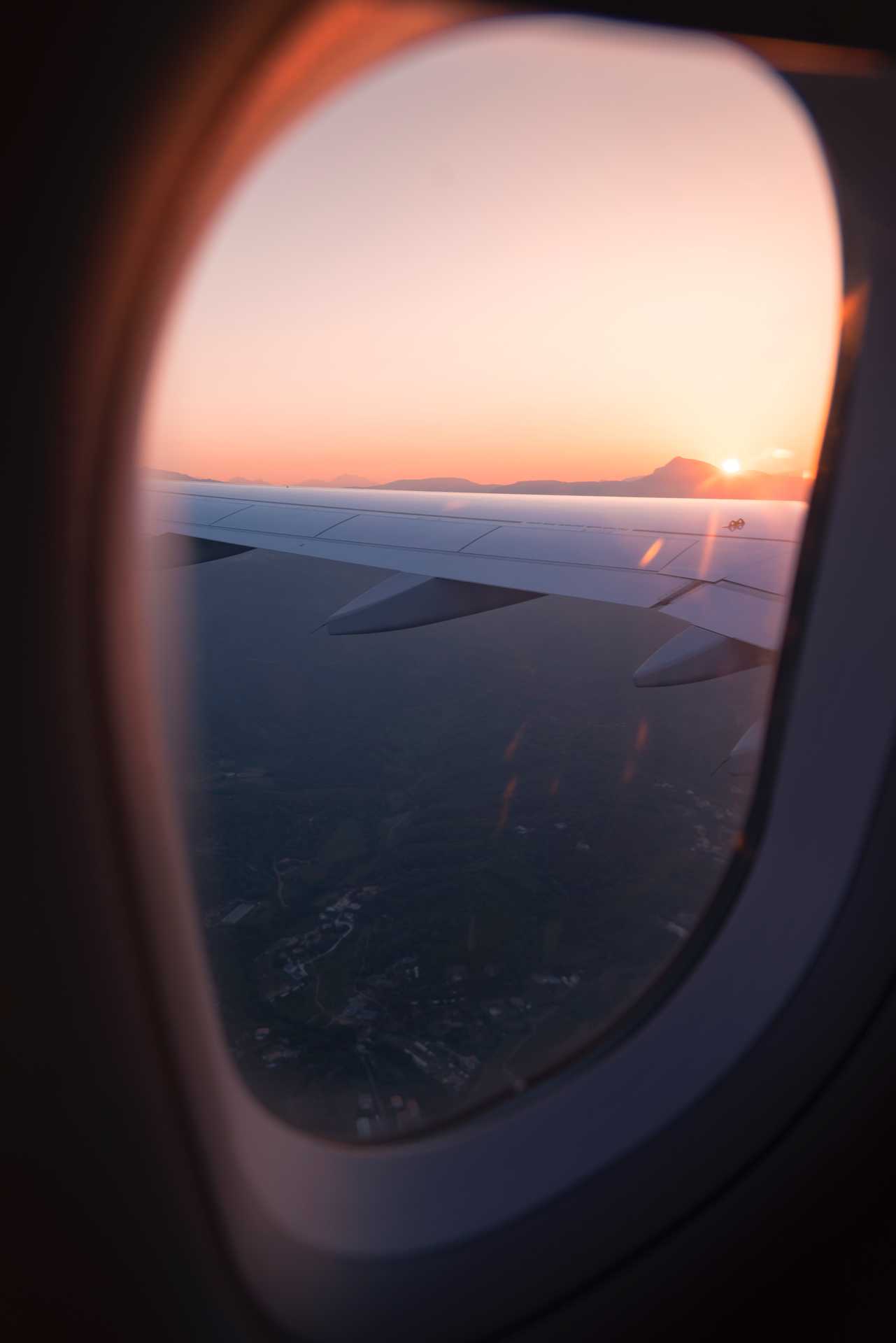
Andalucía is located south of the Iberian Peninsula. Access to Andalusia can be done by plane, by boat, by train or by road.
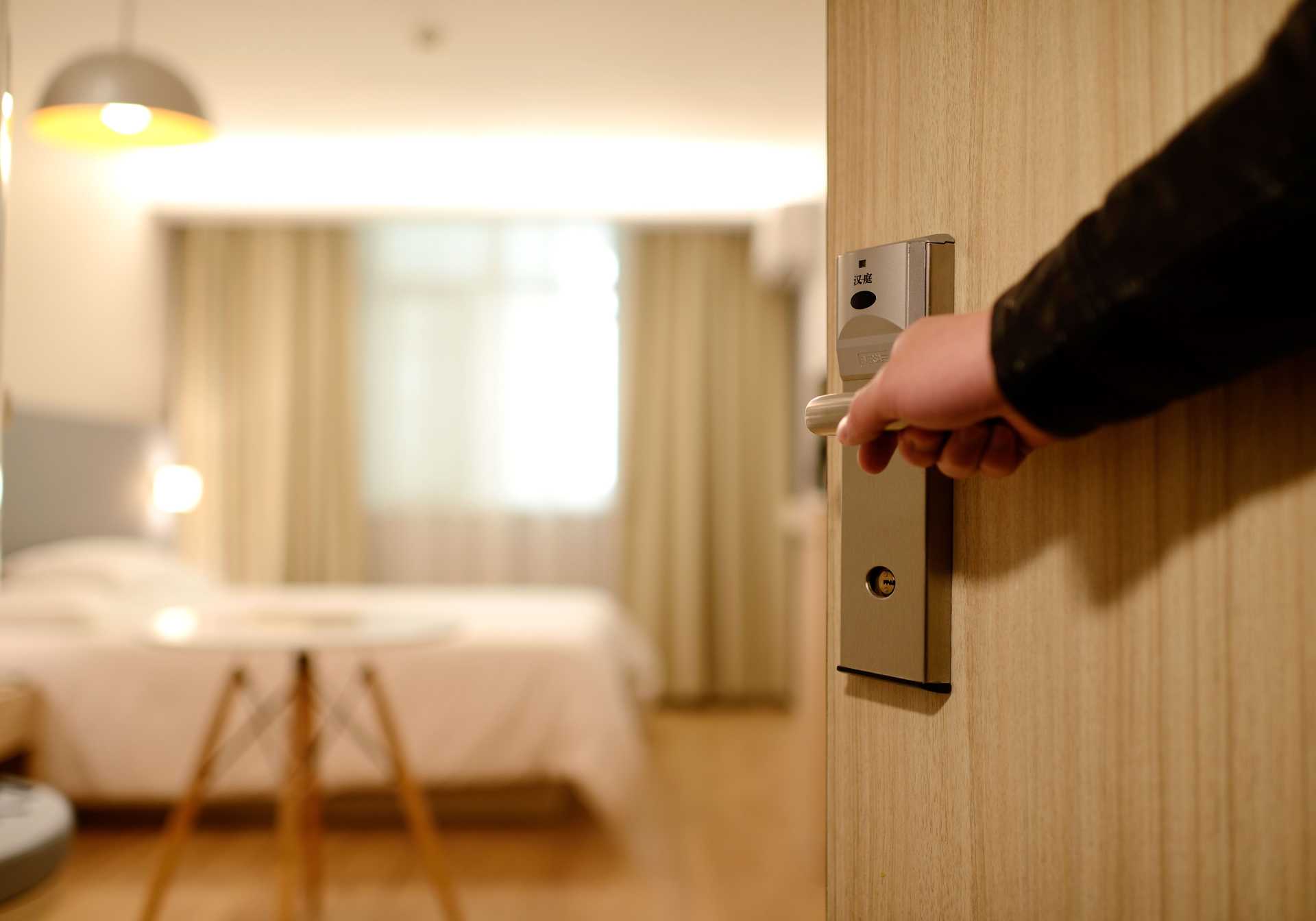
Where to sleep
The accommodations of Andalucía satisfy the most demanding traveler, from a different environment to the most classic style. The are many options to choose from.

What to eat
The Andalusian gastronomy is as wide and varied as its territory. Enjoy a whole repertoire of dishes and products whose excellence is celebrated all over the world.
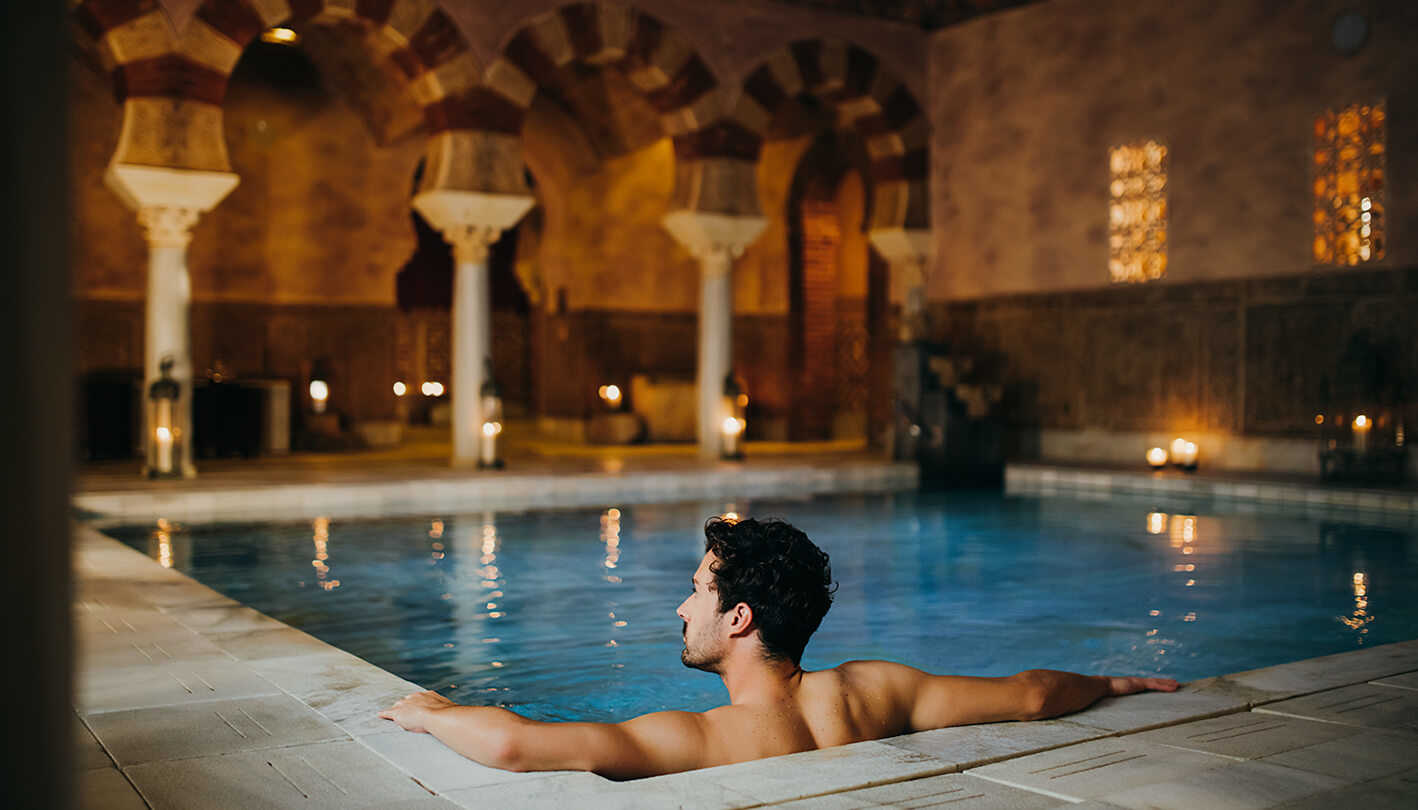
Learn about the possibilities offered by this region of the south of the Iberian Peninsula come to the time of year you come.
Discover the magic of Andalusia in spring , a time of transformation and unparalleled beauty. Live the explosion of colors of its landscapes, feel the sun on your skin and enjoy a perfect climate to explore every corner of this land.
More than a season , spring in Andalusia is an experience . It is the ideal time to enjoy it.
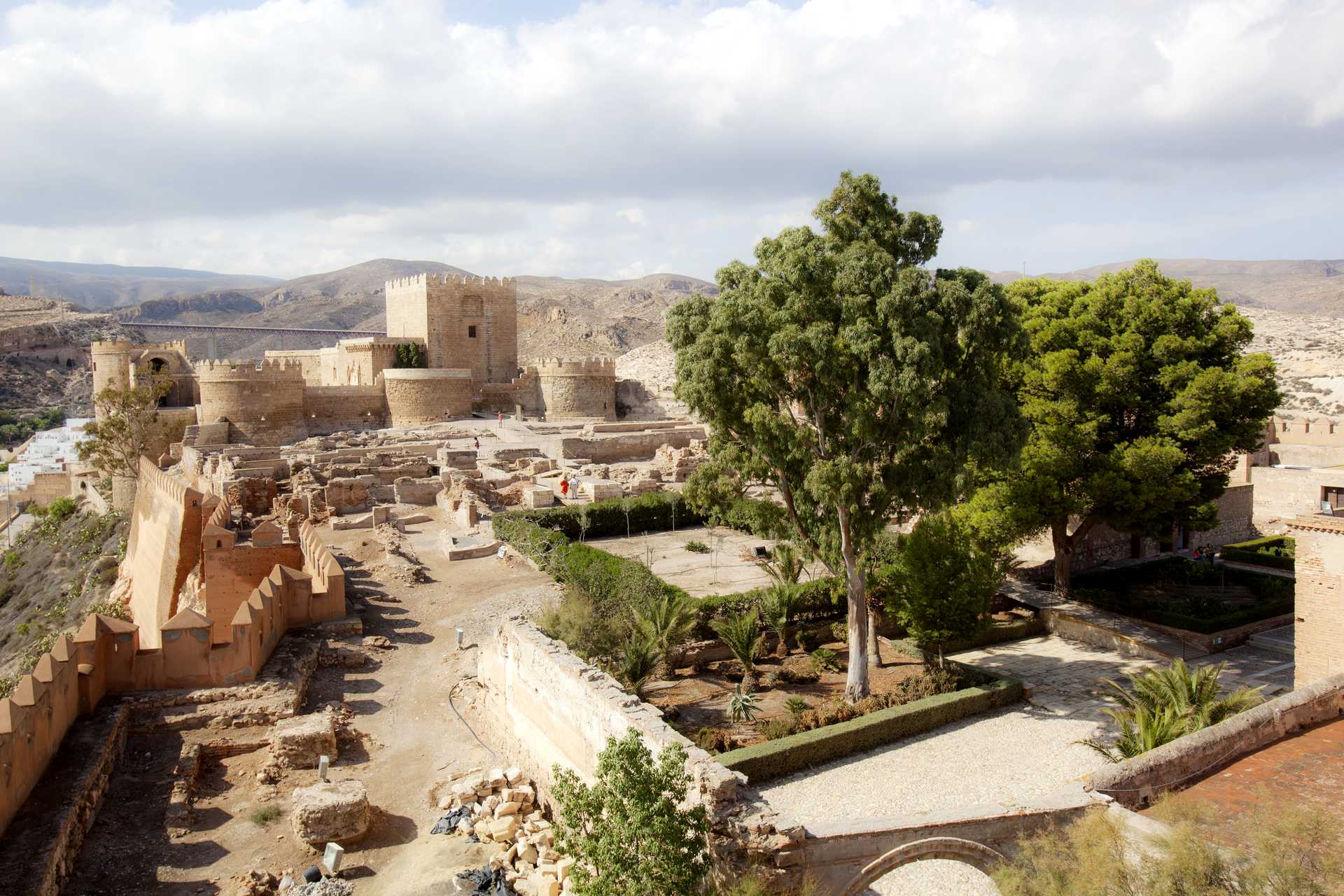
Book your tourist experience
See more offers.
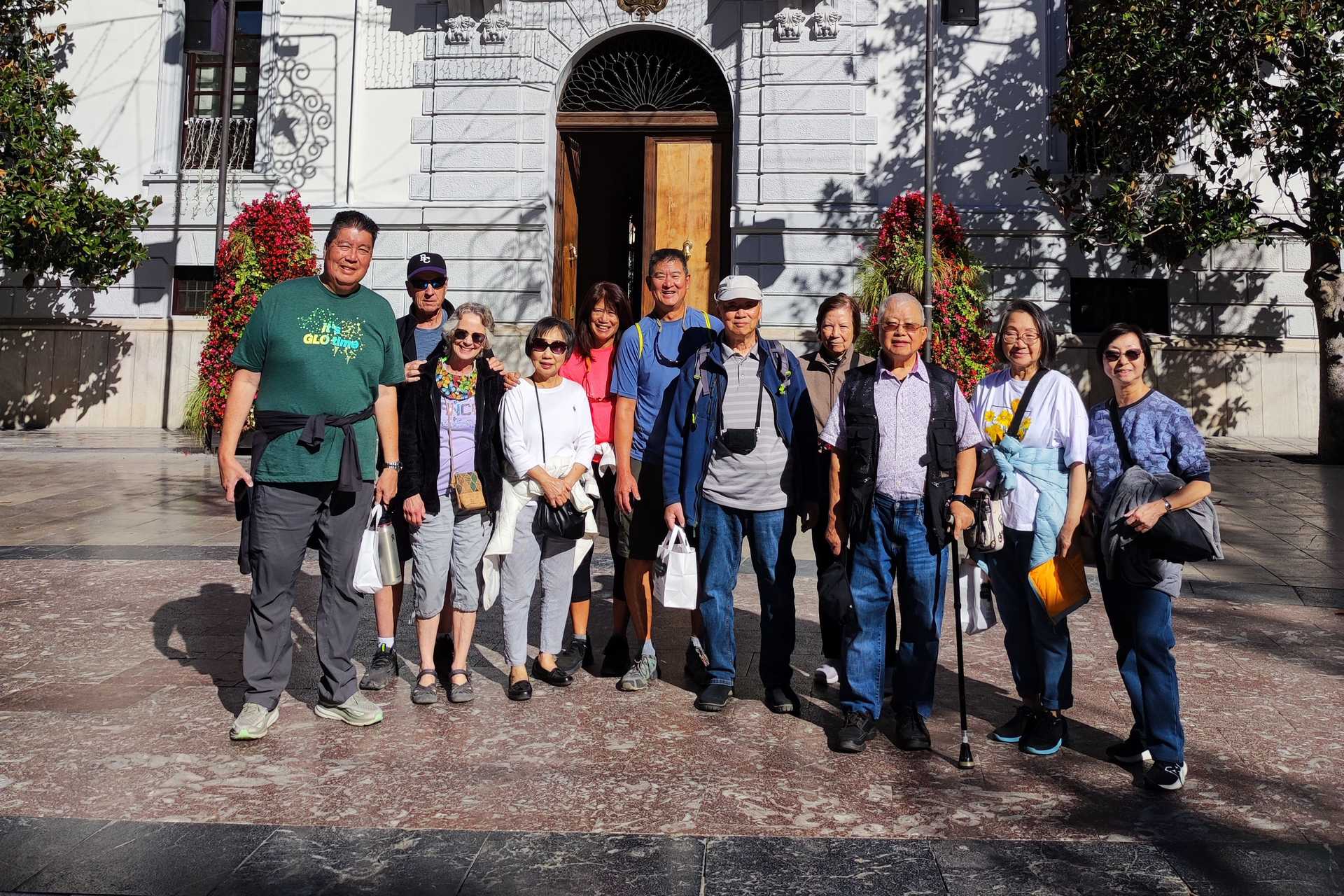
Alhambra Private Tour with Nasrid Palaces and Generalife Gardens
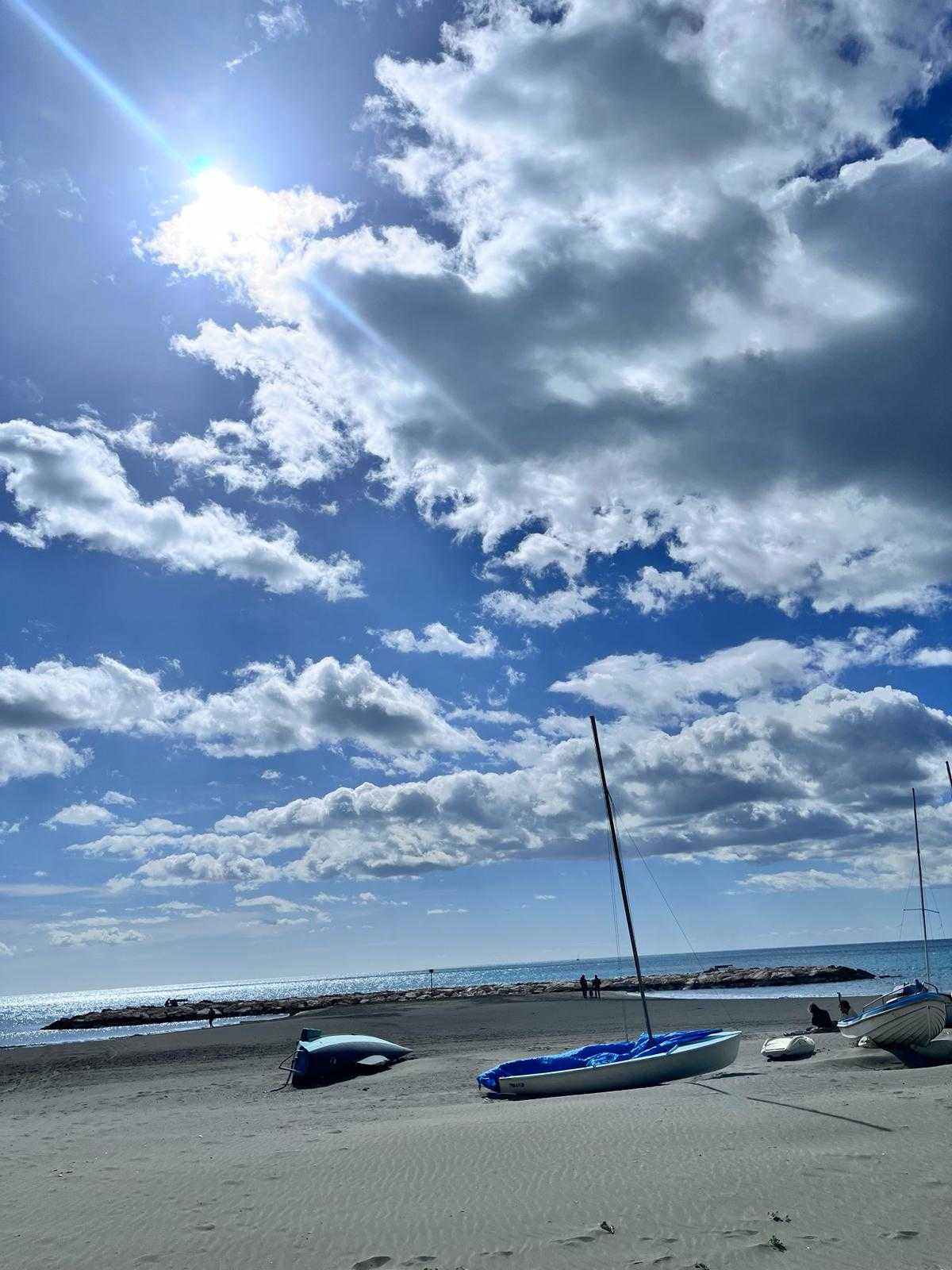
La Pelusa Apartments in East Málaga

Bautismo de buceo para dos personas en La Herradura
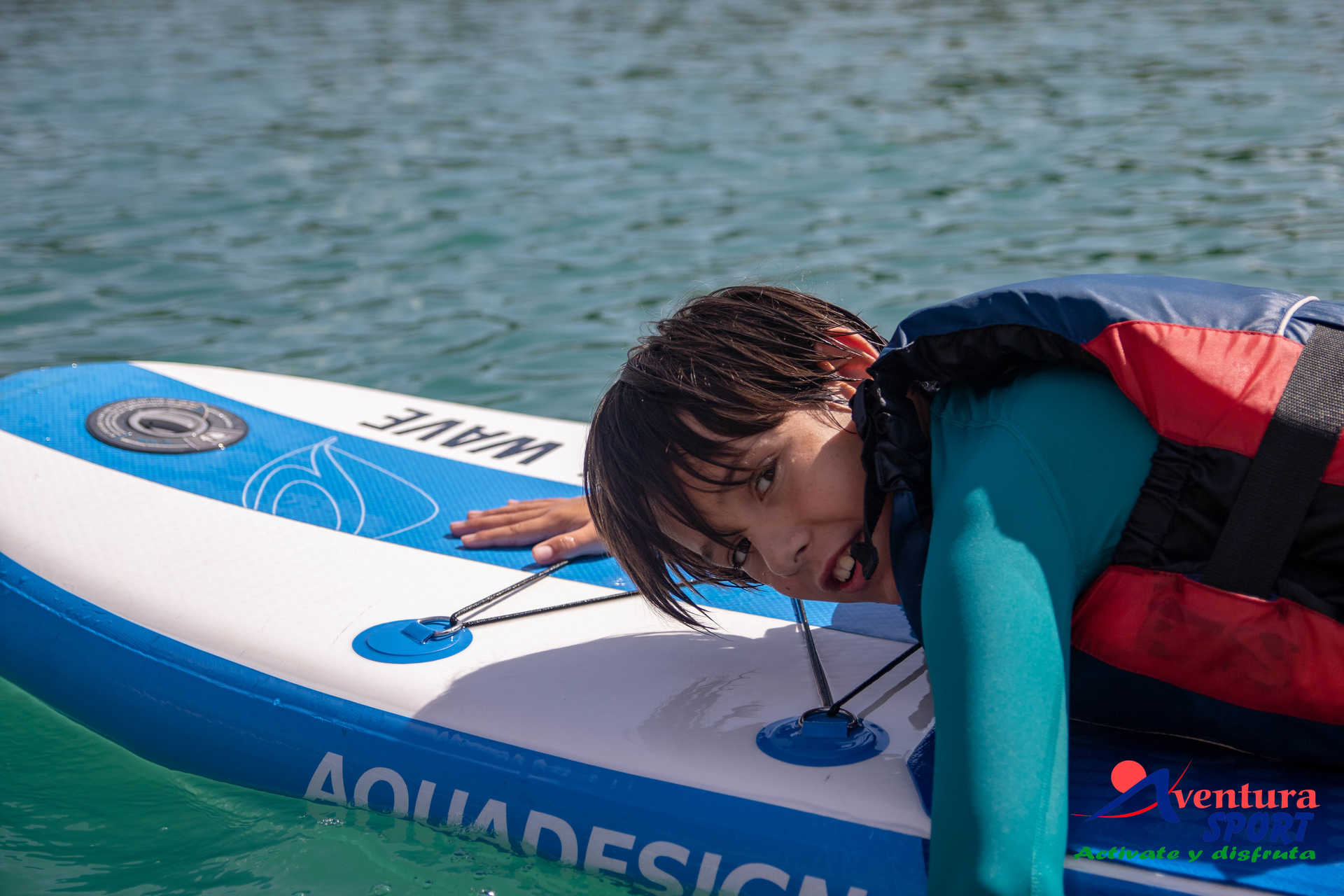
Paddleboarding in Sierras de Cazorla
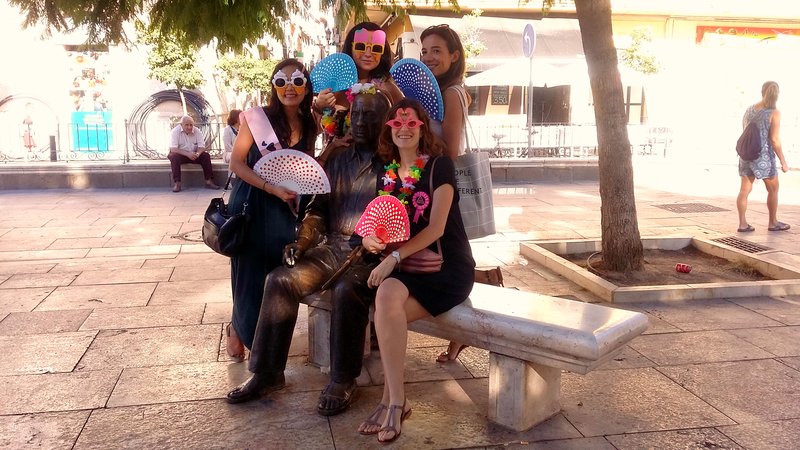
Team Building / Mice Treasure Hunt Activity Málaga
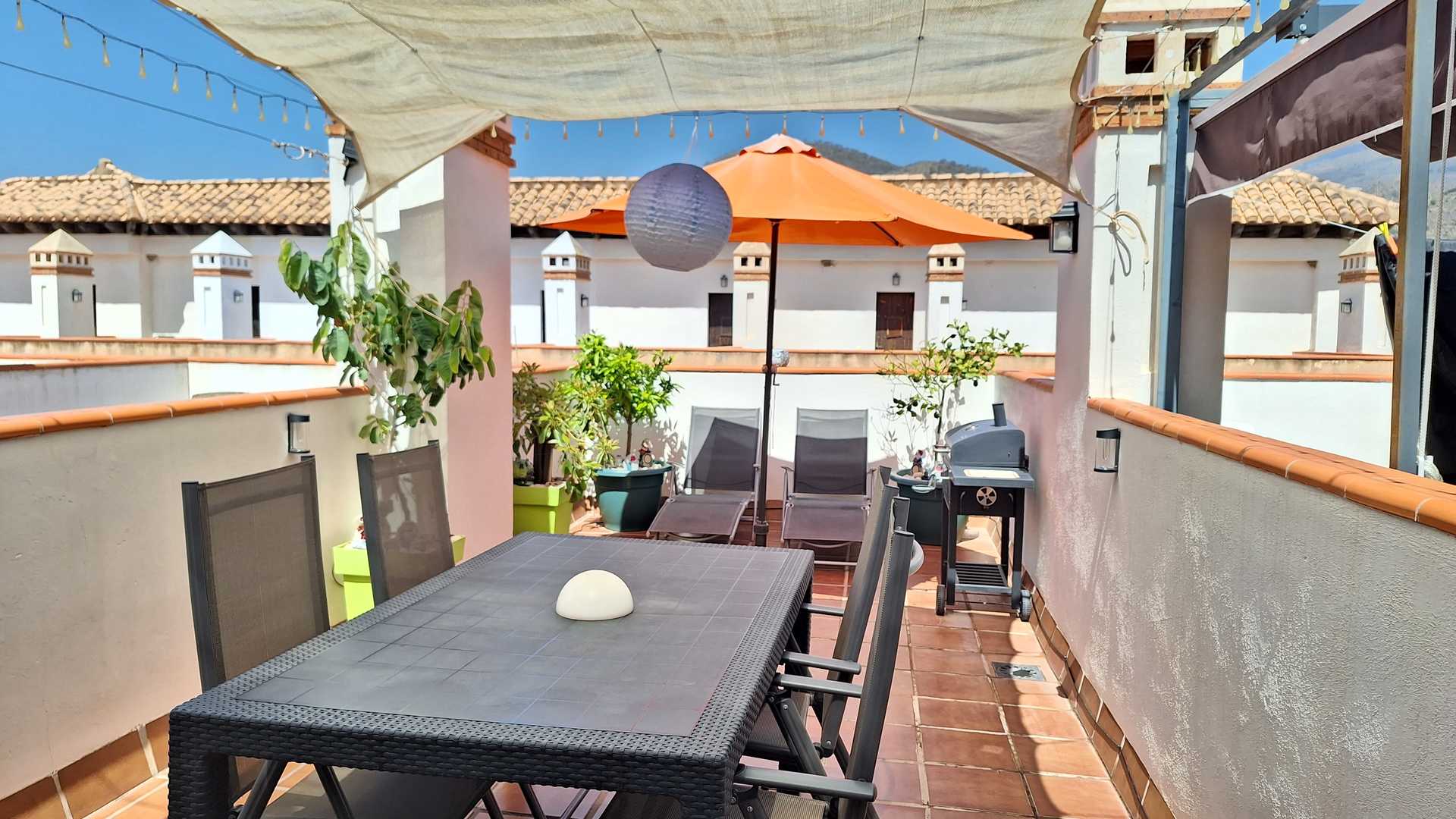
Promoción Junio 20%
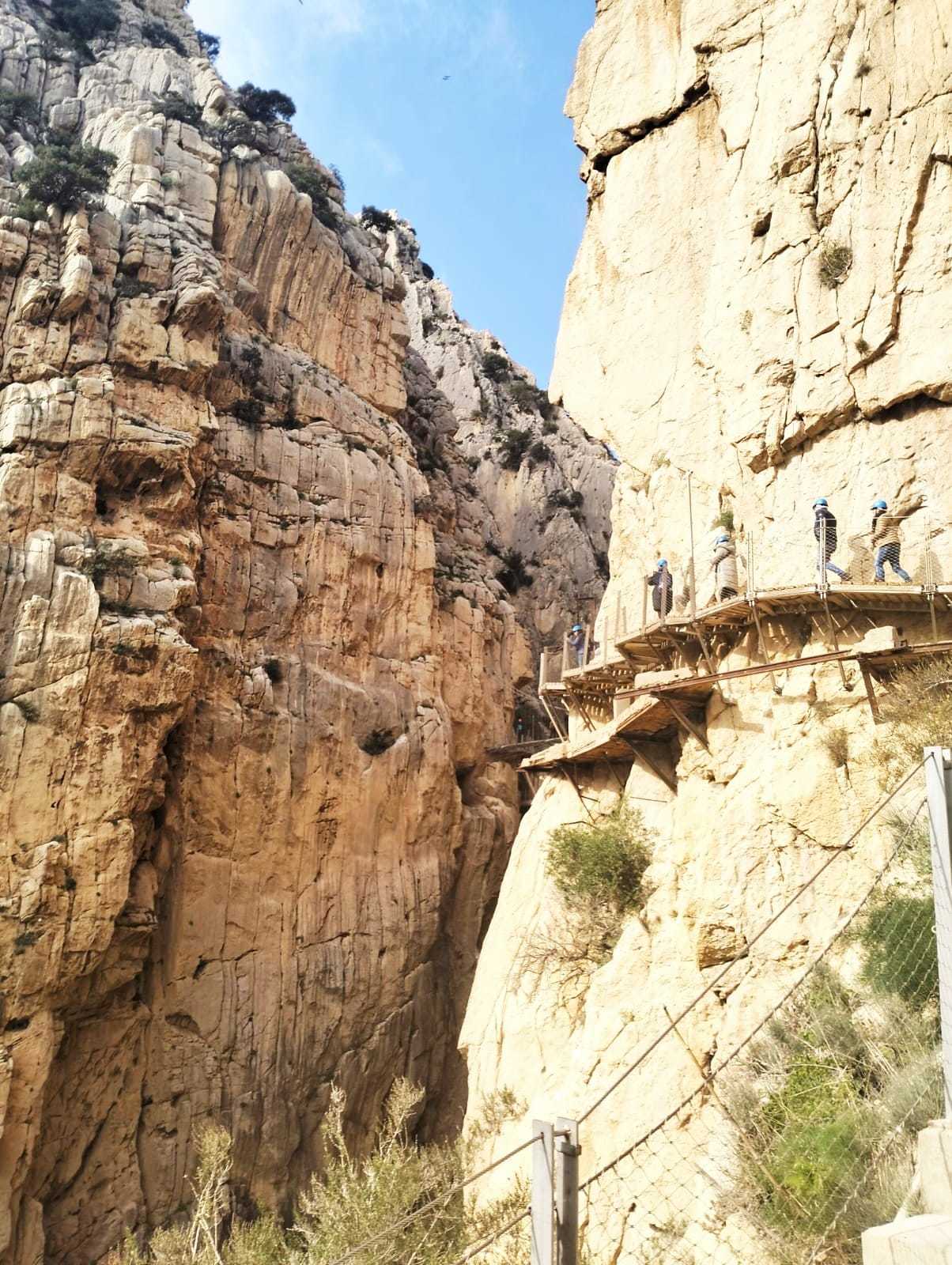
Caminito del Rey desde Sevilla
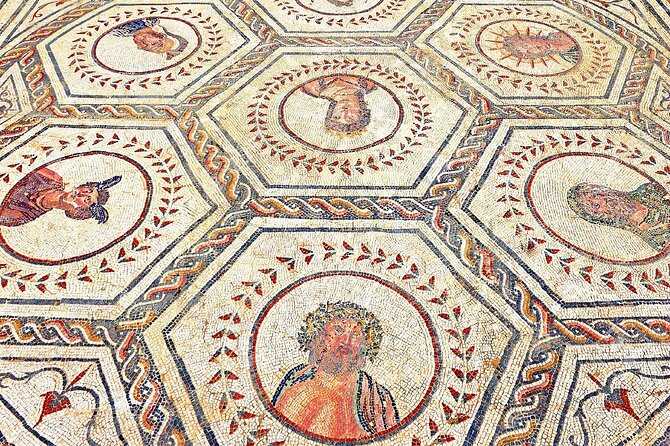
Tour por Itálica desde Sevilla
Don't miss....

Festival de la Guitarra de Córdoba
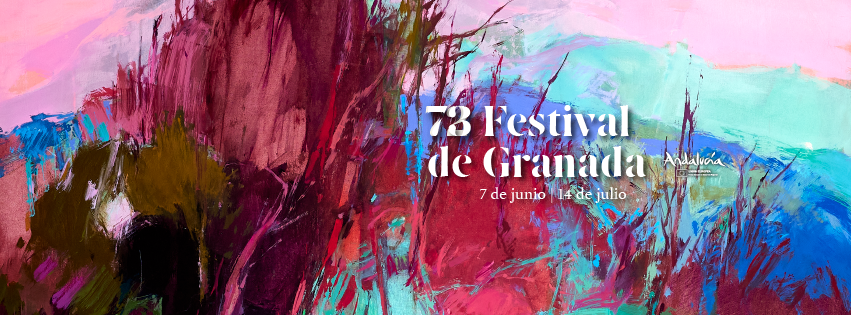
Festival Internacional de Música y Danza de Granada

Fiestas Colombinas
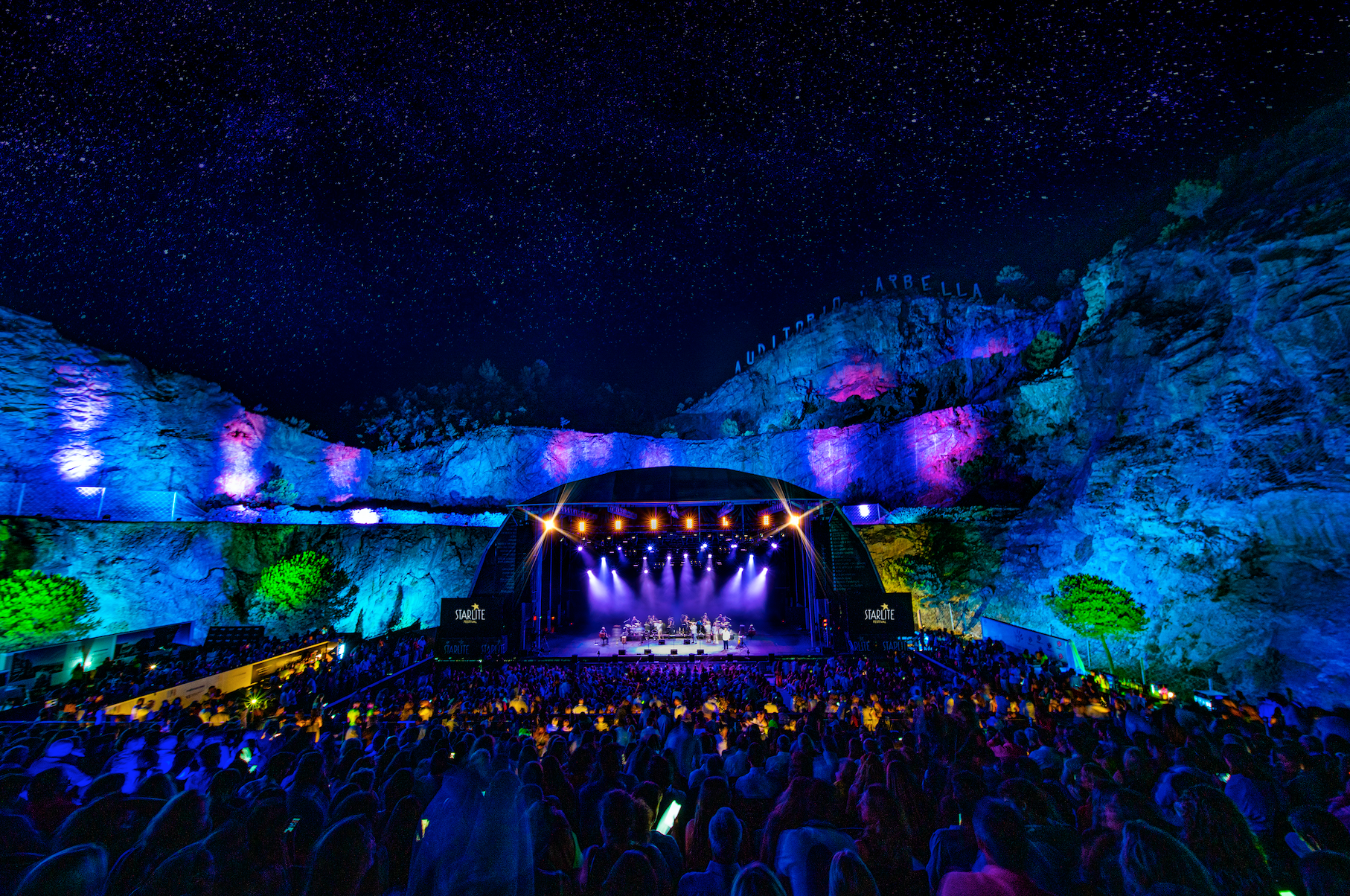
Starlite Occident

Torneo Internacional de Polo
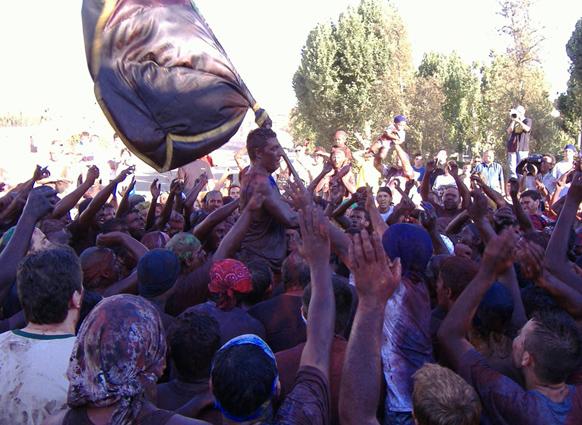
Fiesta del Cascamorras

Cascamorras Festival

Sanlúcar de Barrameda horse races.

Bienal de Flamenco de Sevilla
Proposals to enjoy andalusia.

A journey on board the Al Andalus train
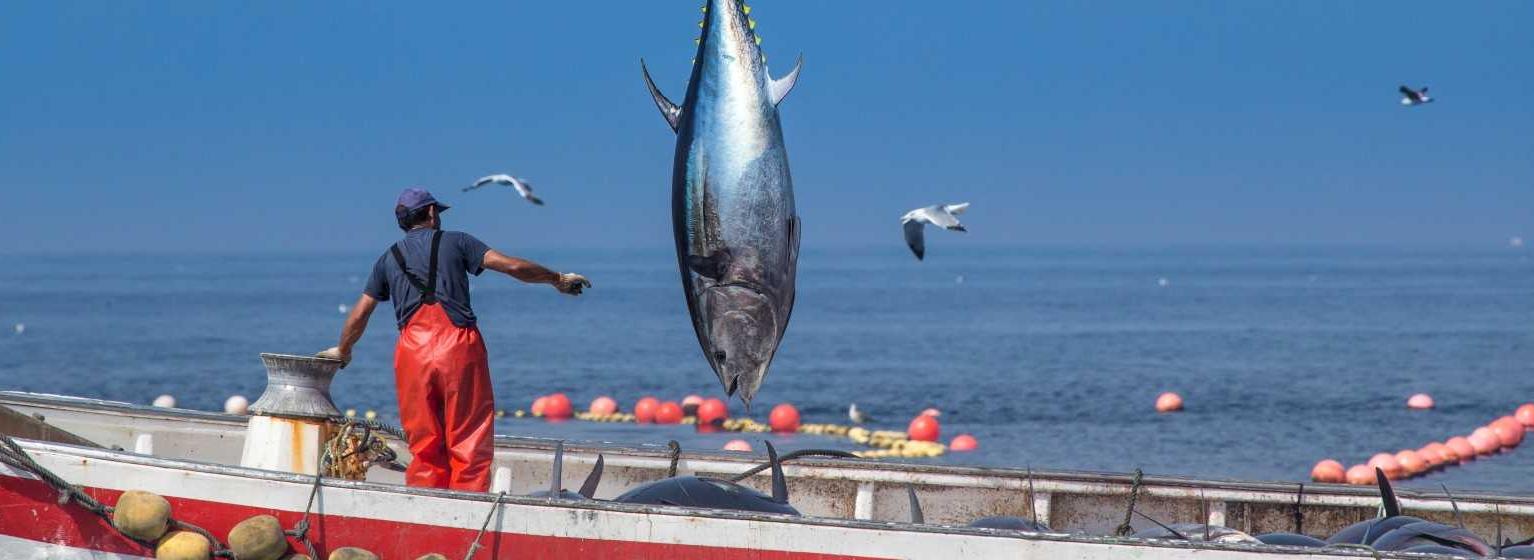
Bluefin tuna, the taste of Cadiz in springtime
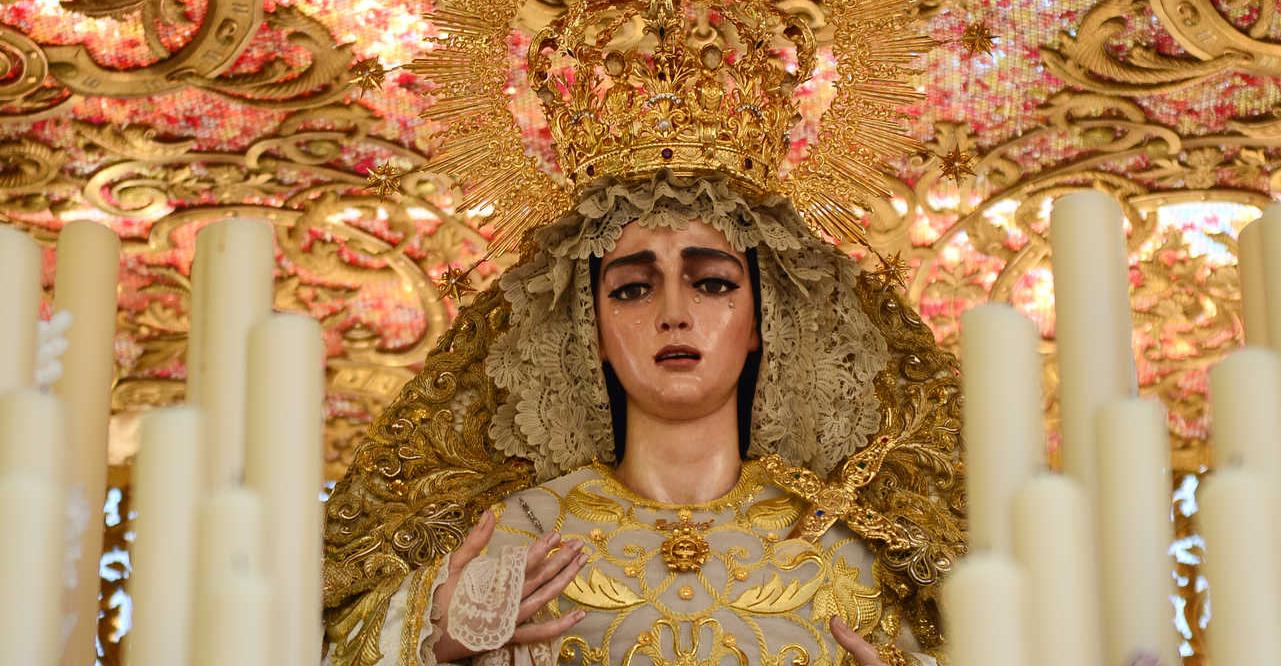
Easter week in Andalusia
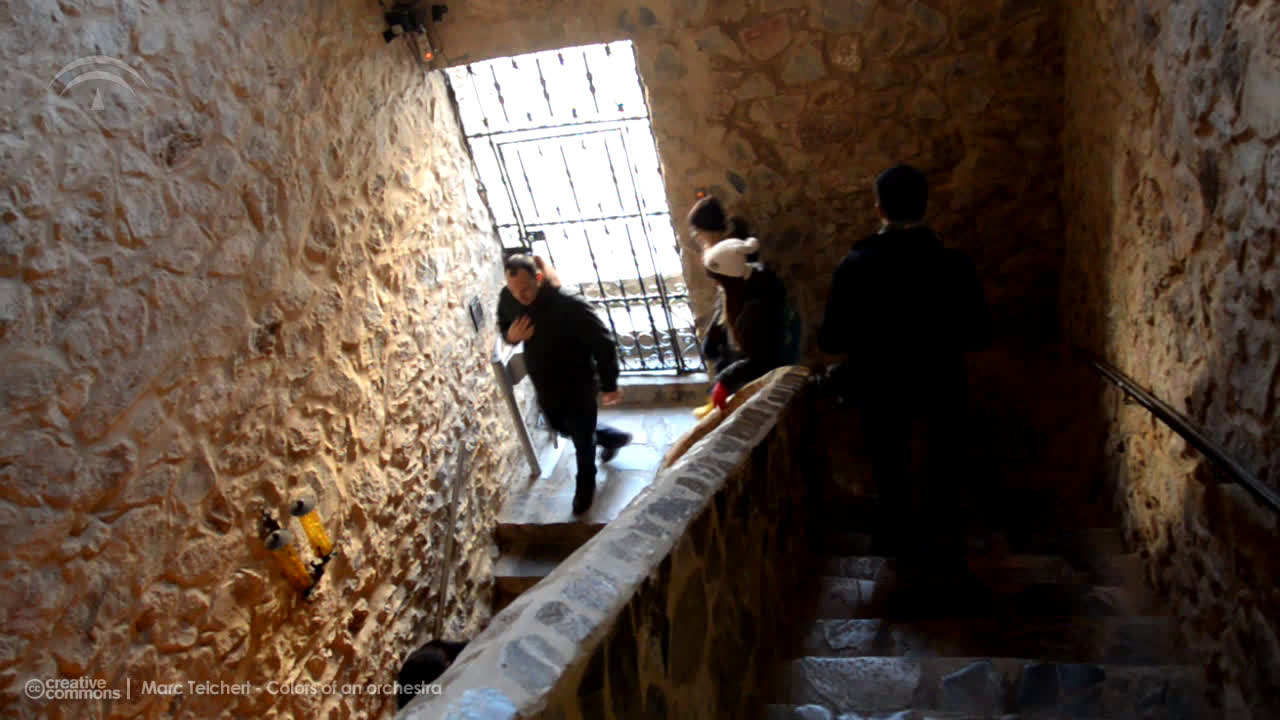
La gruta de las maravillas grotto, an underground treasure
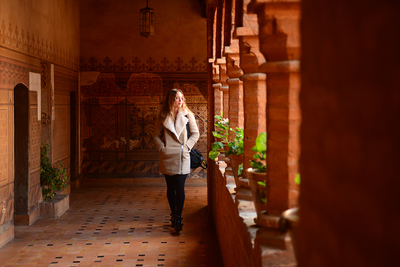
5 reasons that will make you discover Lugares Colombinos in Huelva
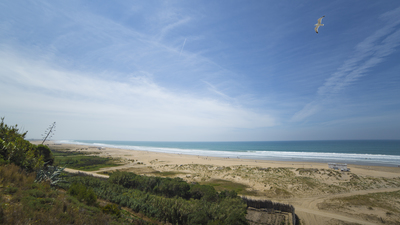
Surf destinations in Cadiz where you'll enjoy good vibes
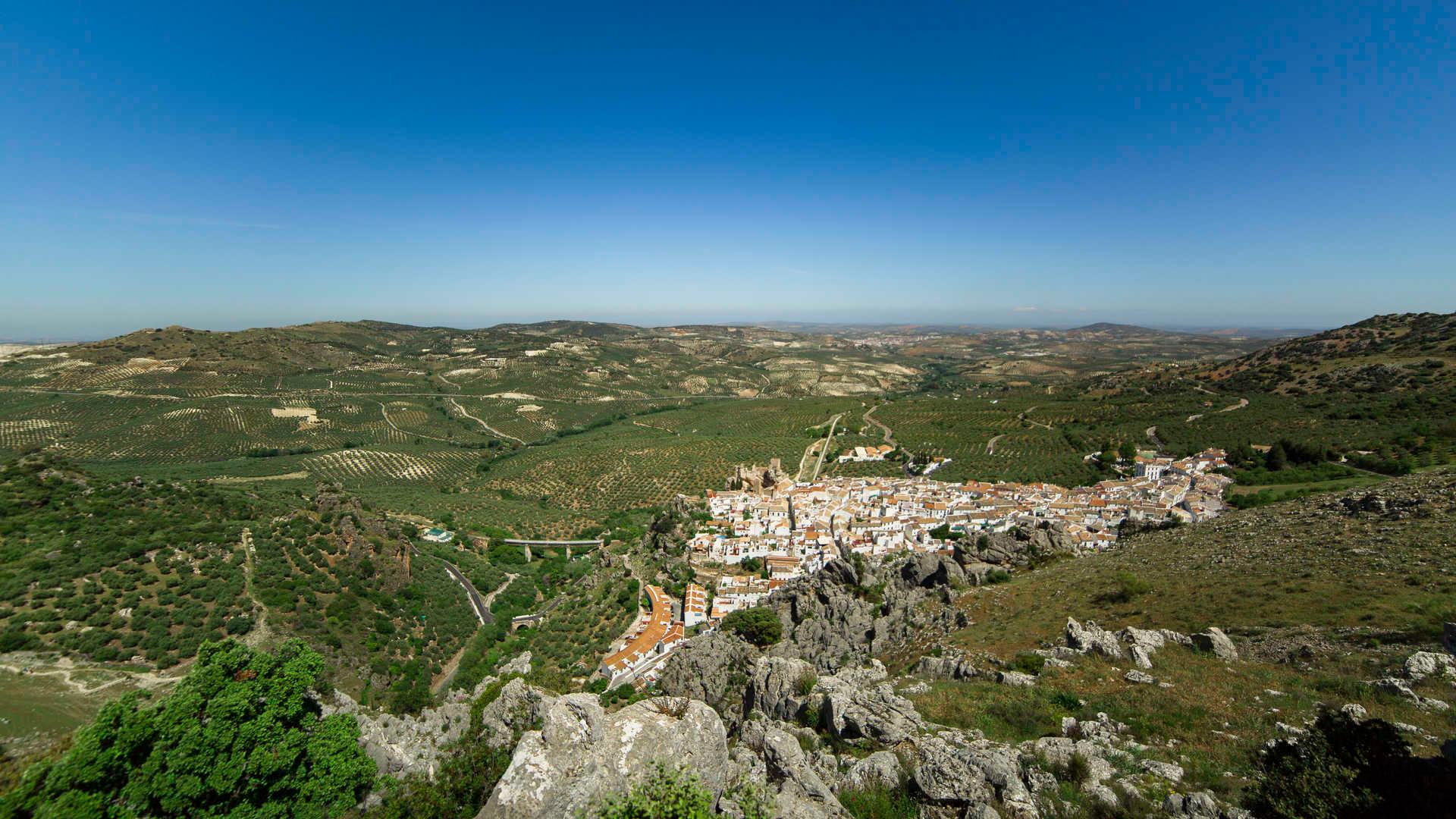
Beyond the city: Discover the beautiful countryside of Cordoba
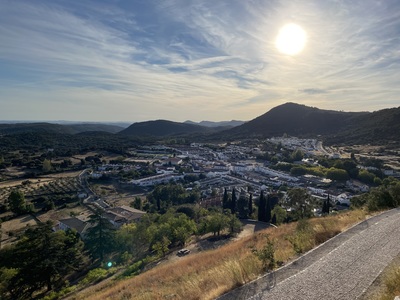
A weekend discovering Autumn in the Sierra de Aracena mountains
For professionals.

Statistics and Market Research

Manage your tourist resource

EXPLORE ANDALUSIA
- Discover Andalusia
- The best sun in the world
- 100% Natural
- Andalusia flavor
PLACES TO VISIT
- Almería
- Cádiz
- Córdoba
- Jaén
- Málaga
EXPERIENCES
- Active turism
- Conferences and Congresses
- Touristic Routes
TRAVEL PLAN
- Accommodations
- Guided Activities Companies
- Tour Operators and Travel Agencies

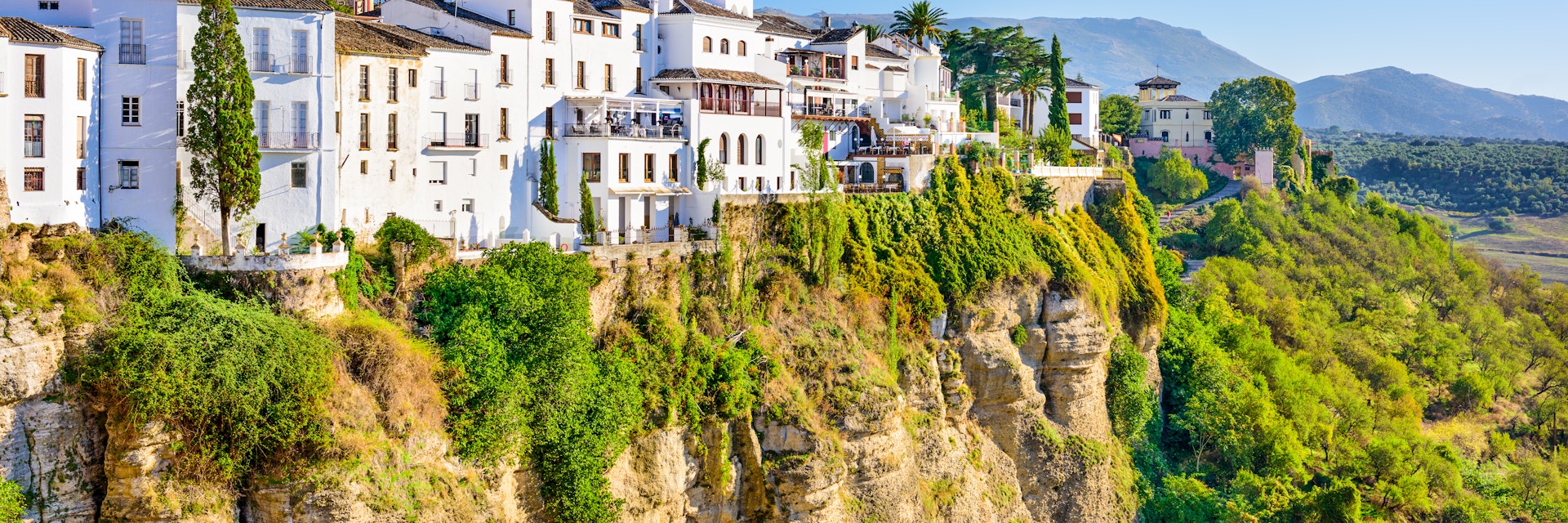
©SeanPavonePhoto/Getty Images
The scent of orange blossom, the swish of a flamenco dress, the glimpse of a white village perched atop a crag: memories of Andalucía linger.
Attractions
Must-see attractions.
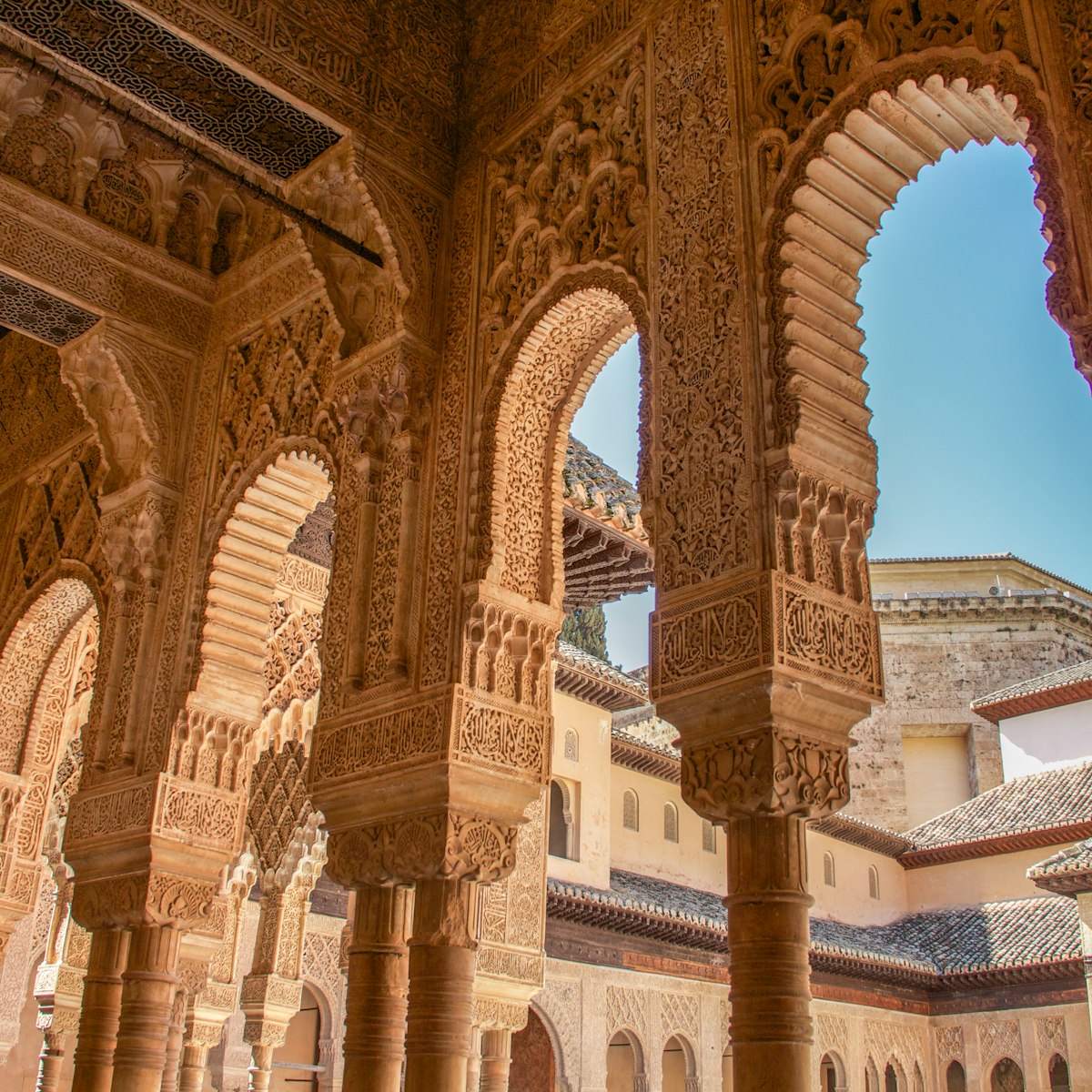
The Alhambra is Granada’s – and Europe’s – love letter to Moorish culture. Set against the brooding Sierra Nevada peaks, this fortified palace started…
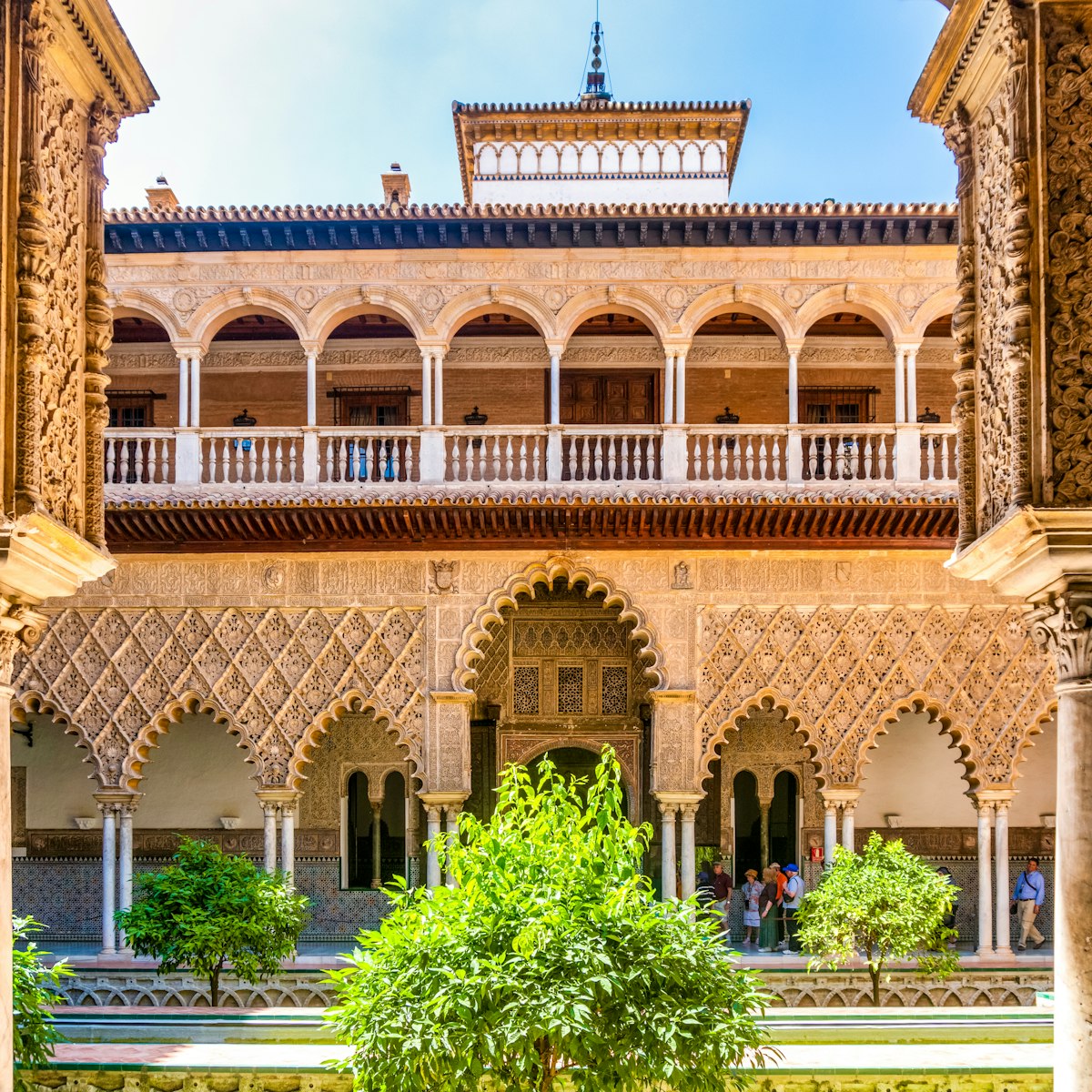
Real Alcázar
Catedral & Barrio de Santa Cruz
A magnificent marriage of Christian and Mudéjar architecture, Seville’s royal palace complex is a breathtaking spectacle. The site, which was originally…
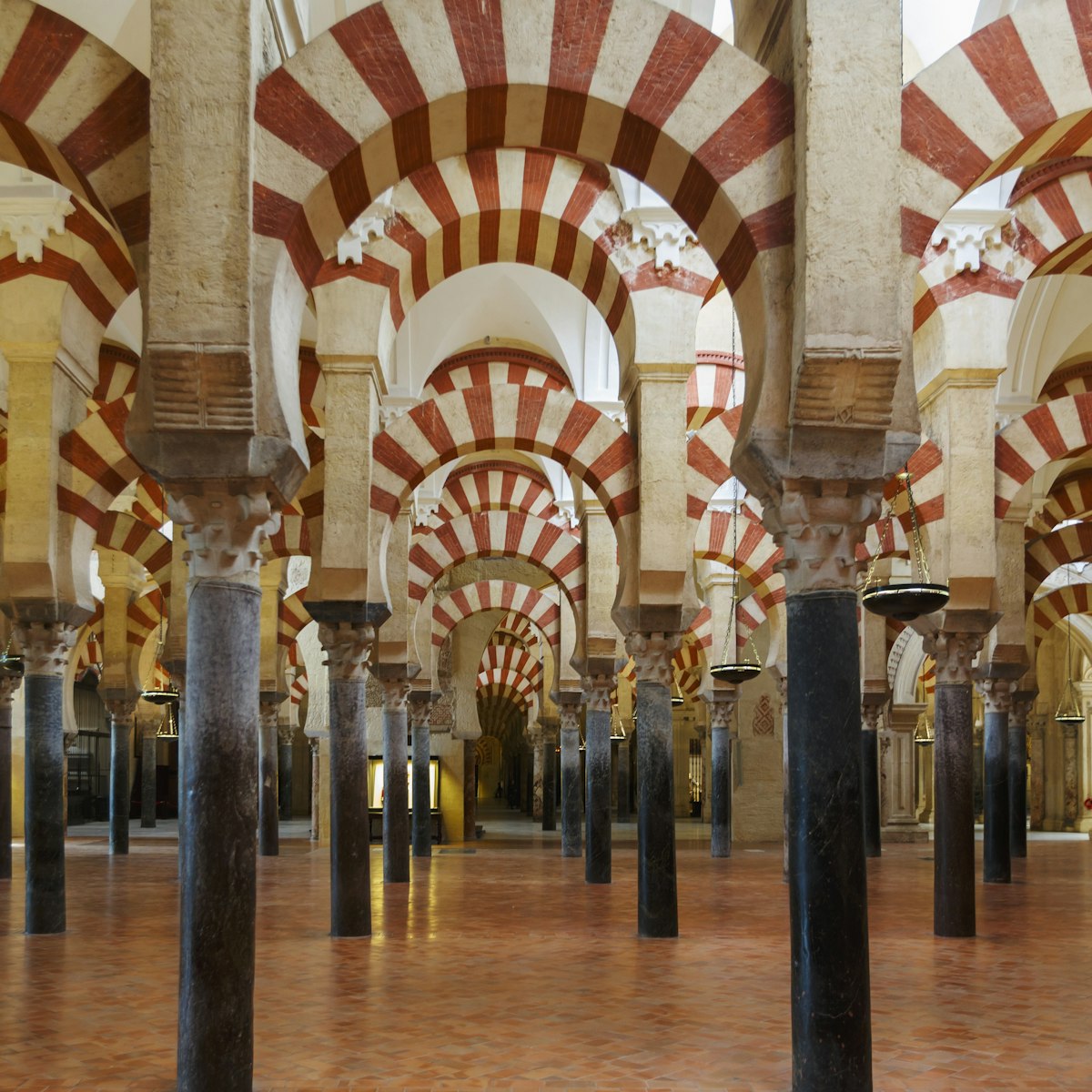
It’s impossible to overemphasise the beauty of Córdoba’s great mosque, with its remarkably serene (despite tourist crowds) and spacious interior. One of…
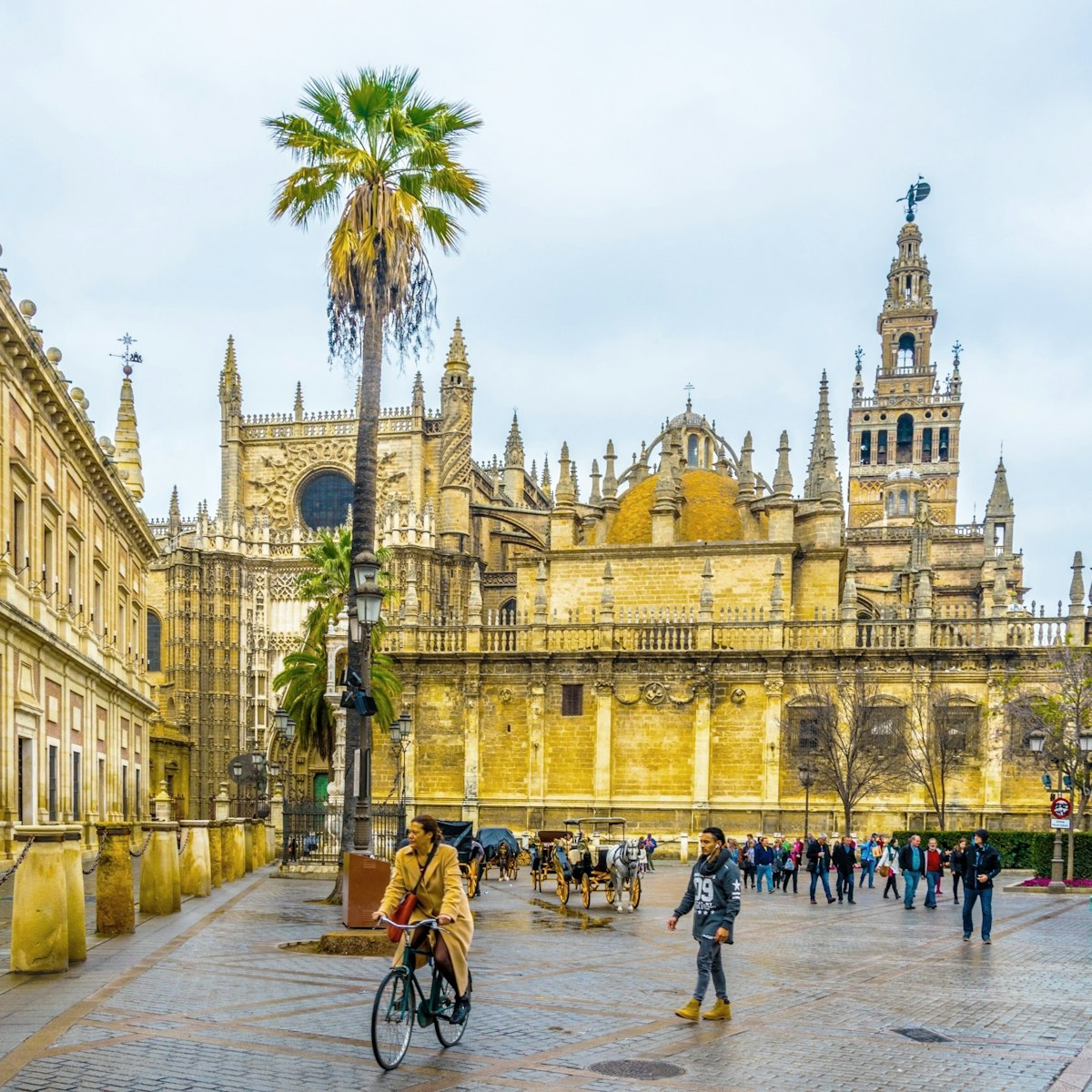
Catedral & Giralda
Seville’s showpiece church is awe-inspiring in its scale and majesty. The world’s largest Gothic cathedral, it was built between 1434 and 1517 over the…
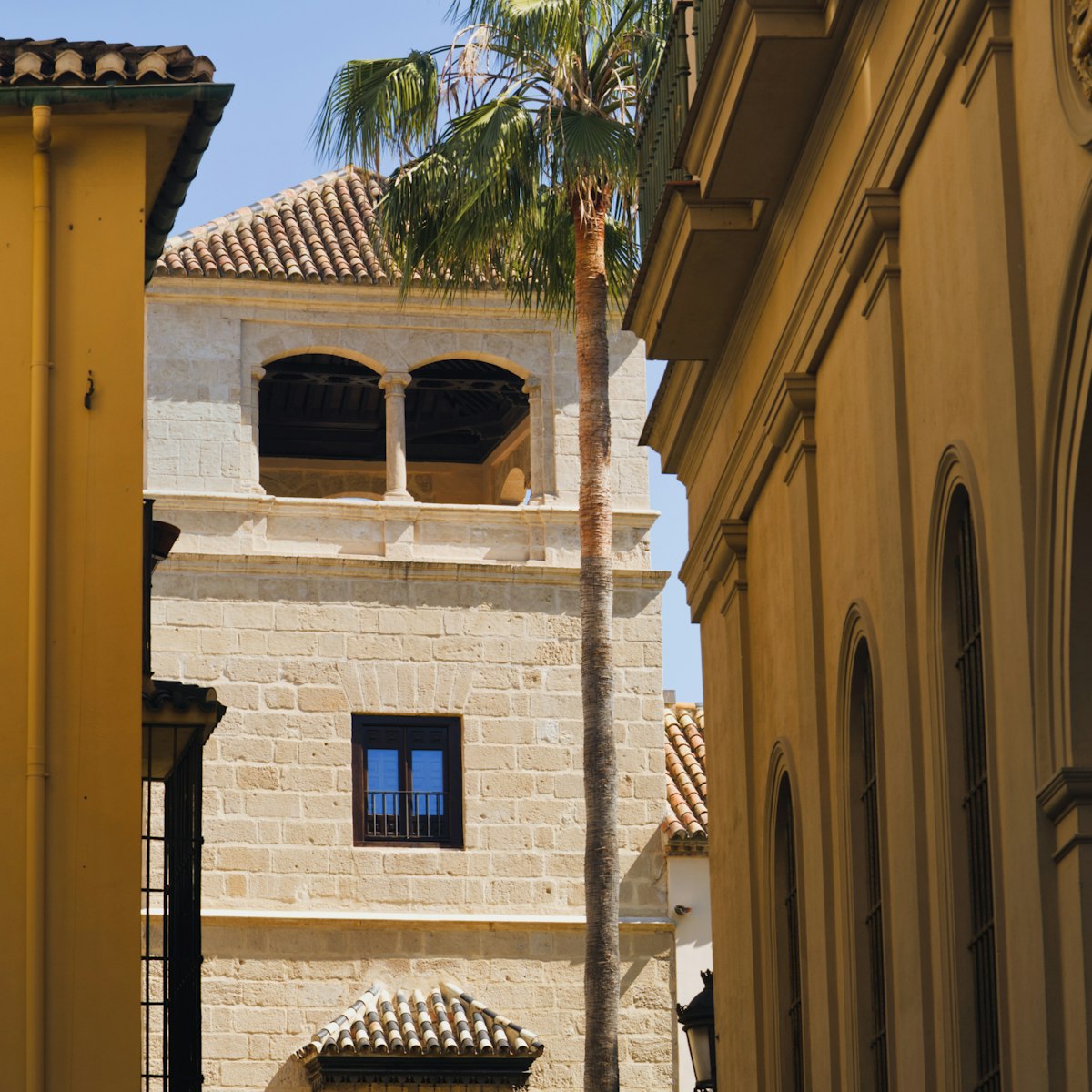
Museo Picasso Málaga
This unmissable museum in the city of Picasso’s birth provides a solid overview of the great master and his work, although, surprisingly, it only came to…
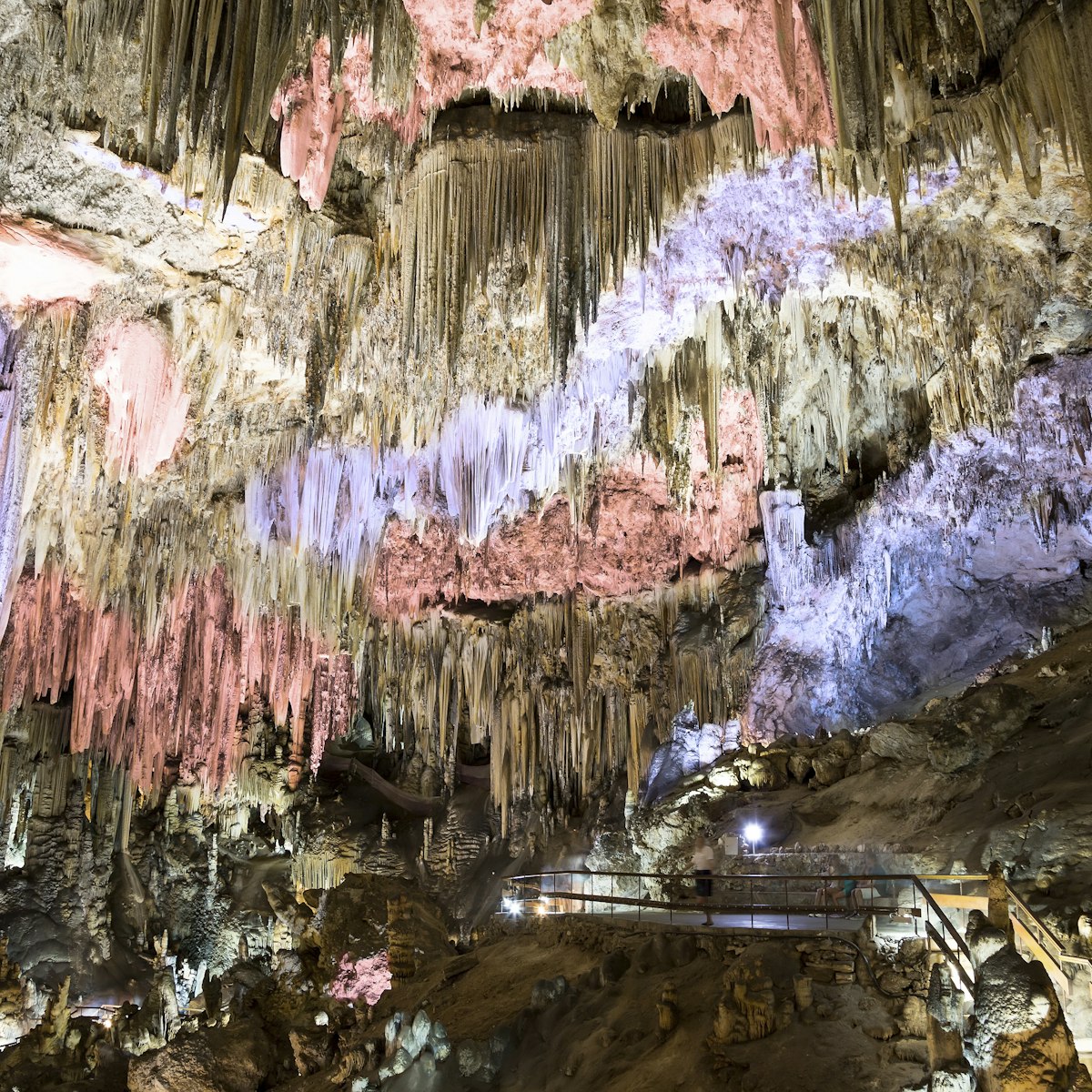
Cueva de Nerja
It’s hard to imagine the surreal world that lies beneath the mountain foothills 4km east of Nerja, and it’s even harder to believe that these vast caverns…
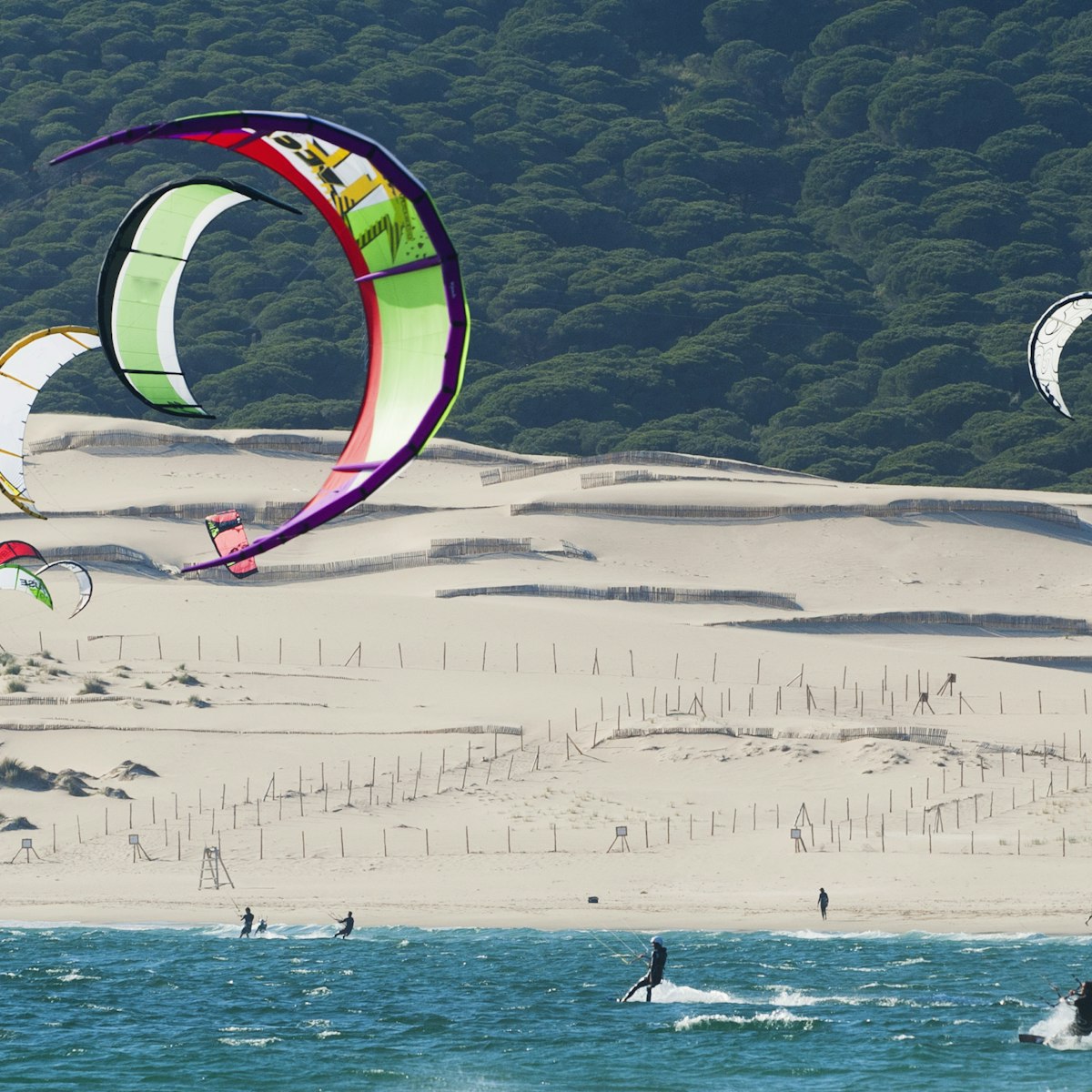
Punta Paloma
One of Andalucía's most fabulous beaches, Punta Paloma, 10km northwest of Tarifa, is famous for its huge blond sand dune. At its far western end, you can…
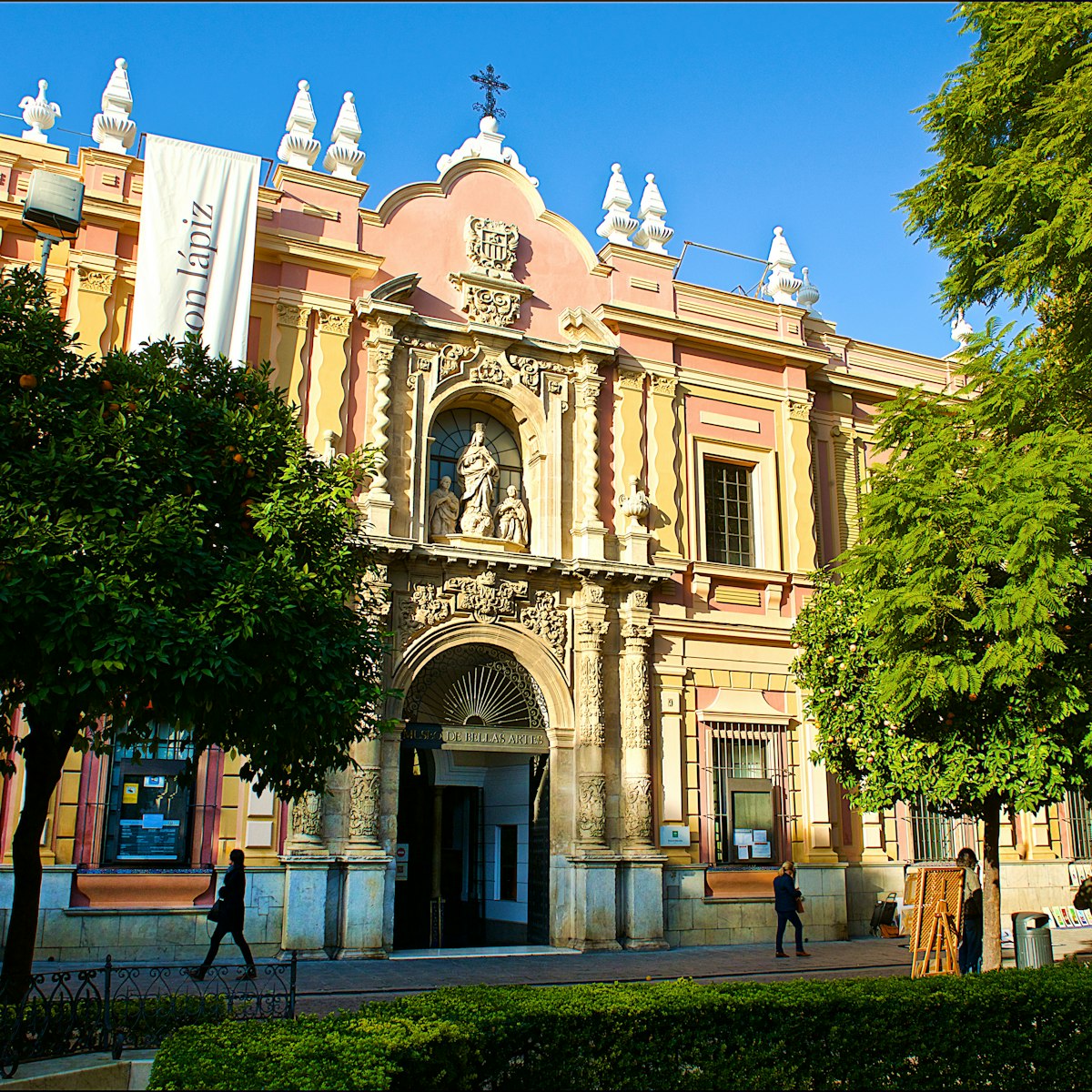
Museo de Bellas Artes
El Centro & El Arenal
Housed in a grand Mannerist palace, the former Convento de la Merced, the Museo de Bellas Artes is one of Spain's premier art museums. Its collection of…
Plan with a local
Experience the real Spain
Let a local expert craft your dream trip.
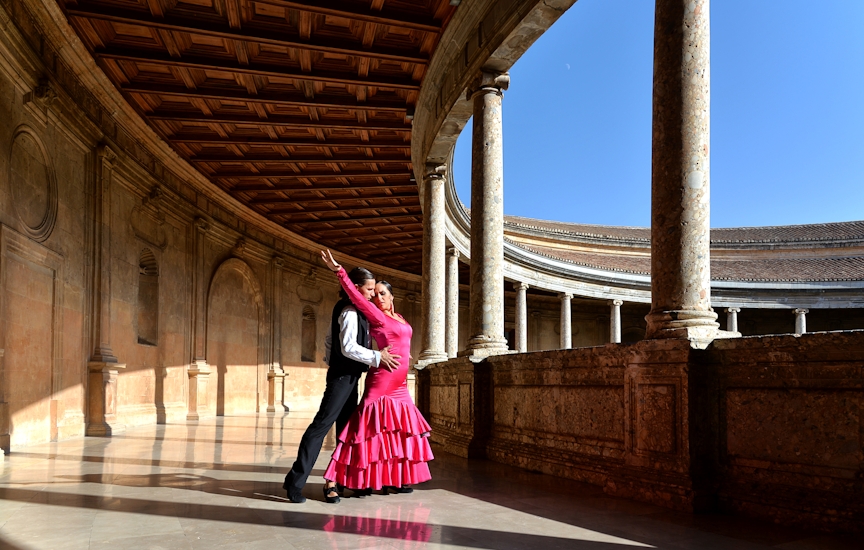
Latest stories from Andalucía
Filter by interest:
- All Interests
- Adventure Travel
- Art & Culture
- Beaches, Coasts & Islands
- Food & Drink
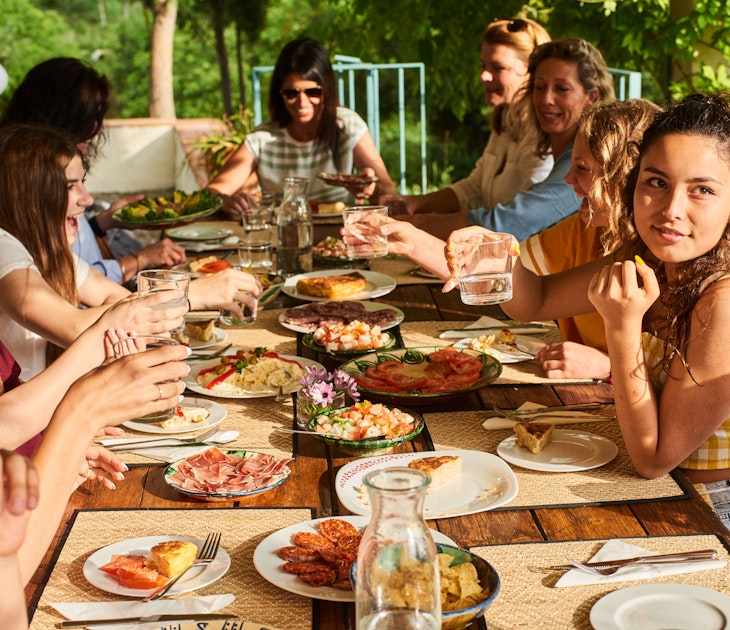
Jul 26, 2022 • 10 min read
Luxury in Seville, a room with a view of the Alhambra in Granada, rustic charm in the countryside and more: these hotels are among Andalucía’s best.
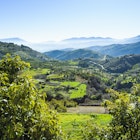
Jun 29, 2021 • 3 min read

Sep 27, 2019 • 6 min read
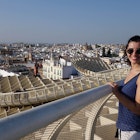
Sep 23, 2019 • 8 min read

Sep 18, 2019 • 6 min read
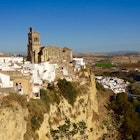
Oct 30, 2018 • 5 min read
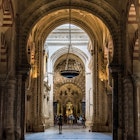
Oct 29, 2018 • 5 min read
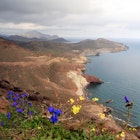
Oct 24, 2018 • 6 min read

Mar 9, 2018 • 2 min read

Dec 22, 2016 • 4 min read
Andalucía and beyond
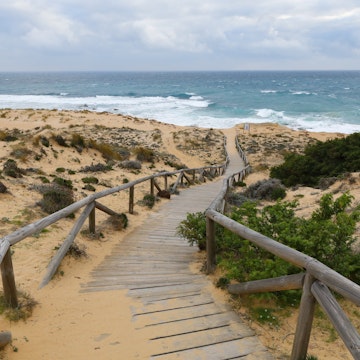
- United Kingdom
- Curated Stays
- Wine Travel
- About Isabelle
- Work with Us
The Perfect Andalucia Itinerary for 7, 10, or 14 Days
- Isabelle Hoyne
- May 20, 2024
** Disclosure: some of the links on this site are affiliate links and should you make a purchase through these, I may receive a small commission at no extra cost to you. Thank you for your support!**
Pulling together the perfect southern Spain itinerary can be testing – I remember feeling overwhelmed when first sitting down to plan my trip to Andalucia – and you might be feeling this way too. This is a long one, but stick with me and by the end, you’ll know how to craft the perfect Andalucia itinerary!
I close my eyes and I am back there – flashes of orange blossoms, dusty, white towns that teeter on the precipice of yawning gorges, the solitary echo of footsteps on ochre-hued streets at siesta time.
I taste the salty tang of Manchego cheese as it hits my tongue and squint my eyes in the bleached light of the midday sun, as I am once again immersed in the kaleidoscope of experiences that make up a road trip in Andalucia .
Andalucia is famous for its shoreline – along its fringes are the beaches of the Costa del Sol, firm-favourite of many a package holiday fan.
Its gateway is the port city of Malaga, but to step inside the interior of this region is to discover its beating, cultural heart and the very best of Southern Spain.
Our route first took us from the coast to the sweeping arches of the Puente Nuevo at Ronda, and on then to cosmopolitan Seville , capital city of Andalusia.
From here we journeyed our way further through southern Spain to gawp at La Mezquita in Cordoba before finishing at the foot of the Sierra Nevada mountains, racking up our step count at Granada’s Alhambra .
Since initially writing this Andalucia itinerary guide, I’ve spent a number of months living in the marvellous metropolis that is Seville. I’ve fallen even further under Andalusia’s charms and hope to help you do the same through this comprehensive guide.
I understand that time constraints may be different for all readers of this post, and so below, I have outlined a variety of proposed itineraries depending on number of days you have available.
Further on in the post, I lay out my recommendations for each destination mentioned. Happy planning!
Essential links for booking your Andalucia trip
Search for and book flights via Skyscanner Book your car rental via Rentalcars Make sure to book in advance: ☆ Make sure to book tickets to the Alhambra well in advance, that include entry to the Nasrid Palaces as visitor numbers are limited daily. To get the most from your visit, book a small group guided tour or alternatively, a private tour . ☆ The Seville Super Combi Pass offers a discounted bundle price for access to the Alcazar, Cathedral & Giralda Some memorable experiences in Andalucia ☆ Arabian Baths Experience at Granada’s Hammam Al Ándalus ☆ VIP early-access Alcazar of Seville tour (** editor’s choice **) ☆ Tastes, Tapas & Traditions of Seville Food Tour (great for foodies – I took this tour & loved it!) ☆ 4-WD Sierra Nevada Safari Tour (Granada) ☆ White Villages from Ronda – Wine & Tapas by E-Bike Recommended hotels : Hotel Catalonia Reina Victoria (Ronda hotel with spectacular views) // Soho Boutique Hotel (luxe for less, Seville) // Villa Oniria (boutique beauty I stayed in, Granada) // H10 Palacio Colomera (reasonably priced Cordoba luxury hotel with pool) Best Andalucia vacation rentals : take a look at the most popular apartments & houses
Table of Contents Hide
Why history, culture and gastronomy lovers should visit andalucia, when should i go to andalucia, what is the best way to get around andalucia, how many days do i need in andalucia, andalucia itinerary 7 days, andalucia itinerary 10 days, andalucia itinerary 2 weeks, andalucia by train itinerary, ronda & the white villages, related reading for granada & andalucia, like this post pin for later.
Andalusia’s history is a long one.
For millennia these lands have attracted a diverse range of people. From early, pre-Christian metalworkers to the Phoenicians, the Romans to the Moors, Andalusia finally found itself in the hands of the Catholic monarchs, Ferdinand and Isabella, when it then became the nucleus of Spanish trade with the New World in the 16th century.
Responsible also for the Reconquista , they made it their business to either convert to Christianity or expel from Spain its Muslim and Jewish occupants.
Each ruling dynasty left its mark on the region. Possibly the most unique and lasting legacy is that of the Moors – in fact, flamenco, one of Andalusia’s most distinct cultural outputs, finds its origins in Arabic roots.
Arabic influence on Andalusian architecture is also extremely distinct in this region, presenting a magical hybrid of Moorish and Spanish qualities (called ‘ Mudejar ’) that won’t be seen anywhere else in the world.
The perfect destination for those looking to immerse themselves in local culture, be wowed by architectural diversity and uniqueness and spend a good deal of time in tapas bars swilling local wine, an Andalucia road trip needs to make its way onto every traveller’s southern Spain itinerary .
Planning your Andalucia road trip
Before embarking on our Andalusia road trip , it took a little bit of head scratching and quite a bit of research in order to answer all questions and decide on a route and itinerary for the trip.
Where should I base myself in Andalucia and how much time did I need? Is it safe to self drive in Spain? Is it possible to get around Andalucia by train? You will likely have the same questions, so let me answer these for you below!
As with a lot of destinations, the shoulder months of April/May and September/October make for a great time to visit Andalucia, with average daily temperatures of anywhere between 20-30 degrees celsius (68-86 Fahrenheit).
I’ve visited Seville during May/June and temperatures sat at around 27/28 degrees celsius each day.
I would highly recommend that you avoid visiting at the peak of summer, particularly July and August, as the temperatures in places such as Seville can soar to a blistering 40 degrees celsius (104 fahrenheit) or more.
Bear in mind that the temperatures will vary from place to place – Seville, for example, will be milder than Ronda and Granada.
I spent a week in Andalucia across the New Year period and found it to be an excellent time to visit.
Conditions ranged from ‘short-sleeve weather’ in Seville, to ‘wear a coat weather’ in Granada, but there was sunshine everywhere we went and minimal rain (especially compared to home- Ireland! ) which makes Andalucia a very attractive winter sun destination in Europe.
I looked into buses, trains and hiring a car in Andalucia as a means of completing our southern Spain itinerary. We opted in the end to hire a car. My reasons for this:
Getting around Andalucia by train
Train routes in Andalucia are good, with fast AVE trains linking Malaga, Seville and Cordoba.
They don’t, however, work out very well when trying to incorporate Ronda and any of the White Villages into your itinerary and you have a little less flexibility if you want to venture off the beaten path outside of Andalucia’s larger urban centres.
Price wise too, when I looked at the cost of train tickets for two travellers and compared to hiring a car, there was little in the difference. Weighing it up, it was worth the flexibility of having a car at our disposal for our particular itinerary.
If it makes sense for your itinerary, though, train is still a solid option and you can check times and book tickets here .
Getting around Andalucia by bus
Travelling around Andalucia by bus is also an option, but not one I opted for. Like the train, you’re tied to bus schedules and bus station drop off/pick up routes.
Personally, too, I just prefer to travel by car (or train), but if you would prefer to travel by bus then you can search for and book your tickets here.
Hiring a car for an Andalusia road trip
If you have decided that hiring a car is a good move for you too, then wonderful – let your Southern Spain road trip begin!
I suggest hiring something that’s not too much on the large side and that is comfortable enough for the longer stretches but small enough to navigate the often minimal spaces of narrow, cobbled city centre streets and car parks.
I always use rentalcars.com when hiring a car abroad. I like them for the following reasons:
- You can compare all car rental companies in a given destination. They also have superior filtering options too, so you really can drill down to what you’re looking for – even to the deposit amount and payment type.
- All the info you need for your relevant booking can subsequently be found in their convenient app – no print outs necessary.
- You can often amend/cancel your booking with no additional charges.
Driving in Andalucia during your itinerary for southern Spain- what you need to know
If you’ve ascertained that renting a car is the best way for you to get around Andalucia for your southern Spain itinerary, what else do you need to know?
Road conditions in Andalucia : the conditions of the roads in Andalucia are very good. Much of the road between main cities is motorway and when not, single lanes are wide and easy to navigate.
Driving distances and time : one thing I loved about our itinerary for Southern Spain was that there was never too much driving between locations.
As a rough guide, here is a summary of the time we spent transferring between cities (departing from and arriving to city centre locations in each):
- Malaga Airport to Ronda: 1 hr 15 mins
- Ronda to Seville: 1 hr 45 mins
- Seville to Cordoba: 1 hr 40 mins
- Cordoba to Granada: 2 hrs 15 mins
- Granada to Malaga Airport: 1 hr 25 mins
Provided that you leave at a sensible time and aim to arrive at your next stop in the same vein (i.e. not during the middle of rush hour traffic), the times provided by Google Maps between destinations are accurate and can be relied upon.
Parking is often not included in hotel rates, and is usually available at a nearby secure, underground car park.
Rather than source your own car parking (which might end up being far from your accommodation on the outskirts of town), I’d recommend taking the hit on this for peace of mind while driving a rental car in an unknown city.
It usually costs around €25-30 per day.
Is driving in Andalucia easy?
Driving in Andalucia really doesn’t pose too many problems. The roads we encountered were all high quality and we ran into no logistical issues when using Google Maps – once we followed the route provided we ended up where we needed to be.
Cities will be busy – Seville is a little tricky, as you first need to navigate larger intersections as you make your way towards the centre and then narrow streets once you go further in. Granada was much the same, although on a lesser scale.
We got caught out driving into the centre of Cordoba – there is a local access only zone that is controlled by electronic bollards so if your accommodation is in the old centre, arrange entry into the area in advance with your accommodation.
All in all though, a fairly straightforward driving experience as things go.
How long is a piece of string?! The charms of this region are plentiful and far reaching. To really cover a good chunk of the region of Andalucia as opposed to a city or two, then you need at least one week in Andalucia for it to be worth your while.
You want to allow for at least 2-3 days per stop (with a couple of exceptions requiring less time), so keep that in mind when crafting your Andalusia itinerary .
Personally, I spent a week in Andalucia and would have loved to extend my time there by another few days if I could.
I’ve included my 7 day Andalucia itinerary below, along with how I recommend organising your time should you have 10 days to spend in Andalucia. I’ve also included a 14 day Southern Spain itinerary as well.
- Ronda (2 nights)
- Seville (2 nights)
- Cordoba (1 night)
- Granada (2 nights)
A 7 day Andalucia itinerary allows you to get a real flavour of the region.
You will find yourself on the road at least every second day or so of the trip, but as I’ve mentioned above, journey times between destinations in Andalucia aren’t too long, so this won’t be too arduous.
If you use the itinerary above in the given order (assuming most will be flying into/out of Malaga airport – so this is your starting point), you will be able to fit in many highlights of the region.
Each of the cities above are key points of interest in Andalusia and they are all also unique to each other, allowing you to uncover much of Andalucia in 7 days .
- Ronda & the White Villages (3 nights)
- Seville (3 nights)
- Malaga (1 night)
10 days in Andalucia will allow you to take some more time to explore the region a little more slowly. Rather than add in additional destinations, I’ve instead expanded on the 7 day itinerary to allow you a better immersion in those places I feel warrant more time.
I’ve given an additional day in Ronda so you can explore the unique White Villages in the area.
Seville too gets an extra night – I’ve stayed in Seville for a week before and didn’t run out of things to do, so the 10 day Andalucia itinerary above allows a little more time to uncover the delights of my favourite Spanish city.
Finally, I’ve ended this 10 day Andalucia itinerary in Malaga.
Instead of making your way straight to the airport, take a day to explore Malaga as a variation for this itinerary for southern Spain – perhaps visit an art gallery, admire the orange trees in Plaza de los Naranjos, or take a well earned dip in the Mediterranean Sea!
- Granada (3 nights)
- Nerja (3 nights)
Your two week Andalucia itinerary builds on the 10 day route. Key changes include an additional night in Granada to allow for a day to visit the Sierra Nevada mountains (for skiing in winter or beautiful hikes in summer) and 3 nights in Nerja to slow down, grab a sun lounger and relax on the beach.
Yes, while having 14 days in Andalucia potentially means that you can cram in more destinations and stops, I know from experience that trying to cram in more does not usually result in a superior trip – the opposite.
In fact – so slow down, immerse yourself in each of your stops and don’t come back from your trip more exhausted than when you left for it!
Trust me, Andalucia is a region that needs to be explored slowly, as much of this journey is about the experience in itself.
While it wouldn’t be my recommended way to do it, as I prefer the flexibility of having a car, I understand that this might not be practical for everyone. It is definitely possible to undertake the above itineraries by train, with a little tweaking.
Book your train tickets in advance here , especially if you are travelling during peak times.
You will be able to complete the loop of Malaga-Seville-Cordoba-Granada-Nerja-Malaga by train – the only thing you would miss out on would be overnighting in Ronda.
I really, really, would recommend visiting Ronda if you can (it’s very different to all of the cities), so there is a way to circumnavigate this conundrum by allocating your night in Ronda as an additional night in Seville and undertaking a guided day trip to Ronda and the White Villages from Seville.
Building your Southern Spain itinerary – places to visit
So now that we’ve covered off where you should go, what is there to see in each of these places?
In this next section, I’m going to touch on some recommendations for each of the destinations that I mentioned on the 7, 10 and 14 day Andalucia itineraries above.
I’m not going to provide you with one of those “on day 1, go to this place at 9am, followed by the next place at 11.15am” style itineraries – this is a holiday, not a military operation and Andalusia is a place that encourages you to relax!
I think it’s far more enjoyable to have a ‘menu’ of things to do in a place to have at your fingertips, depending on how you feel at the time. Decide on a couple of ‘must-sees’ in advance, book your tickets, and then fit the rest in around those booked activities.
While known for being the birthplace of modern day bullfighting, Ronda is even more iconic due to its unique situation, perched atop what seems to be the almost bottomless El Tajo gorge, across which the giant arches of the Puente Nuevo stretch, joining the old Moorish town with the ‘new’ town.
What to see & do in Ronda
Ronda is such a picturesque and inspiring location that merely walking around it was nearly enough to keep me going! However, below are some highlights and ideas of things to see and do in Ronda.
Get acquainted with Ronda
If you’d like to get your bearings and understand the history of the place, which is very interesting, then take a walking tour on your first day. For a history lesson that’s a little more quirky, drop into the Bandit Museum , Spain’s only museum that is dedicated to bandits and highwaymen.
Visit the Municipal Museum that is housed in Ronda’s Mondragón Palace , with moorish courtyards, stunning gardens and awe-inspiring views.
Located in the old Arabic quarter of San Miguel, pop in to visit the Arabic Baths , which were built in the 13th century and are the best preserved in Spain.
Take in the views & the famous El Tajo Gorge
Examine the star of the show in Ronda, the Puente Nuevo from all angles and at different times of the day to really get a deep sense of appreciation for the feat of engineering that it is.
Hike down the gorge from the Plaza Maria Auxiliadora in town to view the Puente Nuevo from below – just don’t think about the fact that you have to walk back up it afterwards!
Make sure to take some air too at Ronda’s Alameda de Tajo , an elegant outdoor square that leads out towards sweeping views of the El Tajo gorge.
We went for an early morning run along here, and it definitely knocked the cobwebs off!
Get familiar with the surrounding countryside
Visit some more of the famous White Villages , or Pueblos Blancos. Suggestions include Zahara de la Sierra, Setenil de las Bodegas and Grazalema.
Alternatively, you foodies out there might enjoy this alternative White Villages experience – where you take to the countryside on e-bikes and sample wine and cheese as you go!
If you’re a bit of an adrenaline junkie, want to take in the beautiful scenery and don’t mind getting a bit dirty, then the dramatic surroundings of the El Tajo gorge are the perfect location to do a gorge buggy tour .
Ronda bull ring
While a controversial topic and not a sport that I personally support, Ronda is famous for its bullfighting, making the Plaza dos Toros (or bullring) one of its most popular attractions.
Where to stay in Ronda
Hotel catalonia reina victoria.
Upon pulling back the curtains and throwing open the doors of our balcony, I knew that I had chosen the right spot to stay in Ronda!
Offering absolutely insane views from the balconies of its rooms, the Hotel Catalonia Reina Victoria is a Victorian style hotel that has undergone modern refurbishment.
Complete with indoor and outdoor swimming pools, a spa and those exceptional views to boot, you really can’t go wrong with this one.
Catalonia Ronda
I agonised between this hotel and Catalonia Reina Victoria. The Catalonia Ronda is located right in the heart of town, just across from the bull ring (Hotel Catalonia Reina Victoria is 500m walk from the centre).
Boasting a rooftop pool with views into the bull ring and on towards El Tajo gorge, this is one for those who want to be slap bang in the middle of the action and are looking for a hotel in Ronda town centre.
Ah, Sevilla. This delightful, stylish, historical city is hands down my favourite in Spain and needs to find itself on every Spain travel plan. Whether it’s cultural sights, architecture, cuisine or shopping (or a healthy dose of all four) that you seek, this city really has got it all.
I’ve written all about what to do in Seville in my Seville guide , but here’s a synopsis.
RELATED READING | The Best Airbnb Seville Spain [2024] – 22 Luxury Airbnb in Seville
What to see & do in Seville
EDITOR’S NOTE | TakeWalks , our small-group cultural tour company of choice, have recently launched a range of tours in Seville.
These include an excellent food tour that I’ve taken, and a Seville in a Day Tour with VIP Alcazar Access . I’d highly recommend that you check them out.
Alcázar of Seville
First things first, get yourself to my favourite landmark in Seville, the Alcázar of Seville . Still in use as the King of Spain’s Seville residence, this amazing palace boasts incredible Mudejar architecture and extensive gardens. It was also featured as Dorne in Game of Thrones.
It’s super popular and also sells out early in the day, so book your skip the line tickets here . Once you see the queue that forms as the day progresses, you’ll be happy you’ve bought yours in advance, trust me!
There’s also quite a lot to take in at the Alcazar, so if you’d love to know more about it and haven’t done your reading in advance, then consider taking this small group tour, which has received over 500 5 star reviews from past guests.
If you’re looking for something really special, then consider the TakeWalks VIP early-access tour .
Seville Cathedral & Giralda
Beside the Alcazar, you will find the incredible Seville Cathedral, (which is the 3rd largest church in the whole world !), along with its iconic Giralda, which towers beautifully above the rooftops of Seville.
Again, queues get crazy long, so book a skip the line ticket in advance. When you’re done exploring the cathedral, make sure to climb La Giralda , which is the cathedral’s bell tower, for beautiful views over the city.
TOP TIP | If you plan on visiting both Seville Cathedral and the Royal Alcazar, it can work out better for you to purchase a Seville Super Combi Pass . This includes skip-the-line entrance to both these attractions, plus a hop-on/hop-off bus around Seville.
You can also download audio guides for both the Cathedral and the Alcazar. Alternatively, you can book a guided tour that incorporates both the Alcazar and the Cathedral. With them located so closely together, it makes sense to visit them on the same day.
I’ve rounded up the best Seville Cathedral tours in this post – check it out!
Rooftop cocktails
All that touring is thirsty work! For those seeking a more glam viewpoint of Seville Cathedral and La Giralda, head to the rooftop bar of the EME Cathedral Hotel for cocktails. I’d highly recommend visiting at sunset.
Plaza de España & Maria Luisa Park
Another emblematic location in Seville is the expansive, fountain and tile filled Plaza de España . Try go early in the morning if you can to have more of the space to yourself, as it fills up quite quickly throughout the day.
Make sure to visit and take a stroll in the adjoining Maria Luisa Park during your time in Seville.
Explore the neighbourhoods
You could while away hours wandering the cobbled streets of Sevilla, but when you are in town, do make sure to wander through the Santa Cruz , the old Jewish quarter in the historic area around the Cathedral.
Cross the river, too, and explore some of the craft workshops of the Triana area.
Seville is the home of flamenco dancing, so it is a fitting location in which to attend a flamenco show.
This Flamenco show features 15 of Seville’s best flamenco dancers at Seville’s famous Tablao El Arenal, with a choice of three packages – show with drink, show with tapas, or show with dinner. Alternatively, you could consider TakeWalks Tapas Crawl & Flamenco experience .
Metropol Parasol
Finally, Seville is home to the very modern Metropol Parasol installation – evening time makes a great time to view this as the sun sets over Seville. If you visit early in the day, make sure to head underneath to the interior – where you’ll find an authentic food market in full swing.
Where to stay in Seville
Casa romana hotel boutique.
I had a hard time trying to find somewhere that was reasonably priced over the New Year period in Seville, that would also pass muster and my rather picky hotel standards.
Luckily, I happened upon this charming, 4 star boutique hotel after oodles of hours spent searching.
Rooms are set around a delightful outdoor courtyard (like a Roman villa) that features a lovely, trickling water feature. There is also a rooftop terrace with a hot tub.
The street it is located on is quiet, and its position in the Old Town meant we were 15 minutes away from everything.
Hotel Alfonso XIII
If you want to splash out on a spectacular luxury hotel in Seville, then look no further than the emblematic Hotel Alfonso XIII.
Situated right beside Seville’s Royal Alcazar, the architecture and design of the hotel borrows heavily from its Mudejar-themed neighbour.
Comes with everything that you would expect a hotel of this ilk to offer.
Soho Boutique Villa
Those looking for something a little bit more affordable, but nonetheless luxe, will find that Soho Boutique Villa ticks all their boxes.
This stylish, 3 star boutique hotel features trendy rooms, an outdoor swimming pool and is located too in the old town area of Seville.
Click here to discover a curated list of Seville holiday apartments
We arrived in Cordoba just as the sun was setting, casting a soft golden haze on the walls of the city as we made our approach from the river. Cordoba is special. For many years preceding the Reconquista, Jews, Muslims and Christains lived peacefully side-by-side.
An important Roman city too, Cordoba is a melting pot of all these cultures. Famous also for its patios, this is a rather gorgeous and extremely atmospheric city that should not be left off any Andalucia travel itinerary.
What to see & do in Cordoba
Visit the Mosque-Cathedral
Cordoba’s Mosque-Cathedral, or ‘ La Mezquita ’ should be the first port of call when visiting Cordoba. This incredibly unique structure of a cathedral housed within a mosque is famous for its red and white arches.
If you’d like to learn more about the fascinating history of this astounding structure, this guided tour is extremely well reviewed.
Discover the Jewish Quarter
One area of Cordoba that you need to get lost in is the Jewish quarter, or La Judería. It forms the Old Town of Cordoba and is where you will find most of the city’s main sites.
A quick stop, but well worth popping into is the Cordoba Synagogue , which is the only existing synagogue in Andalucia.
The Jewish Quarter is extremely interesting, so if you’d like to learn more, then it might be worth considering a combined Mosque-Cathedral and Jewish Quarter walking tour. This one is extremely well reviewed, and finishes with a tapa and a drink.
Alcázar de los Reyes Cristianos
Another must-see in Cordoba is the Alcázar de los Reyes Cristianos . Having served as the residence of the Catholic kings, inside it features tranquil, Moorish patios and gardens. Climb the ramparts for views across Cordoba city.
You can book a skip the line ticket and guided tour here . You will also be able to see into the Royal Stables of Cordoba from the ramparts of the Alcazar. This is where the famous breed of Andalusian horses was created. You can visit the stables and also attend a show.
Sample local dishes
Make sure to try Salmorejo , which is the local speciality of cold tomato soup made with bread, garlic, olive oil and vinegar and then topped with egg and ham. It might sound a little weird, but a friend of mine who lived in Cordoba encouraged me to try it and I can confirm that it is delicious!
Get acquainted with downtown Cordoba & its patios
Make sure to stop off and see some of Cordoba’s Patios! These colourful, flower-filled courtyards are dotted around the city.
Take a stroll through the Plaza de la Corredera . Nearby, you will also be able to observe, towering over the street, the columns of the Roman Temple of Cordoba .
Finally, cross the Guadalquivir River via the Roman Bridge for magnificent views back towards the old town of Seville. This bridge has been standing since before the birth of Christ!
Where to stay in Cordoba
Eurostars conquistador.
This 4 star hotel in Cordoba is where I stayed during my visit and it was absolutely perfect for one night.
Located on the opposite side of the street from the Mezquita, I could see the Mezquita’s beautiful Arabic arches illuminated at all times of the day right from my bed, which was really quite special.
At its centre is a beautiful courtyard, which was a lovely spot to grab a drink in.
Hospes Palacio del Bailio
If you are staying a little longer in Cordoba, or are looking for a luxury hotel in Cordoba, then I would opt for Hospes Palacio del Bailio.
This 5 star hotel with swimming pool is located in a 16th century former palace, with interiors that incorporate a stylish blend of both old and new. It is located in the old town and is only 1 km away from the Mezquita.
H10 Palacio Colomera
This snazzy Cordoba 4 star hotel features an outdoor plunge pool, perfect for those hotter days.
Located in the newer part of town close to the Roman Temple, it is still only 1km away from the Mezquita and the old historic area of Cordoba.
Granada sits at the foot of the magnificent Sierra Nevada mountain range and is home to the Alhambra, Spain’s most popular tourist attraction.
As the former capital of Moorish Andalucia, Granada’s Alhambra really is something that needs to be seen to be believed and its presence alone in Granada justifies a visit to the city.
Related reading for Granada |
- How to Spend One Day in Granada
- 2 Days in Granada: Itinerary & Tips
- Visiting the Alhambra from Seville (as a day trip)
- How many days in Granada do you need?
- Visiting the Alhambra: Complete Guide
Where to stay in Granada
What to see & do in granada.
Visit the extraordinary Alhambra
This enormous, hill-top fortress is a complex of palaces, gardens and patios – the highlight for me being the Nasrid Palaces.
There is a daily limit on ticket sales, so where you can, I advise booking your tickets months (or at the very least, weeks) in advance if you plan on going at a popular time. Make sure that you book a ticket that includes the Nasrid Palaces , as these are the first to go.
The Alhambra complex is sprawling and its history comprehensive and interesting, so it is a spot where it’s well worth getting a guide.
This small group tour is extremely well reviewed, or if you’re like me and dawdle a lot to take photos and look at things in detail, perhaps opt for a ticket with audio guide instead, so you can move at your own pace.
TOP TIP | If you forget to book your Alhambra tickets, or book your trip a little closer to the date, then it’s highly likely that Alhambra tickets that include the Nasrid Palaces will be sold our.
Scour any tours that have availability for yours dates and know that if all else fails, you have one last ditch attempt.
Each night at midnight, the official Alhambra website re-releases those tickets that have been returned for the following day (or the same day, technically, if it’s after midnight).
Act really fast the second the clock strikes midnight and you may hopefully be able to secure tickets (I did once, but only by the skin of my teeth!).
Discover Granada’s churches
Visit Granada’s Cathedral and Royal Chapel . The final resting place of King Ferdinand and Queen Isabella, I underestimated how interesting I would find the Royal Chapel and it was my favourite attraction in Granada after the Alhambra.
If you want to learn more about this powerful couple and their place of rest, you can book a guided tour . If baroque is your thing, then get yourself to the Basilica of San Juan de Dios .
This incredible 18th century church is swathed in gold features and frescos, and is the most important baroque church in Spain.
Make sure to spend some time exploring the Aladdin’s cave of shops and stalls in the Albaicín district, which is Granada’s former Arabic neighbourhood. Another worthwhile thing to do in Granada is to watch the sunset from one of the mirador.
The most popular one for this is the San Nicolas Mirador , which offers spectacular views of the Alhambra.
For a memorable experience that combines both, this 5* sunset walking tour takes you through both the Albaicín and Sacromonte districts to the San Nicolas Mirador, regaling interesting facts and stories about Granada along the way.
Go shopping
Granada has an absolutely wonderful range of high street fashion stores and make up shops, with multiple Zara stores – it’s safe to say I squished in an adequate amount of retail therapy when I was there!
Head to Calle Reyes Católicos where you will find the majority of these. There are also two El Corte Inglés in Granada.
Immerse yourself in the tradition of flamenco in Granada
The area of Sacromonte is famous for its flamenco dancing, the venues for which are often set in caves. This show takes place in a cave-restaurant, in one of Granada’s most spectacular venues.
Eat some tapas
In Granada, you get a free glass of wine when you order tapas. If you are a foodie, then this small group food tour will introduce you to Granada’s traditional products and dishes (including tapas), along with some hidden treasures.
Visit the baths | Pay a visit to Granada’s famous ancient Arab baths, “ El Bañuelo ”. Unfortunately, these are not in use today, but if you fancy trying to Arabic bath experience for yourself to relax after all that sightseeing, you can book a traditional hammam and massage here !
Get out into the Sierra Nevada mountains | Granada is located in the shadows of the majestic Sierra Nevada mountains.
Your stop in Granada would be the perfect opportunity to break up all of your city visits with some time spent in the clear mountain air. Depending on your interests, here are some ideas to get you started:
- 4WD Sierra Nevada Safari tour
- Sierra Nevada Small Group E-Bike Tour
- Sunset at 2,500m in Sierra Nevada
Villa Oniria
I loved our hotel in Granada! Situated in the city centre, Villa Oniria is an elegant 4 star hotel situated in a 19th century manor house.
Set around a beautiful Andalusian courtyard, it has a plush, yet relaxed atmosphere. The location is great for exploring all the main sights of Granada. There is also a fantastic restaurant located onsite.
Alhambra Palace
If you’re looking for a 5 star hotel in Granada, I would draw your attention to the Alhambra Palace.
It’s probably a toss up for me between here and the Hotel Palacio de Santa Paula (where the entry level rooms may be a tad more modern than those of the Alhambra Palace’s equivalent), but it’s the location outside the walls of the Alhambra and the expansive views of the city that clinch this for me – I’ll take a Junior Suite with city views, please.
Should you find yourself with more than 10 days in Andalucia, I’d recommend adding some beach time to your southern Spain trip itinerary. This will allow you a few days to kick up your feet and relax after all your sightseeing!
I’d recommend considering the white cobbled streets of the former fishing village of Nerja, an area far quieter than the glitzy beach clubs that run from Marbella to Puerto Banus. Conveniently, it’s just a little over an hour’s drive from Granada too.
If the glitz, glamour and beach clubs of Marbella are more your thing however, there’s nothing wrong with that! I’ve written a roundup of the best holiday villas in Marbella, which you can read here .
What to see & do in Nerja
Get some R&R
Relaxation is the aim of the game here, so get your tanning on (safely!) on one of the beaches of Nerja . Some of Nerja’s most beautiful beaches include Playa Carabeillo, Playa El Chorrillo, Playa El Cañuelo and Playa de Alberquillas.
Explore the local area
Take a day trip to nearby Frigiliana , which is 6km away. Think pristine white buildings, cobbled streets and cute alleyways. You can also visit Visit the Nerja Caves , which stretch for almost 5km underground and have been in existence for millions of years.
They are also home to the largest stalagmite in the world. Nearby too, is the Acueducto del Águila , or Eagle Aqueduct, a very eye catching, red and yellow coloured feat of engineering located just outside of Nerja.
Hike some of the local area covering beaches, cliffs and Moorish towers before undertaking a spot of snorkelling. If you’re feeling particularly active, you can walk the Rio Chillar gorge – just prepare to get your feet wet!
Another good hike is Il Cielo – which translates to ‘heaven’ – for breathtaking views of the sea and the expanse of the surrounding countryside.
Where to stay in Nerja
Hotel balcón de europa .
This beachfront hotel in Nerja is built into the Balcón de Europa rock face, and enjoys direct access to Caletilla Beach.
It features an outdoor swimming pool and a restaurant with stunning sea views. Opt for a room with sea views and a balcony to properly enjoy the seafront location.
Boutique holiday rental in Nerja
This nautical themed holiday rental in Nerja features a balcony with sea views, along with a pool and sun loungers.
The house is a mere 200m from the beach and it also takes less than 10 minutes on foot to reach the busy centre and its bars, restaurants and shops.
Known primarily as the gateway to the Costa del Sol when I was growing up, Marbella is in fact a city full of culture and has done a lot to shift this image in recent years.
Yes, there may still exist the dazzling lights of Malaga’s glitzy nightlife, but do remember that this too is the city that gave us Picasso.
Built atop Roman ruins and holding Moorish citadels within its embrace, this impressive city is also worth a stop on a southern Spain travel itinerary.
What to see & do in Malaga
Stroll around the old town, and take in the Plaza de los Naranjos , a beautiful square in the old town centre that is bursting with orange trees.
Visit the Alcazaba of Malaga . Built by the Moors in the 11th to protect against Catholic attackers, its prime position provides magnificent views over the city and coastline. You can book a tour here .
Visit the Roman Theatre . Having only been rediscovered in the 1950’s, the theatre is located right beside the Alcazaba and is free to visit. This walking tour includes both the Roman Theatre and the Alcazaba.
Continue up the hill past the Alcazaba to Gibralfaro Castle . Built to protect the Alcazaba, this is where you will get the best views of Malaga and can even see as far as the Strait of Gibraltar on a clear day.
All about the views here, climb the tower of the whopping Malaga Cathedral for 360 degree views of the city!
Take a trip to the Picasso Birthplace Museum , where – you guessed it – was the place that Pablo Picasso grew up! You can book your tickets in advance here .
Art lovers should also visit the Museo Picasso Málaga , which explores the life and art of the famous painter and includes 200 of his works of art. You can purchase tickets here .
You can also visit one of Europe’s biggest and best botanical gardens, La Concepción should this tickle your fancy.
Enjoy a cocktail on the rooftop bar of the La Terraza de la Alcazaba for incredible views of the city, the Alcazaba and Gibralfaro Castle.
Finally, if you haven’t had enough of eating throughout your Andalusia trip (or want to end your trip with a night of feasting) then I thought that this Malaga evening wine & taps tour looked rather appealing!
Featuring the city’s gourmet highlights, from a classic shop to much loved bars, you’ll taste your way through some of Malaga’s classic foods, from Iberian ham to tapas and wine.
Where to stay in Malaga
Palacio solecio, a small luxury hotel of the world.
A gorgeous, luxury 4 star hotel in the centre of Malaga. The hotel occupies a restored 18th century mansion and is a minute’s walk from Museo Picasso Málaga.
The building and the rooms of this hotel are truly exquisite, featuring an internal courtyard with marble arches and palms.
Hotel Gran Hotel Miramar GL
This luxurious, 5 star hotel in Malaga is situated along the seafront, offering glorious views of the ocean from some of its rooms.
A listed building, these walls have hosted many high profile visitors over the years, including Elizabeth Taylor and Ernest Hemmingway. A truly chic affair, with glorious views onto the waterfront.
- Alhambra Day Trip | Day Trip to Alhambra from Seville: How to Pull off a Flawless Visit
- 2 days in Granada | Granada in 2 days: Ultimate Itinerary & Top Tips
- Alhambra travel guide | Visiting the Alhambra – Ultimate Guide + Insider Alhambra Tips
- One day in Granada | Best of Granada in One Day: Where to Go, Eat & Stay
- Where to stay in Granada | Where to Stay in Granada, Spain [2024] – Top Areas & Accommodation
- How long in Granada? | How Many Days in Granada Do You Really Need?
- Andalucia itinerary | The Perfect Andalucia Itinerary for 7, 10, or 14 Days
Related Topics
- Itineraries
Hi there! I'm Isabelle, aficionado of immersive travel experiences and unique, luxurious hotels. You'll most likely find me camera in hand, or nerding out on research in advance of my next trip. A major foodie, history and scenery lover, nothing makes me happier than soaking in the atmosphere and culture of the destination I'm visiting.
You May Also Like
20 best sri lanka safari hotels across 6 national parks.
- April 26, 2024
- Lisbon & Tagus
Is Sintra Worth Visiting? 12 Pros, 5 Challenges + Top Tips
- March 5, 2024
- French Riviera
Where to Stay on the French Riviera: 11 Best Locations (& Hotels)
- February 29, 2024
Input your search keywords and press Enter.
Urban Abroad
Urban Planning and Travel Blog
7 Days in Andalusia itinerary
Travel Blog Last Updated · Jan 10th, 2024 [post_author_posts_link] · [post_comments before=""] -->
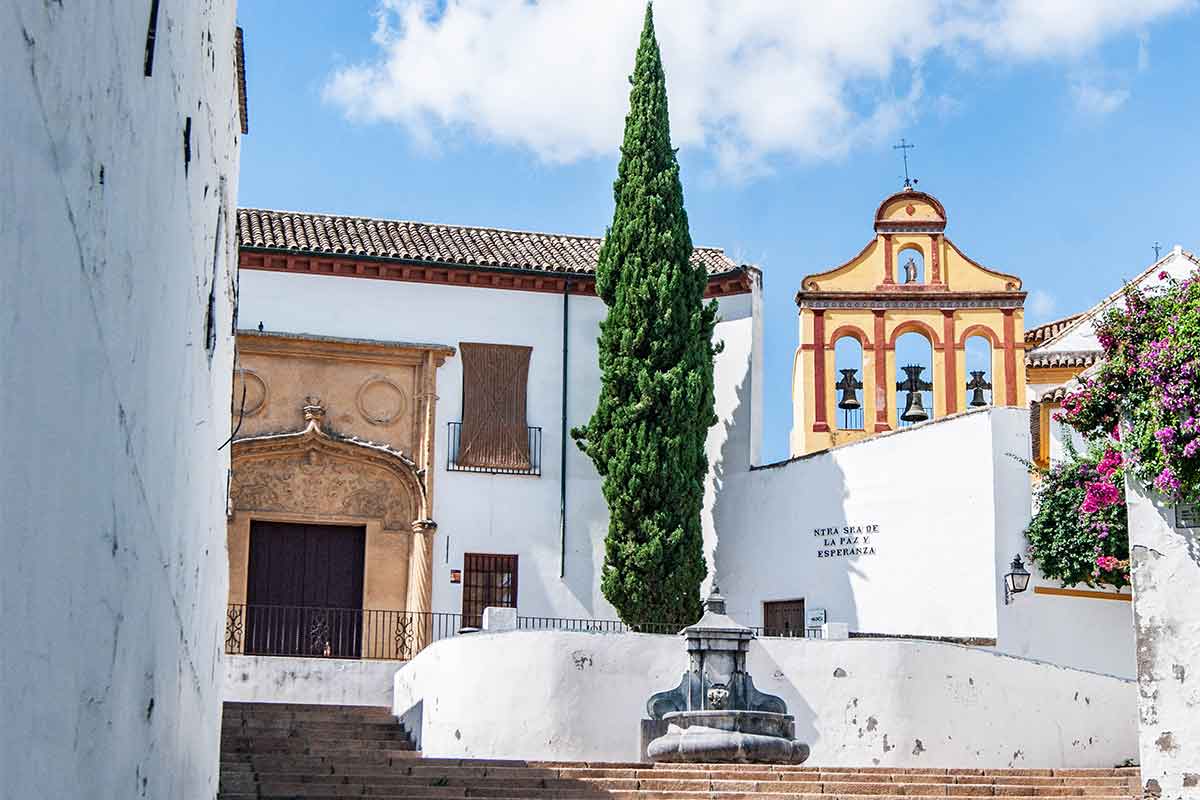
Are you planning your Andalusia itinerary and wondering how to make the most of your stay without missing the most important attractions?
This southern region in Spain is one of the most popular areas to travel to within Europe. And with its sweltering summers, stunning architecture, and beautiful beaches, it’s easy to see why.
As you may already know, Spain is famous for Andalusia and the Costa del Sol , not only for its sought after lifestyle and culture but its incredible and diverse past which is another big pull for tourism to the region.
Table of Contents
Andalusia itinerary
In this guide, we’ll explore the sunny region of Andalusia, talk about some of the main reasons to visit, and the best things to see and do.
We’ll also look at how to get around and our best tips, which include how long to stay for and the best time to visit.
Where is Andalusia?
The Andalusia region is the southernmost region of Spain. Its west side borders Portugal and the east side with Murcia, and the northern part borders the regions of Extremadura and Castilla-La Mancha.
Andalusia’s coastline is bathed by both the Mediterranean Sea and the Atlantic Ocean. This Spanish region is divided into 17 provinces.
Some these provinces are popular touristic destinations:
Did you know? Andalusia is the most populous region of Spain and the second-largest autonomous community in the country.
What is Andalusia known for?
The list of things that Andalusia is known for is quite long. Without any doubt, it’s a go-to destination for its spectacular beaches.
From the Costa del Sol to the 100 km stretch of astonishing beaches of Almería, if you’re chasing ‘sol y playa’, here you’ll feel spoiled by choice!
The artistic and architectural heritage inherited from Arab culture is another reason why Andalusia attracts thousands of visitors.
The Alhambra of Granada, the Alcazaba of Málaga and the Mezquita of Córdoba are only a few incredible Muslim monuments you can explore during your stay in this part of Spain.
Finally, this part of the country is famous for its traditional cuisine, religious festivals, flamenco and the ‘corrida’.
Is Andalusia worth visiting?
Andalusia is known as one of the best summer break destinations in Europe, with the region having consistent and hot weather.
Later in this guide, we’ll look at the climate in more detail.
Throughout the region, you’ll also find some really impressive beaches to relax on, which can be strongly argued to be some of the best in Europe.
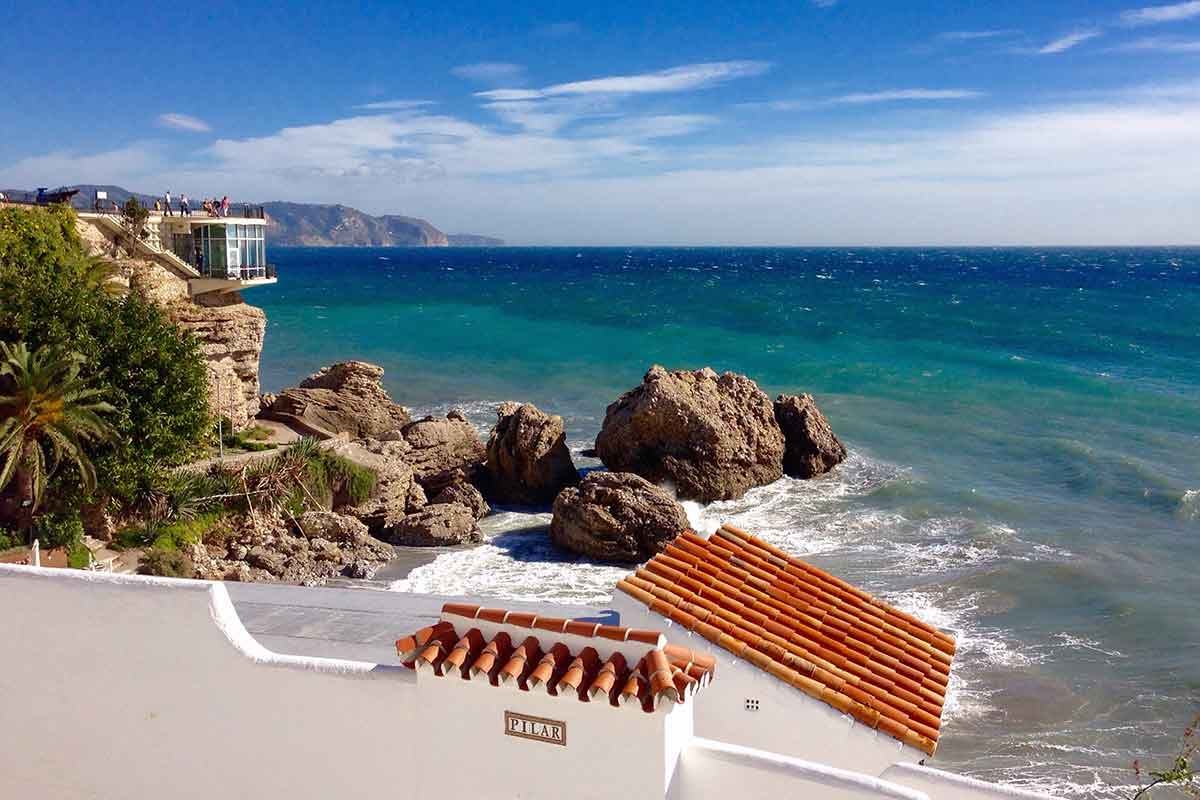
There are both popular city beaches with all amenities a stone’s throw away, as well as wild and secluded beaches for those who like a more private experience. You really can’t go wrong here.
The region is also home to many impressive destinations, as well as a large Moorish influence which can be seen all over the region.
UNESCO sites such as the Alhambra Palace in Granada and the Mezquita Cathedral in Córdoba are some of the region’s best attractions.
The stunning architecture seen in cities such as Seville and Granada is also a pull for those coming to the region, where pebble courtyards, painted tiles, and giant stone walls dominate the urban landscapes.
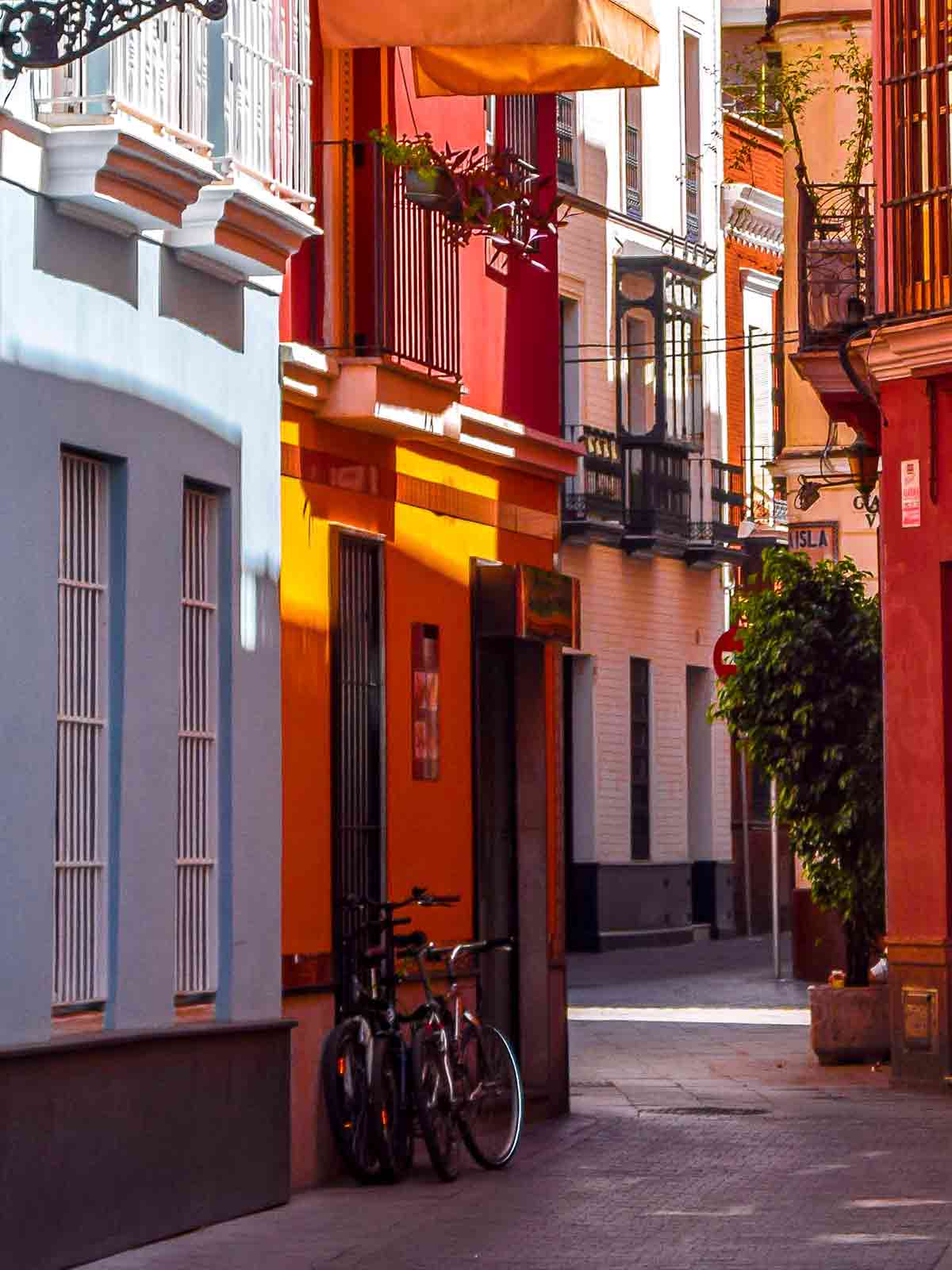
Just walk through any city or town in the region and you’ll see examples in hidden streets you pass by and on random buildings your eye catches.
Andalusia is also well-known for its food, with Gazpacho soup the absolute must-try here. Then of course there’s the tapas, with Tortillitas de Camarones and Croquetas as some of the best to start your appetite.
What is the best month to visit Andalusia?
In our opinion, the best month to visit Andalusia would be April or May.
September and October are also very favorable, especially because the average temperatures usually hover between 20 and 30 C°.
The reason why we don’t suggest visiting Andalusia during the summer months is that temperatures can be extremely hot (40 C°) and most tourists travel between July and August.
To avoid crowds, then choosing shoulder seasons is the best way to go to fully enjoy your time at the beach and when visiting the historical landmarks and historical centers.
How to get in and around Andalusia?
Andalusia is located in southern Spain, and you can easily arrive from other major cities in the country such as Madrid and Valencia. You can also arrive from Portugal, and also by ferry from Morocco in the south.
If elsewhere in Europe, then you’ll need to fly in (unless you don’t mind a very long drive or multiple buses).
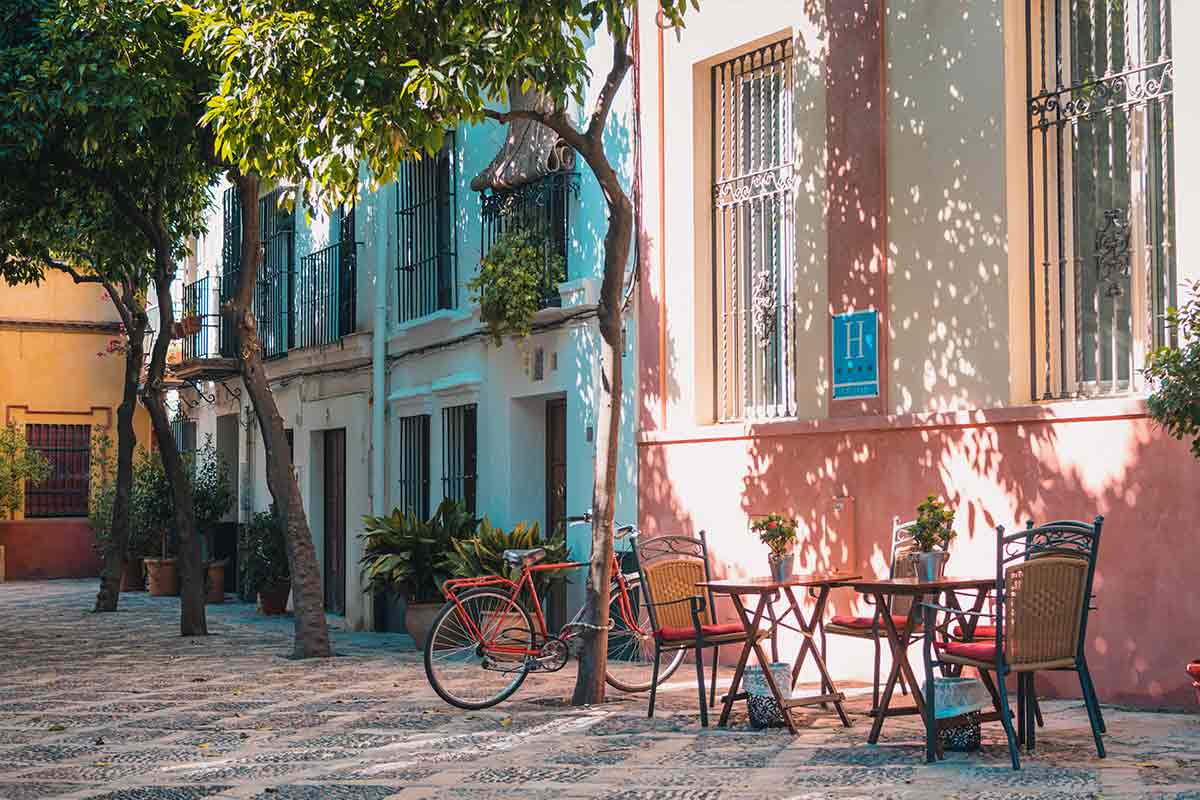
Malaga is the hub of Andalusia, and flights into the city are some of the cheapest in the region. There’s also an airport in Seville which has lots of good connections.
Andalusia is also a very easy region to get around once in. Even if you don’t have the budget to rent a car , there’s a train that runs through the major cities and towns, and the rest is well connected by bus.
How Many Days to Spend in Andalusia?
We’d say a minimum of 6 days is enough to see the best of Andalusia.
More would be better, but this amount of time would allow you to get a good feel for the Spanish region.
Here you would start by arriving in Malaga and spending a day exploring Gibralfaro Castle and also lounging on the beach.
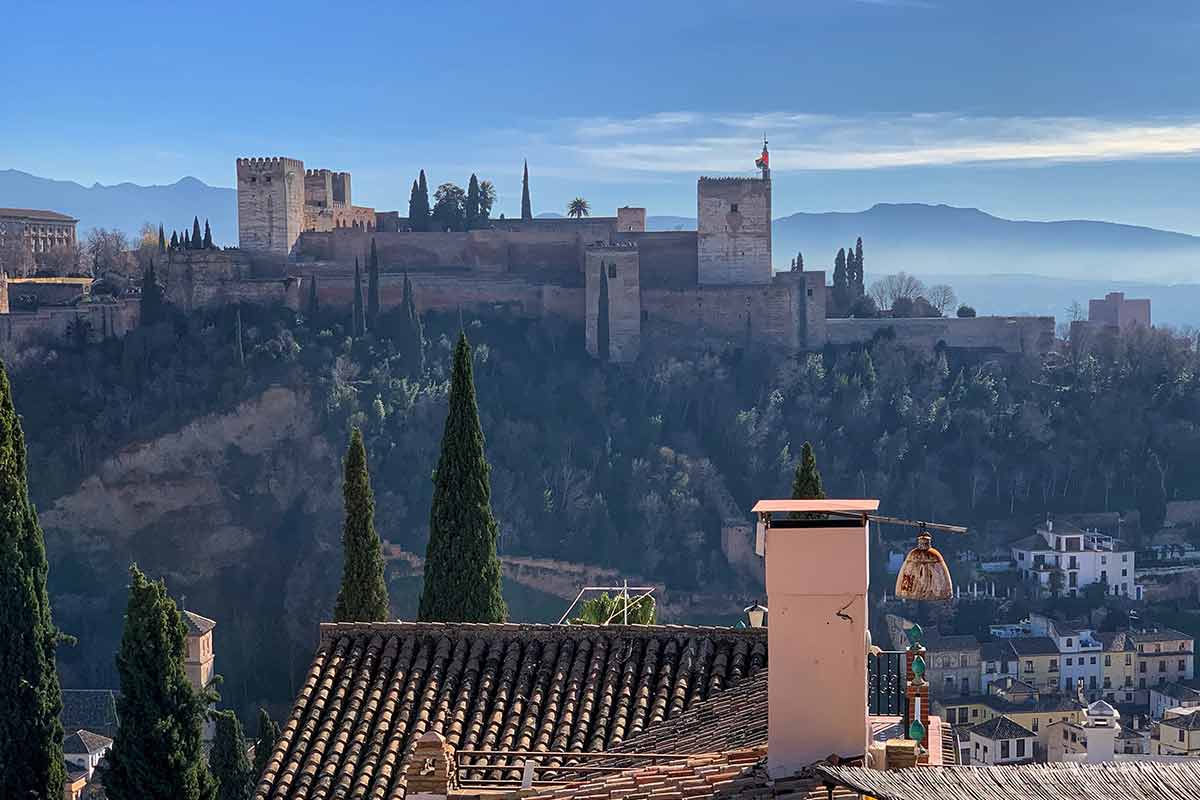
The next 2 days will be spent exploring Granada, its amazing cobblestone streets, and the impressive Alhambra Palace.
From here you would then spend 1 day in Cordoba to see the legendary Mestique Church.
Your last two days will be spent in Seville, where you can see the Plaza de Toro , the Plaza de España as well as sitting back to take in Andalusian life.
Places to visit in Andalusia
Below, we have outlined the places to visit in this Andalusia itinerary.
If you have already taken the time to read our guide to 3 days in Madrid you can be sure to trust us to have more travel gems lined up for you.
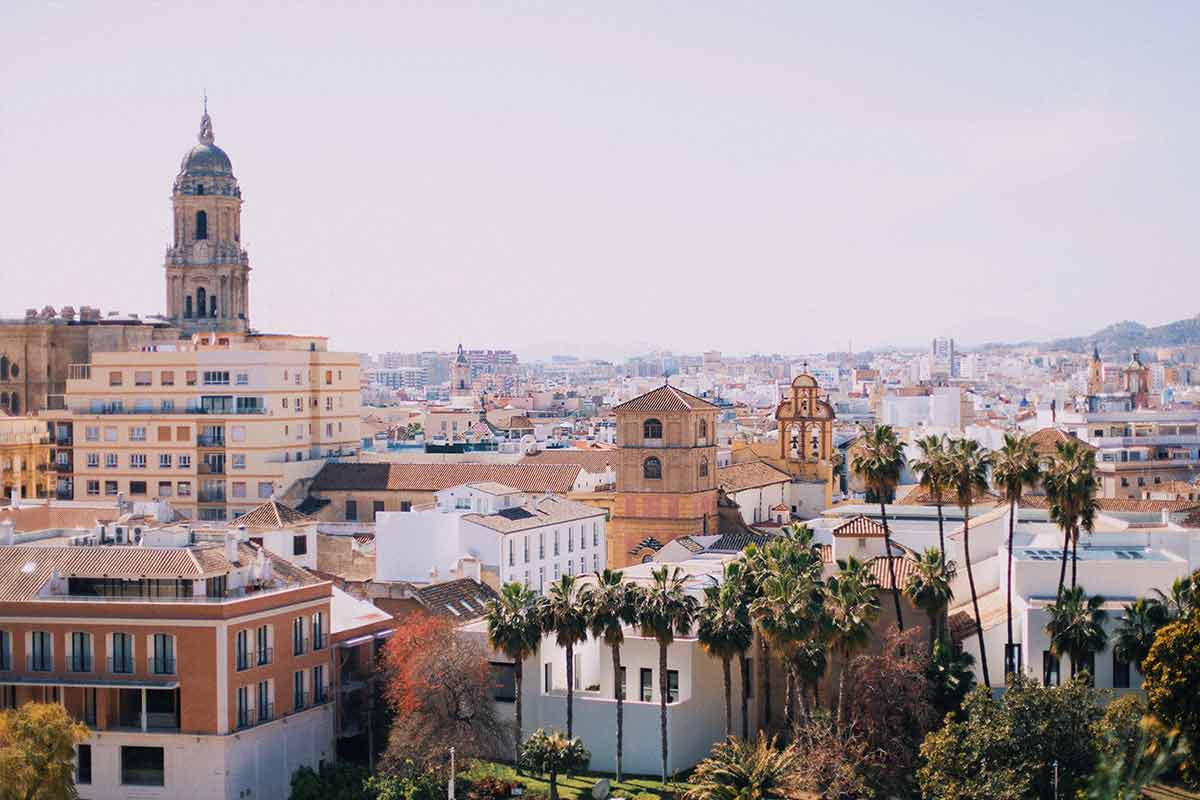
Let’s start with the popular beachside hub of Malaga. Drawing a large number of tourists from all over the world, Malaga is well-known for its position along the Costa del Sol and its incredible stretch of beaches.
One of the best things to do in Malaga is to hike up to Gibralfaro Castle. From here you’ll learn about the ancient fortress, its importance for the city as well as get some stunning views over the city and bay of Malaga.
Another great thing to do here is to visit the historic center where you can see many important landmarks and sights including the Alcazaba, doing a tour of Teatro Romano and the Cathedral of Malaga.
The Alcazaba is one of the most popular to visit, with the ancient fortress being built during the 11th century, and is a great place for travel photos.
Malaga is usually the starting point of any trip to Andalusia with its well-connected airport.
Here there are plenty of accommodation options for all budgets (even some top-notch hostels if you’re on a modest budget) and travelers.
There are also lots of quirky restaurants and bars. The best places to stay are near Malagueta Beach and also the historic center.
This cobblestone-laden city is one of Spain’s most scenic places to visit
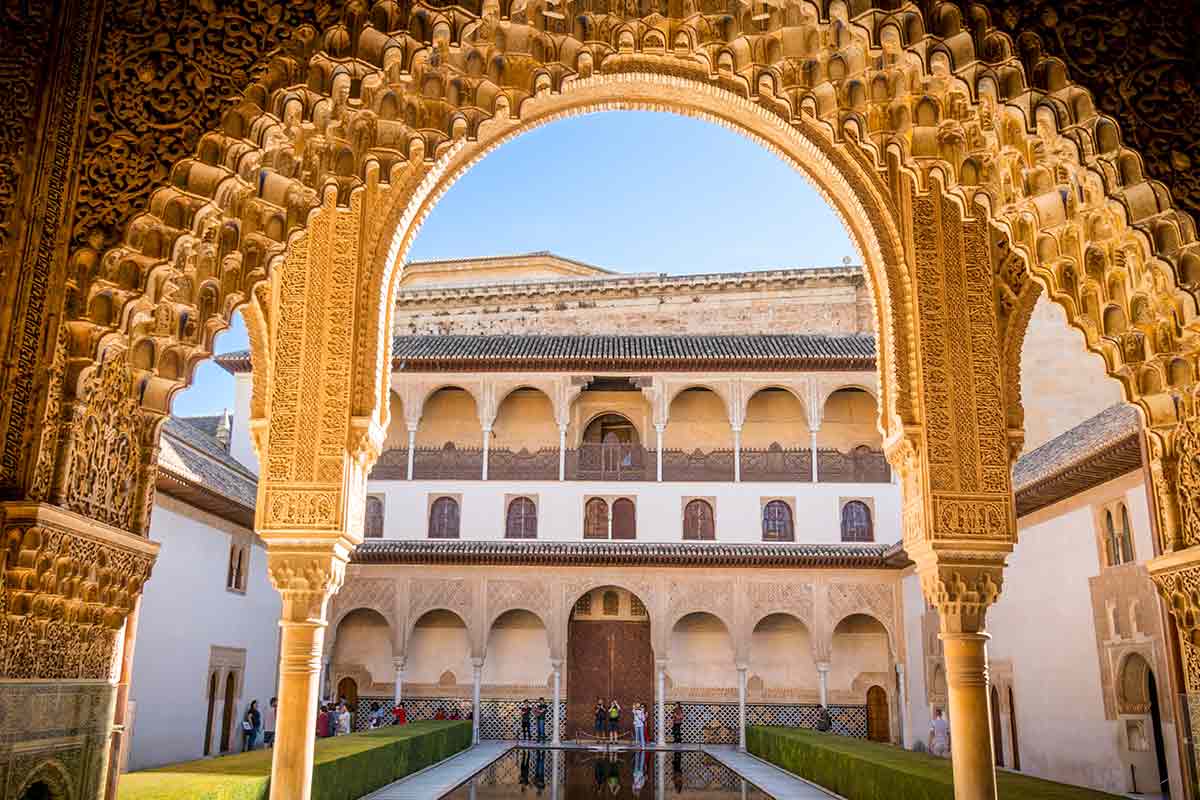
Known for its university and student life, Granada is also home to some stunning natural scenery since it’s located next to the Sierra Nevada.
The best thing to see here is the legendary Alhambra Palace. Built in 1238, this palace is situated on top of a hill and overlooks Granada. It’s a UNESCO World Heritage site and one of Spain’s most visited landmarks.
Here you can marvel at its impressive towers, picturesque fountains, and courtyards, as well as Arabic patterns and inscriptions.
Another must-visit is the Puerta del Elvira . The giant door towers over the nearby streets and was once the main gateway into Granada.
As mentioned earlier, Andalusia has a strong Moorish history which is reflected in its architecture, and Granada is one of the best places to marvel at these incredible designs and heritage.
One way to experience this unique culture is by going to a Hamman Spa where you can relax for the day. We recommend heading to Hamman Al Ándalus , which is located next to the Iglesia de San Gil y Santa Ana.
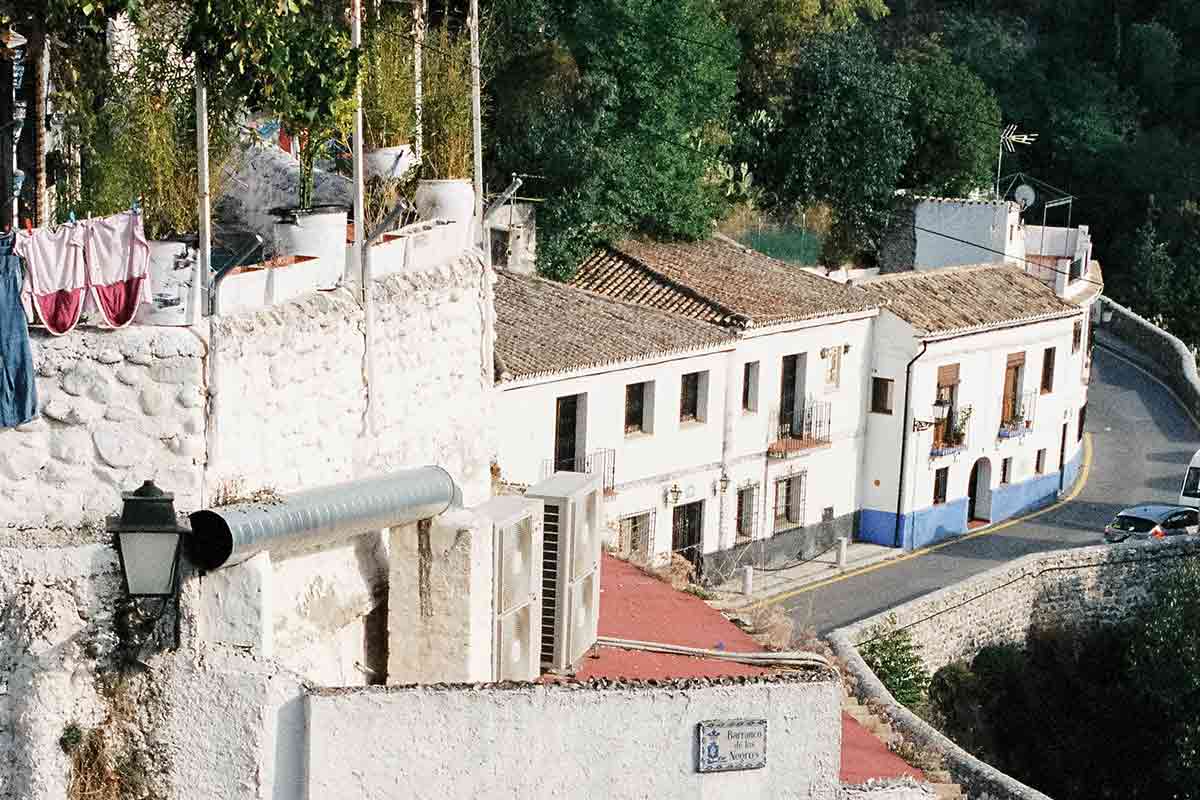
One of the best areas to stay is the Albaicin neighborhood, which is the oldest district and one of the most picturesque. Check out places Shine Albayzín for a typical Granadan stay.
Here you’ll find lively streets filled with tapas bars and markets. Also, the area around the Plaza de Santa Ana is a good place to base yourself.
Córdoba is another beautiful city located in Andalusia. Its best known for the Mezquita Cathedral, which used to be a mosque, however, has since been transformed into a Roman Catholic Church.
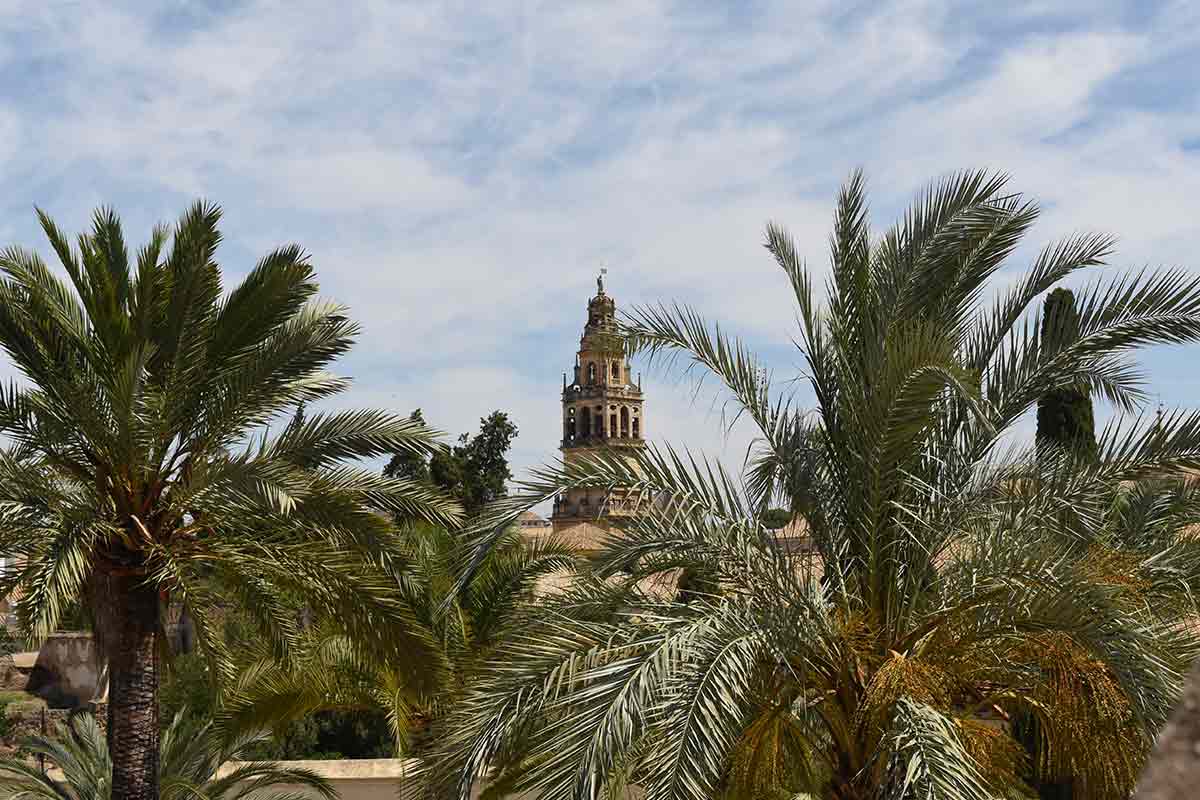
This gem is one of the region’s most popular sights, with its impressive painted columns and half-moon arches that fill the entire complex.
One of the best things to witness here is the glowing effect when the sun shines through the windows into the main hall.
There are also lots more impressive architectural delights to see in this city, which include the Alcázar de Los Reyes Cristianos and its beautiful gardens and fountains.
This royal complex is also home to the largest library in Western Europe.
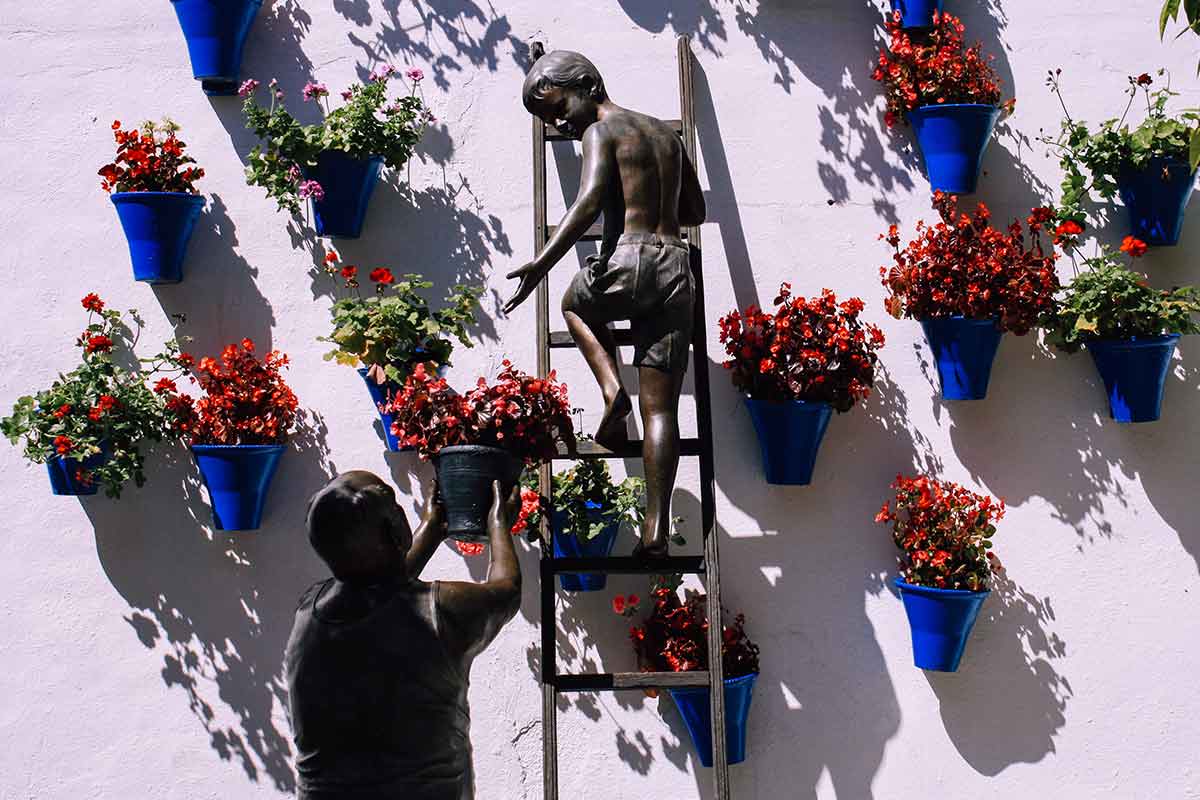
As well as this, the Jewish Historic Quarter is great to wander around with its narrow, mazing streets once thriving as the largest ghetto area of the city.
If you are looking for a place to rest your head, check out La Trinidad Córdoba for a sustainable stay which includes a traditonal breakfast.
Another must-see is the Calahorra Tower which once guarded the city from as early as the 13th century. It also later became a prison and even an all girl’s school, making for an interesting visit when in Córdoba.
The best area to stay in Córdoba has to be Juderia. The Jewish Quarter is great for those who want an authentic feel, and to be surrounded by lots of history, striking architecture, and lively streets.
The capital of the autonomous region of Andalusia, Seville definitely does not disappoint. Known for its searing summer heats and passionate flamenco dancers, this city is a must-visit on any trip to the region.
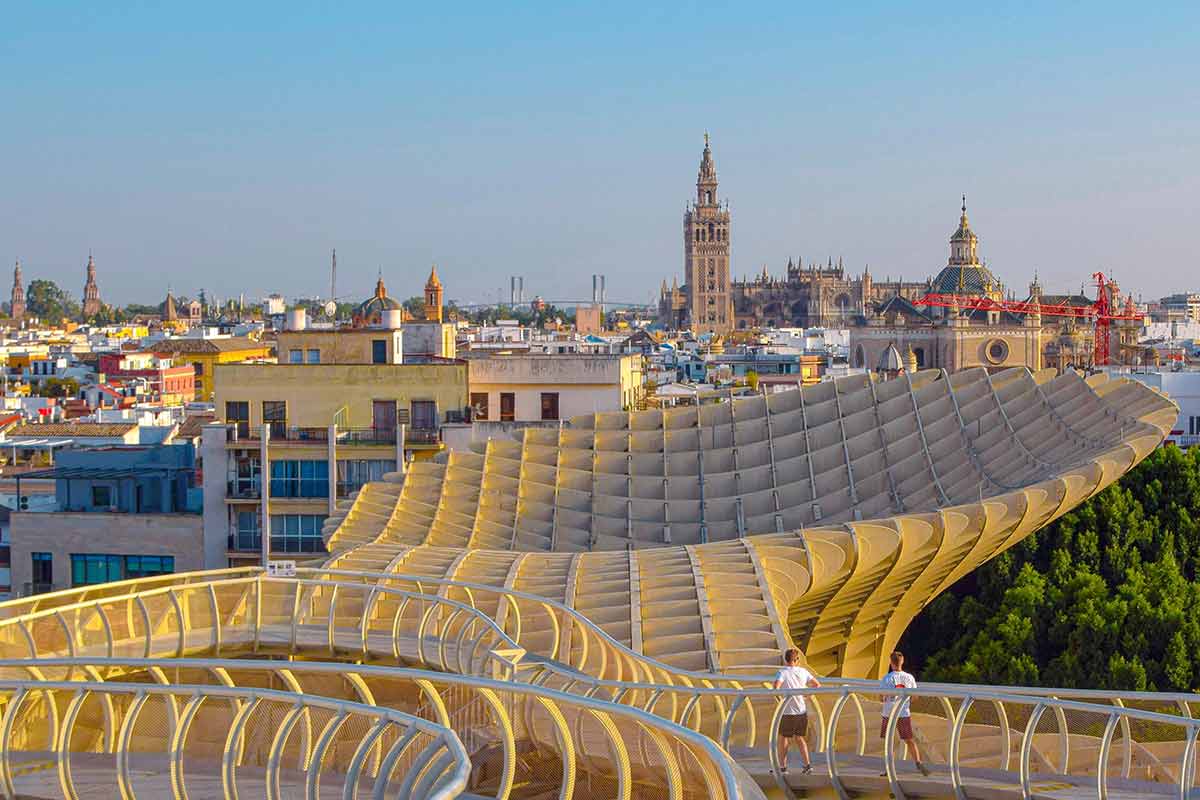
Here there are many top sights to visit. The Cathedral of Seville (along with the Giralda Tower) is one of the top highlights, and with 80 chapels, is the largest cathedral in the World.
It also houses the tomb of Christopher Columbus, and rightfully so is a UNESCO world heritage site. Plaza de España is another must-visit when here, with the massive monument built in 1929.
The curved palace is shaped like a half-moon, and is filled with beautiful azulejos (which are painted tiles native to the region). Check out this guided tour to get a closer look at all these detials.
With its public bicycles and smart city initiatives, Seville is perfect for exploring, with the Guadalquivir river and many plazas great for a stroll.
This is also the best place for seeing a live flamenco show, where spontaneous dances can happen pretty much anywhere at any time.
You can also go to designated venues to watch the dances, which are known as Tablaos .
When in Seville, the best area to base yourself is El Centro , which has most of the popular destinations located nearby. For cheap dorm rooms Black swan hostel is a popular place to stay for budget travelers.
Barrio Santa Cruz is another great area that’s worth visiting and home to Catedral de Santa María de la Sede – the world’s 3rd largest church.
Known as the white city of Spain, Cadiz is an ancient port city located in the south of Spain that is also home to the Spanish Navy.
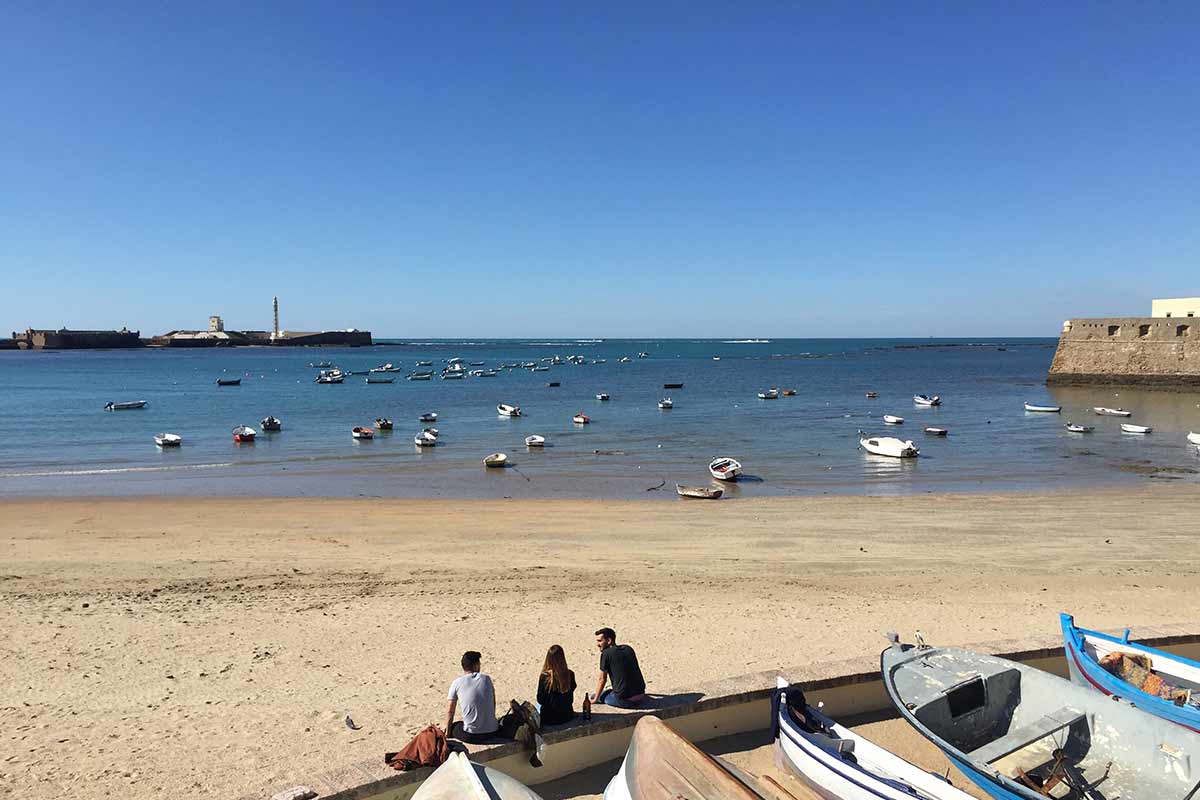
As well as the vast sea of white buildings, this city is known for its equally important architecture. A quick city bike tour reveals all the best facades.
The Torre Tavira is a tower that can be climbed for the best vantage point over the city. Other impressive sights include the cathedral of Cadiz as well as the Castillo de Santa Catalina .
For those who love beach time, then be sure to head to La Caleta (which is the best beach in the city) as well as Las Playas de Caños de Meca .
For those who love fresh seafood and other foods, be sure to head to the Mercado Central where you can try everything from fresh fish and meats to vegetables supplied by local farmers and typical Spanish baked treats.
Cadiz also has many lively plazas and dozens of watchtowers that line the coast, which gives the city a unique presence in Spain and makes it feel very similar to coastal cities in South America such as Cartagena.
When heading to Cadiz, be sure to stay in the Old Town. Not only is it home to the must-visit Torre Tavira; there are also many quaint plazas here such as Plaza San Antonio and Plaza de Mina .
Andalusia Travel Tips

See our list of travel tips to take with you:
- We first recommend taking advantage of public transportation. You can use the train to get between major destinations, running from Malaga in the east to Seville in the west. You can then also use public buses to get to the further afar and smaller towns.
- Secondly, consider visiting during some of Andalusia’s festivals. This region is known for some extraordinary events such as the Cruces de Mayo (held in early May) and the Feria de Seville (in April).
- If you decide to rent a car in Andalusia you’ll find it easier to travel outside of these bigger cities and more frequented tourist areas.
- A visit during these times promises a rich cultural experience and a better look into the values and heritage of the Andalusian people.
- The cities suggested and landmarks we have suggested above are designed for you to see some of the regions most popular places!
- Remember to get your FREE travel insurance quote from SafetyWing to receive fully comprehensive support when it comes to unforeseen travel complications.
- If you are traveling alone, be sure to ‘always’ carry your cell phone along with you, if you have one that is. Even if you are just popping out of your hotel to go to the shops.
- Try to carry cash and items of value with you at all time in a front or inside pocket, you’ll find Pacsafe make some great bags/backpacks for traveling around with valuables.
Best Time to Visit Andalusia
Andalusia is known for its hot summers, where temps can often become unbearable at times. During the summer, it’s not unusual for daytime temps to exceed 104°F, especially in the cities of Granada and Seville.
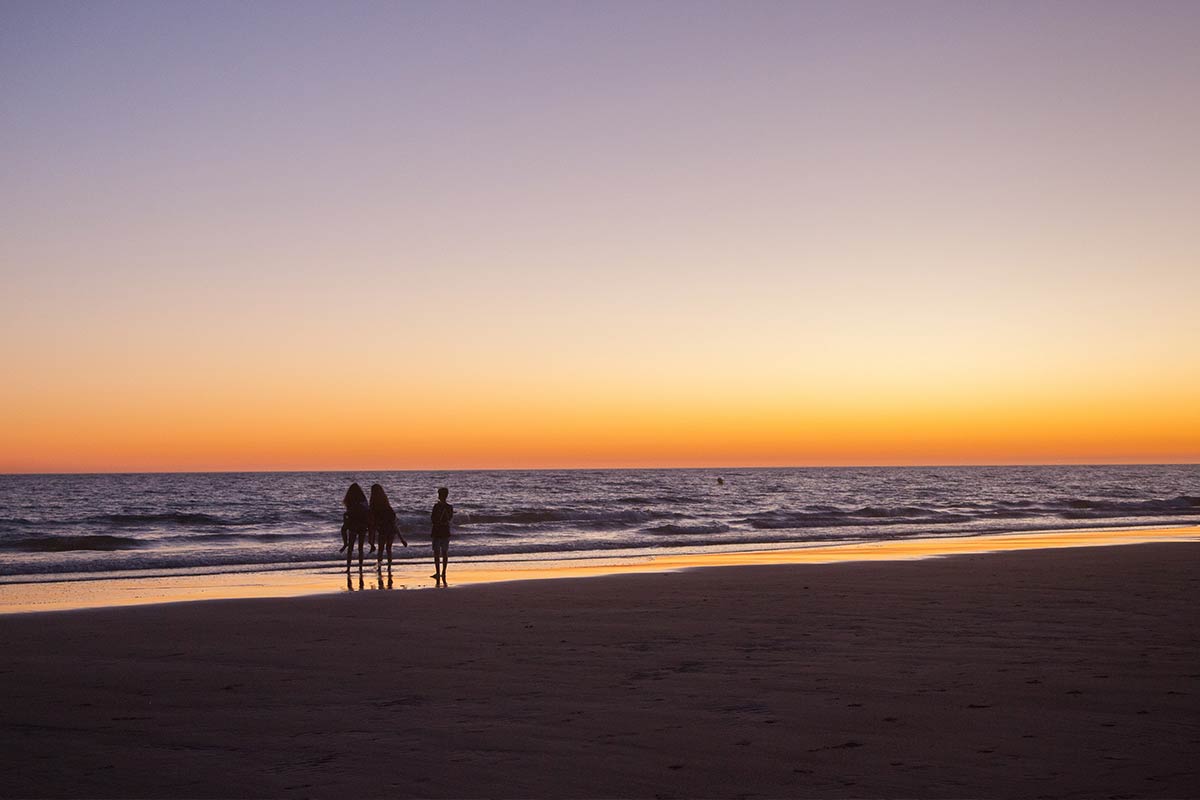
As mentioned earlier, the best time to visit for warm temperatures and a stable climate is the shoulder months of April-May / September-October.
For example in Seville, these months have average daily temps of between 64-75°F. The nights are cool and bearable compared to the hot nights during the summer.
During the summer, average temps in Seville range from 84-90°F. Whilst this sounds nice and warm, due to the city being located far inland, temperatures often feel hotter than they show.
If going in the height of the summer season, be prepared that temps can and do often rise above 104°F. So make sure you take lots of sunscreens and avoid heading out in the sun during midday.
The winter months are also popular with those traveling during the Christmas break, although a lot less visited than during the summer.
Average temps in Seville range from 52-59°F, which is a lot cooler and even sometimes chilly.
7 days in Andalusia Itinerary
As well as things to do you should have an idea of which places are integral to include in your Andalusia itinerary.
Is this all you can do in the region? Absolutely not!
There’s much more to see in the region and we guarantee that Andalusia will surprise you and make you want to revisit time and time again.
Andalusia is full of hidden gems, with everything from quaint mountain top villages, palaces, castles, and rustic shops to cafès and beaches.
Get lost exploring and get acquainted with the Andalusian culture.
Also, be sure to follow some of our sustainable travel tips to ensure that your trip has a positive impact on the local environment.
This post contains affiliate links, meaning, if you click through and make a purchase or sign up for a program, we may earn a commission. This is at no additional cost to you.
Sharing is caring!
Recent Posts
- How to get from Treviso Airport to Venice
- How to get from Verona to Lake Garda
- Marco Polo Airport to Venice
- Is Guadalajara safe?
- Living Abroad
- Sustainability
- Travel Blog
Privacy Overview
Travel Safe
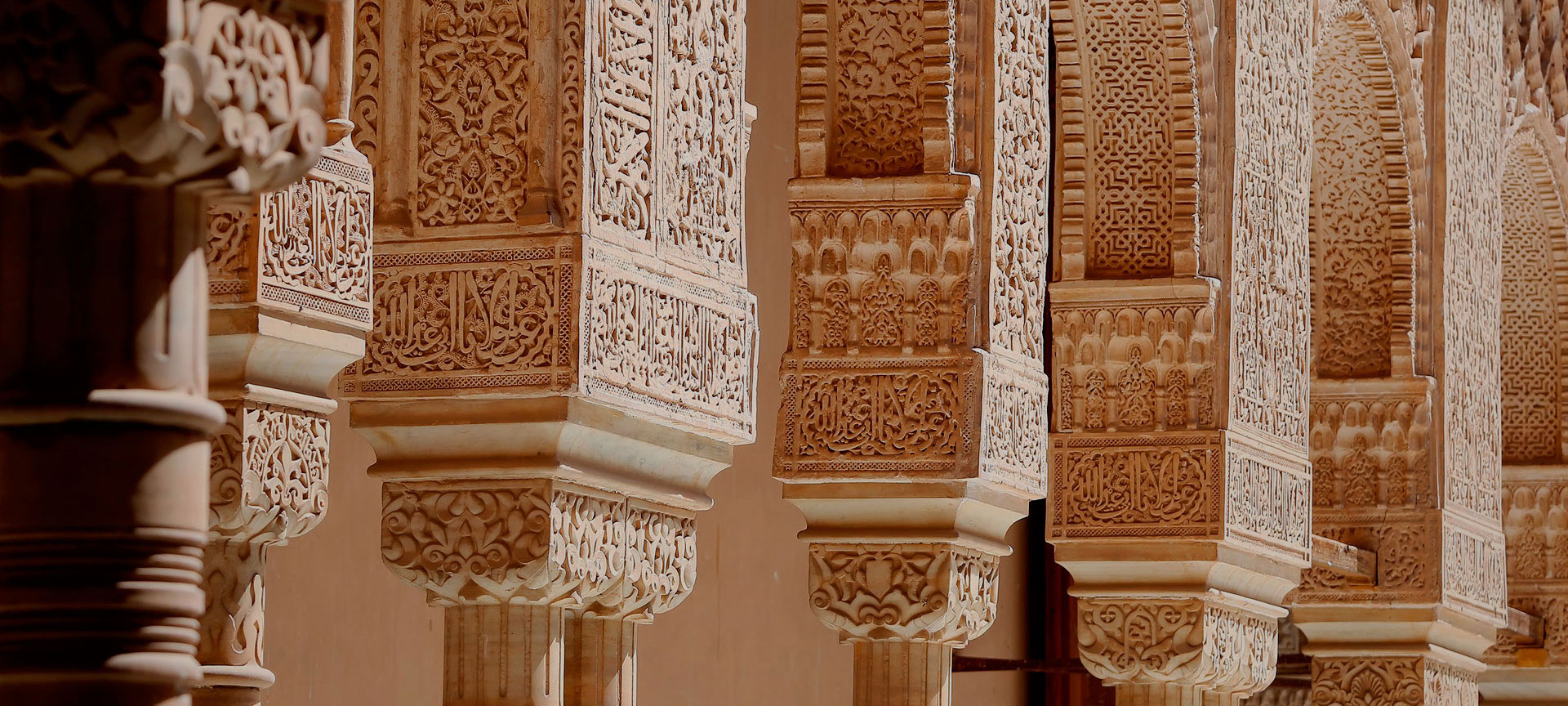
This is a land of culture, history, fiestas, nature areas and excellent food. You’ll be able to visit everything from outstanding monuments to a wide variety of different natural landscapes… and you'll have the chance to take part in several unique popular events and sample a range of delicious gastronomic products.
One way to discover the culture of Andalusia is by exploring the sites which have been awarded the UNESCO World Heritage designation. In Granada, you’ll see the Alhambra palace, the Generalife gardens and the mediaeval Albaicín neighbourhood; in Cordoba, its historic centre with the great Mosque; in Seville, the cathedral, the Alcázar palace and the Indies Archive; and in Jaén, the monumental sites of Úbeda and Baeza. You’ll also be able to experience festivals such as Easter Week, the Carnival in Cadiz, the Rocío pilgrimage in Huelva and the April Fair in Seville.
You'll find a variety of natural landscapes which range from the beaches of the Costa del Sol, Costa de la Luz and Almería to the extensive olive groves of Jaén. You can visit the Doñana National Park –also declared a World Heritage Site–, or go skiing in the Sierra Nevada ski resort. Finally, remember that Andalusia has a thousand different flavours waiting to be tried. From the sherries of Jerez (Cadiz) and Montilla – Moriles (Cordoba), to the classic platters of fresh fried fish known as “pescaíto frito” from Cadiz and Malaga, cured ham from Huelva and Cordoba, olive oil, and other such typical dishes as gazpacho and “salmorejo” (a kind of thicker gazpacho).
Empresa Pública para la Gestión del Turismo y del Deporte de Andalucía, S.A. (Public Company for the Management of Tourism and Sport in Andalusia)
Parador de San Rafael, C/ Compañía, 40 (Málaga)

+34 951 299 300
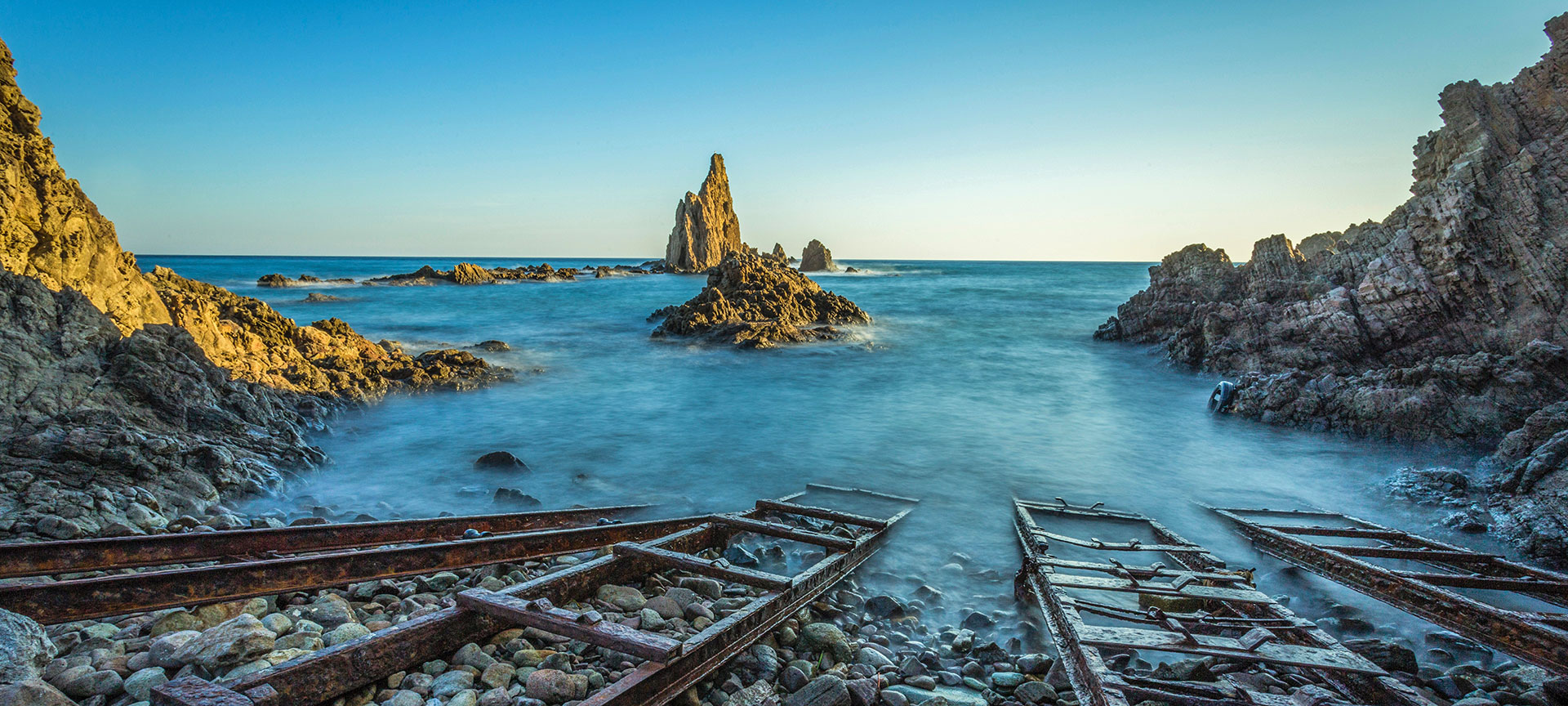
Get to know the provinces of Andalusia
Almería (Province)
Cádiz (Province)
Córdoba (Province)
Granada (Province)
Huelva (Province)
Jaén (Province)
Malaga (Province)
Seville (Province)
Of particular interest are the Sierra María-Los Vélez Nature Reserve, with its castle, and the Cabo de Gata-Níjar Reserve, with its endless unspoilt beaches and cliffs.…
It has festivals of International Tourist Interest as the prestigious Carnival of Cadiz, the unique horse racing events on the beach at Sanlúcar de Barrameda, and the elegant Horse Fair in Jerez de la…
It is well worth exploring its stately white villages, olive groves and mountain landscapes in places such as the Sierra de Hornachuelos and the Sierras de Cardeña and Montoro Nature Reserves.…
In winter, the province offers the chance to ski while enjoying views of the sea, thanks to its distinctive natural setting which includes both a coastline and snow-capped mountains.…
Huelva's cultural attractions include its Baroque architecture in the Condado area, and the Columbus Route of the sites connected with Christopher Columbus (Moguer, Huelva, Palos de la Frontera; from…
This is the home "par excellence" of olive oil, and there are olive groves covering as much as two thirds of the cultivated land in the province.…
The province lies on the shores of the Mediterranean Sea, and has 160 km of coastline with a multitude of beaches and marinas.…
The province is the setting for two outstanding festivities which are famous for their colour and passion: the April Fair and the Easter Week religious processions, both declared to be of International…
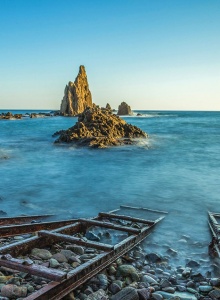
Places not to be missed
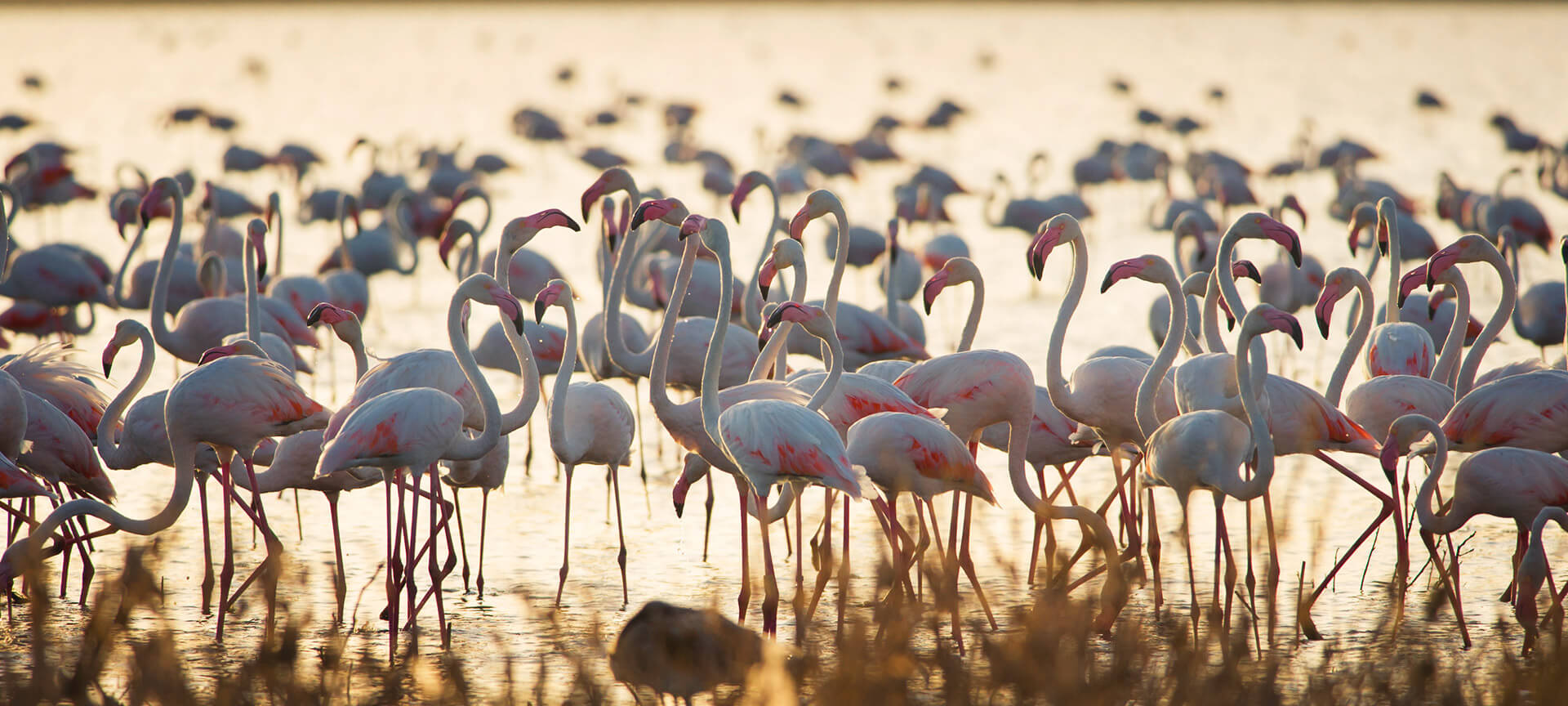
Doñana National Park
Doñana is one of Europe's most beautiful and important wetlands.…
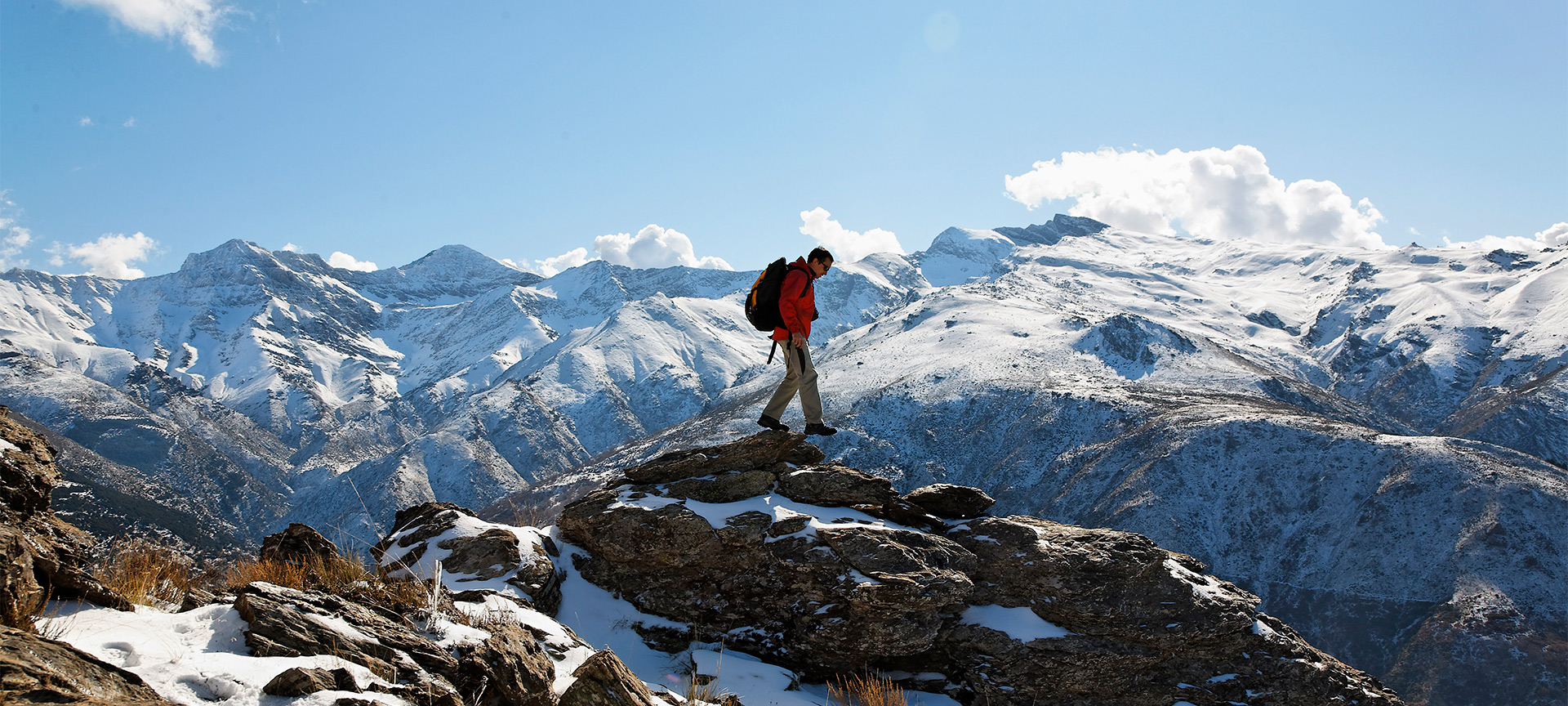
Sierra Nevada National Park
In eastern Andalusia in Granada and Almería you'll find the…
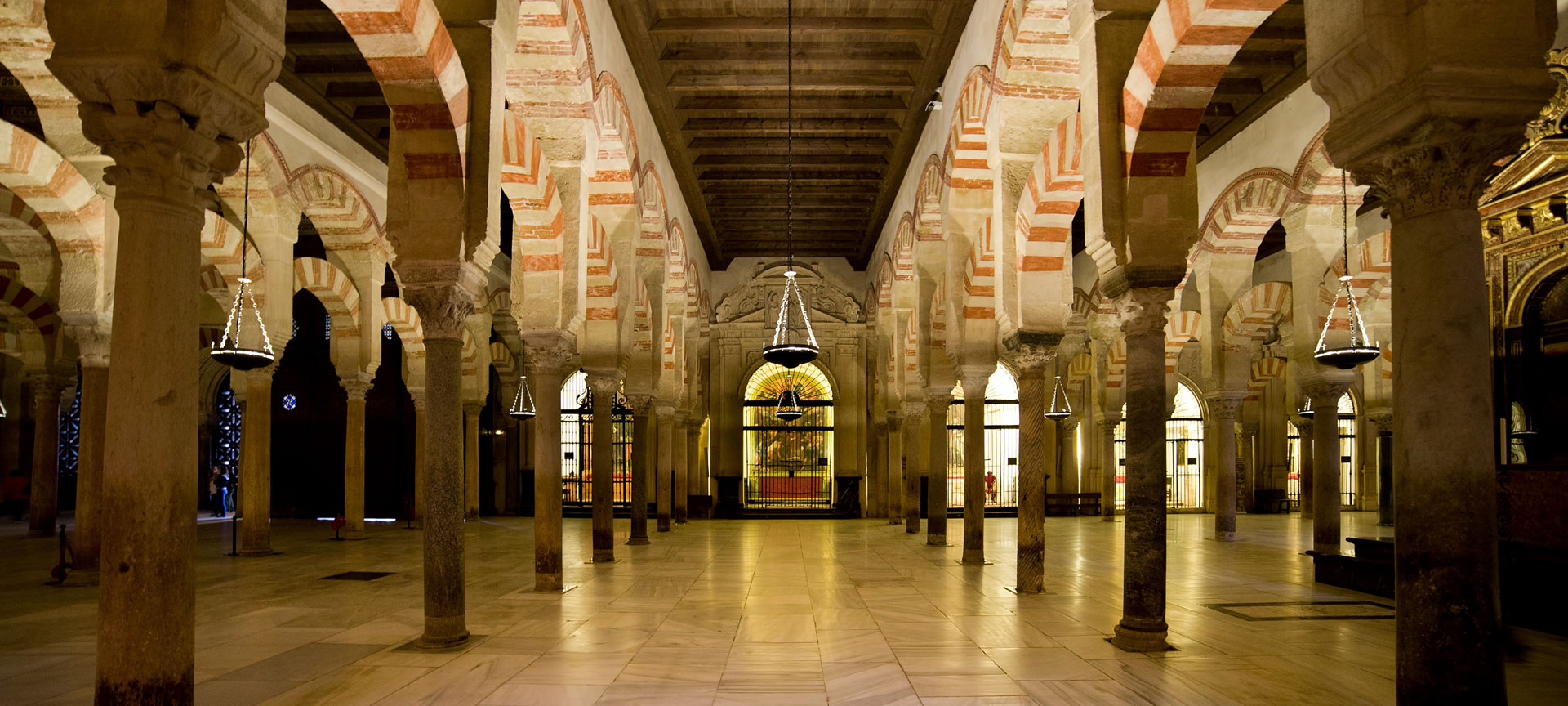
Great Mosque of Cordoba
The Great Mosque of Cordoba is a mixture of architectural styles…
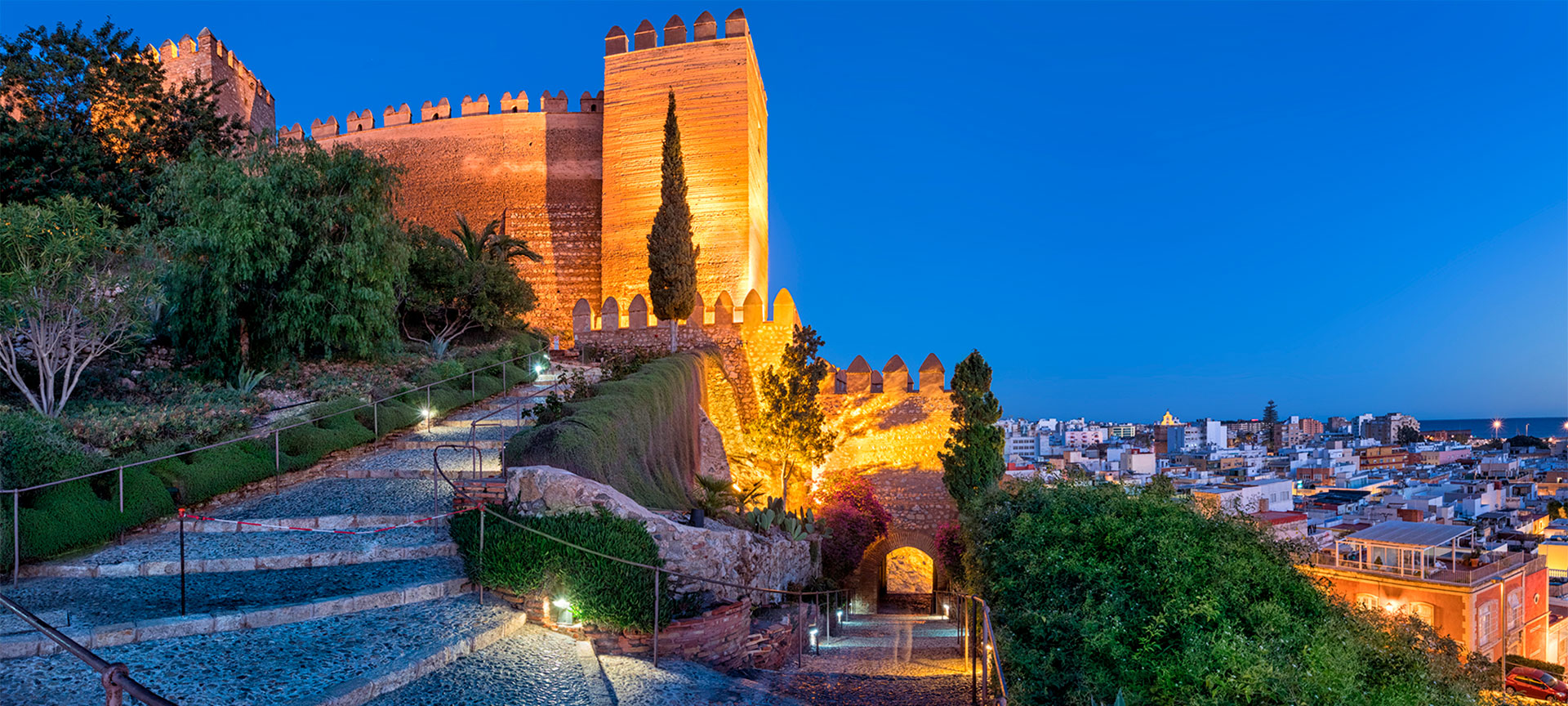
Almería Fortress
It was built by Adb al-Rahman III in 955 AD on the ruins of a…
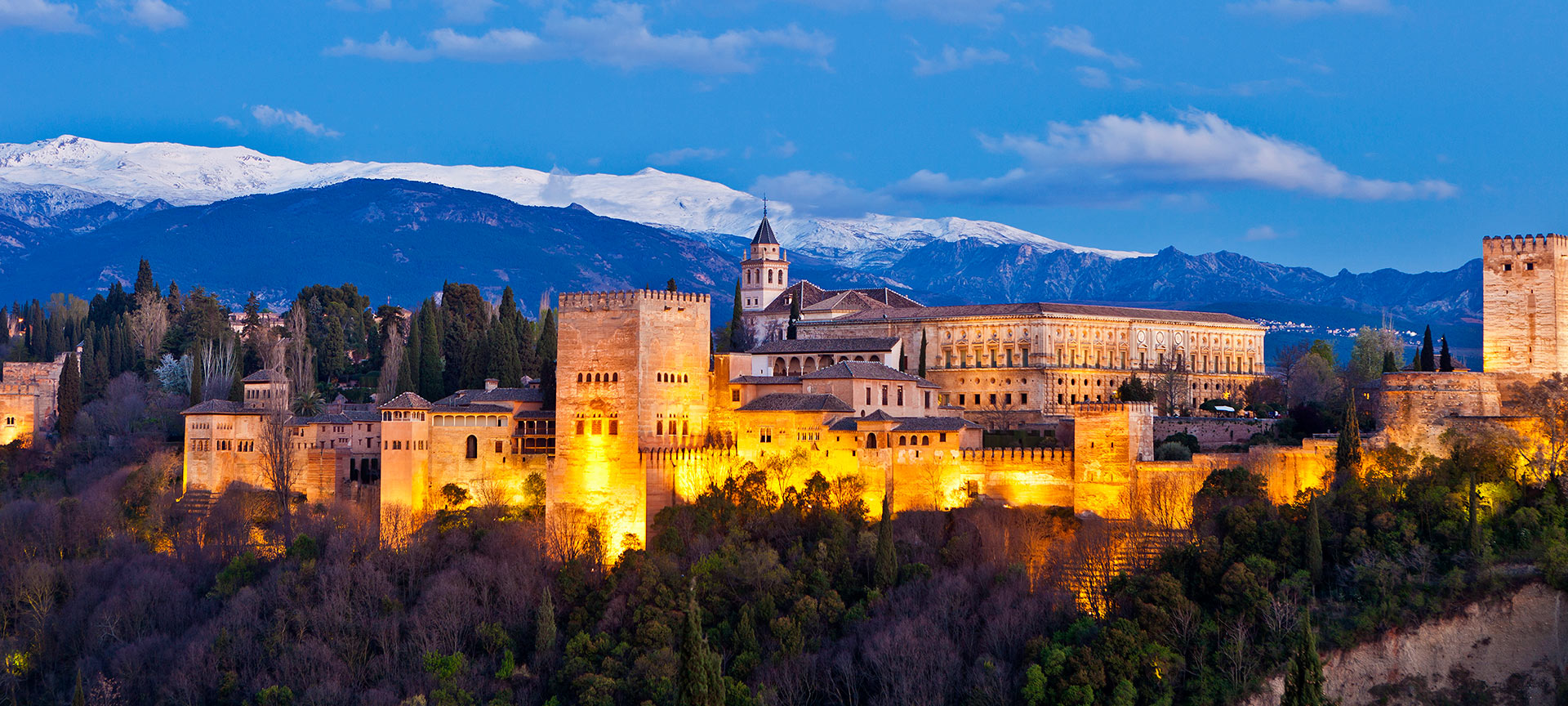
The Alhambra
The Alhambra is a beautiful complex of buildings and gardens.…
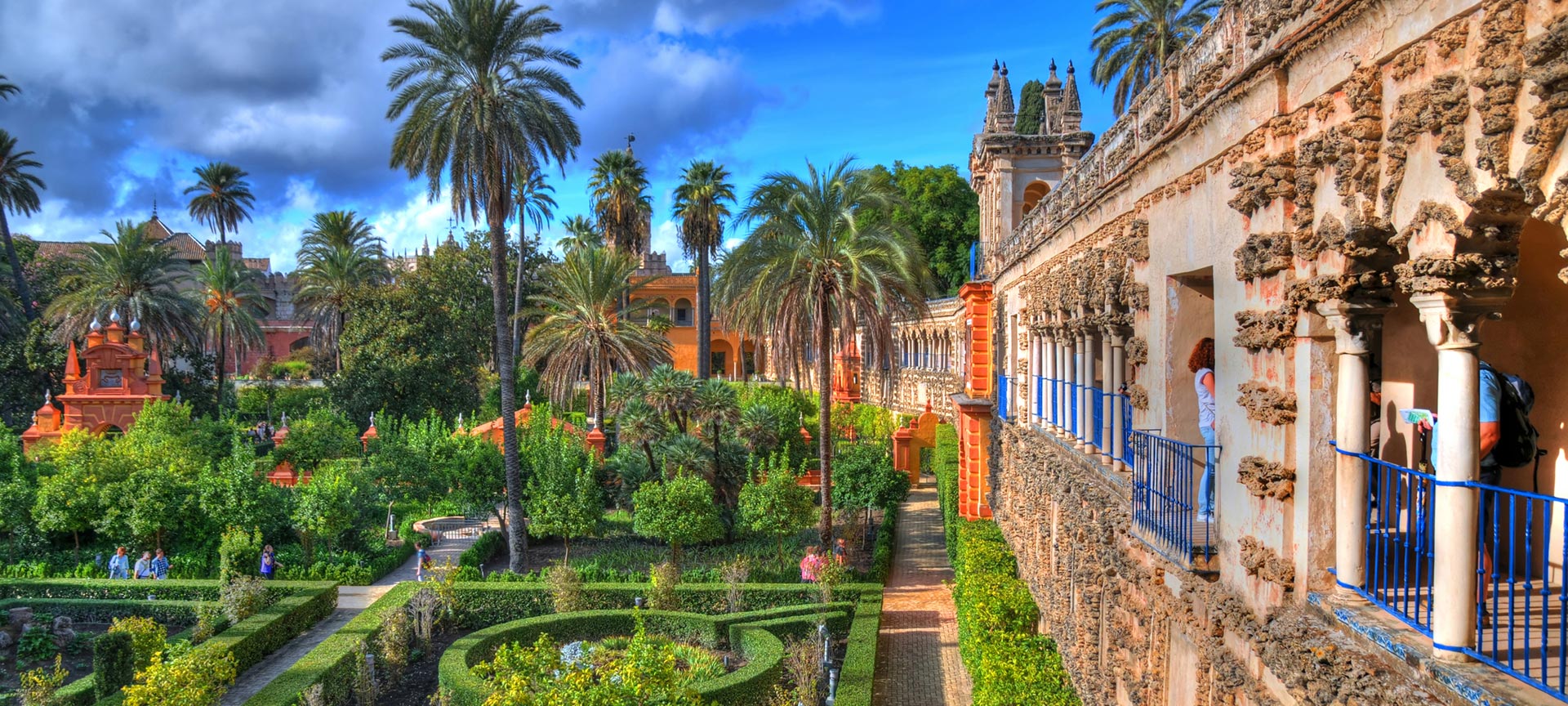
Real Alcázar Palace of Seville
The Real Alcázar in Seville is a group of palaces surrounded by a…
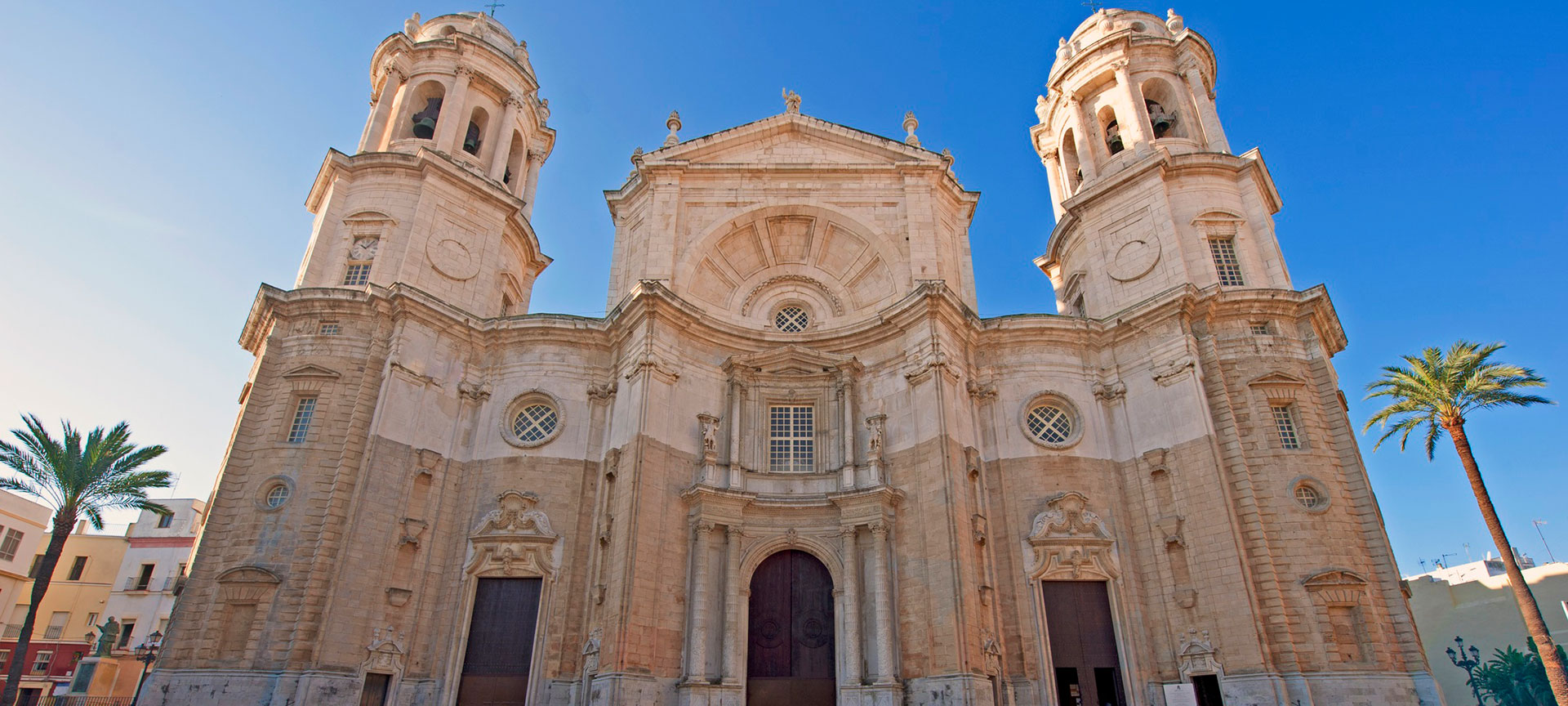
Cadiz cathedral
It took 116 years to complete, so the mix of styles is evident.…
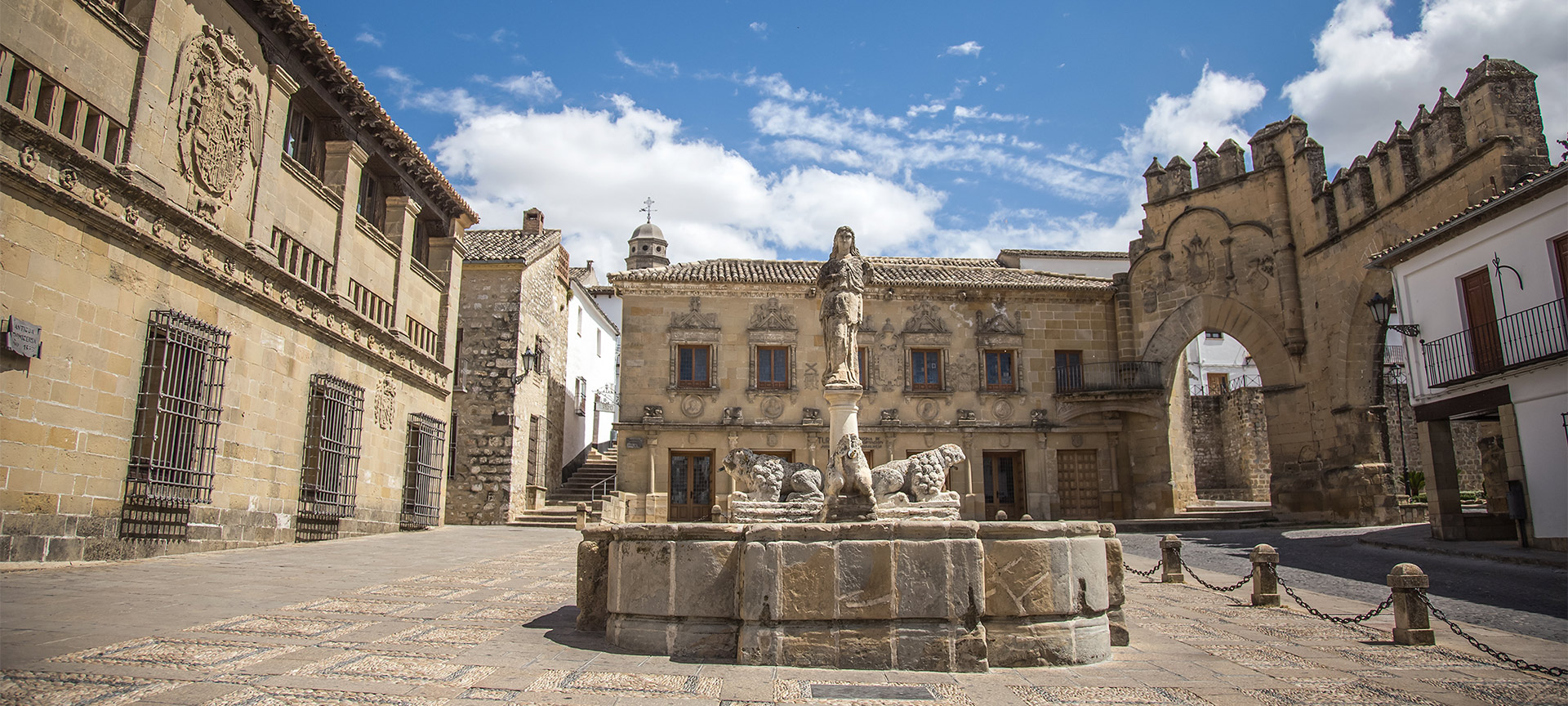
Baeza is in the province of Jaén, where some of the world’s…
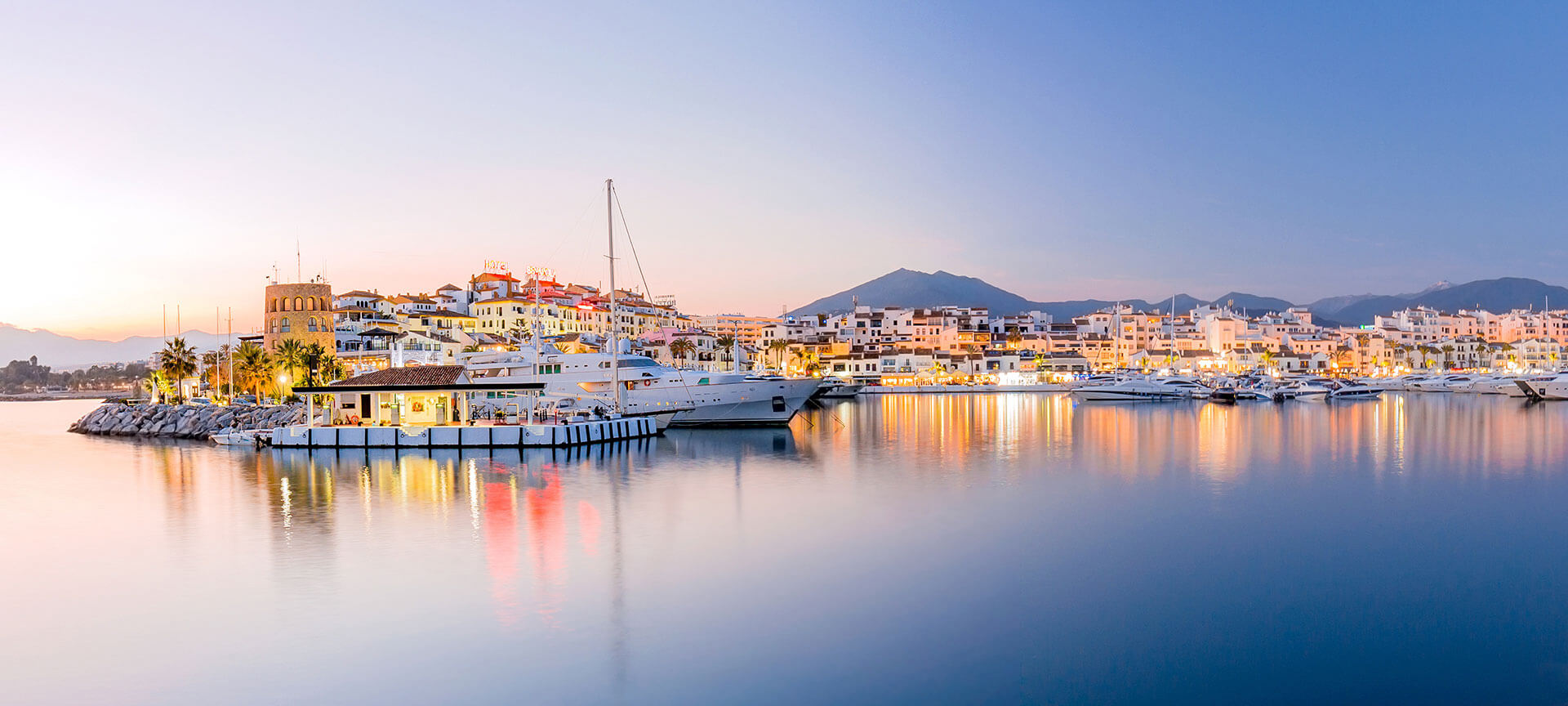
Costa del Sol
Endless beaches to stroll along, hidden coves, white villages…
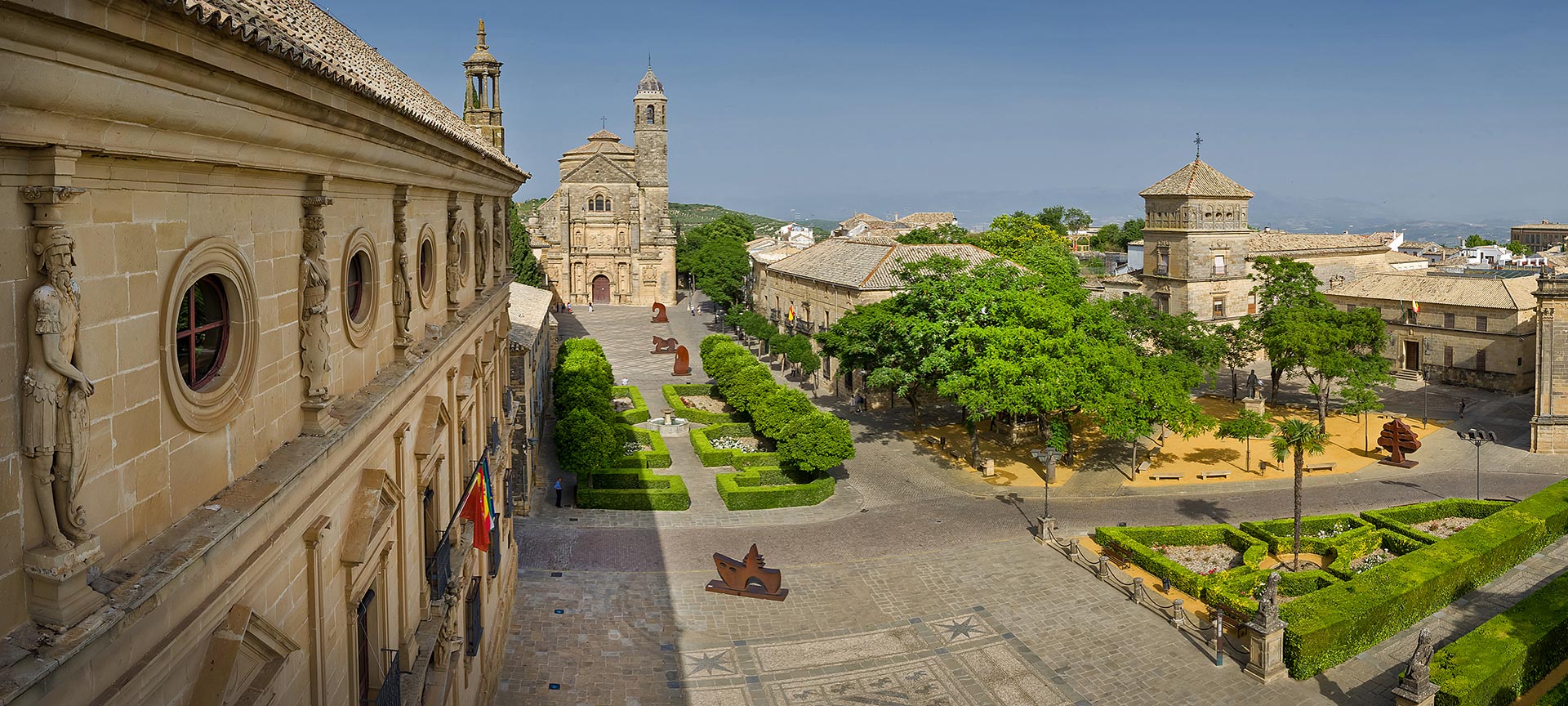
Beautiful Renaissance buildings are the main attraction in this…
Other ideas for your trip
What to do in Andalusia abased on the time of year you come
Want to plan a trip to Andalusia but not sure when is the best time to visit? It is very simple, at all times of the year you´ll enjoy sunny days, whether your…
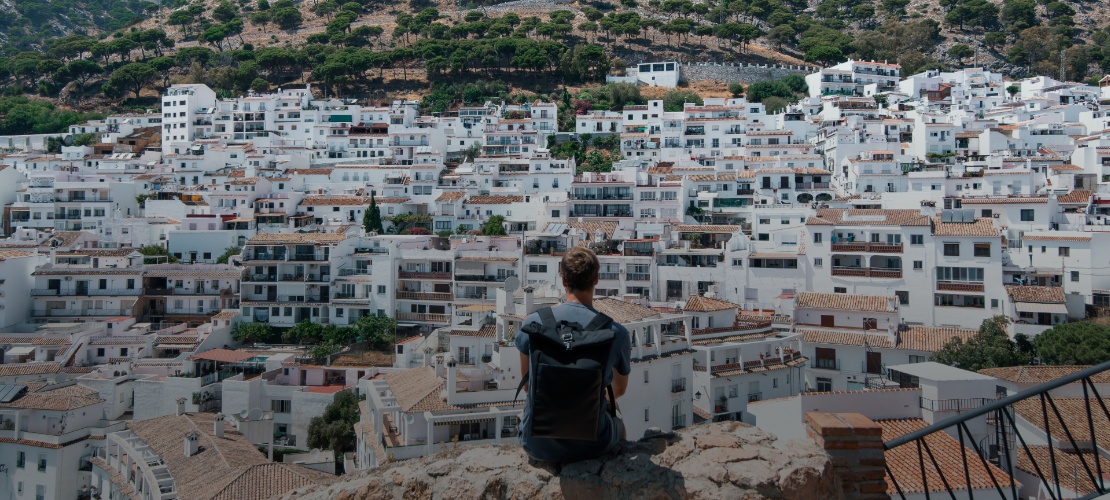
6 flamenco routes around Andalusia
Anyone interested in finding out more about flamenco singing and dancing should pay close attention, because we've come up with some information you're bound to…
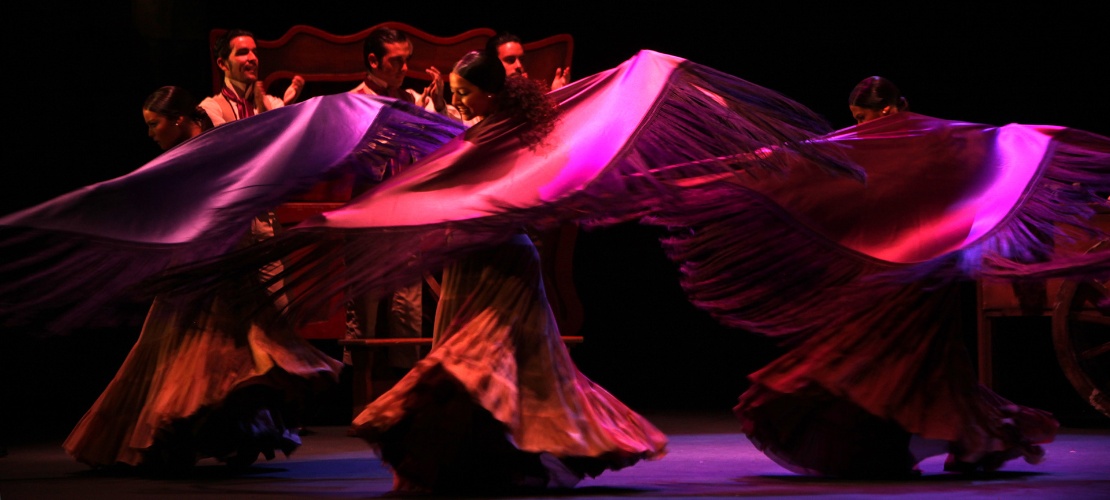
Andalusia, discover the charms of southern Spanish culture
In Andalusia, you’ll find a whole host of attractive cultural destinations such as Seville, Marbella, Granada, Cordoba, Cadiz, Úbeda and Baeza.…
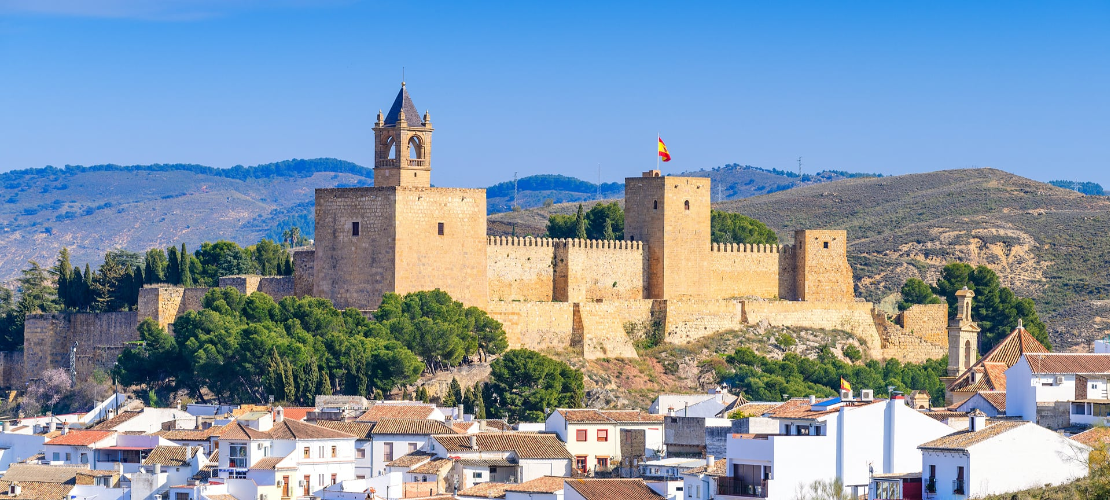
Explore the past and present of Andalusia with the Route of the Caliphate
Castles on hills and walled towns invite you to travel back to Al-Andalus. From Granada to Cordoba, there is a route that Muslims traveled in the Middle Ages…
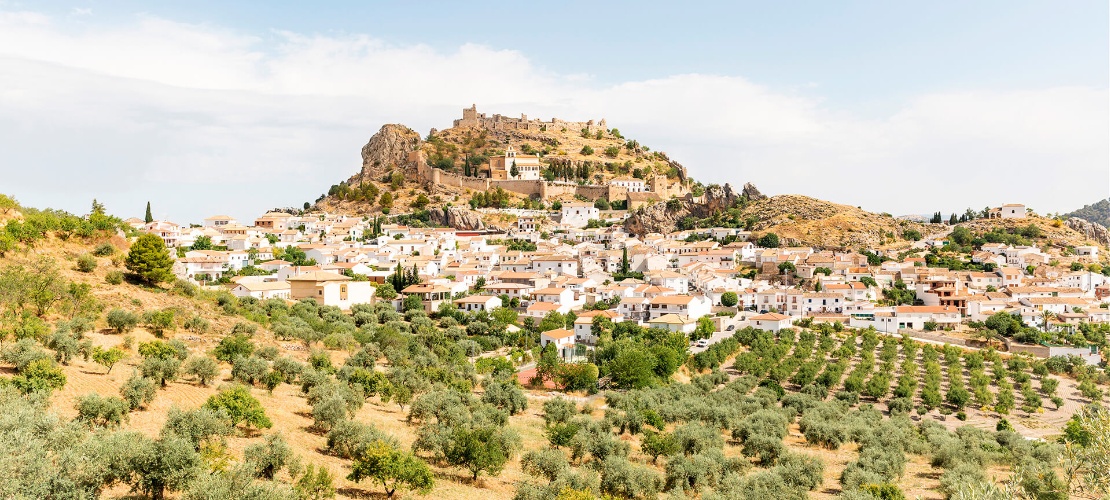
7-day tour of Andalusia
Are you planning a trip to southern Spain for your next holiday? Perhaps you’re wondering what would be the best route?…
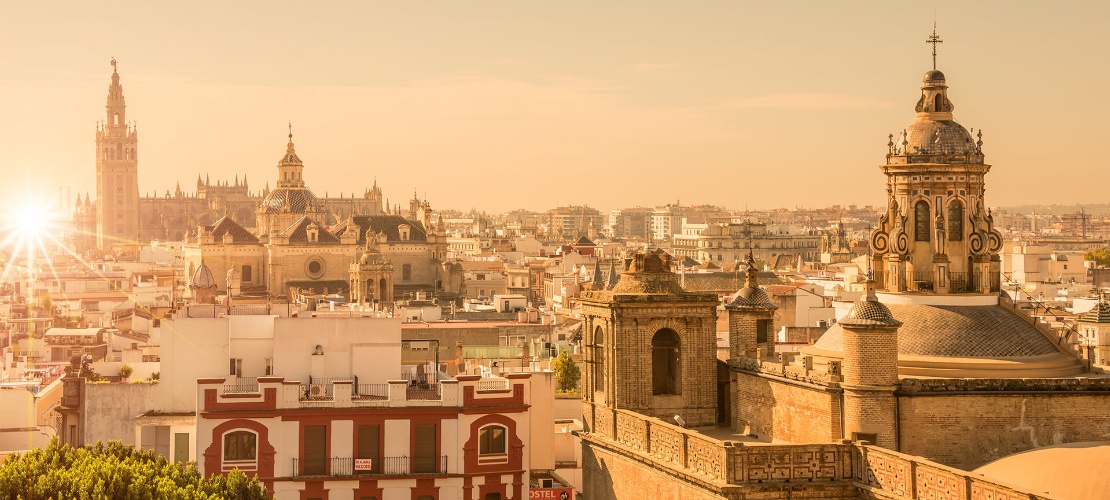
What to do in Andalusia: Visit some of the most beautiful botanical gardens
Scattered throughout Andalusia, you will find a large number of places dedicated to nature, and among them, the botanical gardens stand out.…
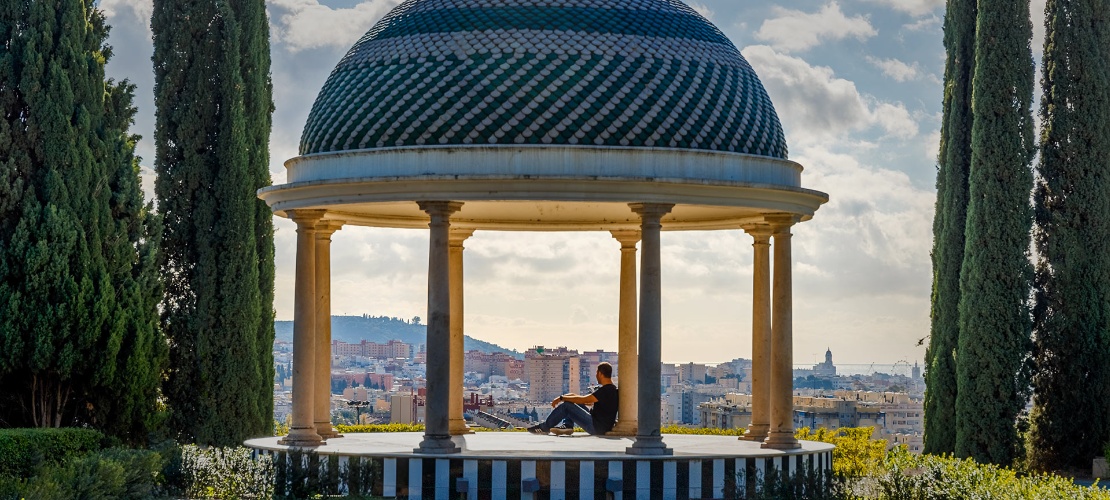
Towns and villages on the Andalusian Coast where you can disconnect
If you are looking for a few days rest by the sea, southern Spain has so much to offer you in Andalusia.…
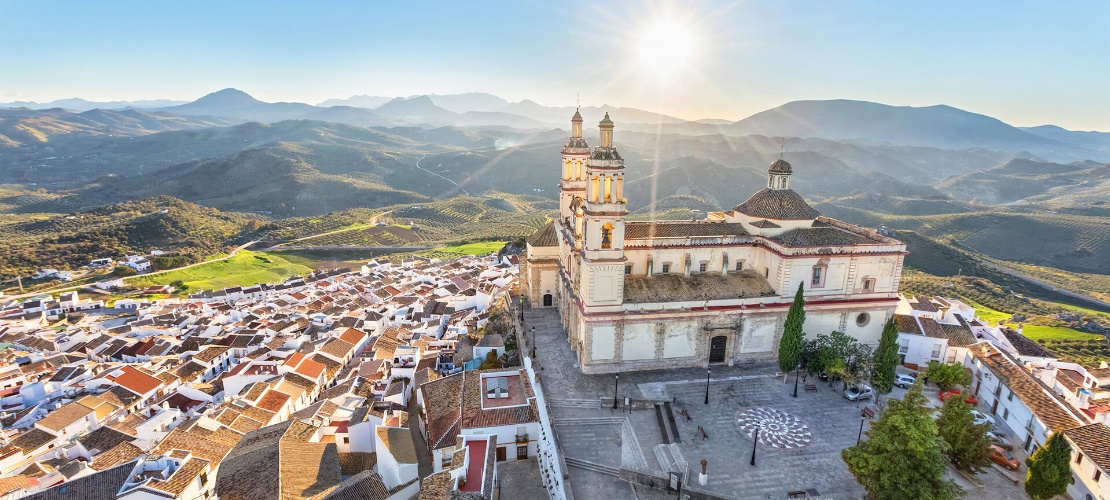
Motorbike routes through Andalusian landscapes
We propose 5 routes perfect for travelling through Andalusia on a motorcycle. These ideas are a different and rural type of tourism which reveal the beautiful…
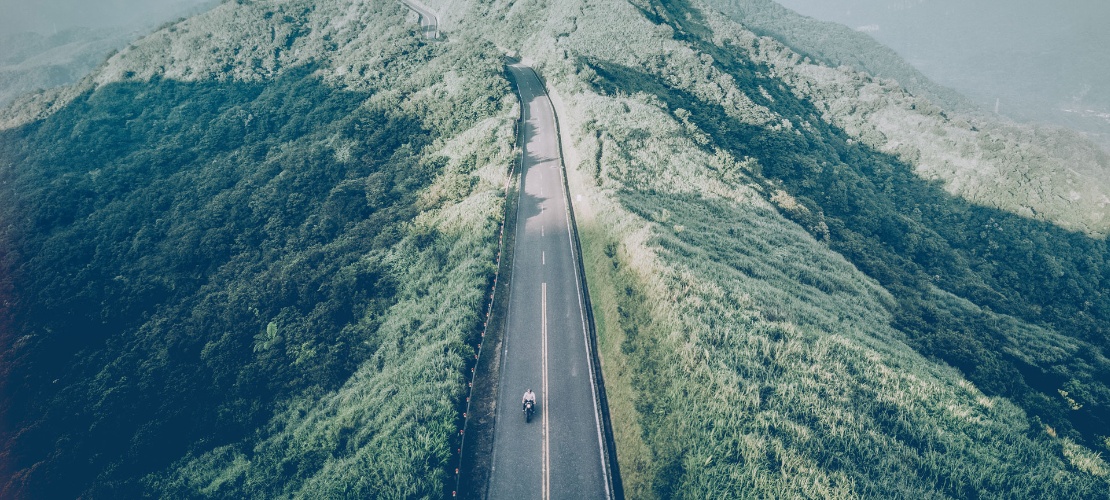
Surfing in the south of Spain, the best places
Did you know that the Mediterranean Sea and the Atlantic Ocean meet in the south of Spain?…

Unusual shopping opportunities in Andalusia
Andalusia has lots of attractions, including interesting shops and things to buy.…
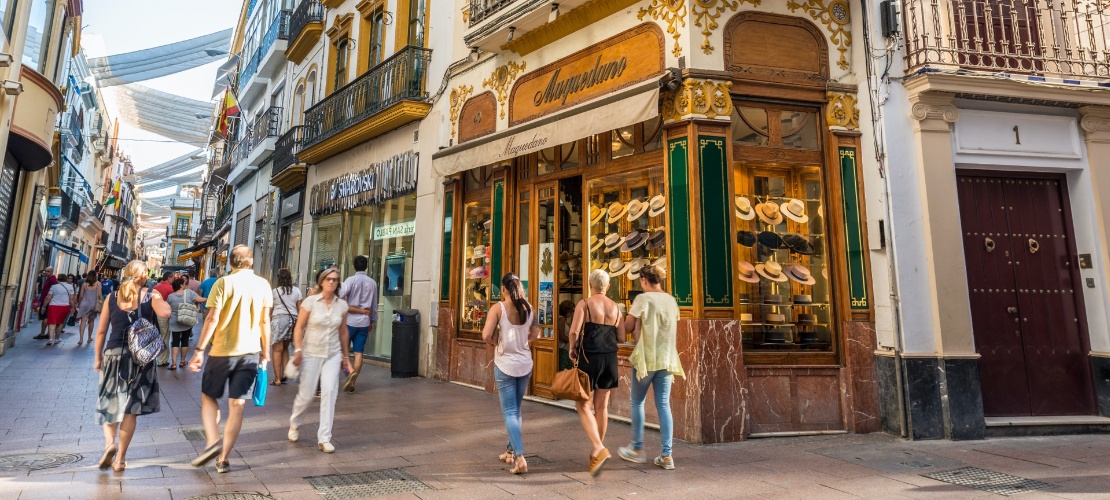
Anyone interested in finding out more about flamenco singing and…
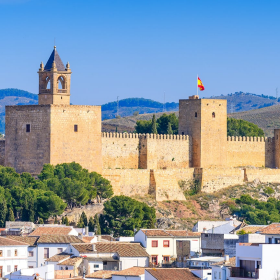
In Andalusia, you’ll find a whole host of attractive cultural…
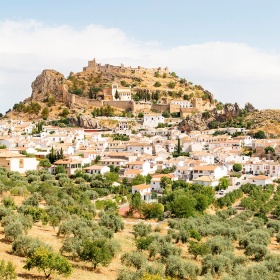
Castles on hills and walled towns invite you to travel back to…
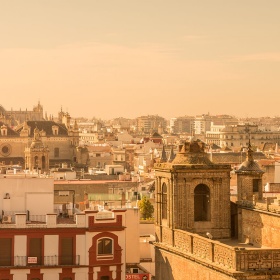
Are you planning a trip to southern Spain for your next holiday?…
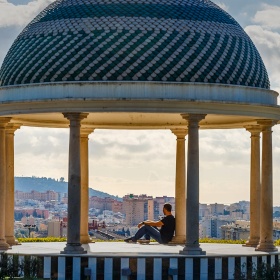
Scattered throughout Andalusia, you will find a large number of…
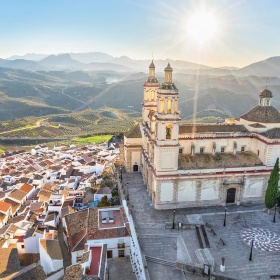
If you are looking for a few days rest by the sea, southern Spain…
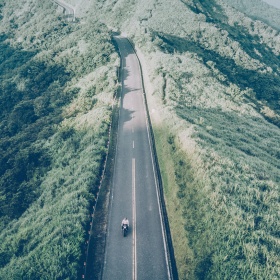
We propose 5 routes perfect for travelling through Andalusia on a…

Did you know that the Mediterranean Sea and the Atlantic Ocean…
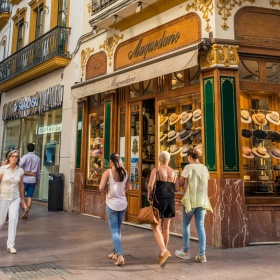
Andalusia has lots of attractions, including interesting shops…
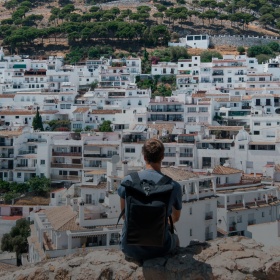
Want to plan a trip to Andalusia but not sure when is the best…

Choose between thousands of activities to live your best life on holiday.


10 Days in Andalusia Itinerary: the Best of Sunny Southern Spain
Planning a trip to southern Spain? This is the ultimate 10 day road trip itinerary for Andalusia.
This southern Spain itinerary takes you to the best and most beautiful cities and towns in Andalusia . You’ll discover the top must visit attractions, historic landmarks, and magnificent UNESCO sites.
I loved every stop on my last solo trip to sunny Andalusia. Full disclosure, it was February, so beach lounging was out of the question.
Nonetheless, I had an amazing trip, without the usual crowds. And I’m ready to hand over what I thought was a smashing 10 day itinerary for southern Spain.
This Andalusia itinerary is a well-balanced blend of must see hotspots, hidden gems, tiny whitewashed villages, and natural wonders.
When you think of Andalusia, fiestas, siestas, flamenco, bullfighting, and tapas come to mind. And, though they’re stereotypes, there’s some truth to them.
Tips For Driving in Andalusia
I flew into beautiful Seville and worked my way east, flying out of Granada . But you could just as easily reverse the direction and start in Granada. Starting in Seville meant that I didn’t need a car the first few days.
By far the best way to see Andalusia is by car. That way, you’re not limited by bus or train schedules and you can stop wherever you want. A car is the gift of freedom.
READ : Tips for Renting a Car and Driving in Europe
To be safe, you should have an International Driving Permit, just in case you’re pulled over. And rent the smallest car possible.
Medieval streets, parking garages, and on street parking can sometimes be a challenge. Or even a real headache.
The highways in Andalusia are extremely good. Just be sure to park on the outskirts of any small towns you’re visiting, so you’re not stuck in a labyrinthian maze of narrow medieval streets.
Google maps worked well for me. I’m directionally challenged and only got lost a tiny bit in Granada.
Overview of Andalusia Road Trip
I had three bases: Seville (4 nights), Ronda (2 nights), and Granada (4 nights). I really dislike moving every day.
From those bases, I blitzed around seeing adorable white pueblos, dazzling palaces, Game of Thrones sites, and the natural wonders of Andalusia.
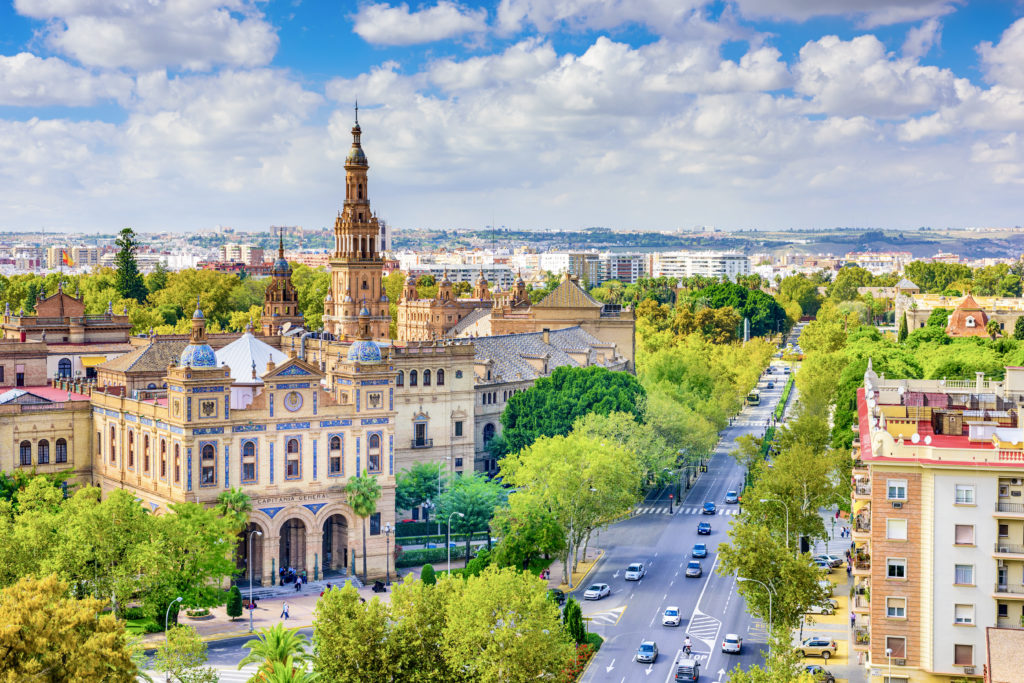
Here’s my recommended 10 day itinerary for a self drive road trip from Seville to Granada. You don’t need to pick up your rental car until day 5 when you head to Ronda.
- Day 1 : Seville
- Day 2 : Seville
- Day 3 : Seville
- Day 4 : Train to Cordoba
- Day 5 : Drive To Ronda with Stops at Osuna and Grazalema
- Day 6 : Ronda
- Day 7 : Drive To Granada, stopping in Antequera
- Day 8 : Granada
- Day 9 : Granada
- Day 10 : Day trip to Guadix
- More Time in Spain? Head north to Madrid
I skipped Malaga. It’s hard to do everything with only 10 days in Andalusia.
And it was far less appealing to me — big city, lots of expats, and a cruise ship stop. Though I would have liked to see the Picasso Museum there.
I stayed or stopped in 10 towns: Seville, Cordoba, Osuna, Grazalema, Ronda, Antequera, Granada, Nerja, Frigiliana, and Guadix. I spent the most time in sunny Sevilla, which was sunny even in February.
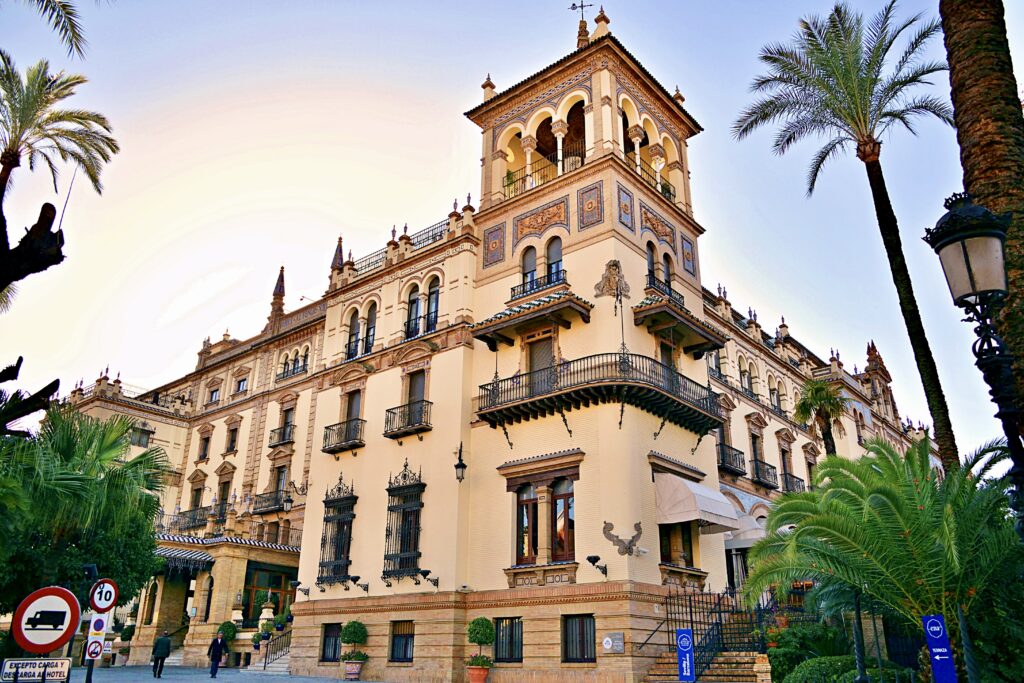
Where To Stay in Andalusia
You can either stay in Air BnBs or hotels in southern Spain. I’ve done both.
Here are hotel recommendations for the bases on this 10 day itinerary. I put a * by my #1 recommendation.
Seville : * Hotel Alfonso XIII , Hotel Colon Gran Melia , Suites Machado , Hotel Casa del Poeta , Hotel Casa 1800 Seville , EME Catedral Hotel
Ronda : Parador de Ronda , Catalonia Ronda , Hotel Molino del Arco , * Hotel Montelirio
Granada : Eurostars Catedral , Catalonia Granada , * Hospes Palacio de los Patos , Hotel Alhambra Palace
10 Days in Andalusia Itinerary
Let’s dive right in to how to spend 10 days in Andalusia.
Day 1: Seville’s Main Attractions
Use the beautiful city of Sevilla as you base for the first 4 nights.
Seville is amazing. It’s a seductive mix of Mudéjar palaces, ornate baroque churches, colorful tiles, and winding cobblestone lanes. There’s a romance to it. I fell in love immediately.
To be fair, I think there are ways that Seville can be a PITA. I list them here . But on the whole, it was glorious.
On day one, head to the city’s historic center to take in Seville Cathedral, the incredible Royal Alcazar, and the Plaza de España.
You can walk most places in Seville fairly easily. But the hop on hop off bus tour is also a good option.
1. Seville Cathedral
Seville Cathedral is a massive Gothic affair. It’s the third largest cathedral in the world and a UNESCO site to boot.
The sheer scale of the building is impressive. There are 15 doors on the cathedral’s four facades and each one features a unique relief or carving. The nave is the longest in the world.
The high altar is elaborately detailed and finished in gold leaf. Along the sides, there are 80 chapels to explore. The cathedral houses the tomb of Christopher Columbus.
Be sure to climb up the Giralda bell tower for spectacular views. The entrance is in a corner of the cathedral. Click here for skip the line tickets and a guided tour of the cathedral and bell tower.
2. Royal Alcazar
Next, head to the Royal Alcazar , one of the top attractions in Seville . It’s a breathtaking 10th century palace that King Pedro gave a 14th century Mudéjar facelift.
The Alcázar is really one of the world’s greatest cultural treasures — a centuries old complex of palaces and fortifications, lovely courtyards, and extensive gardens bursting with orange, purple, and green colors.
The Alcázar is a UNESCO World Heritage site, a residence of the Spanish Royal family. It’s even a filming location for the HBO series Game of Thrones . It has exquisite tile work and over the top intricate Islamic architecture.
Inside, the highlights are the Hall of the Ambassadors, the Courtyard of the Maidens, the Courtyard of the Dolls, and the Hall of Tapestries in the Gothic Palace.
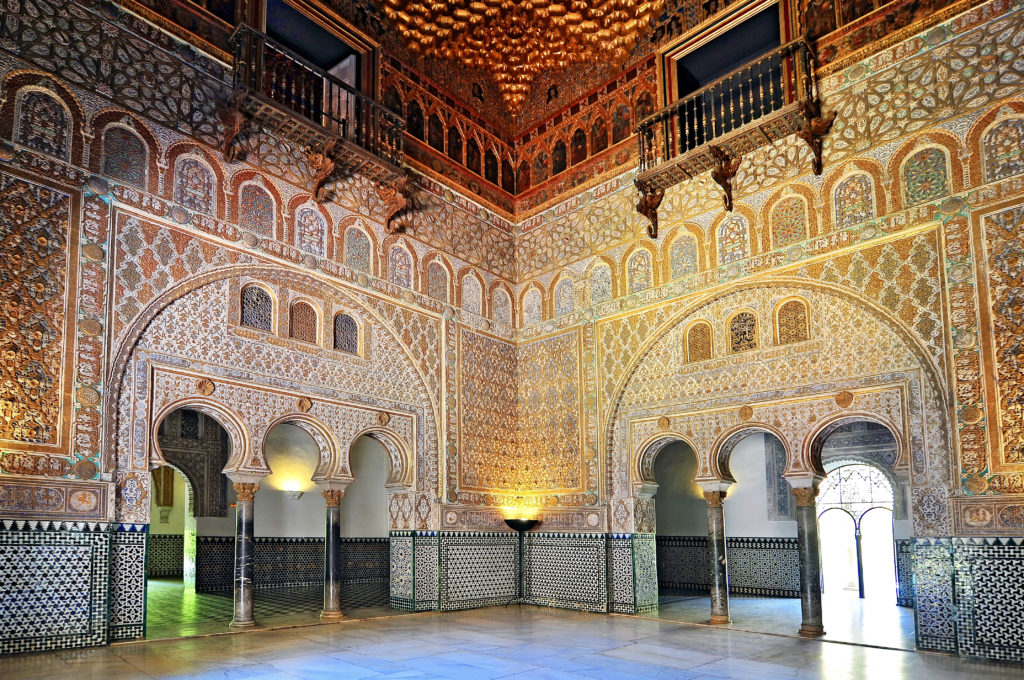
The Ambassador’s Hall, or Throne Room, is the big showstopper in the palace. It’s mind blowing.
The room is nicknamed the “Half Orange” Room. It sports a fantastical gilded cedar domed ceiling. Encrusted with gold and mirrors, the dome represents the heavens.
Outside, there’s a series of verdant lush gardens. Don’t miss the Baths of Maria De Padilla, King Pedro’s mistress. The baths are one of the Alcazar’s Game of Thrones filming locations , a place where the Sand Snakes plot.
I advise purchasing tickets online well in advance. Even in February, I had a half hour wait in line. If you’d also like a guided tour, which you may for this fantastic place, click here for a 1.5 hour guided tour.
The Alcazar was my very favorite place in all of Andalusia. Here’s my complete guide to the magnificent Royal Alcazar .
3. Plaza de España
Later, spend the early evening checking out the Plaza de España .
The plaza is one of the famous architectural landmarks in Seville. It stands out in a city already overflowing with beautiful architecture.
It was built for the Ibero-American World Fair of 1929, where Spanish speaking countries enjoyed a year long mutual admiration festival.
The park’s highlight is the Spanish Pavilion, the sweeping half circle structure with rose gold brick buildings.
Day 2: More of Seville’s Top Attractions
Cross the Puente de Isabel II bridge over the Guadalquivir River, and you’ll land in the colorful Triana neighborhood.
It’s a small soulful village and the old gypsy quarter of Seville.
Triana was once considered the “wrong side” of the river. Now, its the fun and funky part of Seville.
And it is THE place to buy ceramics. And, I was told, the best place to se flamenco.
2. Metropol Parasol
Next, visit Metropol Parasol.
The ultramodern Metropol Parasol was built between 2005-11 by German architect Jürgen Mayer to revitalize the run down Encarnacion Square.
It’s called “the Mushrooms” due to its quirky waffle-like shape, inspired by the vaults of the Seville Cathedral.
Click here to book a skip the line ticket and guided tour.
3. Barrio Santa Cruz
Spend the late afternoon amidst the orange trees and tapas bars in Barrio Santa Cruz. Barrio Santa Cruz was once Seville’s old Jewish quarter.
It’s a popular district within the city — a mass of tangled cobbled streets with tiny palazzos and tile covered patios. There’s a mouth watering array of tapas bars and restaurants.
Some streets are so impossibly narrow, they’re called “kissing lanes.” I especially liked Plaza Dona Elvira.
4. Tapas Tour
In the evening, I recommend going on a Devour Seville “Tapas, Taverns & History” tour that evening. The tour was fun and has 5 star reviews.
You’ll get nummy tapas and nuggets of history.
The Sevillanos adore very sweet drinks, including something called “orange wine.”
Day 3: Round Up of Seville Attractions
1. museum of fine arts.
On your last day in Seville, your first port of call is the Museo de Bellas Artes , or Museum of Fine Arts. It opens at 9:00 am.
It’s one of Spain’s best art museums . The museum is quite lovely and crowd free to boot.
The museum is known, after the Madrid’s Prado Museum , as the “second art gallery in Spain.” It’s housed in a lovely salmon colored former convent.
The museum has art from the middle ages to the 20th century. But it’s mostly known for its collection of 17th century art from Spain’s Golden Age.
The museum has work by Spain’s top painters, including Zurbarán, Murillo, El Greco, and Diego Velazquez. You’ll see a lot of monks, balding saints, cherubs, and depictions of Christ.
The museum also has a goodly collection by the Baroque star Murillo. (You can also Murillo’s works at Seville Cathedral.)
Murillo achieved fame and recognition from his religious portraits. But he also left behind some fascinating work of everyday people and street life.
2. Casas de Pilatos
Then, pay a visit to Casa de Pilatos . The casa is a glorious, sumptuous 16th century mansion in Seville’s historic district.
It’s about a 15 minute walk from the Cathedral. The palace was declared a national monument in 1931.
Casa de Pilatos is a beautiful Neo-Mudejar mansion. The palace is overflowing with mosaics, beautiful tile, and sculptures.
A highlight is the courtyard. it’s surrounded by a gallery formed by white marble columns with Mudejar arches.
Inside, there are 24 busts of Spanish kings, Roman emperors, and other characters gracing niches in the walls, which were collected from the ruins of Italica. Click here for tickets.
3. Basilica of the Macarena
In evening, wander north to see the Basilica de la Macarena and the “weeping virgin” in the north end of Seville. The Macarena is a bit off center.
It’s on the north end of Seville’s city center. But it’s definitely worth a detour.
The basilica is also known as the Church of the Virgin of Hope of Lady Macarena. It’s a showy bright yellow Neo-Baroque Church. It houses Seville’s favorite “weeping virgin,” La Macarena .
After visiting the church, stroll along the river to the Torre del Oro. It’s a pretty tower, but you don’t need to go inside.
Day 4: Day Trip to Cordoba
On day 4 of my 10 days in Andalusia, take the train to Cordoba for the day. You can also book a day trip tour from Seville, to make things easier.
I loved Cordoba. It’s a natural film set, it’s just so beautiful. Here’s my one day itinerary for Cordoba for reference.
Cordoba has an authentic Spanish vibe with fewer tourists than Seville. The town definitely deserves more than one day. Still, I saw quite a bit in the 9 hours I was there.
Start with Cordoba’s #1 site, the Mezquita , the Mosque-Cathedral of Cordoba. Dating from the 10th century, it’s a UNESCO site and one of the world’s most well- preserved Islamic buildings.
In the 16th century, King Ferdinand and Queen Isabella converted it into a cathedral, calling it the Cathedral of Our Lady of Assumption.
I expected the combination to be discordant and perplexing. But I found the place fascinating, a snapshot of the sophisticated dual culture that once existed.
You walk in from a courtyard of orange trees through the Porta de las Palmas. You’re immediately in a forest of candy cane horseshoe arches. A highlight is the Mihrab, or high altar in a mosque.
The Renaissance cathedral is built right in the center, sharing marble and space with the Islamic arches. The vaulted ceilings are stunning. Be sure to go up the bell tower for spectacular views of the city.
Click here to book a ticket and guided tour of the Mezquita.
But there’s much more to Cordoba than the Mezquita. Just downhill from the Mezquita is the Guadalquivir River. Cross the stunning Roman Bridge, which is both a UNESCO site and Game of Thrones filming location.
Stroll around the narrow streets of the charming old Jewish Quarter. Skip the Instagram popular Calleja de las Flores, or just stroll by.
It’s overrated and crammed with tourists. There are beautiful flowers and patios everywhere in Cordoba.
Go into the Jewish synagogue, say hello to the statue of Maimonides. Visit the beautiful Alcazar de los Reyes Cristianos. This Alcazar can’t hold a candle to Seville’s Royal Alcazar, but I thought it was still worth a visit.
I had a late lunch in the courtyard of an adorable cafe in the Jewish Quarter, El Rincon de Carmen, which I would definitely recommend.
If you don’t want to walk around Cordoba, you can also take the hop on hop off bus tour .
Day 5: Drive To Ronda with Stops at Osuna and Grazalema
On day 5, pick up your rental car on the way out of Seville and head to the tourist-fly popular town Ronda for “bridge porn.”
On the way, I stop in the charming white pueblo towns of Osuna and Grazalema.
Osuna surprised me. I visited the town for its dashing bullring, which is one of Andalusia’s Game of Thrones filming locations .
But Osuna itself was beyond adorable. It’s a charming white pueblo village with a rich architectural and cultural heritage.
There’s row upon row of white stucco homes and streets dotted with orange trees. Osuna’s a vertitable art gallery, with all its Renaissance and Baroque churches.
UNESCO lists Osuna’s main drag, the Call San Pedro, as the second most beautiful street in Europe . Osuna was declared a Historic-Artistic site in 1967.
2. Grazelema
Next up is Grazalema. It’s a pretty mountain village of Roma origin. It’s completely different than Osuna, more wild.
It lays in the valley of Sierra de Grazalema, splashed with whitewashed homes and surrounded by olive trees.
I was there in February, so there was even a sprinkling of snow. I paused in the main square, the Plaza de España, which is lined with bars and restaurants, for a late lunch.
3. Zahara de la Sierra
Depending on time, you can also visit Zahara de la Sierra, right next door to Grazalema.
Like Grazalema, it’s streets are white, immaculate, and fairly deserted. You can climb to the Tower of Tribute for views.
Day 6: Ronda: Hemingway’s “Romantic Background”
Only 40 minutes from Grazalema, Ronda is vastly more popular. It’s the third most visited town in Andalusia.
And there’s a a reason — it’s dramatic. Ronda is Andalusia’s great cliff hanger. It’s perched on a mountainous gash carved by the Río Guadalevín.
Ronda is synonymous with its dramatic 18th century bridge, the Puente Nuevo.
The bridge connects the two parts of the town over the 328 feet El Tajo gorge. You can hike to the bottom of the gorge for great views.
Aside from the bridge, Ronda is pretty adorable. There are plenty of cozy town squares, cobblestone alleys, terraces everywhere, and lovely architecture.
You can visit the Mondragón Palace, the Arabic Baths, and the Bullring (Spain’s oldest one) if you’re feeling ambitious.
I made this a lazy, laid back day, after a fairly hectic schedule. I like to have a more relaxed day halfway through a road trip. Ronda fit the bill perfectly.
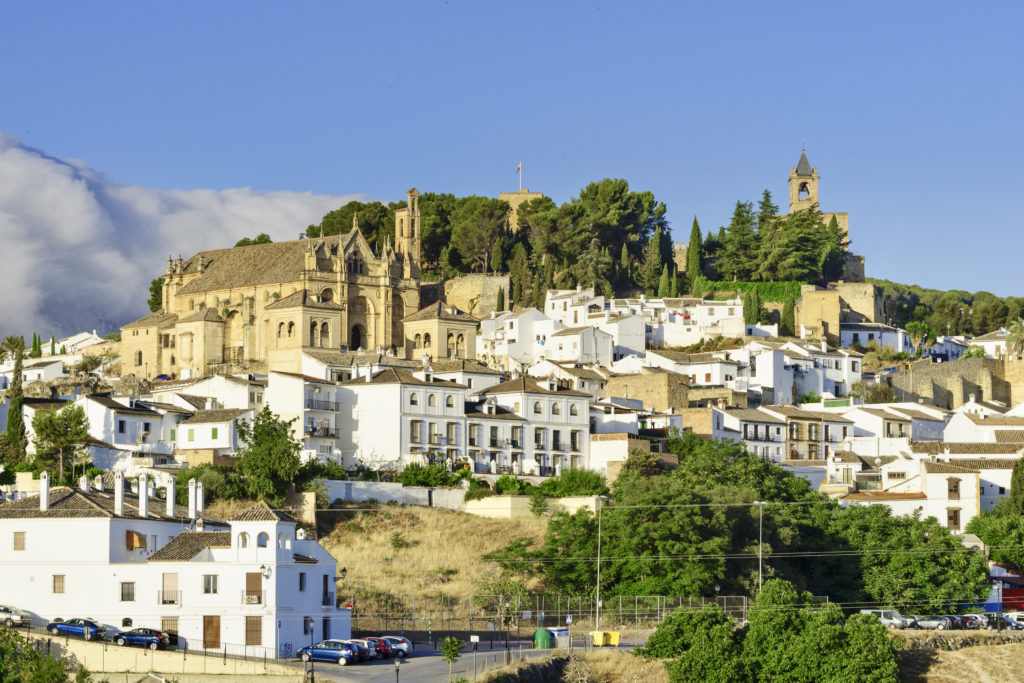
Day 7: Drive from Ronda to Granada, Stopping in Antequera
On day 7, make your way to Granada . En route, take a break and stop in the white pueblo town of Antequera . Like Osuna, Antequera surprised me.
I came to inspect the UNESCO dolmens. They are a fairly new site just listed in 2016.
But I absolutely fell in love with the town itself. Antequera is known as the “Florence of Andalusia.” And, unlike Ronda, I had the place mostly to myself. Antequera is really a must visit destination in Andalucia.
Antequera boasts ancient UNESCO megaliths , an impressive Moorish fortress, a lovely Renaissance church, and a stunning medieval and baroque historical core. You’ll have an eyeful of swoonful scenery.
Antequera’s ancient megaliths were declared a UNESCO World Heritage Site in 2016. The megaliths, or dolmens, are definitely an under appreciated UNESCO site, perhaps because it’s so new.
The Bronze Age dolmens are among the oldest things on the planet. They’re essentially Spain’s Stonehenge. The dolmens were discovered between 1903-05 by the brothers Antonio and José Viera of Antequera.
If you’re a ruin luster, you should definitely see them. They are just outside the town. Signs will direct you there.
You can book a guided walking tour of Antequera or a tour of the dolmens .
Day 8: Granada: The Alhambra and Barrio Sacramonte
On day 8 of your 10 day southern Spain itienrary, you land in the beautiful city of Granada.
1. Alhambra
Start your day in Granada at one of the most famous landmarks in Spain , the mighty Alhambra. The Alhambra is the world’s last and greatest Moorish fortress.
To visit, you need to pre-purchase tickets well in advance. You may want to pre-book a ticket and guided tour to enrich your visit.
The Alhambra sits on a stunning piece of real estate. It’s in a high, mountainous location on Sabika Hill. it boasts sweeping views over Granada and the surrounding countryside.
In the Moorish tradition, the Alhambra is decorated with water: “standing still, cascading, masking secret conversations, and drip-dropping playfully.”
Alhambra became a UNESCO site in 1984. It’s a deeply affecting place. It’s so beautiful and enchanting, it’s difficult to process. Or to unglue your camera from your face.
The most beautiful spot is the Nasrid Palace. When you buy your Alhambra ticket, you’ll be given a specific time to visit this particular palace.
Make sure you get in line at the right time. Or they won’t let you in.
There are no words to describe the breathtaking Moorish architecture of the Nasrid Palaces.
At every turn there is exquisite craftsmanship and/or a stunning view. The Court of the Lions and the Court of the Myrtles are highlight.
For more information, here’s my comprehensive guide to visiting the Alhambra .
2. Granada’s Historic Old Town
Once you’ve drooled over the Nasrid Palace and relived history in the Alcazaba, it’s time to explore Granada itself.
I didn’t know I would love Granada before I arrived — a common theme of my Andalusia trip apparently. But Granada unexpectedly swept me away with its authentic Spanish vibe and dazzling attractions.
Lorded over by the Sierra Nevada Mountains, it’s an absolutely beautiful ancient city. There is scad of historic architecture, including a massive Gothic cathedral.
Granada also boasts many atmospheric neighborhoods, each with an earthy distinct character.
3. Granada Cathedral & Royal Chapel
Granada Cathedral is a massive affair. It’s the second largest cathedral in Spain after Seville Cathedral and the fourth largest cathedral in the world.
It was built by Queen Isabella after the conquest of Granada. Construction began in 1518. It took over 180 years to complete.
The cathedral’s a mix of Renaissance and Baroque architectural styles. The chief architect was Alonso Cano, who took over in 1652. Inside, there’s a towering interior, a grand altar, and side chapels.
You’ll also want to visit the Royal Chapel. It’s connected to the cathedral, but has a separate entrance and admission fee. You can book a combined skip the line ticket and tour for both sites.
This is where you’ll find the ornate marble tombs of King Ferdinand and Queen Isabella. The Sacristy Museum also holds treasures, relics, and paintings.
4. Granada’s Sacromonte Neighborhood
That night, I recommend taking a walking tour at sunset to the otherworldly Sacromonte neighborhood.
Sacromonte feels disconnected from the city. Yet, it sports one of the most mesmerizing views of the Alhambra.
For centuries, Sacromonte was the home of gypsies, bohemians, artists, and foreign refuges. And they still live in the rustic caves.
Day 9: Nerja and Frigiliana
Craving some ocean air? Drive south toward the Costa del Sol to visit Nerja and Frigiliana. You can visit both towns on a guided day trip from Granada .
Nerja is a lovely town on the Costa del Sol, the beauty playground of southern Spain. The heart of Nerja is its beautiful Balcony of Europe.
The balcony is a palm-lined promontory. It was built not he foundation of an old fort.
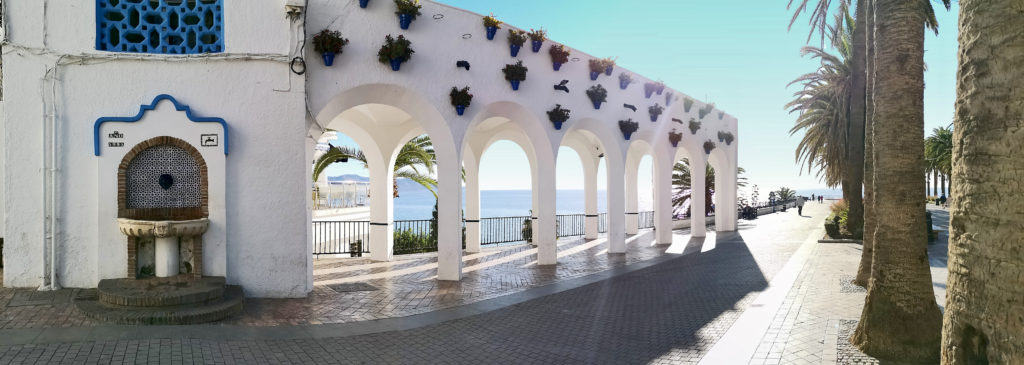
The balcony juts out like a natural pier and offers panoramic views of the cobalt blue sea and honey colored coast.
There are plenty of other amazing things to do in Nerja , including hitting Burriana Beach.
2. Nerja Caves
After visiting the town, head to Nerja Caves for a real adventure. The caves are situated on the slopes of the Sierra Almijara, just outside of Nerja.
The caves are about five kilometers long. They were once inhabited by the Stone Age hunters. The caves weren’t discovered until 1959.
On a tour, you’ll see rock formations, stalagmites, stalactites and subtle shifting colors. A guided visit lasts around 45 minutes.
3. Frigiliana
Just 15 minutes from Nerja by car is Frigiliana . Of all the beautiful towns in Andalusia, it might be the most beautiful of all.
In Frigiliana, everything is beautiful in a way that it almost never is. Frigiliana is a spotless, secluded, perfectly coifed cliff town dressed in blue and white with flowing orange and purple vines and potted blood red geraniums. Just dreamy.
And after visiting numerous moorish fortresses, cathedrals and other “must see” Andalusian sights, I was incredibly relieved that there was no major sites in Frigiliana. I wandered the pretty cobbled streets guilt free, enjoying the views.
I was ready to just sink in the Moorish beauty and Spanish countryside. Oh, and meander into ceramic shops, purchasing some lovely items to bring home.
Day 10: Day Trip to Guadix & Granada’s Albaicín Neighborhood
The next day I took a short half day trip to the unique cathedral town of Guadix.
The town is very off the beaten path destination in Andalucia. It’s only 45 minutes from Granada, so it’s an easy day trip,
I went mostly to see the house caves or “cuevas.” Guadix’s inhabitants live in caves, with whitewashed chimneys set against the mountains.
Guadix also has a charming old town and a 16th century cathedral worth visiting. It’s also famous for its earthenware pottery.
Back in Granada later, spend the late afternoon and evening wandering in the old Arab neighborhood of the Albaicín, or Albayzín.
Built on a steep hill, its an ancient area with tight tangled winding streets and a bohemian feel. It’s probably my favorite area in Granada.
The Albaicín was declared a UNESCO site in 1984. Amidst a jasmine scented breeze, you’ll find restaurants, cafes, tapas bars, and even street performers.
You can book a guided walking tour of the neighborhood or take a DIY stroll.
More Time in Spain?
If you have more than 10 days in Spain, head north to see a completely different side of Spain. To the north are Spain’s other great cities, Madrid and Barcelona . You’ll also find secret medieval towns, the Costa Brava, and Green Spain .
If you need some destination inspiration, here’s my guide to six one week itineraries in Spain .
I hope you’ve enjoyed my 10 days in Andalusia itinerary. Here are some of my Spain travel guides and resources:
- 10 Day Itinerary for Basque Spain
- Landmarks in Spain
- Hidden Gems in Spain
- 10 Day Itinerary From Barcelona to Bilbao
- 3 Day Itinerary for Barcelona
- 40+ Landmarks in Barcelona
- 2 Day Itinerary for Bilbao
- Most Beautiful Places in Andalusia
- Six 1 Week Itineraries for Spain
- 10 Day Road Trip From Madrid To Seville
- 2 Day Itinerary for Madrid
- Best Museums in Spain
If you’d like to road trip in southern Spain, pin it for later.
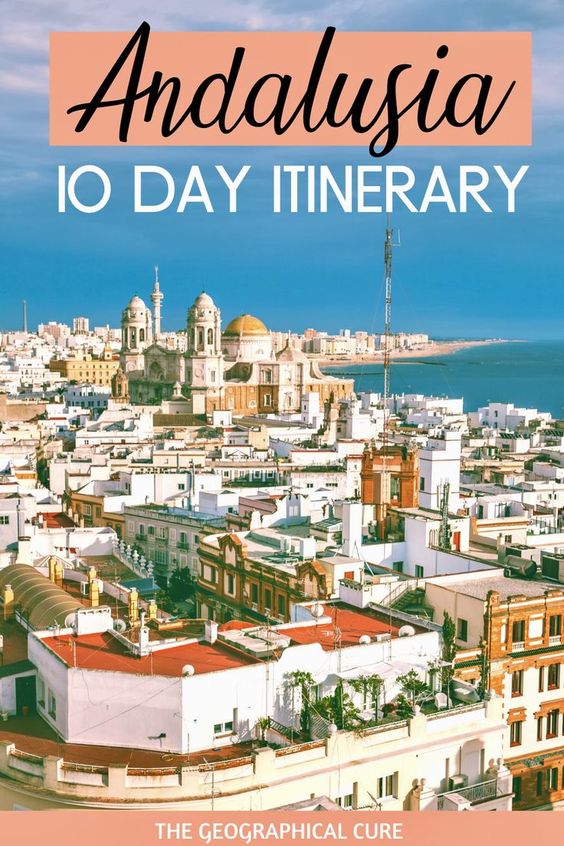
4 thoughts on “10 Days in Andalusia Itinerary: the Best of Sunny Southern Spain”
Where did you stay?
Air Bnbs in Seville and Granada.
Hi, thanks for all your info. This has been very helpful for our trip.
For Seville it should be mentioned though that you need!!!! to book your tickets to the Alcazar days in advance to avoid disappointment. We got here thinking that a day would be enough only to be proven wrong. We even tried on the day to go there to buy tickets for the day and even though we arrived shortly before it opened, we were already too late. And this wasn’t even peak season. Second disappointment. It’s crazy that you have to book everything in advance it seems and can’t be spontaneous anymore 🙁
Yes, that is for sure! I find that, these days, you have to book skip the line tickets for star attractions well in advance. Tbere is no spontaneity anymore, even in non-peak season. I was just shut out of the opera tour in Vienna in mid-October even though I should know better.
Leave a Comment Cancel reply
Save my name, email, and website in this browser for the next time I comment.
Last Updated on February 27, 2023 by Leslie Livingston

How to Spend Two Incredible Weeks in Andalusia, Spain
Andalusia is unlike anywhere else in Spain, and it’s one of my favorite regions. The second-largest autonomous province in Spain boasts sandy beaches, snowy mountain peaks, Europe’s only true desert, as well as enormous, vibrant cities, and quaint whitewashed towns perched atop cliffs.
As amazingly diverse as its geography is, this is only secondary to the fascinating history and culture of the region, which owes as much to the Islamic caliphates that occupied the area for centuries as it does to the Spanish kingdoms that later flourished. This melting pot of influences is most notable in the stunning architecture of the numerous cathedrals and alcazars (fortresses), which blends Moorish aesthetics with the Gothic and Baroque ideals of Western Europe.
It’s not just the buildings that have their own flavor: the food, too, has its own unique specialties, many involving fresh fish from the extensive coastline or cooling dishes designed to take the edge off the heat.
Personally, I’d recommend kicking off your Andalusia adventure in either Seville or Malaga, as these cities have the two best-served airports in the region. As the route we’re going to outline is essentially circular, it doesn’t particularly matter where you choose to begin, but we’re going to start in…
Day One: Seville
Seville is Andalusia’s largest city and sometimes described as the hottest place in continental Europe. Even in October, we were sweating after just an hour of scuttling about streets filled with food markets, tapas bars, and pretty palacios.
Fortunately, many of the older landmarks were designed to ameliorate the heat, including the Royal Alcazar. This extensive complex was built on the site of a former Muslim fortress by Pedro I, a great admirer of Islamic design, who decided to construct a luxurious residence for himself using the principles of Moorish architecture. We were particularly overawed by the Salon de Embajadores (Hall of the Ambassadors), a room of intricately carved walls crowned by a golden, domed ceiling that dazzles today just as much as it must have impressed foreign dignitaries hundreds of years ago.
The palace also boasts extensive gardens as well as a café where you can dine on simple snack fare amidst ostentatious peacocks, which freely wander the grounds. Make sure you book your ticket in advance, as queues during high season can last hours – and believe us, you don’t want to be standing for that long under the blazing sun!
Just next door to the Royal Alcazar is Seville’s principal religious edifice, the Cathedral of Saint Mary of the See. A solid beast of a building that seems to sprawl outwards in a slightly higgledy-piggledy way, what you see today is the result of successive additions, from original mosque elements like La Giralda (once a minaret now a bell tower) to the Gothic vaulted ceilings and detailed carvings framing each of the many entrances.
While it makes sense to take in both the palace and the cathedral at the same time due to their proximity, we ended up exhausted just because there’s so much to absorb and explore. Fortunately, the nearby streets of the Barrio de Santa Cruz are the perfect retreat for some tapas and a glass or two of tinto de verano. This mixture of red wine and lemon soda is like sangria but more commonly drunk by the locals – its origins lie in the neighboring city of Cordoba (more on that later).
Where to stay in Seville: We opted to go for the newly opened Querencia de Sevilla , right in the heart of the city. Everything was tastefully decorated with modern fixtures, and the view from the roof is truly spectacular.
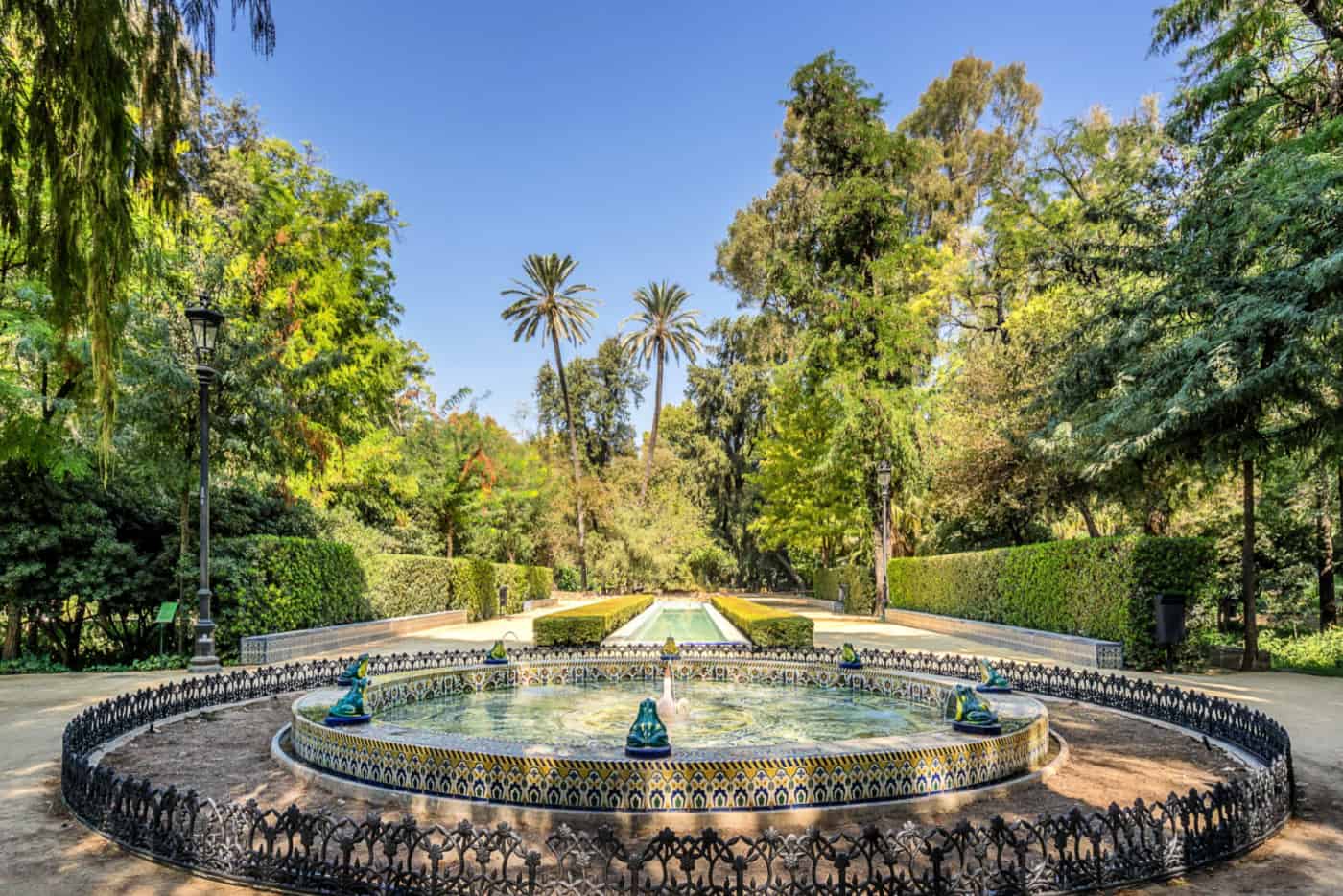
Day Two: Seville
If you’re like us, you’ll want to take your second day in Seville a little slower. That means leisurely strolls through Maria Luisa Park, more than 30 hectares of greenery that includes the hemispherical Plaza de Espana. Built in 1929, this grandiose building is adorned with brightly colored azulejo tiles, complemented by pavilions depicting different provinces of Spain. Both the plaza and park often host festivals, concerts or food fairs, so make sure you check the calendar.
From here, you can head north along the Guadalquivir River, passing the Palacio de San Telmo on your right, then the 13th-century Torre de Oro on your left. You can’t go into the former because it’s now a government building, while the interior of the latter isn’t worth the fee, but both have exquisite exteriors. After about 20 to 30 minutes, you’ll reach the Plaza de Toros, Seville’s principal bullfighting ring – a pretty impressive arena, even if you find the brutality of the sport a little hard to stomach.
Head north and east to reach the Setas de Sevilla (Mushrooms of Seville), more formally known as Metropol Parasol. It’s a striking backdrop from a distance, but we couldn’t help but notice that up close it all looks a little dilapidated. Still, it’s worth paying to go up top and see the views from the aerial footbridges. Underneath is a produce market where you can sample some local goodies – though we found it a little overpriced and sterile compared to the markets in Feria and Triana, where we were shoulder to shoulder with locals buying their jamon and queso.
Round out the day with a trip to an evening of flamenco, which is found in abundance in the Andalusian capital. There are a lot of options in Seville, so it might be worth saving some time and booking a show through a reputable tour company so you know what you’re getting beforehand.
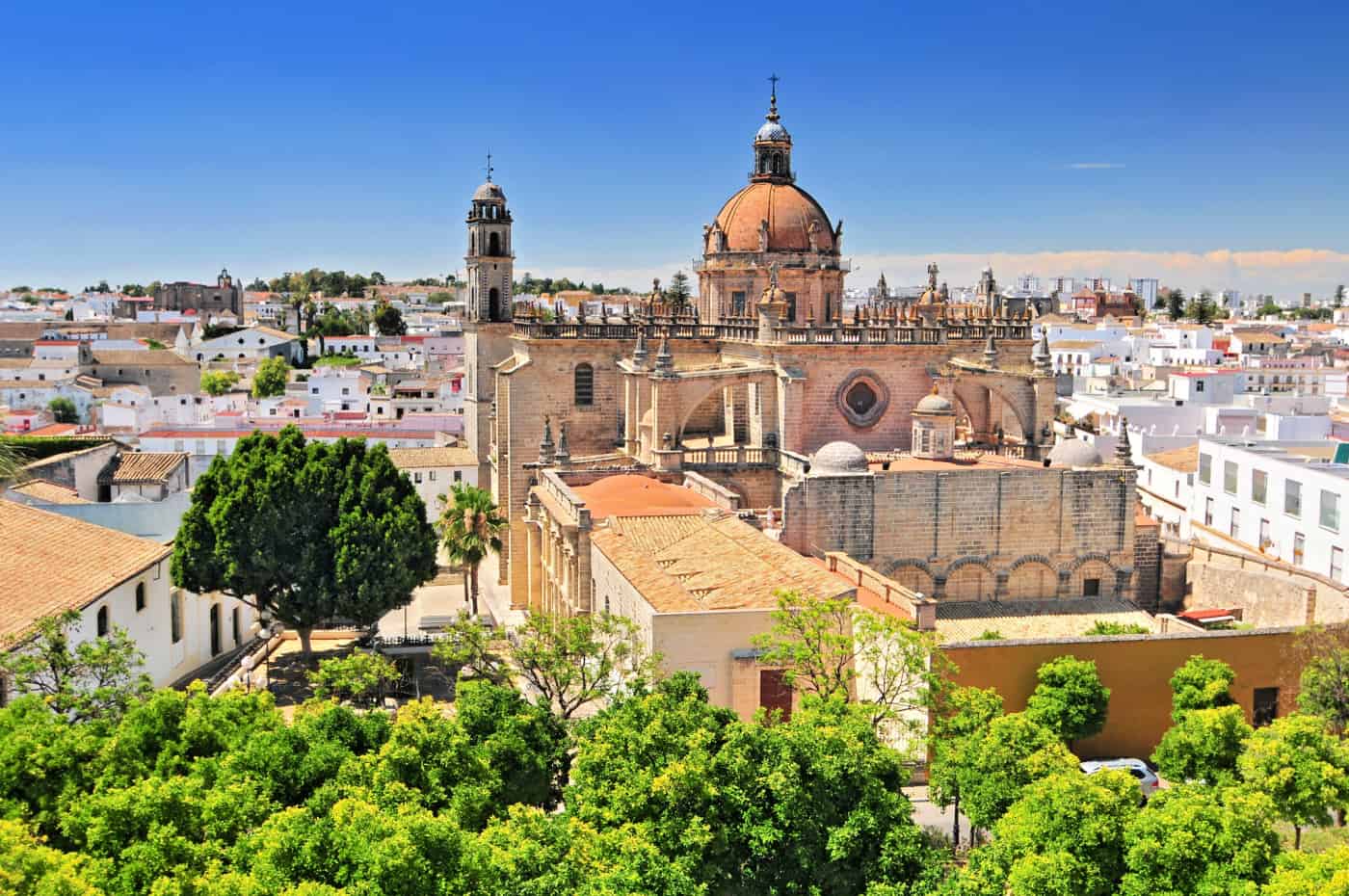
Day Three: Jerez
Just one hour away from Seville by car or train, Jerez de la Frontera is most famous for its namesake alcohol: sherry. The city is filled with atmospheric tabancos where you can try the fortified beverage. Our favorite was probably Tabanco el Pasaje, mainly because it also stages flamenco shows (there’s something of a rivalry between Seville and Jerez as to which city is the true home of the traditional Spanish dance form).
If you’re a sherry newbie, a great place to start is Bodegas Fundador, the city’s oldest sherry maker still in existence, which offers tours and tastings. Alternatively, the Bodegas Tradicion combines sherry tastings with a collection of beautiful artworks by Spanish masters like Velasquez and Goya.
The second thing Jerez is renowned for is its horse-riding school, more formally known as the Royal Andalusian School of Equestrian Art. Living up to its grand name, the complex has enough attractions to occupy most of a day, from the grand rooms of the Palacio del Recreo de las Cadenas, through a museum that details the history of horse breeding and riding (with a particular focus on the Andalusian tradition), ending up at the training grounds, where you can witness the horses being put through their paces. The cherry on top is an equine ballet show that takes place several nights a week (just bear in mind that this is a separate ticket to the general visit tickets).
If you still have time, you can visit the intimidating 11th-century alcazar (fortress), Jerez’s oldest building, which occupies grounds that also contain a 12th-century mosque-turned-chapel and a modest palace. A few steps away is the city’s cathedral, admittedly not in the top five of Andalusian religious buildings we visited, but still boasting an impressive façade.
Where to stay in Jerez: We stayed in a modern, privately owned apartment in a fantastic location, hosted by the lovely Juan and Amelia. Admittedly, the combination of cake on arrival and a hot tub on the patio may be making us slightly biased in their favor .
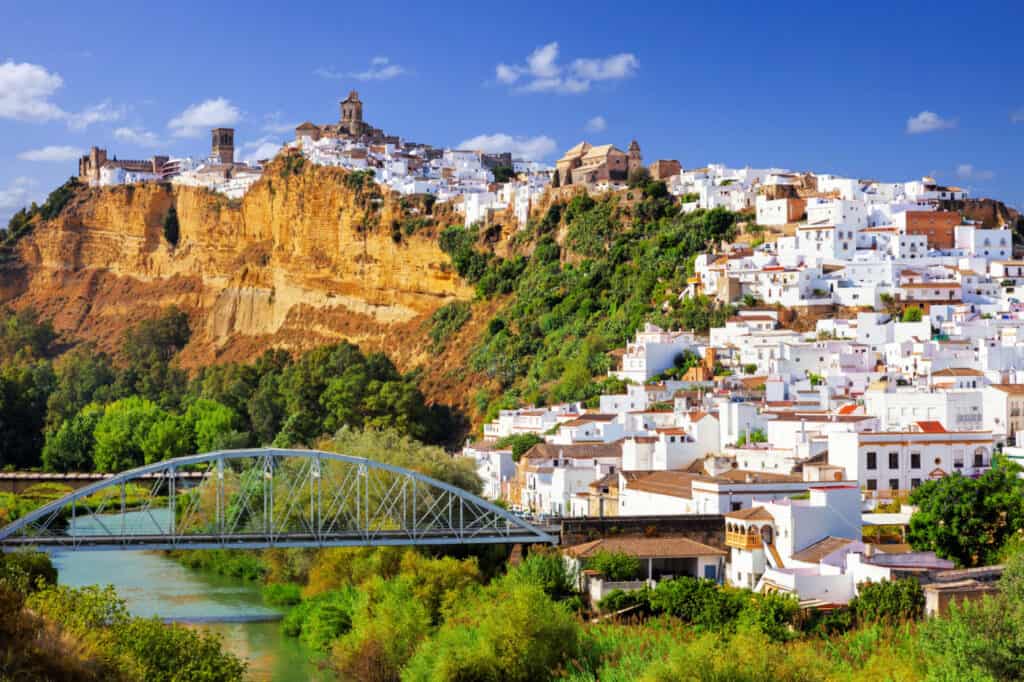
Day Four: Arcos
Jerez is a good base from which to make a couple of day trips, including to one of the most beautiful of the so-called pueblos blancos (white towns), Arcos de la Frontera.
This cute little spot of winding alleyways is dramatically perched atop a cliff. From certain angles, it almost looks like the Church of San Pedro is on the verge of tipping right over the edge.
After cramming our first few days with activities, we spent most of our time in Arcos just enjoying the quiet streets, visiting the compact basilicas, and gazing down on the gentle pastoral views below. While for such a small place there are a fair few tourists, the locals are genuinely friendly and chatty. Plus, there are some delightful little restaurants where you can dine al fresco.
As an added treat, don’t miss out on the little cakes made by the nuns at the Convent of Mercedarias Descalzas. These are sold through a little hatch to keep the sequestered ladies from profane eyes, adding a piquancy of mystery to the palate.
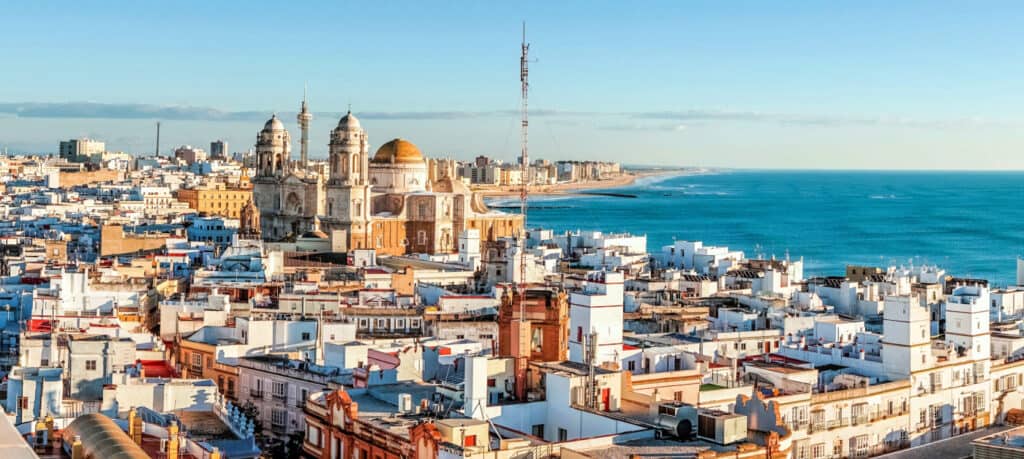
Day Five: Cadiz
One of the glorious things about being in Andalusia for two weeks is the diversity you can experience. Having spent a few days in the interior, we were ready for some coastal breezes!
Cadiz is another easy day trip from Jerez. A little strip of a peninsula encircled by sea, it was first settled by the Phoenicians 3,000 years ago. You can see some of the remnants of this civilization at the Museum of Cadiz, alongside evidence of the later Roman occupation.
Get your bearings by heading to the Tavira Tower, one of the best viewpoints in Cadiz, where you can gaze down on the entire city, including the trio of golden domes that mark out its distinctive cathedral.
Next, head to La Caleta beach and enjoy a walk along the sands, which are sandwiched between two of the city’s castles. It’s a much smaller area than the Playa de la Victoria, but it’s also much closer to the town center if you don’t want to catch a bus to the suburbs.
Don’t miss out on the Mercado Central, where you can buy fresh fish, fruit, and vegetables – or do what we did and dine in on some tortillitas de camarones (shrimp fritters) and a glass of albarino.
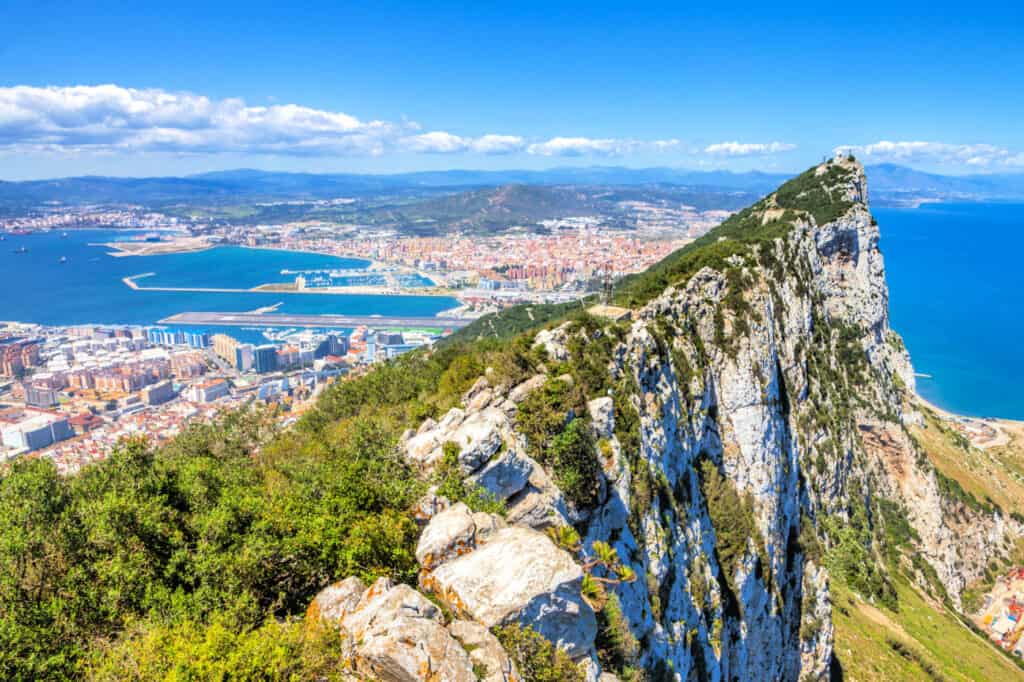
Day Six: Gibraltar
If you don’t have a car, this section of your journey can be a little tricky, since going from Jerez to Gibraltar involves a series of buses. No matter whether you drive or ride, your endpoint will be La Linea, from where you can traverse the border into Gibraltar on foot. You’ll have the unusual experience of entering a territory by crossing a plane runway.
Gibraltar is a funny old place. A little dot of the UK at the tip of southern Spain, here you’ll hear English bandied about more than Spanish and see pubs dot the main square and principal thoroughfare.
The famous Rock of Gibraltar is also an oddity, jutting out of a flat landscape like a rebellious bit of earth that refuses to conform to its surroundings. We decided to scale this beast on foot, though you can also ride up on the cable car. At the top, we were greeted by the locals: Barbary macaques, who run wild (well, semi-wild) – just make sure not to get too close or you may lose your phone!
Atop the Rock are the ruins of a Moorish castle, while inside the rock are a series of tunnels, carved into the mountain by the British Army. You can walk through some of these, which contain exhibits about their historical use during World War II.
Where to stay in Gibraltar: Accommodation options are sparse in Gibraltar, but we found The Elliott Hotel serviceable. It has a nice rooftop pool and is right in the heart of the action.
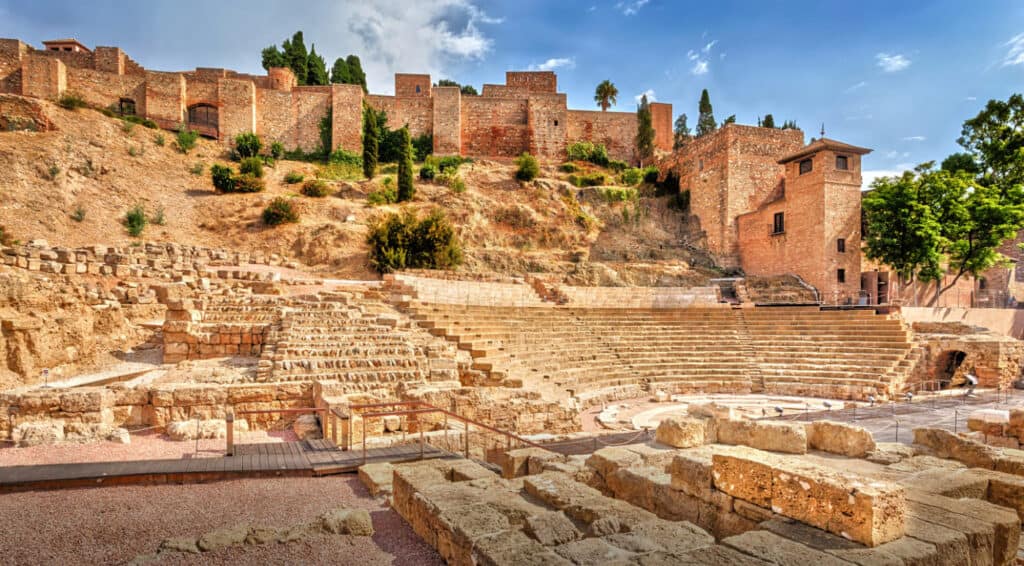
Day Seven: Malaga
If you didn’t get a chance for some beach time in Cadiz, you’ll get a second chance in Malaga. The 1.2-kilometer Malagueta is just 15 minutes’ walk from downtown, so you can pop over at any point when you need a break from sightseeing to enjoy some rays while sipping beer at one of the chiringuitos (local beach bars).
Aside from its soft sands, Malaga is also famous as the birthplace of Picasso. There’s a lovely museum dedicated to his work, which gives a good overview of his life and art. Devotees can also visit the Casa Natal where Picasso was born, but frankly it’s a little underwhelming. We’d recommend instead spending your time absorbing the ambiance of the neighborhood from which the Spanish artist emerged, including the Plaza de la Merced, a pretty square where you can chow down on local specialties like fried fish and sardine skewers.
Malaga is also home to a couple of stately defensive structures that provide some of the most beautiful views in the city: the Alcazaba, one of the best-preserved Moorish fortifications in all of Spain, which towers above an Ancient Roman theater; and the remains of the Castillo de Gibralfaro, whose majestic ramparts overlook the bullring and the cathedral.
Where to stay in Malaga: You’ll find La Casa Azul easily because (as the name suggests) the facade is a lovely bright blue. The interior is as charming as the exterior, with lots of quirky little touches and some unique pieces of furniture. We took advantage of the proximity to the beach for a late-night swim.
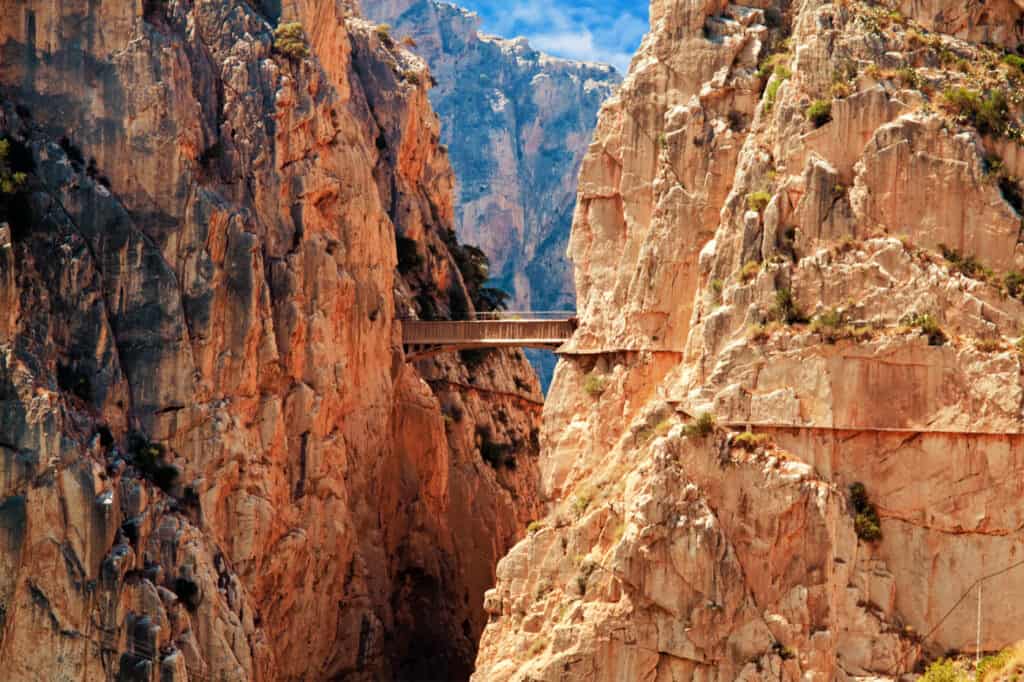
Day Eight: Caminito del Rey
Malaga is a good jumping off point to reach one of the most unusual experiences Andalusia has to offer, the Caminito del Rey. Literally meaning ‘King’s Little Walkway,’ it’s a suspended wooden trail that hugs cliff sides around the Gaitanes Gorge.
This current 8-kilometer path was only opened in 2015. The original route, built in the early 1900s as a way to construct a hydroelectric dam, fell into disrepair years ago and you certainly wouldn’t want to be utilizing it today – we can say that with certainty since remnants of the old route are still visible today.
We recommend taking a guided tour , as this simplifies your transport to the Caminito and includes an expert who can tell you all about the history of the walkway. It takes about 3-4 hours to traverse the entire route, which is fairly flat and suitable for people with limited hiking experience.
Once you return to Malaga, you can spend a bit more time exploring the city or hop on the high-speed train out of town to Granada. This line only opened in 2022, but has dramatically cut the time it takes between the cities to a mere 1 hour and 12 minutes.
Day Nine: Granada

We’re just going to come out and say it: Granada is our favorite city in Andalusia. First off, the Alhambra complex is justifiably acclaimed as one of the most incredible experiences you can have in Spain. It feels like almost every inch of the Nasrid Palaces has been carved with the distinctive geometric patterns of Islamic architecture, from the honeycomb vaulting of the Hall of the Abencerrajes to the Courtyard of the Myrtles, where the tranquil pool reflects back the surrounding architecture so that everything appears doubled.
One of the joys of visiting the Alhambra is you don’t just get to see the exquisite interiors of the palaces. You also get to explore the ramparts of the forbidding Kasbah fortress, which has fabulous views of the city, as well as gardens of the Generalife and the Renaissance palace of Carlos V.
It’s an enormous amount of space to cover, enough to occupy a leisurely traveler a whole day. We, however, wanted to squeeze in a visit to Albaicin as well. Granada’s charming, old Moorish quarter is built into the hill facing the Alhambra and consists of whitewashed houses split by charming, winding streets that still contain an echo of their medieval roots. The area today is dotted with cute little churches, hidden cafes, and the unmissable Mirador de San Nicolas, where you can get the best view of the Alhambra in all its glory.
Once you’ve walked your legs off, duck into Jardines de Zoraya, a restaurant with a beautiful courtyard, delicious octopus salad and a slightly upscale air. If you still haven’t managed to catch any flamenco yet, regular shows also take place here in the evenings.
Where to stay in Granada: Simple but with a fun vibe, we were first drawn to the Oripando Hostel because of its location, but staying there in a private room, we also appreciated its completely chilled atmosphere and quirky backpacker aesthetic.
Day Ten: Sierra Nevada Mountains
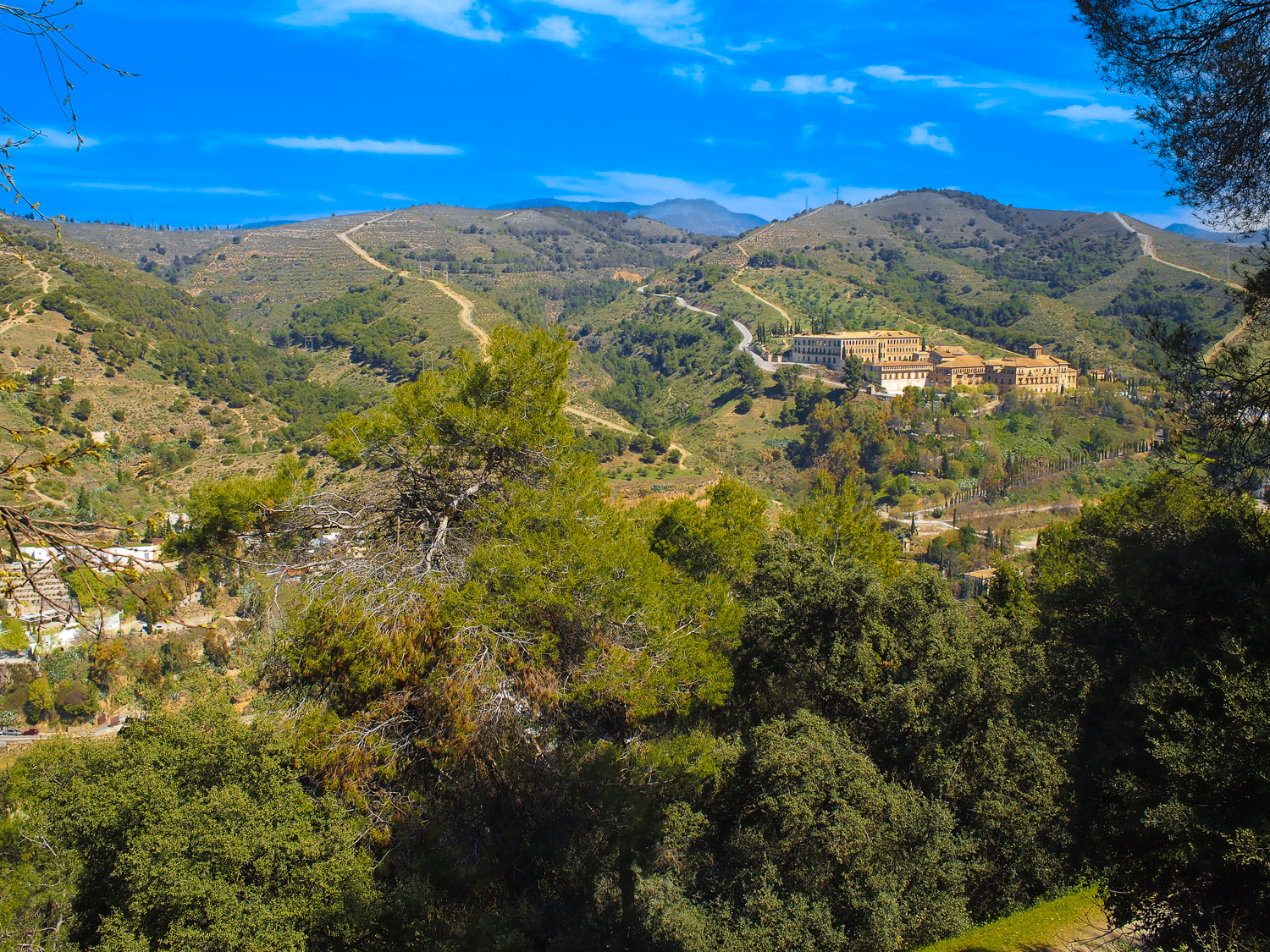
Spend the morning getting out of Granada and into the nearby Sierra Nevada Mountains, which lay claim to having the largest mountain in mainland Spain, Mulhacen. We weren’t quite that ambitious and opted instead for the Los Cahorros pathway, which starts from the village of Monachil, easily reachable from Granada by a 45-minute bus.
This well-traveled trek covers waterfalls, canyons, and some very exciting (in a rollercoaster kind of way) hanging bridges. Don’t fret about getting lost, as the circular route is easy to follow and only takes about 3 hours to complete – just enough time to build up an appetite for lunch!
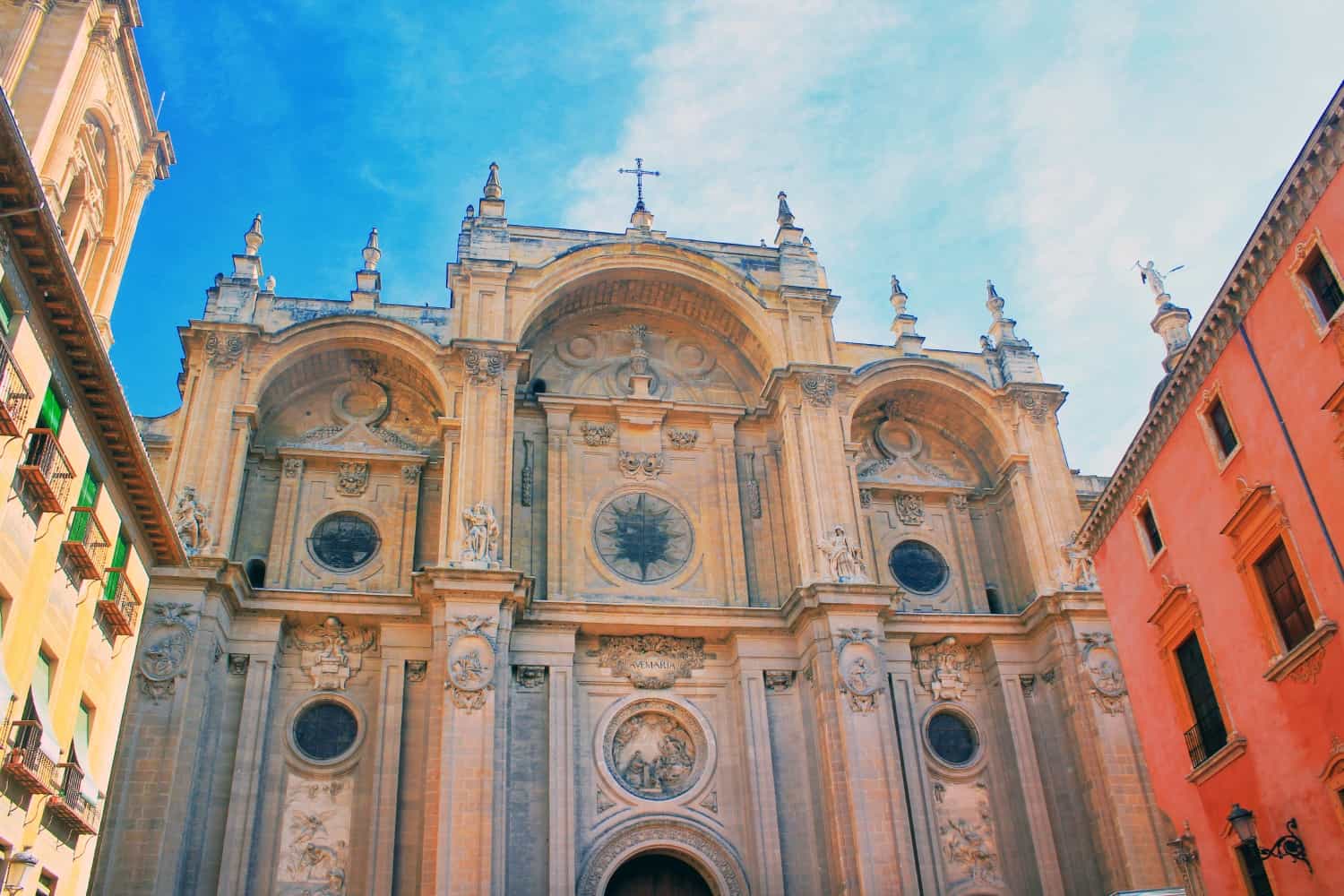
There is still one further thing you can’t miss while you’re in Granada: its cathedral. While from either the Alhambra or the Albaicin it’s clearly visible, from the ground it’s easy to stumble upon it by surprise, hemmed in as it is by the surrounding streets. Inside, a gleaming white nave leads you towards the absolutely stunning cupola: a symphony of stained glass, painted saints, and gilt-encrusted pillars.
Abutting this is the Royal Chapel, the final resting place of the so-called Catholic Monarchs, Isabella of Castile and Ferdinand of Aragon, whose marriage and subsequent reconquest of Andalusia from the Moors united the land and created the footprint for modern Spain.
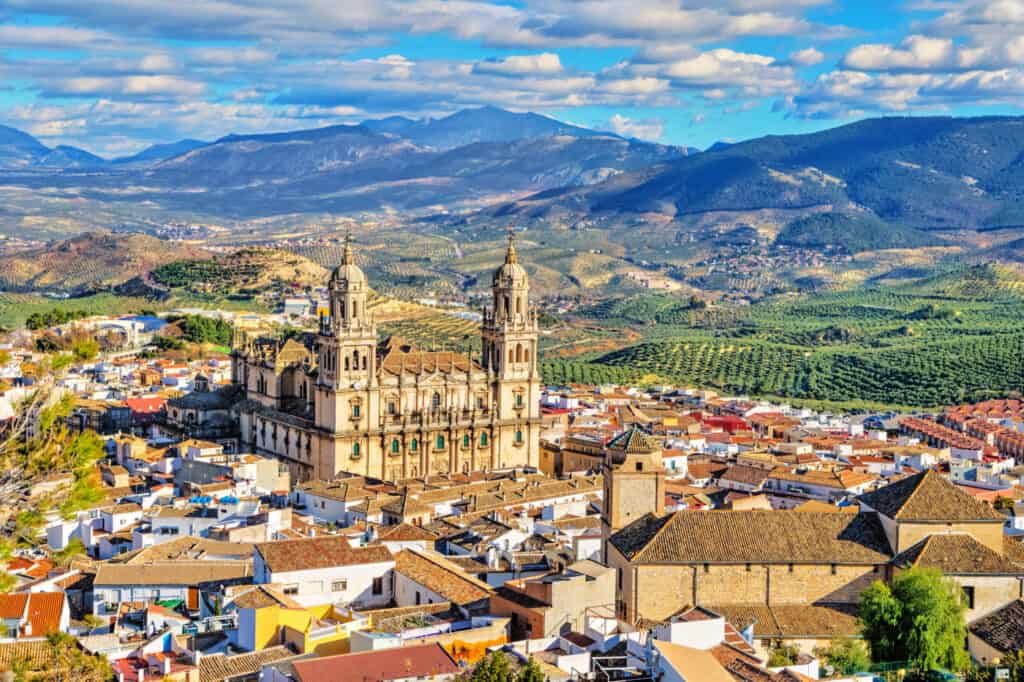
Day Eleven: Jaen
There are just two things you really must do in Jaen: visit the cathedral and visit the castle. To be blunt, this city is not somewhere you will put down as one of the best places you visited on your Andalusia itinerary. The reason we still recommend you stop off here is: one, it’s a good midway point between Granada and Cordoba (it’s a 60-minute bus ride from Granada and a 95-minute train ride to Cordoba); two, from here it’s a convenient day trip to Ubeda and Baeza (see below); and there, we already mentioned that cathedral, right?
We saw a lot of amazing religious edifices in Andalusia, each with its own unique attributes. The somewhat box-like Jaen Cathedral stands out not just because of the intricately sculpted frontal façade, nor because it is the cathedral equivalent of Mike Tyson in terms of pure solidity and intimidation, but mainly because it seems to absolutely dominate the rest of the city in a way no other cathedral that we visited in the region quite does.
For an idea of just how striking it is, walk up to the Castillo de Santa Catalina, a reasonably picturesque ruin where you can gaze down upon the entire city – and really see how commanding the cathedral is.
Where to stay in Jaen: Did we mention that the Castle of Santa Catalina also houses a hotel? Everywhere else we visited, we stayed near the center of town, but here we decided to escape the hubbub and treat ourselves to the well-appointed comfort of the Parador de Jaen .
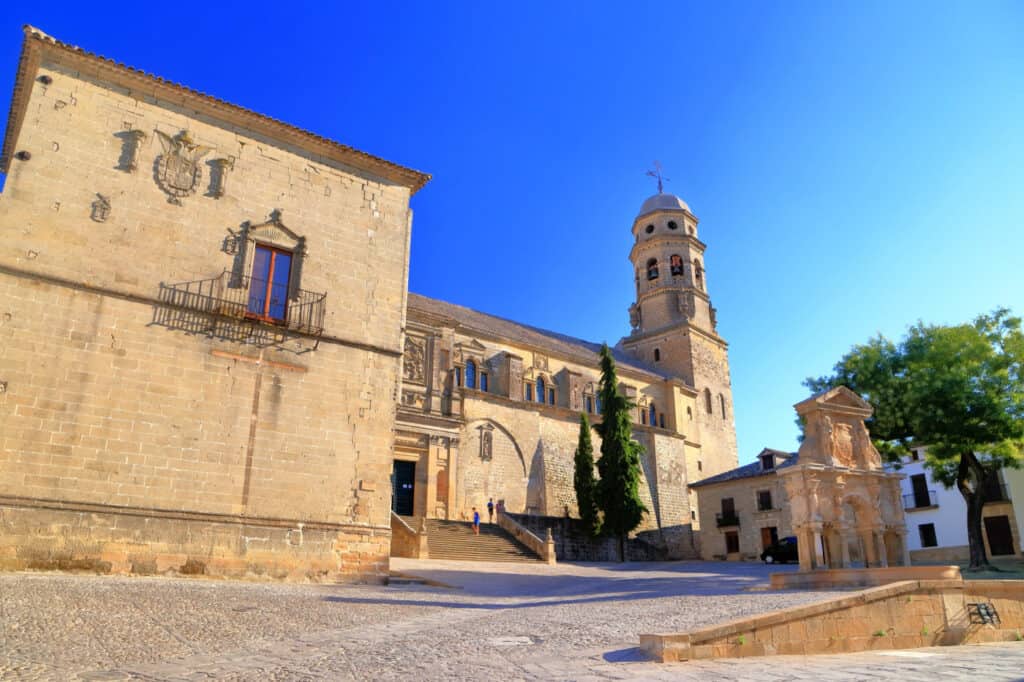
Day Twelve: Ubeda and Baeza
It really couldn’t be easier to get from Jaen to Ubeda and Baeza, as regular buses service the whole route. This pair of towns have been recognized by UNESCO as models of Renaissance architecture in Spain, which makes them feel more Italian than the rest of Andalusia. Being slightly off the beaten track, they’re also a chance to escape some of the metropolitan crowds.
The charm of visiting the old quarters of these two places is that you can lose yourself idly strolling along cobbled streets lined with houses made from yellow stone, ducking your head in wherever you fancy. Just make sure you don’t miss some of our favorite parts: in Ubeda, the El Salvador Chapel (which packs design details into almost every available space, both inside and out) and the Palacio Vela de los Cobos (its quaint library would look perfect in any house); in Baez, the Jabalquinto Palace (the fabulous façade now conceals a university) and the Fountain of the Lions.

Day Thirteen: Cordoba
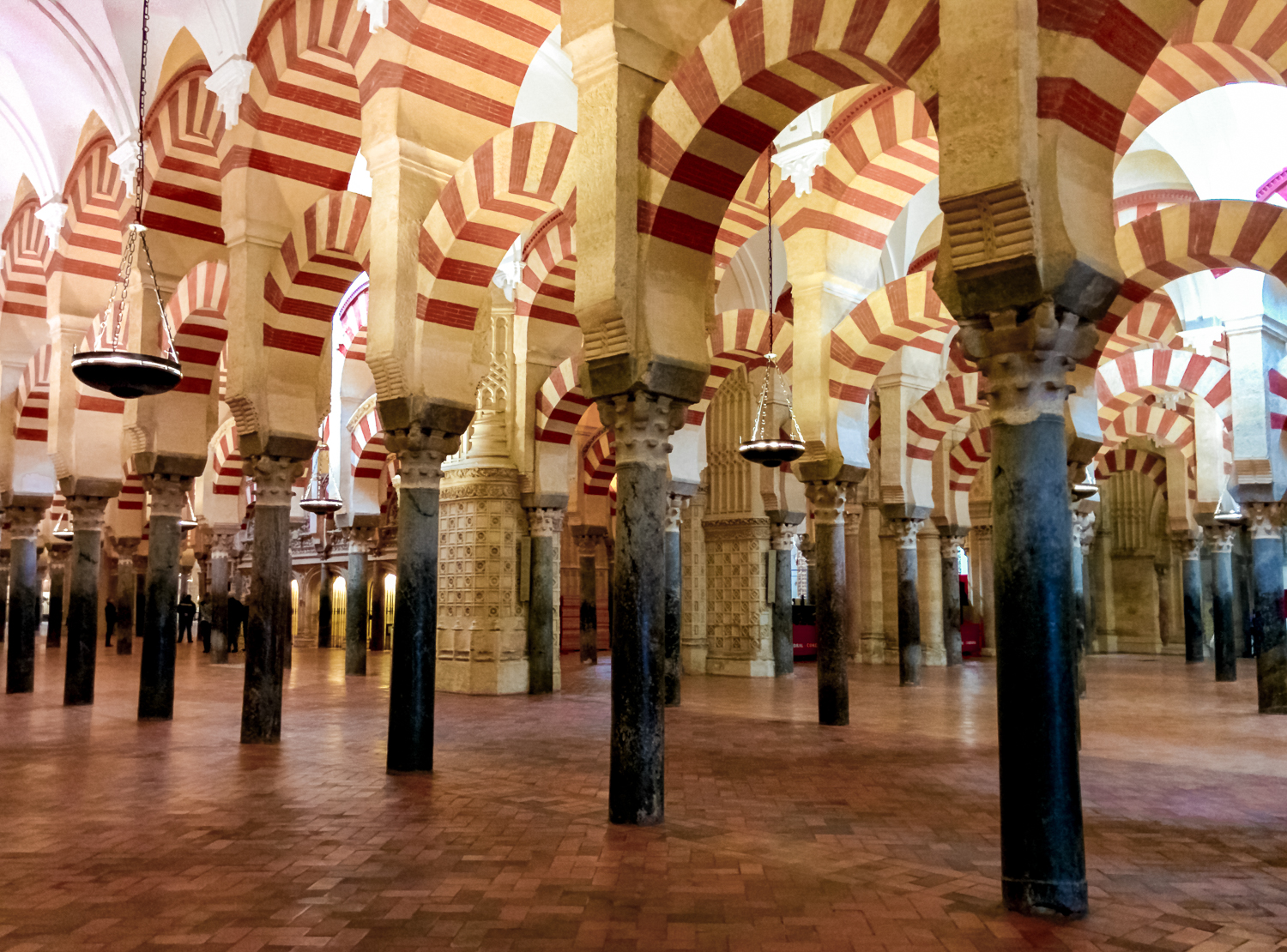
Many of the Christian places of worship in Andalusia are built over, or adapted from, former mosques. The Mezquita, however, is the most unusual fusion of Christian and Islamic architecture we’ve ever seen.
The original mosque was built on the site in the late 8th century and gradually expanded by successive Muslim rulers of the region. When Cordoba was reconquered by Ferdinand III of Castile in 1236, the mosque was made into a cathedral, with numerous chapels built into the original Moorish design, which was thought too splendid to do away with entirely.
What this slightly dry historical information translates into is one incongruous masterpiece. The main hall is filled with row upon row of double-tiered arches from its days as a mosque, while each side of the enormous room is lined with chapels dedicated to various Christian saints. Set into one wall is the mihrab, covered in glittering, golden-tinted mosaics, indicating the direction of Mecca. Right in the heart of the structure, however, is the main chapel, a ridiculously ostentatious structure, stuffed with marble and detailed wood carvings, that wouldn’t feel out of place in Versailles.
Outside, the Patio de los Naranjos (Courtyard of the Oranges Trees) is itself a pretty space to sit awhile, gazing at the minaret-turned-bell-tower that strikes upwards into the sky.
Considering the Mezquita’s reputation as a symbol of Cordoba, it’s appropriate that most of the other things you’ll want to see are all nearby. Just steps away is the Roman Bridge, crossing the city’s branch of the Guadalquivir River. Follow the waterway north, past some scenic old windmills, and you’ll come to the Alcazar de los Reyes Cristianos. Unlike some of the other alcazars we’ve already mentioned, this one’s history as a fortress has been almost entirely supplanted by its current capacity as a pleasure garden where you can escape into a green oasis for an hour.
End the day at the Plaza de la Corredera, where you can munch some croquetas and try salmorejo, an Andalusian version of gazpacho. The square is always abuzz with activity, as the beautiful buildings that surround it still function as apartments for long-time local residents, who often walk their dogs across the expanse while children engage in games of football.
Where to stay in Cordoba: As you might have gathered, we are obsessed with the Mezquita, and the Ermita Suites are right next door. The apartments here are like something out of an interior design magazine, and the clean, predominantly white décor is faultlessly chic.
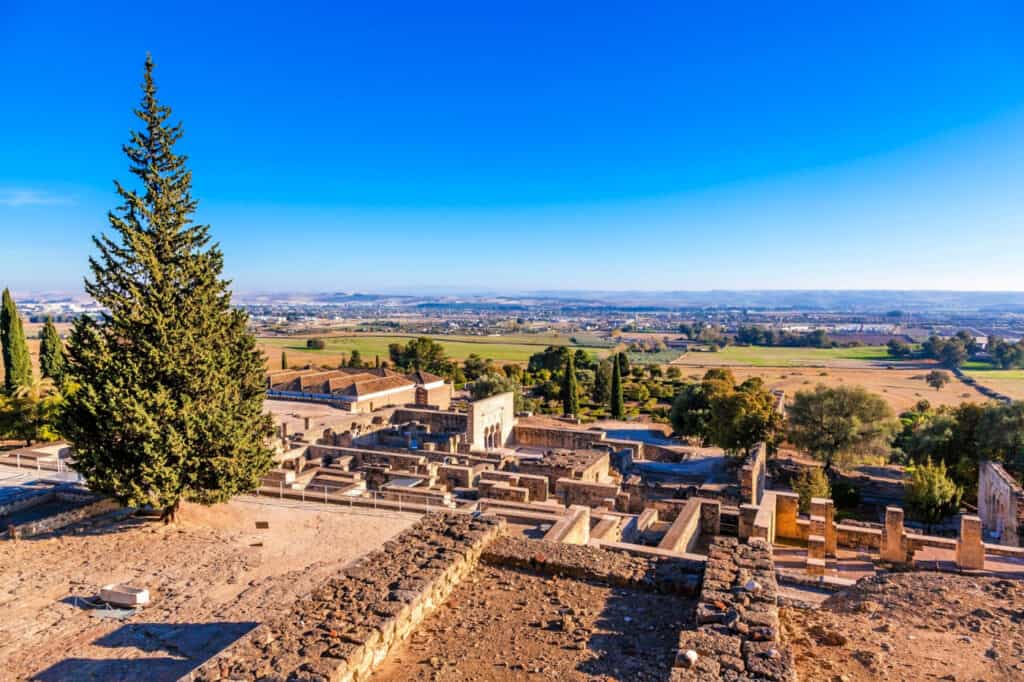
Day Fourteen: Cordoba/Seville
It’s less than an hour on the train from Cordoba back to Seville, so if you’ve got time to squeeze in one more activity before your flight, visit the UNESCO World Heritage Site of Medina Azahara. Located just outside Cordoba, it’s about a 25 to 40-minute drive, depending on if you take a car or local bus. If you’re worried about the logistics, you can also visit as part of a guided tour .
A guide might be wise, since most of the site is now mere ruins, with only a handful of areas having so far been pieced back together. On our visit, we could see just how painstaking the ongoing restoration is for the people tasked with revitalizing the faded glory of what was once a symbol of the wealth and might of the Caliphate of Córdoba.
Why visit if it’s mostly ruins? Because it’s not difficult to imagine just how opulent the place must have been once upon a time. Make sure you take the time to watch the informative introduction video and wander the museum of recovered artifacts before hopping on the shuttle bus to the archaeological site, as this will really help with reconstructing the fragments of sand-colored bricks and pillars into the fabulous palace-city they once formed.
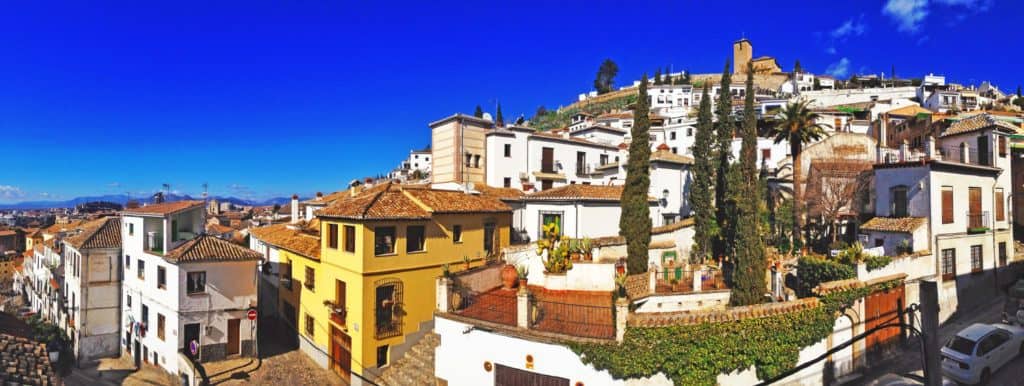
And That’s How to Spend Two Weeks in Andalusia!
This is really just a taster of what Andalusia has to offer. We could have included the breathtaking clifftop town of Ronda (which we covered here in an earlier post ); the Tabernas desert, a picturesquely barren expanse used as a filming location not just by Spaghetti Western pioneer Sergio Leone but also Games of Thrones; or the Doñana National Park, a wetland reserve with beautiful walks and myriad birdlife.
For people who love their beach time, 14 days in Andalusia might be better spent in the resort paradises of Marbella or Nerja. In our (perhaps controversial) opinion, however, a beautiful beach is a beautiful beach anywhere in the world, but the Cathedral of Seville, the Alhambra of Granada, the charming towns of Arcos de la Frontera and Ubeda, the Mezquita of Cordoba, the Sierra Nevada Mountains and the precarious walkway of the Caminito del Rey are all utterly unique.
Lauren Juliff
Lauren Juliff is a published author and travel expert who founded Never Ending Footsteps in 2011. She has spent over 12 years travelling the world, sharing in-depth advice from more than 100 countries across six continents. Lauren's travel advice has been featured in publications like the BBC, Wall Street Journal, USA Today, and Cosmopolitan, and her work is read by 200,000 readers each month. Her travel memoir can be found in bookstores across the planet.
Related Posts

How to Spend One Week in Mauritius: An Itinerary for First-Time Visitors

What’s it Like to Travel in Liechtenstein?

What to Take On the Camino Primitivo: My Detailed Packing List
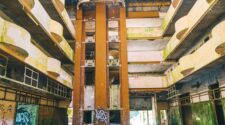
Exploring the Abandoned Monte Palace Hotel in Sao Miguel
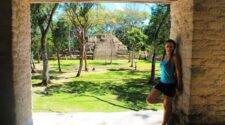
How to Spend Two Weeks in Belize: An Itinerary for First-time Visitors
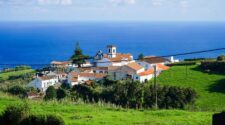
13 Reasons to Plan a Trip to the Azores
Leave a reply cancel reply.
Your email address will not be published. Required fields are marked *

14 Days in Andalusia: The Ultimate Andalusia Road Trip Itinerary
Planning to spend 14 days in Andalusia and looking for the best road trip itinerary to make the most of your time and discover the gems of the South of Spain? I am here to help and share the best travel tips for Andalusia.
Andalusia is a large region in the south of Spain . It is a very diverse area and offers visitors many different things. Starting from national parks and beaches and ending with museums and architectural gems.
Here you will find famous Spanish cities like Seville and Granada together with charming towns like Ronda and Cadiz. I have to say that this is my favorite area of Spain and here you will find the most beautiful places in Spain, so I am even more excited to share them with you!
As you already know, you will find a road trip itinerary for 14 days in Andalusia, a lot of additional travel tips, hotel recommendations, the best restaurants and so much more.
Keep on reading and I will help you plan the best road trip around Andalusia.
*Disclosure: This article contains affiliate links. If you make a purchase after clicking one of these links, I earn a small commission at no extra cost to you.
How to get to Andalusia?

In order to follow this Itinerary, you will have to land at Seville Airport also known as Sevilla-San Pablo Airport. It is the sixth biggest Airport in Spain and offers many international destinations, so it is a perfect way to start your road trip for 14 days in Andalusia.
Depending on the arrival time, I suggest you head straight from the airport to your first destination, which will be Cordova. Of course, if you arrive late at night, you can use the chance to spend a night in Seville, but we will keep it for the end of this trip.
Another optional arrival is Málaga-Costa del Sol Airport . You will have to split this itinerary and start from day 4, but you can still follow this plan and organize your trip from Malaga.
How to get around for 14 days in Andalusia?

In order to follow this Itinerary, you will need to rent a car . It is possible to visit Andalusia by train, but you will miss out on a lot of gems. So if you want to discover the soul of Andalusia in 14 days, a car rental is a must.
I always use Rentalcars which is an international online car booking service. They match you with the best prices and have a flexible cancellation policy – you can cancel or change most bookings for free up to 48 hours before the pick-up. I only had the best experience with them, so I can recommend this company, but there are endless opportunities online or at the airport arrivals.
Click here to find your car rental for Andalusia.
Overview of your 14 days in Andalusia

Day 1: From Seville to Cordova Day 2: from Cordova to Granada through Jaén Day 3: Granada Day 4: From Granada to Malaga through Nerja and Frigiliana Day 5: Malaga + best hikes & beaches Day 6: From Malaga to Marbella through Colomares Monument and Mijas Day 7: From Marbella to Ronda through Júzcar Day 8: Additional night in Ronda: visit Setenil de la Bodegas and Olvera Day 9: from Ronda to Cadiz through Arcos de la Frontera Day 10: from Cadiz to Seville through Jerez Day 11-14: Seville
This is your itinerary for 14 days in Andalusia at a glance. I will share the best things to do, where to stay, and some restaurant recommendations together with cool experiences in Andalusia. Driving time and useful travel tips included!
Remember, you can follow this Itinerary starting from Malaga or in reverse if it suits your needs. Or if you have only 10 days in Andalusia, you can still follow this Itinerary and cut it after the arrival to Seville in case you have already been there or want to keep it for your next travels.
Are you excited to discover Andalusia and plan an unforgettable road trip for 14 days in Andalusia? Because I am! Keep on reading!
Day 1: From Seville to Cordoba

Driving time: 1 hour and 25 minutes, 137 kilometers.
Your road trip of 14 days in Andalusia starts with landing in Seville. But from there I want you to head directly to Cordoba.
Don’t worry, you will have time to visit Seville at the end of the road trip. I suggest you take A-4, stay on the motorway for 130 kilometers, and enjoy the views from your window.
Cordoba is one of the best towns in Andalusia and here you will find the perfect mix of Arab and Spanish art. Discover the best things to do in Cordoba and unlock the charm of this charming Spanish town.
Remember, if you arrive in the afternoon at Corboda, you can just visit the Old Town and keep other activities for the day after.
Visiting old town

The old town of Cordoba is a real gem of Andalusia and you shouldn’t miss it during your trip. Get lost and discover some of the best places in Cordoba’s old town.
Start with the Calleja de las Flores, a picturesque alley with pots full of flowers hanging on the walls, and end with Plaza de la Corredera, which is a square built on the model of the traditional Castilian Plaza Mayor.
The Jewish district of Cordoba is a nice attraction filled with cute patios and history. Don’t forget to add Córdoba Synagogue to your itinerary as well.
Roman Bridge of Cordoba

This historical landmark of Andalusia was built back in the 1st century BC. Roman Bridge of Cordoba stands over the Guadalquivir River just in front of the famous Mosque-Cathedral of Cordoba.
The bridge takes you from the Old Town to The Calahorra tower and it is a perfect place for an evening stroll.
Mosque-Cathedral of Cordoba

This mosque is another important symbol of Arab influence in Andalusia. It is one of the most beautiful places in Andalusia and you shouldn’t miss it during your time in Cordoba. It is open from 11 am until 7 pm and the entrance fee for an adult is 11 euros.
Please remember to dress accordingly when visiting this mosque. Also, for 14.99 euros you buy a skip-the-line ticket in advance. Click here to buy yours.
Alcazar of the Christian Monarchs

Alcazar of the Christian Monarchs is another important tourist attraction in Cordoba. In the past, it served as a palace and a fortress. Nowadays, you can visit the castle and enjoy the spacious gardens with fountains, which was my favorite part of the visit.
Keep in mind, that it is closed on Monday, so plan accordingly and book your ticket here . You will find the opening times there as well.
Other things to know before visiting Cordova
Where to eat in Cordova? If you like typical Spanish cuisine and want to try some local things, head to Taberna Casa Pedro Ximénez or Paseo Iberico. If you prefer fine dining, Noor Restaurant should be your number one choice.
Where to stay in Cordova for one night? Eurostars Azahar is a 4-star hotel with mid-range prices in the heart of Cordova close to the historical sights. Parking will cost you an additional 13 euros. Click here to book it.
Want to know more about Cordova? Book the best-rated guided tour that covers the Jewish Quarter, Synagogue, Mosque, and Alcázar. Click here to see all the details.
Day 2: from Cordoba to Granada through Jaén

Driving time: from Corboda to Jaén 1 hour and 26 minutes, 120 kilometers, and from Jaén to Granda 50 minutes, 86 kilometers.
On your second day in Cordoba, you can finish up your Itinerary and visit the places that you missed on the first day. Once you are done, you will head to Jaén for a short stop and possible meal and then head to the next destination of your 14 days in Andalusia, which is Granada.
I recommend you take roads A-4 and A-311 from Granada to Jaén, especially if you are visiting during the peak season.

Imagine stunning castles with unique fortresses surrounded by charming olive gardens. That is Jaén and that is the main reason why you should make a quick stop in this hidden gem of Andalusia. It is not needed to spend a night here, but I highly recommend arriving here around lunchtime.
The main attraction of Jaén is Jaén Cathedral. The entrance fee is 5 euros, but it is worth visiting. Around the central part, you will find many historical churches, Arab baths, and the Jewish Quarter.
Also, I suggest you visit Calle Duque for an amazing view of the Cathedral, on Google Maps you will find it as Mirador a la Catedral.
Where to eat in Jaén? Bomborombillos is one of the best restaurants in Jaén and it offers a wide variety of tapas for very affordable prices and some unique Spanish dishes as well. Don’t miss it!

Granada is a famous medieval city and that is your next destination after visiting Jaén. Considering its size, I recommend you spend 2 nights here, to visit the most beautiful places in Granada.
Also, depending on your arrival, you can use your first evening to relax or enjoy a simple stroll around the city and keep all the activities for the day after.
More things to know before visiting Granada
Where to eat in Granada? If you are looking for some traditional places, I can recommend these 3 restaurants: La Taberna de Kafka, Bar Avila, and El Mercader. La Taberna de Kafka is a very affordable restaurant, but if you are looking for something fancy, don’t miss Faralá.
Where to stay in Granada for 2 days? If you are looking for a mid-range apartment with available parking in the city’s heart, I recommend Elvira Suites . But if you are looking for a splurge, you can’t go wrong with La Corrala del Realejo.
Day 3: Granada

On your day 3, you can finally rest from driving and discover Granada on your feet. You also won’t be changing hotels, so you can take it slow, enjoy your breakfast, and start your day exploring.
Don’t forget to check the previous section for restaurant recommendations and make your reservation in advance. So what are the best things to do in Granda?

Alhambra is another palace combined with a fortress and one of the most beautiful places that I have ever seen. It is the main attraction of Granada and it cannot be missed during your two weeks in Andalusia.
Keep in mind that the number of daily tickets is limited, so I highly suggest buying your ticket before, especially if you are visiting Andalusia during the peak season.
To visit Nasrid Palaces, you will have to book a specific time slot and you will have to be there at your scheduled time. Click here to see the opening times.
A general adult ticket will cost you 14 euros and you can purchase your tickets here. I don’t advise using any third-party sellers unless you want to overpay. You will need to show your ID once you enter, so don’t forget to take it with you.
The entire visit will take you around 3 hours, so the best is to start at the opening time and plan your lunch after visiting Alhambra.
The old town of Granada

After lunch, you can enjoy a nice stroll around Granada’s old town, also known as Albaicin. Get lost in tiny medieval streets and visit its jewels.
You cannot miss Granada Cathedral, Corral del Carbón, Palacio de la Madraza, Plaza Bib Rambla, Plaza Nueva, Real Chancillería. You should finish your visit with Alcaicería, a modern-day bazaar, and get some souvenirs there. It can be a bit of an overwhelming experience, but that is the charming side of every bazaar.
You can easily spend a couple of hours in the old town of Granada because you will constantly find new attractions, cute squares, and historical landmarks. If you are feeling tired, I suggest visiting Cathedral and bazaar as these are the best places to see in Granda Old Town.
Fun experiences in Granada that you shouldn’t miss

In the afternoon, you will have some additional time, so here are some options for your Granada Itinerary. We all have different interests while traveling, so choose the most suitable experience for your own preference.
- Hammam Al Ándalus with Optional Massage: if you are looking for some relaxation during your trip, this is a perfect way to spend your afternoon in Granada. Click here to see all the details and book your experience.
- Walking Food Tour: if you are a foodie like me, you can’t miss this food tour. The best local products, knowledgeable guide, and fun way to discover the food scene in Granada. Click here to see all the details and book your experience.
- Sunset Walking Tour in Albaicín & Sacromonte: maybe you want to know more about Granada directly from the local guides? This should be your number one choice. This one is great for photography lovers as you will cover some of the best photo spots in Granada. Click here to see all the details and book your experience.
Day 4: From Granada to Malaga through Nerja and Frigiliana

Driving time : from Granada to Nerja 1 hour, 93 kilometers, from Nerja to Frigiliana 12 minutes, 7 kilometers and from Frigiliana to Malaga 45 minutes, 58 kilometers.
After a bit more relaxation in Granada, you will have to spend longer on the road. However, it is worth it as you are about to discover some of the best towns in Andalusia.
You can easily start with Frigiliana and then head to Nerja or do it the other way around. Let’s see why these places are worth visiting and what day 4 out of 14 days in Andalusia has to offer.
RELATED : 130+ Best Spain Quotes and Spain Instagram Captions + Beautiful Sharable Photos

Nerja is a resort town and has one of the best beaches in Andalusia. Here you will find the Balcony of Europe that offers some amazing views over the sea, but your main focus is going to be beach time.
Playa Burriana is the longest sand beach in Nerja and it is completely free unless you want to rent a bed with an umbrella. Prices are very affordable and start from 5 euros. Playa la Caletilla will be a better option for you if you are looking for something intimate.
Looking for something active instead? Head for a hike to Rio Chillar and discover the hidden gem of Andalusia. Keep in mind, that it is a long and challenging hike. Most of the hike is inside the river, so you will need to wear trainers.
Make sure you bring water and some snacks as well. It takes 1 hour to reach the most beautiful part of the hike and 2 more hours to see the waterfall, then another 3 hours to go back. It is open any time of the day all year round and free of charge.

If you like small charming towns, Frigiliana will be one of the best attractions in Andalusia for you. It is a maze of cobblestone streets, color-coordinated white houses, and colorful plant pots all over the town.
Wandering around the streets of Frigiliana is one of the best things to do in Andalusia. And you will be there snapping cute photos on every corner.
Some of the main attractions in Frigiliana include: El Torreón, Panorámica Frigiliana, Church Square. Centro Histórico de Frigiliana is where you should start your exploration. Also, you will find a lot of steep streets, so bring comfortable shoes with you.
I personally couldn’t find inspiring restaurants in Nerja, so I waited until Frigiliana to get some food and La Taberna del Sacristán didn’t disappoint. The food is delicious, the prices are affordable and they have a nice terrace with some amazing views.

Once you are done with Nerja and Frigiliana, it is time to head to Malaga where you will be staying for the next 2 days.
Take it easy on the first day and enjoy some walks around Malaga, but keep exploring for the day after. We will cover the most beautiful places in Malaga and the best things to do, including more beach time or hiking options for activity lovers.
Other things to know before visiting Malaga
Where to eat in Malaga? Malaga is a paradise for every foodie because the options are endless. Darna Restaurant is one of my favorite restaurants; it offers fine dining and healthy local meals. If you are looking for the best tapas in Malaga, don’t miss Anyway WineBar.
Other great restaurants with local cuisine include La Proa de Teatinos, La Alacena de Francis, and Meson Iberico. Luxalad Málaga Centro is the best choice if you are looking for healthy meals and affordable prices.
Where to stay in Malaga for 2 days? During my last trip, I stayed at ICON Malabar. It was a wonderful and very relaxing experience. For a 4-star hotel, the prices are very affordable but keep in mind that parking will cost you an additional 17 euros per day. But I have to say that I have my eyes on Palacio Solecio, a Small Luxury Hotel of the World for my next trip.
Day 5: Malaga + best hikes & beaches

Just like in Granada, you will spend an additional day in Malaga and discover what are the most beautiful places in Malaga. I will include one of the best hikes in Spain located near Malaga, some more beaches for those who enjoy swimming, and more authentic experiences in Andalusia to make your experience unforgettable. Most of these things are optional, so it is up to you to decide what excites you the most.
What to see in Malaga?

One of the main attractions of Malaga is Gibralfaro Castle. Unfortunately, you won’t find much inside this ancient castle, but the views from the top are epic.
You can visit it together with The Alcazaba of Malaga – another place you should see in Malaga. The combined ticket is 5.50 euros and it should keep you busy for a couple of hours. It opens at 9 am, so I just you head there for the opening time.
Malaga Roman Theater is an important historical attraction just around the corner from previous places to see in Malaga. And it is free of charge, so don’t miss it.
The Cathedral of Málaga is another place that attracts tourists. I also recommend you visit Atarazanas Market and La Concepción Historical Botanical Gardens.
Best hiking near Malaga – El Caminito del Rey

One hour drive away from Malaga, you will find one of the most beautiful hikes in Andalusia. El Caminito del Rey is almost 8 kilometers long and it takes around 4 hours to go from the beginning until the end.
It used to be a very dangerous hike, but nowadays, it has been rebuilt, so it is a relatively easy hike, but not suitable for someone who is scared of heights. You will need to bring your own water and some light snacks. And bring
The path starts at the Guadalhorce dam and ends at El Chorro. From El Chorro you will find a shuttle bus that takes you back to Guadalhorce Dam, so you can reach your car unless you want to walk the same path once again. It is open from 9 am and the entrance fee is 10 euros.
You can also book a guided tour at El Caminito del Rey. It is perfect for you if you want to learn about the history behind this place and want to avoid any organization side of the hike.
The entrance ticket is included together with a shuttle bus, parking, and one bottle of water. You can book your tour here.
Best beaches in Malaga

The most popular beach in Malaga is Playa De La Malagueta. It is easy to reach, wide and alive. Comes with a crowd as well. I personally prefer Playa Peñón Del Cuervo.
It is still crowded, but not filled with tourists, so mostly busy during the weekend. It is also a very pretty beach with a unique rock in the middle, but you will have to take the car to reach it. The good news is that the parking is free.
Want to spend some time on the boat? Explore the coastline on your own boat for a couple of hours and become the captain of the day. Click here to see all the details.
Day 6: From Malaga to Marbella through Colomares Monument and Mijas

Driving time: from Malaga to Colomares Monument 40 minutes, 30 kilometers, from Colomares Monument to Mijas 15 minutes, 88 kilometers, and from Mijas to Marbella 30 minutes, 35 kilometers.
Get ready for another exciting day on the road and discover the best of Andalusia. Make sure you get proper rest the day before, so you can enjoy your trip to the fullest. What is on the menu for today? Let’s take a look!
Colomares Monument

Colomares Monument is a stunning castle a hidden gem of Andalusia. It was one of the places that I wanted to visit the most, so I don’t understand how so many people still miss it. It was dedicated to the life and adventures of Christopher Columbus and it is a true architectural treasure.
It is closed on Mondays and opens at 10 am, so I suggest you leave Malaga around 9.30 am. There is no need to rush because it doesn’t get as crowded as many other tourist attractions in Andalusia. But don’t forget that it is closed on Mondays.
The adult ticket is only 3 euros. I have never been to such a beautiful castle for such an affordable price. This should make you understand how hidden it is. Audio guide included.
Mijas Pueblo

Mijas is another cute village in Andalusia filled with white houses. Yet it is different from Frigiliana, so you cannot exclude it from your road trip itinerary for Andalusia. Wondering what to see in Mijas Pueblo?
You don’t want to miss Plaza Virgen de la Peña, Ermita de la Virgen de la Peña and Pl. de la Constitución. But other than that, enjoy your walk between tiny white houses, look for some cute souvenir shops and enjoy the views this town offers. And don’t forget to snap some cool photos on your way, because every corner of Mijas is very picturesque!
Where to eat in Mijas Pueblo? If you are visiting Mijas around lunchtime, you will find many inviting restaurants, so use this chance to try some more authentic Spanish food. We choose Koco Bistro and it lived up to our expectations.

Marbella is great for 2 things – beach and old town. The old town was my personal highlight and I suggest you head for a walk and get lost. It is filled with typical Spanish houses, flowers, plants, and cute cafes, and I am sure that you will leave charmed by it. So depending on your arrival, you can enjoy yourself at the hotel or head to discover the old town of Marbella. You can add Marbella Urban Wall, Plaza de los Naranjos and Iglesia de Nuestra Señora de la Encarnación to your Marbella itinerary.
Other things to know before visiting Marbella
Where to eat in Marbella? We enjoyed one of the best tapas at Mia Cafe. This place is in the old town and is perfect for a quick bite. Especially if you are looking for a cute cafe with a nice atmosphere and authentic food.
Where to stay in Marbella? If you are looking for an affordable yet luxurious hotel in Marbella, Molo Luxury Suites Puerto Banus is the right choice for you. Keep in mind, that it is not in the center of Marbella, so you will have to take the car to visit the old town, however, parking is free and the views are spectacular.
And you have access to the outdoor pool in case you want to take a break from the beaches. Looking for something mid-range in the old town of Marbella? Precioso apt en casco antiguo de Marbella is a great option as well.
Day 7: From Marbella to Ronda through Júzcar

Driving time: from Marbella to Júzcar 1 hour, 55 kilometers, and from Júzcar to Ronda 35 minutes, 24 kilometers.
If you still didn’t get enough beach time, you can use your morning for a quick swim or a tanning session. And then get ready to hit the road to discover one of the most epic places in Andalusia – Ronda. On your way, you can discover another cute town of Andalusia to take a break or have a quick bite.

Júzcar is also known as a Smurf town. Unlike other famous towns in Andalusia, this one is filled with blue houses and that is where the name comes from. Surprisingly, it is another hidden gem of Andalusia, so that is an additional reason to visit Júzcar.
Back in 2011, every single building here was painted blue: houses, the Church, the cemetery, and the Town Hall, to embrace the premiere of the world-renowned film The Smurfs 3D.
Once the filming passed, the locals decided to embrace it and keep the houses blue. This decision brought some additional income to local inhabitants and more visitors to the town.
And if you want to have lunch in one of the blue houses, head to Bar Torricheli. It is a very simple place with simple food, but great for a quick lunch and some healthy meals.

You can’t visit Andalusia and skip Ronda. Ronda is a must in every road trip itinerary for Andalusia, so this is going to be your next destination and base for 2 days.
Puente Nuevo de Ronda is the main attraction in Ronda and you will have to find some best viewpoints to capture the beauty of it.
You will need to put Mirador Puente Nuevo de Ronda as your destination on Google Maps and head to Plaza de Maria Auxiliadora and from there you will see a path that takes you down. It is an easy path, but you will have to be careful. I did it with sandals, but some comfortable shoes would make my life much easier.
You should visit Ronda Town Hall, Plaza del Socorro, Puerta de Almocabar, and Bullring of the Royal Cavalry of Ronda. But you should be able to see it all in one afternoon. I suggest you keep the viewpoint for the sunset and visit other attractions before that.
Other things to know before visiting Ronda
Where to eat in Ronda? Tropicana is one of the best restaurants in Ronda together with Puerta Grande. Puerta Grande has a simple setting and authentic recipes, while Tropicana offers a modern setting and some great vegan options. Prices are very similar in both of these places.
Where to stay in Ronda for 2 days? Catalonia Ronda is hands down the best hotel in Ronda. Especially if you are looking for epic views and swimming pool access. Hotel Don Miguel is a great option for budget travelers. Both of these hotels offer parking for an additional 15 euros per day.
Day 8: Additional night in Ronda: visit Setenil de la Bodegas and Olvera

Driving time: from Ronda to Setenil de la Bodegas 25 minutes, 17 kilometers, from Setenil de la Bodegas to Olvera 23 minutes, 15 kilometers, from Olvera back to Ronda 45 minutes, 52 kilometers.
On the 8th day of your Andalusia road trip, you will keep Ronda as your base but drive around to discover other important attractions. If you are passionate about history, add the Ruins of Acinipo to your itinerary. Or implement hiking at Sierra de Grazalema in case you haven’t yet gotten enough.
Setenil de la Bodegas

Setenil de la Bodegas is a charming Spanish town built inside the cliff. The houses and some streets are covered with cliffs, making it one of the most unique places in Europe.
You should discover these rock-covered streets, find some of the best views, visit some of the churches on your way, and enjoy some more tapas. In one hour, you can visit the town, but you will need to plan some additional time for eating depending on your arrival time.
Bonus tip: make a quick stop at the Santuario de Nuestra Señora de los Remedios before arriving in Olvera.

One of the best things about Olvera is the views that you get to see on your arrival. It is often overlooked by tourists since they rather visit Ronda or Setenil de la Bodegas, so this is your chance to discover another hidden gem of Andalusia.
The Church of Nuestra Señora de la Encarnacion stands on the top of the town and pops out perfectly over the white town. Climb all the way up to this church and walk Calle Calzada to find some of the best photo spots in Olvera. The castle of Olvera offers even better views over the city and the entrance fee is 2 euros.
There are a lot of affordable restaurants in Olvera. I can recommend Bodeguita Mi Pueblo, but I saw some other great options in Olvera as well. Once you are done with Olvera, head back to Ronda, enjoy a relaxing evening by the pool, or soak in more of those views over the bridge.
Day 9: from Ronda to Cadiz through Arcos de la Frontera

Driving time: from Ronda to Arcos de la Frontera 1 hour 10 minutes, 86 kilometers, and from Arcos de la Frontera to Cadiz 40 minutes, 65 kilometers.
Your next destination is Cadiz, however, the road from Ronda to Cadiz is long and not very exciting. For this reason, I suggest you make a break in the middle and stop at the Arcos de la Frontera. This is optional, but I think this little town deserves a visit, and let’s find out why.
Arcos de la Frontera

Arcos de la Frontera is built on top of the cliff and together with a river creates a wonderful landscape. One of the coolest places in Arcos de la Frontera is Basilica de Santa María de la Asunción together with Mirador de Abades and Palacio del Mayorazgo.
Mirador Plaza del Cabildo is my personal highlight as from this side you can see the massive cliff and take some great photos. After some research, I decided to have lunch at the Restaurante Aljibe and it didn’t disappoint. In fact, it is hands down one of the best restaurants in Andalusia.

Cádiz is an ancient port city rich in remarkable sights and surrounded by picturesque towns, wild landscapes, and wonderful beaches. I personally fell in love with Cadiz and it was one of my personal highlights of the entire trip.
Looking for the best things to do in Cadiz? Click here to read my ultimate Cadiz travel guide. This article covers food recommendations and the best hotels in Cadiz for every budget together with other practical tips.
Day 10: from Cadiz to Seville through Jerez

Driving time: from Cadiz to Jerez 28 minutes, 35 kilometers, and from Jerez to Seville 1 hour, 92 kilometers.
Considering that you spent the entire afternoon in Cadiz, make sure you check off the last things from your Cadiz bucket list and head to Jerez. It is going to be a quick stop before heading back to Seville.

Jerez is the most popular day trip from Cadiz and soon you will understand why. The cathedral is the main Christian symbol of the city and it’s a real baroque-neoclassic gem that you can’t miss. The old town of Jerez is surrounded by walls and has many relevant religious and civil buildings like Centro Andaluz De Flamenco Junta De Andalucía. This is the perfect spot to get in touch with the art of Flamenco and the famous wine Sherry.

Seville is the capital and largest city of Andalusia and it is the fourth largest city in Spain. Seville is famous for the Flamenco, the beautiful Plaza de Espana, the third biggest cathedral in the world, and the Arab influence in buildings like Alcazar.
This is going to be your base for the next 3 days, so make sure you check this 3-day itinerary for Seville that covers everything including main attractions, hidden gems, travel tips, hotels, and restaurants.
Day 11-14: Seville

Once again, the Seville guide will help you plan your time in the capital of Andalusia, but keep in mind that this is optional. If you have only 10 days in Andalusia, you can keep Seville for another trip. Also, I recommend you return your car rental because you won’t need the car to discover Seville, so you will just end up paying an additional fee for parking and the car rental itself.
After 2 weeks in Andalusia, we can agree that you have seen it all covered all the best things to do in Andalusia. I can guarantee that you will end up loving this area of Spain and create some amazing memories.
Is Andalusia safe?

Andalusia is very safe, so this shouldn’t be your concern during this road trip. You will have to be more careful in big cities like Seville, Marbella, and Malaga, but nothing extreme. Small towns of Andalusia are extremely safe and local hospitality is amazing. Probably another thing that will make your trip unforgettable.
What to pack for 14 days in Andalusia?

I want to say that Andalusia is a perfect reason to dress up and bring some cute dresses. If you are visiting in summer, keep in mind that it is very hot, so I suggest light material flowy dresses. You can also go crazy with prints and blend in with the local architecture.
Together with dresses, you will need some comfortable shoes, shorts, and swimsuits. A summer hat is another must! If you have limited luggage, you can buy cute hats in every town of Andalusia… find something that goes with your dresses.
Bring a rain jacket if you are visiting during the shoulder season. Or extra layers for winter.
What is the travel budget for 2 weeks in Andalusia?

- Accommodation: from 50 to 200 euros depending on the season and level of comfort for 2 people. More for luxury hotels and unique accommodations.
- Food: between affordable tapas and fancy restaurants, you should consider 40 euros per meal for 2 people. With drinks included.
- Car rental: from 100-200 euros for 11 days. Additional costs for 3 days in Seville.
- Parking: 15 euros per day.
- Museums: around 10 euros per day considering that there are a lot of free things to do in Andalusia.
- Experiences: around 50 euros per person.
When it comes to driving, remember that Toll highways are identified with the letter AP followed by one or two digits that represent the number of the road. They usually require payment, which may vary from €5 to €15. Most motorways also have an electronic system of payment. The main toll highways in Andalucia are the AP-7, the AP-46, and the AP-4. Check more driving tips here.
Resources for 14 days in Andalusia
Best car rental in Andalusia: book here Driving tips: read here
- Suggested mid-range hotel in Cordoba: book here
- Mosque-Cathedral of Cordoba skip-the-line ticket: buy here
- Alcazar of the Christian Monarchs ticket and opening times: buy here
- Jewish Quarter, Synagogue, Mosque, and Alcázar Tour: book here
- Suggested mid-range hotel in Granada: book here
- Suggested luxury hotel in Granada: book here
- Alhambra opening times: check here
- Alhambra tickets: buy here
- Hammam Al Ándalus with Optional Massage: book here
- Walking Food Tour: book here
- Sunset Walking Tour in Albaicín & Sacromonte: book here
- Suggested mid-range hotel in Malaga: book here
- Suggested luxury hotel in Malaga: book here
- El Chorro: Caminito del Rey Guided Tour with Shuttle Bus: book here
- Captain Your Own Boat without a License: book here
- Suggested luxury hotel in Marbella: book here
- Suggested mid-range hotel in Marbella: book here
- Suggested luxury hotel in Ronda: book here
- Suggested affordable hotel in Ronda: book here
Related articles
- What to see in Cadiz? Amazing Places and best things to do in Cadiz
- 3 days in Seville: the best Seville itinerary and best things to do
In conclusion…

This is the end of the ultimate Andalusia road trip itinerary for 2 weeks in Spain. I can guarantee that this flexible itinerary will help you plan an unforgettable trip and you will discover the best of Andalusia during 14 days in Spain.
After all, it is one of the best destinations in Europe in summer . Now it is time to make some last bookings and get ready to hit the road. If you are looking for more articles about Andalusia, click here .
I would love to hear your thoughts, so if you have any feedback or additional tips, leave a comment below. Also, check out my Instagram for regular travel videos and travel inspiration. Or explore other destinations on this travel blog.
Pin it for later and make sure you save the best road trip itinerary for 14 days in Andalusia!

10 Comments
What an awesome guide to visiting Andalusia! Frigiliana is a town we want to see! I’m saving this article for our trip someday. Thanks for sharing so many recommendations! I enjoy your website 🙂
Wow this is so impressive – I lived in Andalusia and I definitely didn’t get photos as beautiful as yours!!
Every part of this guide looks incredible. From the architecture to the beautiful landscapes it seems like all 14 days would be a fantastic experience. I love the idea of doing food tours to see more of the city. The museums would be fun to visit too. Thanks so much for sharing this experience. I would love to travel it one day.
Wow, wow, wow, Lasma! This truly looks like a perfect itinerary. My husband and I have been wanting to go back to Spain to explore the Andalusia area. We have only been to Seville from amongst the towns in that region. Cordoba and Granada both look amazing. I love that Roman bridge! The hike near Malaga looks fun too. Definitely pinned for when we schedule the trip. Thanks.
You’ve covered so many gorgeous locations in this post! I think my favorite shots are the Mosque-Cathedral of Cordoba and the Colomares Monument. Thanks for the well-researched information!
This is an excellent guide, the pictures are beautiful! I would love to spend some time here
This is the perfect guide! I loved the recommended towns of Cordoba, Granada, Malaga, Marbella, and Ronda. They are all so pretty so I would want to see them all. 2 weeks sounds like the perfect amount of time to explore. Saving for later!
We have loved every visit we made to the Andalusia region in Spain. A 14 day trip around gave you some of the great spots to visit. We finally made it to Cadiz this year and we so glad. Definitely an unforgettable set of destinations.
As always, the pictures are amazing. I love all of the arches in the mosque and I’m pretty sure my husband and I would enjoy the hike in El Caminito del Rey.
This is a real bible to spend 14 days in Andalusia! Fantastic article where everything is covered! I really hope I can go back to this fantastic region and discover more!
Leave a Reply Cancel reply
Your email address will not be published. Required fields are marked *
Terms and Conditions - Privacy Policy
Andalusia Travel Guide
Book your individual trip , stress-free with local travel experts
Select Month
- roughguides.com
- Travel guide
- Itineraries
- Local Experts
- Travel Advice
- Accommodation
Plan your tailor-made trip with a local expert
Book securely with money-back guarantee
Travel stress-free with local assistance and 24/7 support
Maureen C, USA
The hotels were fabulous and we were greeted and treated with care. The itinerary proved outstanding. The drivers were wonderful. He was always on time, ma...
The popular image of Spain as a land of bullfights, flamenco, sherry and ruined castles derives from Andalucía (Andalusia), the southernmost territory and the most quintessentially Spanish part of the Iberian Peninsula. Above all, it’s the great Moorish monuments that compete for your attention here. The Moors, a mixed race of Berbers and Arabs who crossed into Spain from Morocco and North Africa, occupied al-Andalus for over seven centuries. Their first forces landed at Tarifa in 710 AD, and within four years they had conquered virtually the entire country; their last kingdom, Granada , fell to the Christian Reconquest in 1492. Between these dates, they developed the most sophisticated civilization of the Middle Ages, centred in turn on the three major cities of Córdoba , Seville and Granada .
Andalucia’s fiestas
Andalucía’s cuisine, garganta del chorro, antequera and around, parque natural de el torcal, the costa del sol resorts, towards cádiz and seville, the sierra morena, el puerto de santa maría, sanlúcar de barrameda, seville to córdoba, las alpujarras.
Book tickets and tours in Córdoba
Each one preserves extraordinarily brilliant and beautiful monuments, of which the most perfect is Granada’s Alhambra palace, arguably the most sensual building in all of Europe. Seville , not to be outdone, has a fabulously ornamented Alcázar and the grandest of all Gothic cathedrals. Today, Andalucía’s capital and seat of the region’s autonomous parliament is a vibrant contemporary metropolis that’s impossible to resist. Córdoba’s exquisite Mezquita, the grandest and most beautiful mosque constructed by the Moors, is a landmark building in world architecture and not to be missed.
Book things to do in Granada
These three cities have, of course, become major tourist destinations, but it’s also worth leaving the tourist trail and visiting some of the smaller inland towns of Andalucía. Renaissance towns such as Úbeda, Baeza and Osuna, Moorish Carmona and the stark white hill-towns around Ronda are all easily accessible by local buses. Travelling for some time here, you’ll get a feel for the landscape of Andalucía: occasionally spectacularly beautiful but more often impressive on a huge, unyielding scale.
The region also takes in mountains – including the Sierra Nevada , Spain’s highest range. You can often ski here in March, and then drive down to the coast to swim the same day. Perhaps more compelling, though, are the opportunities for walking in the lower slopes, Las Alpujarras. Alternatively, there’s good trekking among the gentler (and much less known) hills of the Sierra Morena, north of Seville .
Thinking about visiting Seville? Book tickets and tours
On the coast, it’s easy to despair. Extending to either side of Málaga is the Costa del Sol, Europe’s most heavily developed resort area, with its poor beaches hidden behind a remorseless density of concrete hotels and apartment complexes. However, the region offers two alternatives, much less developed and with some of the best beaches in all Spain. These are the villages between Tarifa and Cádiz on the Atlantic, and those around Almería on the southeast corner of the Mediterranean. The latter allow warm swimming in all but the winter months; those near Cádiz , more easily accessible, are fine from about June to September. Near Cádiz , too, is Parque Nacional Coto de Doñana, Spain’s largest and most important nature reserve, which is home to a spectacular range of flora and fauna.
Book tickets and tours in Cádiz
The realities of life in contemporary Andalucía can be stark. Unemployment in the region is the highest in Spain – over twenty percent in some areas – and a large proportion of the population still scrapes a living from seasonal agricultural work. The andaluz villages, bastions of anarchist and socialist groups before and during the Civil War, saw little economic aid or change during the Franco years, and although much government spending has been channelled into improving infrastructure such as hospitals and road and rail links, the lack of employment opportunities away from the coastal tourist zones persists. For all its poverty, however, Andalucía is also Spain at its most exuberant – those wild and extravagant clichés of the Spanish south really do exist and can be absorbed at one of the hundreds of annual fiestas, ferias and romerías.
Find things to do in Málaga
Travel ideas for Spain, created by local experts

9 days / from 2491 USD
Andalucía Explored
Discover the best of Andalucía's breathtaking palaces, churches, museums, vineyards, and more, as you travel through spectacular scenery dotted with pueblos blancos and bordered by rugged mountains and coast en route to Granada, Seville, Ronda and Jerez de la Frontera.

4 days / from 649 USD
A culinary experience in Seville
Explore the cuisine and surroundings of Seville in Andalucia. From Iberian ham over sherry wines to the production and secrets of olive oil, this tour is an ideal weekend getaway. Decide yourself if you prefer a rental car or a chauffeur-driven car to explore the beauty of Andalucia.

10 days / from 3826 USD
Spanish Honeymoon
Discover Andalusia, starting with the cultural city of Seville, then on to Córdoba and Granada, home of the stunning Alhambra Palace. Next you'll visit Granada and the Albayzin Arab quarter, then enjoy a stunning hot-air balloon ride, before ending your trip with a luxury boat trip from Marbella!
1: San Cecilio Fiesta in Granada’s traditionally gypsy quarter of Sacromonte.
Week before Lent: Carnaval An extravagant week-long event in all the Andalucian cities. Cádiz , above all, celebrates, with uproarious street parades, fancy dress and satirical music competitions.
March/April
Easter: Semana Santa (Holy Week) You’ll find memorable processions of floats and penitents at Seville , Málaga , Granada and Córdoba , and to a lesser extent in smaller towns such as Jerez, Arcos, Baeza and Úbeda. All culminate with dramatic candlelight processions at dawn on Good Friday, with Easter Day itself more of a family occasion.
Last week of April: Feria de Abril Week-long fair at Seville : the largest fair in Spain.
First week: Cruces de Mayo Celebrated in Córdoba and includes a “prettiest patio” competition in a town full of prize examples.
Early May (week after Feria de Abril): Feria del Caballo A somewhat aristocratic horse fair is held at Jerez de la Frontera .
Pentecost: Romería del Rocío Horse-drawn carriages and processions converge from all over the south on El Rocío ( Huelva ).
Last week: Feria de la Manzanilla Prolonged binge in Sanlúcar de Barrameda to celebrate the town’s major product, with flamenco and sporting events on the river beach.
13: San Antonio Fiesta at Trevélez (Las Alpujarras) with mock battles between Moors and Christians.
Third week The Algeciras Feria Real is another major event of the south.
End June/early July: International Festival of Music and Dance Major dance/flamenco groups and chamber orchestras perform in Granada’s Alhambra palace, Generalife and Carlos V palace.
Early July: International Guitar Festival Brings together top international acts from classical, flamenco and Latin American music in Córdoba .
End of month: Virgen del Mar Almería’s major annual shindig, with parades, horseriding events, concerts and lots of drinking.
First week The first cycle of horse races along Sanlúcar de Barrameda’s beach, with heavy official and unofficial betting; the second tournament takes place two weeks later.
5: Trevélez observes a midnight romería to Mulhacén.
13–21: Feria de Málaga One of Andalucía’s most enjoyable fiestas for visitors, who are heartily welcomed by the ebullient malagueños.
15: Ascension of the Virgin Fair With casetas (dance tents) at Vejer and elsewhere.
Noche del Vino Riotous wine festival at Competa ( Málaga ).
23–25: Guadalquivir festival Bullfights and an important flamenco competition, at Sanlúcar de Barrameda.
September & October
First two weeks Sept: Feria de Ronda Ronda’s annual feria, with flamenco contests and Corrida Goyesca – bullfights in eighteenth-century dress.
First/second week Sept: Vendimia Celebrating the vintage at Jerez.
27–Oct 1: Feria de San Miguel In Órgiva (Las Alpujarras) featuring traditional dancing and a huge paella cook-up.
The most striking feature of Andalucía’s cuisine is its debt to the Moors. In their long period of hegemony over the region the North Africans introduced oranges and lemons as well as spices such as cumin and saffron and refined techniques for growing olives and almonds. Their chilled soups such as ajo blanco (made with ground almonds) and gazpacho are still a welcome refresher in high summer temperatures. Of course, gazpacho is today made with tomatoes and green peppers, both brought back from the Americas by Columbus, who sailed from Andalucía.
The region is also the birthplace of tapas, the classic tidbits that Spaniards love to tuck into as they drink. Between 6 and 9pm most evenings city bars are humming with conversations of tapeadores (as aficionados are termed). One of Andalucía’s favourite tapas is jamón serrano, mountain-cured ham from prime producing zones in the Sierra de Aracena and the Alpujarras. The most prized ham of all is jamón ibérico from black Iberian pigs, and in the curing village of Jabugo this is graded into five levels of quality with the very best accorded five jotas or “j’s” (for Jabugo). If you can afford it, the taste is mouthwateringly delicious and far superior to the standard white-pig jamón sold in supermarkets.
Andalucía is also known in Spain as the zona de los fritos (fried food zone) and fried fish is a regional speciality. Chanquetes (whitebait), sardines, calamares and boquerones (anchovies) are all andaluz favourites and the seafood chiringuitos (beach restaurants) of Málaga are famous for their fritura malagueña (assorted fried fish).
Inland, Andalucía is a mountainous region and the specialities here are carnes de caza (game). Jabalí (wild boar), venado (venison), cabrito (kid) and perdiz (partridge) all make memorable meals in the hands of a competent chef.
The wine par excellence of Andalucía – particularly to accompany tapas – is fino (dry sherry) from Jerez de la Frontera , although nearby Sanlúcar de Barrameda’s manzanilla and montilla (produced in Córdoba ) are similar and display their own prized characteristics.
Fifty kilometres northwest of Málaga lies the deep, rugged canyon of the Río Guadalhorce, known as the Garganta del Chorro. It’s an amazing place – an immense five-kilometre-long cleft in a vast limestone massif, which has become Andalucía’s major centre for rock-climbers. The gorge’s most stunning feature, however, is a concrete catwalk, El Camino del Rey, which threads the length of the gorge, hanging precipitously halfway up its side. Built in the 1920s as part of a hydroelectric scheme, it was one of the wonders of Spain, but it has fallen into disrepair, and access to the catwalk has finally been cut at each end of the gorge, making it impossible to reach without a guide and climbing gear. It’s still possible to explore the rest of the gorge, however, and get a view of the camino by doing the walk described in The walk from El Chorro. A glimpse of both gorge and camino can also be had from any of the trains going north from Málaga – the line, slipping in and out of tunnels, follows the river for a considerable distance along the gorge, before plunging into a last long tunnel just before its head.
Antequera, some 55km north of Málaga on the main rail line to Granada , is an undistinguished, modern town, but it does have peripheral attractions in a number of fine churches, a group of prehistoric dolmen caves among the most important on the Spanish peninsula, and a fine old Plaza de Toros.
Approaching Antequera along the old road from Málaga (MA424) via Almogía and Villenueva de la Concepción, you pass the entrance to the popular natural park famed for its haunting rock sculptures. Parque Natural de El Torcal, 13km south of Antequera, is one of the most geologically arresting of Spain’s natural parks. A massive high plateau of glaciated limestone tempered by a lush growth of hawthorn, ivy and wild rose, it can be painlessly explored using the three walking routes that radiate from the centre of the park, outlined in a leaflet available from the Centro de Visitantes.
The eastern section of the Costa del Sol ribbons east of the city of Málaga as far as Almería , and is generally uninspiring. Inland there are plenty of attractive sierras to explore but, though far less developed than its twin coastal strip to the west of Málaga , there’s little to tempt you to stop before you reach the twin resorts of Nerja and Almuñécar – which are its saving feature. First, some 40km out of Málaga , comes NERJA, nestling in the foothills of the Almijara range. This was a village before it was a resort, so it has some intrinsic character, and villa development has been shaped around it.
The focus of the whitewashed old quarter is the Bálcon de Europa, a striking palm-fringed belvedere overlooking the sea. The beaches flanking this are also reasonably attractive, with a series of quieter coves within walking distance. There are plenty of other great walks around Nerja, too, well documented in the turismo’s own leaflets; or, at Smiffs Bookshop, c/Almirante Ferrandiz 10, you can buy individual leaflets detailing walks in the area by local resident and hiker Elma Thompson.
Book a Nerja and Frigiliana Tour Day Tour
The lively resort of Almuñécar is marred by a number of towering holiday apartments, and the rocky grey-sand beaches are rather cramped, but the esplanade behind them, with palm-roofed bars (many serving free tapas with each drink) and restaurants, is fun, and the old quarter – clustered around a sixteenth-century castle – attractive. The two main beaches, the Playa San Cristóbal and the Playa Puerta del Mar are separated by the towering headland of the Peñon del Santo.
West of Málaga – or more correctly, west of Málaga airport – the real Costa del Sol gets going, and if you’ve never seen this level of tourist development, it’s quite a shock. These are certainly not the kind of resorts you could envisage anywhere else in Europe. The 1960s and 1970s hotel and apartment tower-blocks were followed by a second wave of property development in the 1980s and 1990s, this time villa homes and leisure complexes, funded by massive international investment. It’s estimated that 300,000 foreigners now live on and around the Costa del Sol, the majority of them British and other Northern Europeans, though marina developments such as Puerto Banús have also attracted Arab and Russian money.
Approached in the right kind of spirit, it is possible to have fun in resorts like Torremolinos, Fuengirola and, at a price, in Marbella. But if you’ve come to Spain to be in Spain, put on the shades and keep going at least until you reach Estepona.
Book tickets and tours in the Costa del Sol
Algeciras occupies the far side of the bay from Gibraltar , spewing out smoke and pollution in the direction of the Rock. The last town of the Spanish Mediterranean, it must once have been an elegant resort; today, it’s unabashedly a port and industrial centre, its suburbs extending on all sides. When Franco closed the border with Gibraltar at La Línea it was Algeciras that he decided to develop to absorb the Spanish workers formerly employed in the British naval dockyards, thus breaking the area’s dependence on the Rock.
Most travellers are scathing about the city’s ugliness, and unless you’re waiting for a bus or train, or heading for Morocco, there’s admittedly little reason to stop. Yet some touch of colour is added by the groups of Moroccans in transit, dressed in flowing jallabahs and slippers, and lugging unbelievable amounts of possessions. Algeciras has a real port atmosphere, and even passing through it’s hard to resist the urge to get on a boat south, if only for a couple of days in Tangier. Once you start to explore, you’ll also discover that the old town has some very attractive corners that seem barely to have changed in fifty years, especially around Plaza Alta.
Ronda has good transport connections in most directions. Almost any route to the north or west is rewarding, taking you past a whole series of White Towns, many of them fortified since the days of the Reconquest from the Moors – hence the mass of “de la Frontera” suffixes.
Perhaps the best of all the routes, though a roundabout one, and tricky without your own transport, is to Cádiz via Grazalema, Ubrique and Medina Sidonia. This passes through the spectacular Parque Natural Sierra de Grazalema before skirting the nature reserve of Cortes de la Frontera (which you can drive through by following the road beyond Benaoján) and, towards Alcalá de los Gazules, running through the northern fringe of Parque Natural de los Alcornocales, which derives its name from the forests of cork oaks, one of its main attractions and the largest of its kind in Europe.
The longest of Spain’s mountain ranges, the Sierra Morena extends almost the whole way across Andalucía – from Rosal on the Portuguese frontier to the dramatic pass of Despeñaperros, north of Linares. Its hill towns marked the northern boundary of the old Moorish Caliphate of Córdoba , and in many ways the region still signals a break, with a shift from the climate and mentality of the south to the bleak plains and villages of Extremadura and Castilla-La Mancha. The range is not widely known – with its highest point a mere 1110m, it’s not a dramatic sierra – and even Andalucians can have trouble placing it.
Aracena and around
Some 90km northwest of Seville , Aracena is the highest town in the Sierra Morena with sharp, clear air, all the more noticeable after the heat of the city. A substantial but pretty place, it rambles partly up the side of a hill topped by the Iglesia del Castillo, a Gothic-Mudéjar church built by the Knights Templar around the remains of a Moorish castle. The town is flanked to the south and west by a small offshoot of the Sierra Morena – the Sierra de Aracena – a wonderfully verdant corner of Andalucía with wooded hills and villages with cobbled streets.
Gruta de las Maravillas
Although the church is certainly worth the climb, Aracena’s principal attraction is the Gruta de las Maravillas, the largest and arguably the most impressive cave in Spain. Supposedly discovered by a local boy in search of a lost pig, the cave is now illuminated and there are guided tours as soon as a couple of dozen or so people have assembled; to protect the cave there’s now a strict limit of 35 persons per visit. At weekends and holiday periods, try to visit before noon – coach parties with advance bookings tend to fill up the afternoon allocation. On Sunday, there’s a constant procession, but usually plenty of time to gaze and wonder. The cave is astonishingly beautiful, and funny, too – the last chamber of the tour is known as the Sala de los Culos (Room of the Buttocks), its walls and ceiling an outrageous, naturally sculpted exhibition, tinged in a pinkish-orange light.
The king of hams
Surrounding Aracena is a scattering of attractive but economically depressed villages, most of them dependent on the jamón industry and its curing factory at Jabugo. Jamón serrano (mountain ham) is a tapa or bocadillo standard throughout Spain, and some of the best, jamón de bellota (acorn-fed ham), comes from the Sierra de Aracena, where herds of sleek black pigs grazing beneath oak trees are a constant feature. In October, the acorns drop and the pigs, waiting patiently below, gorge themselves, become fat and are promptly whisked off to be slaughtered then cured in the dry mountain air. The meat of these black pigs is exceptionally fatty when eaten as pork but the same fat that marbles the meat adds to the tenderness during the curing process. This entails first of all covering the hams in coarse rock or sea salt to “sweat”, after which they are removed to cool cellars to mature for up to two years. Jamón serrano from mass-produced white pigs is matured for only a few weeks, hence the incomparable difference in taste. At Jabugo the best of the best is then further graded from one to five jotas (the letter “J” for Jabugo) depending on its quality. A whole leg of cinco jotas jamón will set you back anything from €250 to €350. The turismo can provide details of where to sample and buy.
The Costa de la Luz
Stumbling on the villages along the Costa de la Luz, between Algeciras and Cádiz , is like entering a new land after the dreadfulness of the Costa del Sol. The journey west from Algeciras seems in itself a relief, the road climbing almost immediately into rolling green hills, offering fantastic views down to Gibraltar and across the Strait to the just-discernible white houses and tapering minarets of Moroccan villages.
Beyond, the Rif mountains hover mysteriously in the background, and on a clear day, as you approach Tarifa, you can distinguish Tangier on the edge of its crescent-shaped bay. Beyond Tarifa lies a string of excellent golden-sand beaches washed by Atlantic breakers and backed by a clutch of low-key resorts such as Conil. Inland, the haunting Moorish hill town of Vejer de la Frontera beckons, while set back from the sea at Bolonia is the ancient Roman settlement of Baelo Claudia.
Things to do in Costa de la Luz
As opposed to many other Costas in Spain, Costa de la Luz sees high-rise hotel buildings replaced with sand dunes and pine trees. The beaches are almost unspoiled with golden sands, hidden coves and clear waters. There is plenty to do in the area, whatever your desire.
National Parks
For nature lovers, head to Sierra de Grazalema, famed as the best national park in the Andalucia area for its limestone landscape and exceptional wildlife, including a variety of birds. Estrecho National Park and Bahia de Cadiz are just as impressive, with features such as natural monuments i.e. Tombolo de Trafalgar.
Costa de la Luz translates quite literally to "Coast of Light", so what better way to enjoy the sunshine than on the beach! The coast is divided into two sections from the mouth of the Guadalquivar River to Tarifa and the Southernmost point in Europe. On the South side, kite and windsurfing is major - something to bare in mind if you love watersports.
El Puerto de Santa Maria and Cadiz offer historic old towns to explore in between relaxing on the sands and Conil de la Frontera offers toned down tourism a beach stretching for several kilometres. Tarifa is in the east, along with Baelo Claudia and Atlanterra.
Spain in general is a haven for the retired wishing to live out their days in the sunshine, this, added with the area being a popular holiday destination, has seen the construction of more than 20 golf courses in the area. Alcaidesa Heathland, La Estancia and Villaneuva, to name a few, are any golfers dream.
Whale- and dolphin-watching trips
Tarifa is home to whale-and dolphin-watching excursions in the Strait of Gibraltar , which leave daily from the harbour.
Just 10 km across the bay, EL PUERTO DE SANTA MARÍA is the obvious choice for a day-trip from Cádiz, a traditional family resort for both gaditanos and sevillanos – many of whom have built villas and chalets along the fine Playa Puntillo. This strand is a little way out from town (10–15 minute walk or local bus ride), a pleasant place to while away an afternoon; there are friendly beach bars where for ridiculously little you can nurse a litre of sangría while munching mariscos.
Things to do in El Puerto de Santa Maria
Exploring the cobblestone streets of the old town, surronded by orange trees is a charming way to get to know El Puerto de Maria. The coastal town boasts glorious seafood, with the cuisine offered at almost all restaurants in the area. For a dose of Andaluz history, head to Castillo San Marcos, the famed castle built on the remains of a Moorish moque in 1264. Wine in this region of Spain is particularly tasty, thanks to the ideal climate. The wine route, or Ruta de los Sentidos as the Spainish call it, is exactly what you would expect - a walking route to several wineries that offer tastings and opportunities to learn about the wines as well as Flamenco music and dancing.
If you are seeking-fun as a means to entertain the family, head to Aqualand Bania de Cadiz nearby, the waterpark has rapids, whirlpools and a range of water rides along with a food court - making a great day out.
Beaches in El Puerto de Santa Maria
Playa de Valdelagrana sits between the Guadalete River and Levante Beach, so you can only imagine how beautiful of a destination it is. There is a promenade with restaurants, bars and hotels as well as watersport activities such as kitesurfing and windsurfing. Nearby is Los Torunos Natural Park, ideal for a little mid-afternoon stroll on the boardwalks taking in the wildlife. Nearby beaches include Fuentebravia and Santa Catalina.
Like its neighbour El Puerto, Sanlúcar de Barrameda, 15km to the northwest, also has its sherry connections. Nine kilometres east of Chipiona and set at the mouth of the Guadalquivir, it’s the main depot for manzanilla wine, a pale, dry variety much in evidence in the bars, which you can also sample during visits to the town’s bodegas. Sanlúcar is also the setting for some exciting horse races along the beach in the first and third weeks of August, a great time to be here.
Parque Nacional Coto de Doñana
One of the best things about Sanlúcar is its shell-encrusted river beach and warm waters, just a short walk from the town centre. This is flanked, on the opposite shore, by the beginnings of the Parque Nacional Coto de Doñana, whose vast marshy expanses (strictly regulated access) signal the end of the coast road to the west. The park boasts exceptional flora and fuana, known for its great ecological wealth and population of migrating birds.
Visiting Parque Nacional Coto de Doñana
Access to the park is limited to ensure the wildlife is protected, however, there are boardwalks nearby visitor centres that allow sufficient exploring. Centres with designated walking areas include El Acebuche, La Rocina, Palacio de Acebron and Jose Antonio Valverde.
Cruises at Parque Nacional Coto de Doñana
Visits to the park from Sanlúcar are possible with a boat cruise, which, while it doesn’t allow for serious exploration, is nevertheless a wonderful introduction to this remarkable area. The trip lasts approximately four hours and allows two short, guided walks inside the park to spot wildlife. The Real Fernando – which has a cafetería on board – leaves daily from the Bajo de Guía quay (Mon–Sat June–Sept 10am & 5pm; March, April, May & Oct daily 10am & 4pm; Nov–Feb daily 10am; €16.35, under-12s half-price; booking essential on t956 363 813, w www.visitasdonana.com ).Tickets should be collected (at least 30min before sailing) from the Fábrica de Hielo, Bajo de Guía s/n, the national park’s exhibition centre (daily 9am–8pm) opposite the Real Fernando’s jetty. Also note that binoculars are pretty essential, and, while they can be hired on board, having your own is a distinct advantage.
The direct route from Seville to Córdoba , 135km along the valley of Guadalquivir, followed by the train and some of the buses, is a flat and rather unexciting journey. There’s far more to see following the route just to the south of this, via Carmona and Écija, both interesting towns, and more still if you detour further south to take in Osuna as well. There are plenty of buses along these roads, making travel between the villages easy. Overnighting, too, is possible, with plenty of places to stay – although Carmona is an easy day-trip from Seville .
Osuna (like Carmona and Écija) is one of those small Andalucian towns that are great to explore in the early evening: slow in pace and quietly enjoyable, with elegant streets of tiled, whitewashed houses interspersed with fine Renaissance mansions. The best of these are off the main street, c/Carrera, which runs down from the central Plaza Mayor, and in particular on c/San Pedro, which intersects it; at no.16, the Cilla del Cabildo has a superb geometric relief round a carving of the Giralda, and, farther along, the eighteenth-century Palacio de El Marqués de la Gomera – now a hotel and restaurant – is a stunning Baroque extravaganza. There’s also a marvellous casino on Plaza Mayor, with 1920s Mudéjar-style decor and a grandly bizarre ceiling, which is open to all visitors and makes an ideal place for a cool drink.
Set on a low hill overlooking a fertile plain, CARMONA is a small, picturesque town made recognizable by the fifteenth-century tower of the Iglesia de San Pedro, built in imitation of the Giralda. The tower is the first thing you catch sight of and it sets the tone for the place – an appropriate one, since the town shares a similar history to Seville , less than 30km distant. It was an important Roman city (from which era it preserves a fascinating subterranean necropolis), and under the Moors was often governed by a brother of the Sevillan ruler. Later, Pedro the Cruel built a palace within its castle, which he used as a “provincial” royal residence.
Beyond the mountains, farther south from Granada , lie the great valleys of the Alpujarras, first settled in the twelfth century by Berber refugees from Seville , and later the Moors’ last stronghold in Spain.
The valleys are bounded to the north by the Sierra Nevada , and to the south by the lesser sierras of Lujar, La Contraviesa and Gador. The eternal snows of the high sierras keep the valleys and their seventy or so villages well watered all summer long. Rivers have cut deep gorges in the soft mica and shale of the upper mountains, and over the centuries have deposited silt and fertile soil on the lower hills and in the valleys; here the villages have grown, for the soil is rich and easily worked. The intricate terracing that today preserves these deposits was begun as long as two thousand years ago by Visigoths or Ibero-Celts, whose remains have been found at Capileira.
The Moors and after
When they came to occupy the Alpujarras, the Moors set about improving agricultural techniques and modified the terracing and irrigation in their inimitable way. They transformed the Alpujarras into an earthly paradise, and here they retired to bewail the loss of their beloved lands in al-Andalus, resisting a series of royal edicts demanding their forced conversion to Christianity. In 1568, they rose up in a final, short-lived revolt, which led to the expulsion of all Spanish Moors. Even then, however, two Moorish families were required to stay in each village to show the new Christian peasants, who had been marched down from Galicia and Asturias to repopulate the valleys, how to operate the intricate irrigation systems.
Through the following centuries, the land fell into the hands of a few wealthy families, and the general population became impoverished labourers. The Civil War passed lightly over the Alpujarras: the occasional truckload of Nationalist youth trundled in from Granada , rounded up a few bewildered locals and shot them for “crimes” of which they were wholly ignorant; Republican youths came up in their trucks from Almería and did the same thing. Under Franco, the stranglehold of the landlords increased and there was real hardship and suffering. Today, the population has one of the lowest per capita incomes in Andalucía, with – as a recent report put it – “a level of literacy bordering on that of the Third World, alarming problems of desertification, poor communications and a high degree of underemployment”.
Ironically, the land itself is still very fertile – oranges, chestnuts, bananas, apples and avocados grow here – while the recent influx of tourism is bringing limited wealth to the region. The so-called “High” Alpujarras have become popular with Spanish tourists and also with migrants from northern Europe who have purchased property here; Pampaneira, Bubión and Capileira, all within half an hour’s drive from Lanjarón, have been scrubbed and whitewashed. Though a little over-prettified, they’re far from spoilt, and have acquired shops, lively bars, good, unpretentious restaurants and small, family-run pensiones. Other villages, less picturesque or less accessible, have little employment, and are sustained only by farming.
Top image © Takashi Images/Shutterstock
Discover more places in Spain
- Almería province
- Huelva province
- Jaén province
- Jerez de la Frontera
- Parque Nacional Sierra Nevada
The Rough Guides to Spain and related travel guides
In-depth, easy-to-use travel guides filled with expert advice.

Find even more inspiration here

Planning your own trip? Prepare for your trip
Use Rough Guides' trusted partners for great rates
- Castellar de la Frontera
- Vejer de la Frontera
- Alhama de Granada
- Cazalla de la Sierra
- Arcos de la Frontera
- Rodalquilar
written by Rough Guides Editors
updated 10.05.2021
Ready to travel and discover Spain?
Get support from our local experts for stress-free planning & worry-free travels.
- Where to stay
- Travel advice

4-5 days in Andalucia: the ultimate itinerary
How to spend 4 or 5 days in andalucia.
You’re planning to spend 4 or 5 days in Andalucia for your next trip? You’re looking for the best itinerary?
You’re at the right place!
In order to help you plan your stay , I have prepared for you two 4-5 days Andalucia itineraries .
The first one will start from Seville and the 2nd one from Malaga (the 2 international airports of Andalucia).
In this guide, in addition to the best things to do and activities , I will give you all my best tips as well as accommodations suggestions depending on your budget.
Planning your short trip to Andalucia will be very easy!
Where to stay in Seville
Day 3: cordoba, where to stay in cadiz, day 5: back to seville / return flight, where to stay in malaga, where to stay in granada, 3) back to malaga (1 day), how to rent a car to visit andalucia in 4-5 days, how to go to andalucia: flight prices, renting a boat in andalucia, you’re traveling in andalusia these articles will help you, 1) 4-5 days trip to andalucia from seville.
For this first 4-5 days itinerary in Andalucia , let’s land at Seville airport to discover the region.
From there, you’ll visit Seville, Cordoba and Cadiz .
A quick note: If you want to land in Seville and visit Granada during a 4 or 5 days trip, it’s also doable. However, in such a short time, you will only have time to visit these 2 cities.
If it’s what you want to do, you can read the part about Seville of itinerary #1 and the part about Granada of itinerary #2. And if you need help to plan your trip, don’t hesitate to ask me in the comments section, at the end of the article.
Day 1 & 2: Seville
From Seville airport , take the bus to reach to the city center in just 40 min. It runs every 30 min and a one way ticket costs 4€.
You don’t really need to rent a car to visit Seville . It’s very easy to visit everything on foot or by public transportation.
On this first day, you should start with the city’s must-see attraction: Seville Cathedral. As there is always a very long waiting line at the entrance of the monument, the best advice I can give you is to buy skip the line tickets in advance online.
The 2 most popular tickets are:
- A standard skip the line ticket to visit the cathedral and the Giralda.
- A 90min guided tour of the Cathedral + access to the top of the Giralda.
If you don’t want to buy tickets in advance and, there is another way to skip the line.
You will need to go to the “Iglesia Colegial San Salvadore” (“Church of the Divine Saviour” in English), located 10 min walking from the cathedral.
There, you can buy a combined ticket to visit both the church and the cathedral. It will allow you to skip the line and enjoy the stunning interior of the world’s third biggest cathedral.
Allow 1.5 – 2 hours for the visit.
A great tip to save time and money: if you plan to visit Seville Cathedral and the Alcazar of Seville, you should opt for the “Seville City Pass”.
It acts as a skip the line ticket for both monuments and also includes the hop-on hop-off bus tourist bus , which stops in front of every tourist attraction of the city. Audio guides are also included!
To buy it, simply click the button below:
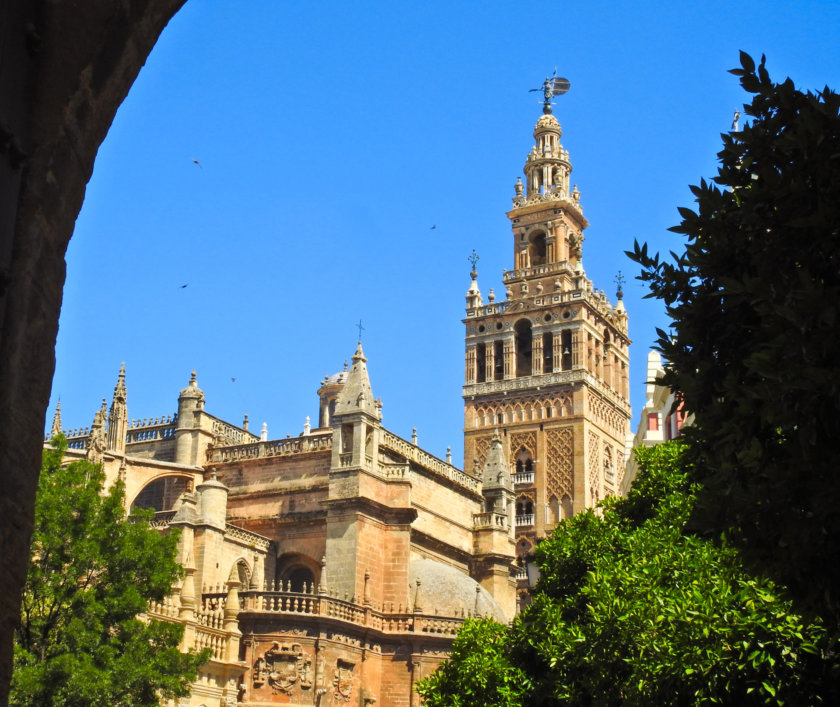
Once you’re done, here is how you can spend the rest of your day:
- First, go to the General Archive of the Indies to have a look inside. It’s located right next to the Cathedral and entrance is free.
- Take a walk in Santa Cruz neighborhood, where most historical monuments are located
- Stop by the Plaza del patio de Banderas and enjoy a nice view over the cathedral.
- Discover the stunning Plaza de España, One of the most beautiful squares I’ve ever seen. You have to check it out during your 4-5 days trip to Andalucia!
- Take a stroll in Maria Luisa park . With its shaded paths and numerous fountains, it’s a great spot to get some fresh air and calm. At the southern end of the park, you’ll find The Plaza America and 2 museums: the Archaeological Museum and the Museum of popular Arts and Traditions.
- In the evening, enjoy Spanish cuisine in a tapas bar, with, of course, a glass of Sangria!
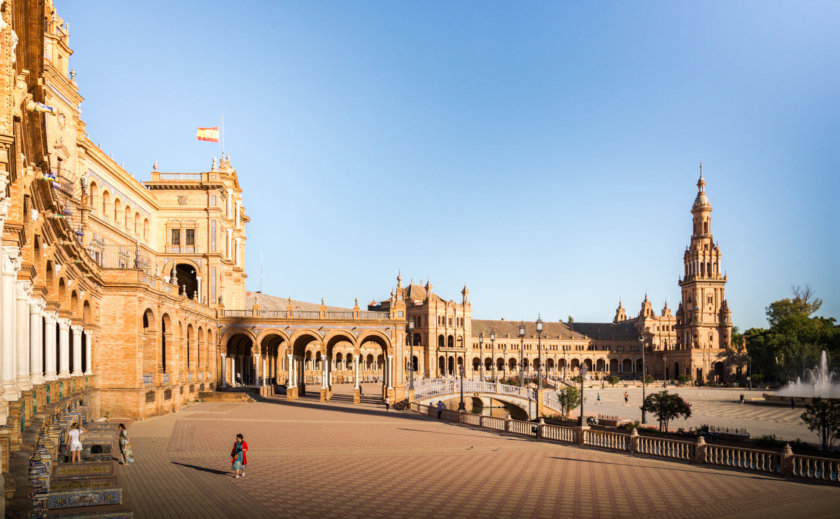
The next day , stay in Seville and finish visiting the city on foot.
Here are the best things to do during your 2nd day in Seville:
- Start with The Alcazar of Seville . You’ve probably seen it the day before, as the entrance is located right next to the cathedral. There is usually a long waiting line here too, so you should book your skip the line tickets in advance. It’s simple, just click here! Allow a full morning to visit the palace and its gardens.
- Visit the Casa de Pilatos , also located in Santa Cruz neighborhood. This palace has a large patio and 2 beautiful (small) gardens.
- What about taking a dip in your hotel’s swimming pool to cool off?
- The Metropol Parasol: head there at sunset time, you’ll enjoy one of the best scenic view over Seville.
- In the evening, you should attend a flamenco show . It’s one of the best thing to do during a 4-5 days trip to Andalucia. There is a great show at the Museum of Flamenco Dance. You need to buy your tickets here.
You will find every information you need to visit Seville in my article: The 15 best things to do in Seville.
If you don’t want to (or can’t) walk for too long, you can visit the city with the hop-on hop-off buses : they stop at almost every points of interest.
In Seville, the Hop-On Hop-Off bus ticket also includes 3 short guided tours of:
- The Plaza de España
- The Santa Cruz district
- The Triana neighborhood.
- Black Swan Hostel : Youth hostel located within 10 minutes walking distance from the Cathedral and the Alcazar. Very stylish and contemporary dormitory bed from 17€ per night, breakfast included! Strong points: the relaxed atmosphere, the friendly staff, the free dinners cooked by volunteers. This is the best choice if you are looking for a youth hostel.
- Hotel Don Paco : Located in the centre of Seville, at 10 minutes on foot from the Cathedral. Spacious room and comfortable bedding from 60€ per night, breakfast at 10€. Strong points: excellent breakfast, the peaceful atmosphere and the swimming pool on the roof. My favorite in Seville for its great value for money!
- Hotel Fernando III : Located in the historic district of Santa Cruz and therefore close to the Cathedral and the Alcazar. Modern and spacious room from 106€ per night, breakfast included. Strong points: the excellent location, the pool on the roof, the very helpful staff.
- EME Catedral Hotel: Located right next to the Cathedral and the Giralda. Very modern double room from 180€ per night, breakfast at 20€. Strong points: The best location in town, the hotel design, the swimming pool with the view on the Cathedral, the amazing breakfast, the very helpful staff. Don’t hesitate, it’s the best luxury hotel in town!
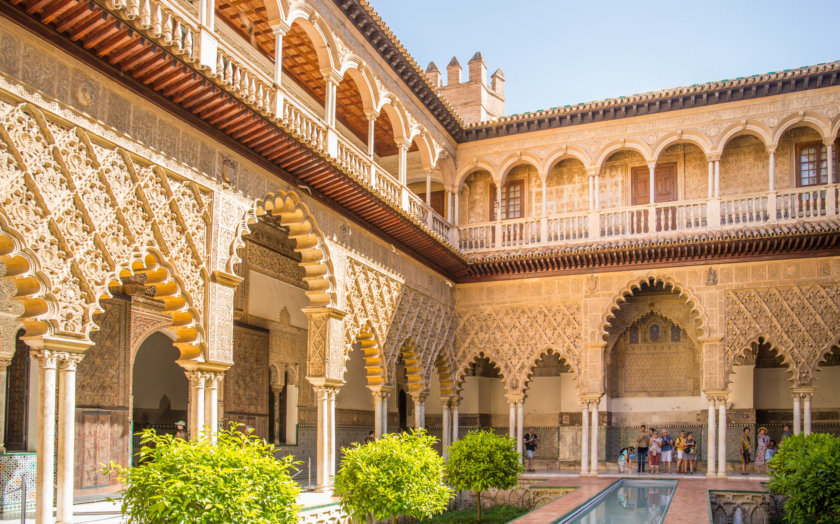
On this third day of your 4-5 days Andalucia itinerary, let’s go to Cordoba !
It’s still not necessary to rent a car yet, as the city is easily accessible by train , in only 40 min. There’re several daily departures.
You should still book your tickets in advance , just to make sure you’ll have seats for the departure time you want. It’s especially needed if you travel to Andalucia during high season.
Cordoba train station is only 15min walking from the historic center . You will walk through a big park, so it’s quite nice!
You will enter the old town by the Almodovar gate , the entrance to the Jewish quarter. From there you will easily reach the most visited site of the city: the mosque-cathedral of Cordoba. The interior, with its white and red arches, is very impressive.
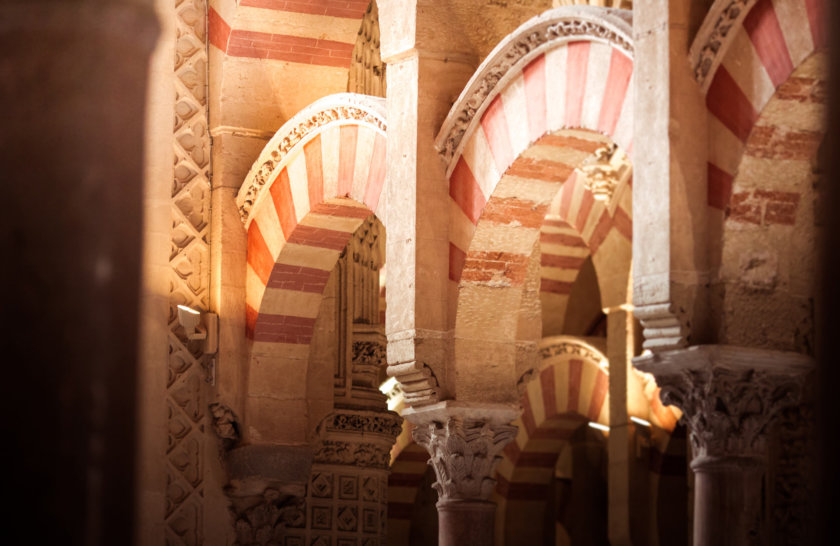
For your lunch break , you should definitely go to one of the 2 main squares of the city , where many restaurants are located: The Plaza de las Tendillas or the Plaza de la Corredera. Either will be a great option for lunch, and you should still go see both because they are very different.
In the afternoon, go for a walk along the Guadalquivir river until the Puerta del Puente and the Roman bridge. Then, cross the bridge to reach the Calahorra tower . It’s possible to go up the tower to enjoy a nice view.
Finally, come back to the other side of the river and head to the Alcazar de los Reyes Cristianos , the last visit of the day. It’s smaller than the one in Seville, yet its gardens are just as beautiful and even better maintained. Take a stroll in the shaded paths around the flower beds, and fountains, sit down on one of the benches and just relax a bit!
Depending on the departure time of your train to go back to Seville, go back to the train station or spend a bit more time strolling around the old town.
You want to learn more about the best things to do in Cordoba? Have a look at my article: Visit Cordoba: the definitive guide
If you want to learn everything about the history of the Mosque-Cathedral of Cordoba and the Alcazar , you should book a guided tour.
They need to be booked in advance here:
- Mezquita guided tour
- Alcazar guided tour
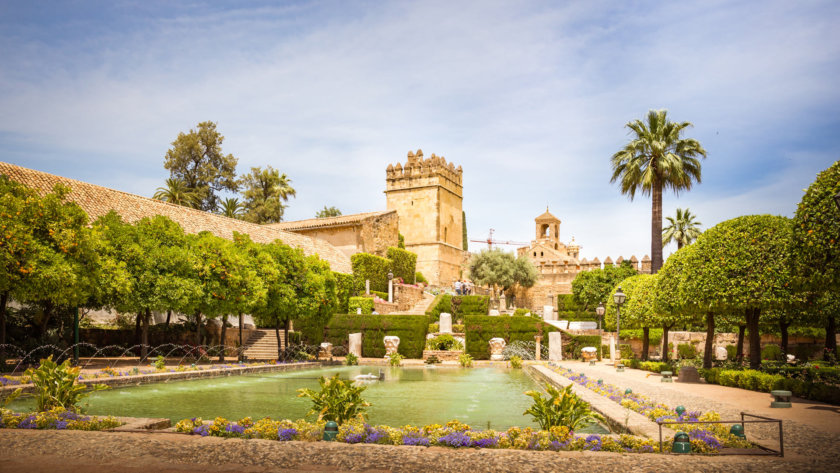
Day 4: Cadiz
For the 4th day of your 4-5 days stay in Andalucia , let’s head to Cadiz.
The city, less known than Seville or Cordoba, is an excellent day trip destination from Seville.
By car (more info about renting a car in Andalucia below), it will take around 1h20 . If you prefer to go by bus or train , both trips take about 1h45 and tickets are around 15€.
Once in Cadiz, Here is my recommended itinerary to visit the city on foot:
- Start at the Plaza de San Juan de Dios
- Pass by the Roman theater (free entrance)
- Visit Cadiz cathedral and go up the bell tower to enjoy the view
- Stop by Cadiz market for your lunch break.
- Go up the Tavira tower, the room equipped with a set of optical lenses and mirrors allows you to enjoy the view over the whole Cadiz bay.
- Go on a walk next to the sea along the Campo del Sur until San Sebastian castle
- Pass by Caleta beach, and maybe take a dip!
- Discover the Castle of San Catalina
- Go for a stroll in Genoves park and Alameda Apodaca park
- End your day in Cadiz at the Plaza de España de Cadiz
You can find detailed information about Cadiz in my article: The 12 best things to do in Cadiz .
At the end of the day, you can either go back and spend one last night in Seville or stay in Cadiz to enjoy the city a bit more.
Here is my selection of the best hotels in Cadiz, depending on your budget:
- Cadiz Inn Backpackers : Hostel located 10 minutes’ walk from the Cathedral. Bed in dormitory from 14 € per night. strong points: its roof terrace and the staff welcoming.
- Hotel La Catedral : As the name suggests, it’s located right next to the Cathedral. Modern and elegant room from 60 € per night, including breakfast. I have a big crush for the rooftop terrace with an outdoor pool and breathtaking views of the cathedral! This is my favorite in Cadiz for its great value for money!
- Parador de Cadiz : Located in front of the ocean and 5 minutes’ walk from the beach of La Caleta. Very nice modern and bright room from 138 € per night, breakfast included. Strong points: outdoor pool with nice views, quality of service, well-equipped rooms, original and modern architecture. It’s the best hotel in town, perfect for a luxury stay in Cadiz!
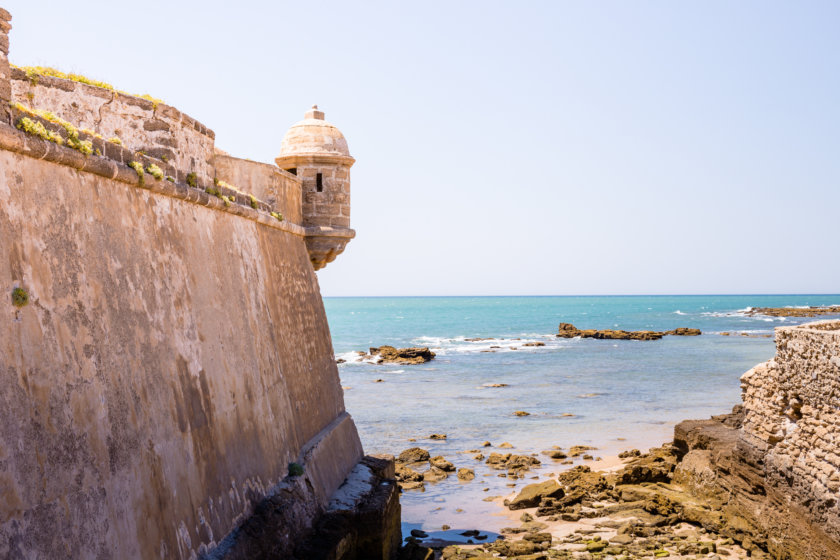
Here we are, it’s the fifth day of your 5 days trip to Andalucia!
If you slept in Cadiz, go back to Seville to take your return flight. If you’re already in Seville, enjoy your last moments in the city.
Depending on the time of your return flight, you can take a last stroll in Seville around Triana neighborhood , the Torre del Oro (“Tower of Gold” in English) and along the Guadalquivir river for example.
Now you know all the best things to do during a 4-5 days trip to Andalucia from Seville!
If you’re staying only 4 days in Andalucia, you can skip one of the day trips to Cordoba or Cadiz.
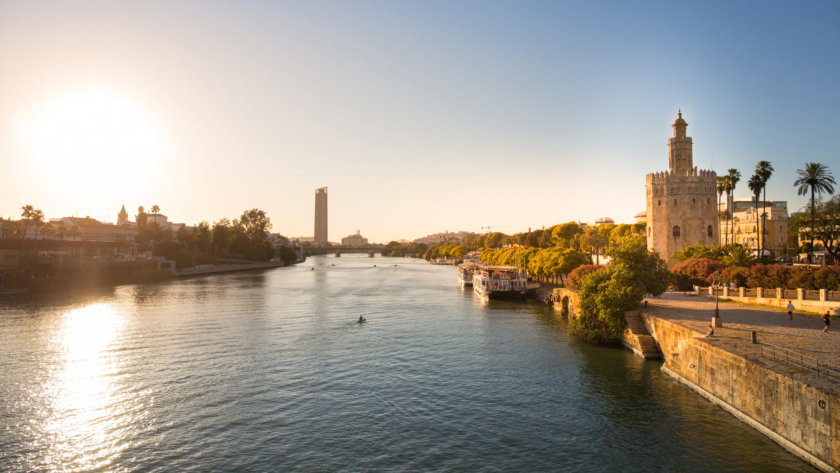
4-5 days itinerary in Andalucia from Malaga
For this second 4-5 days road trip in Andalucia , you will need to arrive at Malaga international airport.
During this trip, you will visit Malaga and its surroundings as well as Granada .
1) Malaga (2 days)
Here are my recommendations for your first day in the Costal del Sol’s capital:
- First, reach Gibralfaro castle by bus. It offers an amazing scenic view over the city!
- Then go downhill to the Alcazaba, the second must-see attraction in Malaga. This fortress-palace has stunning gardens, patios and fountains.
- Pass by the Roman Theater, the entrance is free! And it’s located very close to to the Alcazaba’s exit.
- Lunch break
In the afternoon, maybe you can visit one the 30 museums of the city.
Here are the best ones in the Andalusian capital, you can choose 1 or 2 depending on your interests:
- Picasso Birthplace Museum (get you tickets here) : where he was born in 1881. You’ll learn more about his life and will see some of his personal belongings on display.
- Picasso Museum , with more than 200 artworks from the world famous artist
- Carmen Thyssen Museum and its extensive collection of Spanish and Andalusian paintings
- Automobile Museum Malaga , housing 85 perfectly renovated vintage cars.
- Pompidou Centre Malaga , a branch of the famous Pompidou Centre in Paris
- Russian Art Museum offers a collection of Russian art pieces in an old tobacco factory
- Museo de Malaga
- Flamenco Art Museum
For most of them, it’s easier to buy your tickets in advance . You can do it by simply clicking on the museum’s name on the list above.
Depending on the museum you choose to visit, don’t forget to stop by (before or after the museum) Malaga Cathedral . Its 87 meters high tower is one of the highest of Andalucia, you can even go to the top and enjoy the view from there.
At the end of the afternoon, you can head to the closest beach : Malagueta beach.
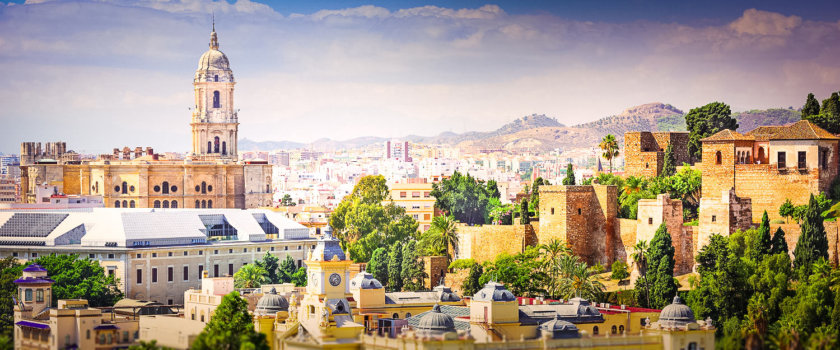
For your 2nd day in Malaga, you will have 3 options
1) keep discovering Malaga on foot:
- Visit another museum
- Pass by the Atarazanas market
- Have lunch in a tapas bar
- Walk around Soho neighborhood, famous for its street art
- End your day at La Concepcion Botanical Garden, one of the largest garden in Spain and even in Europe. To get there, take the bus #2, get off at the last stop and walk for another 15min to reach the entrance.
If you want more details about the best things to do in Malaga , you should read my article: Visit Malaga: the definitive guide .
2) If you like hiking , then you should definitely go to the Caminito del Rey.
This hiking path was for a long time considered the most dangerous one in the world . No worries however, it has been completely secured, rearranged and is now 100% safe!
The path goes along the cliff, 100 meters above the ground. I hope that you won’t get afraid of heights halfway because once you’ve started the hike, you can’t go back. The path is only one way.
If you’re not sure you can do it by yourself, the best is to hire guide : you’ll feel more secure and you’ll also learn many facts about the location and its history. These guided hikes are very popular so you need to book them in advance. Book your guided hike to the Caminito del Rey here.
You can go to Caminito del Rey with a rental car (see the section “How to rent a car in Andalusia” below or you can book a day-tour from Malaga. Fare includes transportation and hiking with a guide. You need to book it there.
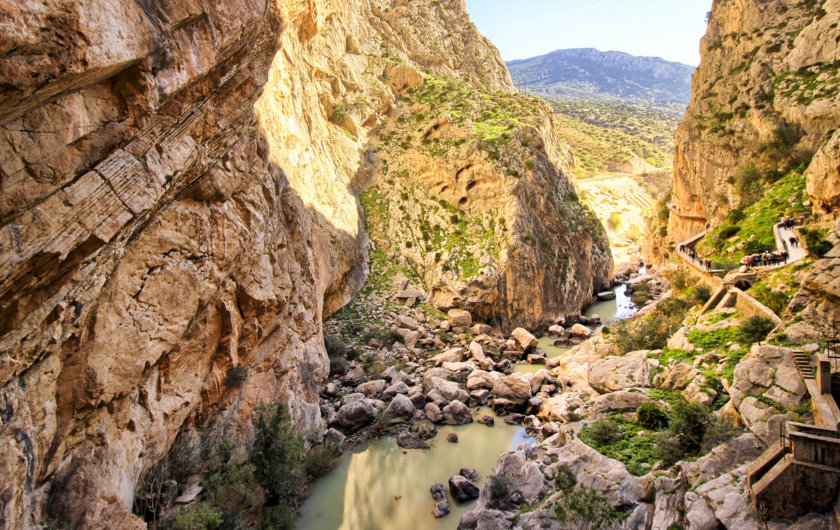
3) Visit Ronda , one of the most touristic villages in Andalucia.
You may not have heard of Ronda, but you probably saw pictures of its emblematic bridge . It’s a super photogenic spot, one of the region’s symbols.
To snap the perfect picture, go to the Plaza Maria Auxiliadora and then go down the path located on the right.
As the village is built on a hill, you can also go to the mirador and enjoy the amazing view over the whole valley!
For the rest of the day, simply go for a stroll in the narrow streets of Ronda . You can for example visit the bullfighting arena , Mondragon palace or La Casa Del Rey Moro.
It takes about 1.5hours to go to Ronda from Malaga. To get there, you will have 2 choices:
- Book a day tour from Malaga
If you choose the organized day trip, fare includes transportation, a guided tour of Ronda and the bullfighting arena + visit of a wine cellar . You can book it here.
You will find every information you need to visit Ronda in 1 day in my article: The 10 best things to do in Ronda.
Spend one last night in Malaga.
To visit Malaga, you should definitely get the Malaga Experience Card.
it includes the hop-on hop-off bus ticket + free entrance to most museums + a 1 hour boat tour + a ticket to see a flamenco show.
You need to book it here.
- The Lights Hostel: This hostel located 400 meters from the cathedral. A bed in a dorm starts from 20.50€/night with a breakfast at 1.50€. Strong points: clean, nice rooftop, very friendly staff.
- Ibis Malaga Centro Ciudad: Located next to the cathedral and 5 min from the Picasso museum. Modern double room (typical style of this hotel chain) starting from 65€/night, breakfast for an additional 7.95€. Its best features: very central location to visit Malaga on foot, many breakfast options. friendly staff. It’s my favorite hotel for its exceptional value for money!
- Barceló Malaga: located 10 min walking from the historic quarter and 600 meters from the Center for Contemporary Art. Comfortable and design room starting from 135€/night, breakfast for an additional 18€. Best features: Rooftop pool, location, beds are very comfortable. It’s a great place to stay in Malaga.
- Gran Hotel Miramar: This 5 stars hotel is located 10 meters away from the Malagueta beach. Very elegant and beautifully decorated room, starting from 250€/night, breakfast for an additional 25€. Its best features: the decoration of the hotel and the rooms is truly stunning, the pool, the Spa, the breakfast is delicious. The best choice for a luxury stay in Malaga!
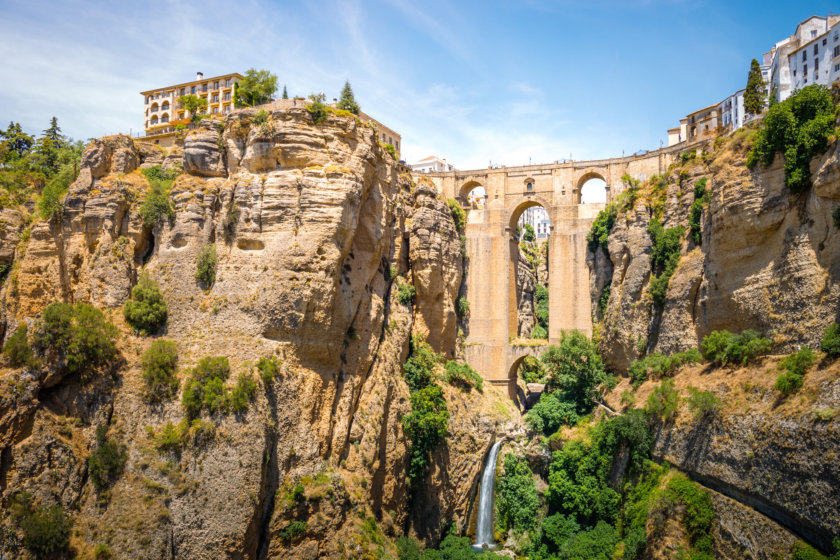
2) Granada (2 days)
It’s time to start the 2nd part of your 5 days stay in Andalucia! Today, you will leave Malaga and head to Granada.
The trip lasts about 1h40 . You can rent a car to get there or go by train (the 1h45 ride costs 12€).
Once in Granada here is my recommended itinerary for your first day:
- Discover the interior of San Juan de Dios Basilica
- Visit the cathedral and the royal chapel
- Have lunch on Plaza Bib Rambla
- Go shopping in the surrounding commercial streets
- Stop by the Alcaicera market
- If you want, visit the ancient Arab baths .
- Go up the mirador de San Cristobal or the mirador de San Miguel Alto to watch the sunset.
Spend the night in Granada.
On the following day, you will visit the Alhambra , a must see during your 4-5 days trip to Andalucia!
It’s the most visited tourist site in Spain. Each day, thousands of tourists come to visit this beautiful fortified Moorish palace.
In order to manage the site better, there is a limited amount of tickets sold per day . So it’s essential to book your tickets in advance online here . And when I say in advance, I mean weeks or even months in advance! I’m not joking, if you don’t do it, you may not be able to visit the site.
There are 3 sites to visit in the Alhambra:
- Nasrid palaces
- The Generalife
- The Alcazaba
Make sure that your ticket includes all 3 sites . Some tickets don’t!
The best way to visit the Alhambra is clearly to do a guided visit. It will also allow you to skip the (very long) waiting line! You need to buy your guided tour here.
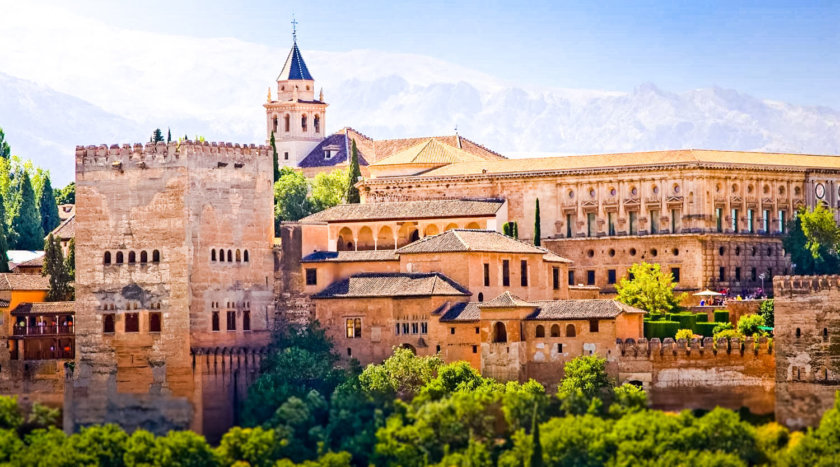
Visiting the Alhambra will probably take you the whole morning. Afterwards, enjoy your lunch break and then head to the Sacromonte district, the former gipsy neighborhood.
There, you will be able to visit curious troglodyte homes: the cuevas . Nowadays, most of them host flamenco dance shows.
If you want to learn more about the history of this neighborhood, you should visit the Cuevas del Sacromonte museum . Tickets need to be bought here.
After visiting the Sacromonte , let’s go to the other historic neighborhood of Granada: the Albaicin district . They are located right next to each others, so it’s very convenient to visit everything on foot.
Take some time to wander around this authentic and charming neighborhood with its many small shops. It has a kind of Arabic souk vibe!
There are many monuments to check out in the Albaicin district:
- San Nicolas Church
- Dar-al-Horra Palace
- The Corral del Carbon
- The plaza Nueva
- The Santa Ana Church
- The puertas de la Murallas
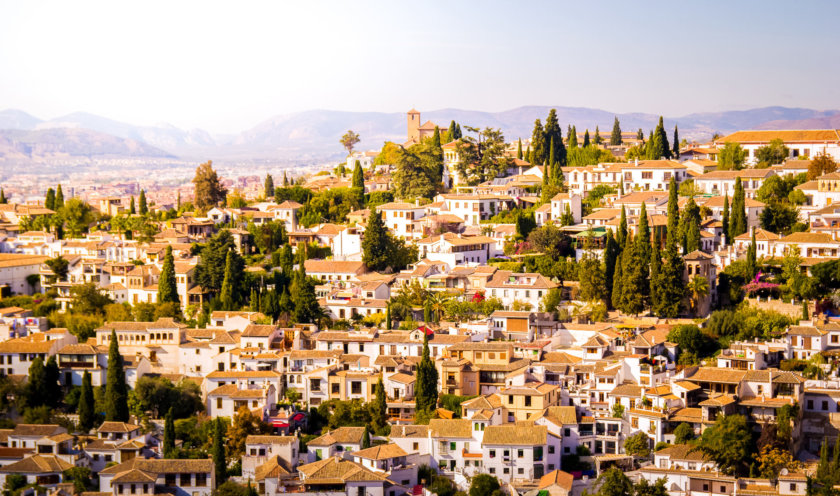
At the end of the day, a bit before sunset, you should go to San Nicolas mirador and enjoy the view over the Alhambra.
Then, for a typical Andalusian night , go see a flamenco show . As I was saying above, they are taking place in cuevas. The most famous one is La Cueva Los Tarantos .
Los Jardines de Zoraya is also a very popular venue in Granada.
Spend a second night in Granada.
For more information to visit Granada, you should read my detailed guide: The 15 best things to do in Granada.
To visit Granada , I really recommend getting the Granada Card .
It includes most attractions entrance tickets such as the Alhambra , the cathedral and the royal chapel . The great thing is that this 3-days pass also includes free public transports.
It’s clearly the best City Pass!
- Granada Inn Backpackers: Hostel located 10min away from the Cathedral and 20min from the Alhambra. One bed in a dorm starting from 16€ per night, breakfast included. Best features: the beautiful patio, the location, the very friendly staff.
- Hotel Universal: Located 400m from the Cathedral and 700m from the Albaicin neighborhood. Clean and comfortable double room starting from 65€ per night, breakfast included. What I loved: the friendly staff, the central location close to stores and restaurants. It’s my favorite hotel in Granada for its amazing value for money!
- Granada Five Senses Rooms & Suites: Located on Gran Via avenue, 200m away from the Cathedral. Design and modern room starting from 100€ per night, breakfast included. Strong points: the rooftop pool, the rooms decoration, the generous breakfast.
- Alhambra Palace: This 5 stars hotel is located 10min walking from the Alhambra or the Albaicin neighborhood, next to the Carmen de Los Martires garden. Cozy and spacious room starting from 200€, with an additional breakfast for 19€. Its best features: the Moorish-inspired decoration, the splendid view over the Alhambra from the terrace, the overall comfort. It’s my favorite hotel for a romantic gateway in Granada!
- Parador de Granada: This luxury hotel is located within the Alhambra itself! The rooms are a mix of modern design with touches of antiques elements, starting from 420€ per night, with an additional breakfast for 21€. What I loved: The exceptional location, the overall atmosphere, very helpful staff, the restaurant with a view over the Generalife. This is the best hotel for a luxury stay in Granada!

Today is the fifth day of your 4-5 days Andalucia itinerary.
It’s time to go back to Malaga.
Depending on the time of your return flight, you can enjoy the city and/or the beach one last time.
Now you know the best 4-5 days Andalucia itinerary from Malaga!
If you’re staying only 4 days in Andalucia, spend one day less in Malaga.
If you want to rent a car for your trip, you should use Booking.com Cars website. It’s the one I always use, whether I go to Spain , Sicily , Greece or any country.
It’s my favorite for the 3 following reasons:
- It’s perfect to compare prices between all rental agencies. You can also read customer reviews and make an informed decision.
- If you want to travel with the peace of mind, you can opt for the “full protection” insurance . With it, you’re 100% sure to be fully refunded in case of any damage or even theft. Tested and approved, they have refunded me more than 1200 euros to date!
- Most of the time, you can cancel or modify your booking for free.
And you know the best? They offer the “best price guarantee” : if you find the same car cheaper elsewhere, they will refund you the difference!
If you already know the travel dates of your 4-5 days itinerary in Andalucia, you should book your rental car now to get the best prices. And if you ever change your mind, it’s alright because modifying or cancelling your booking is free.
Click on the button below to compare rental cars prices in Andalucia:
Flight prices to Andalucia vary greatly, so it is a good idea to compare them as soon as possible. To do this, you can use our flight comparator, in partnership with Skyscanner . You will be sure to get the best price!
If you want to rent a boat for a nice day at sea during your itinerary in Andalucia, you should book it with Samboat.
Motorboats, sailboats, yachts, small boats without a license, with or without a skipper: they simply have the most complete offer for boat rental!
So, what are you waiting for to book your sea trip in Andalusia? 😊
If you have any question to plan your 4-5 days Andalucia itinerary, don’t hesitate to ask me in the comments. I will gladly help you!
Andalusia travel Guides
- Buy the DK Eyewitness Andalusia guide on Amazon.com or on Amazon.co.uk
- Buy the Lonely Planet Andalusia guide on Amazon.com or on Amazon.co.uk
- Buy the Rick Steves Snapshot Andalusia guide on Amazon.com
Discover all my articles about Spain : All my articles to help you plan your trip to Spain are listed there.
- Cadiz: The 12 things you must-see in town!
- Cordoba: Top 15 best things to do and must-see attractions
- Granada: Top 15 best things to do
- Malaga: The 15 best places to visit
- Ronda: The 10 best things to do
- Seville: Top 15 best things to do and places to visit
You’re using Pinterest? Here is the picture to pin!
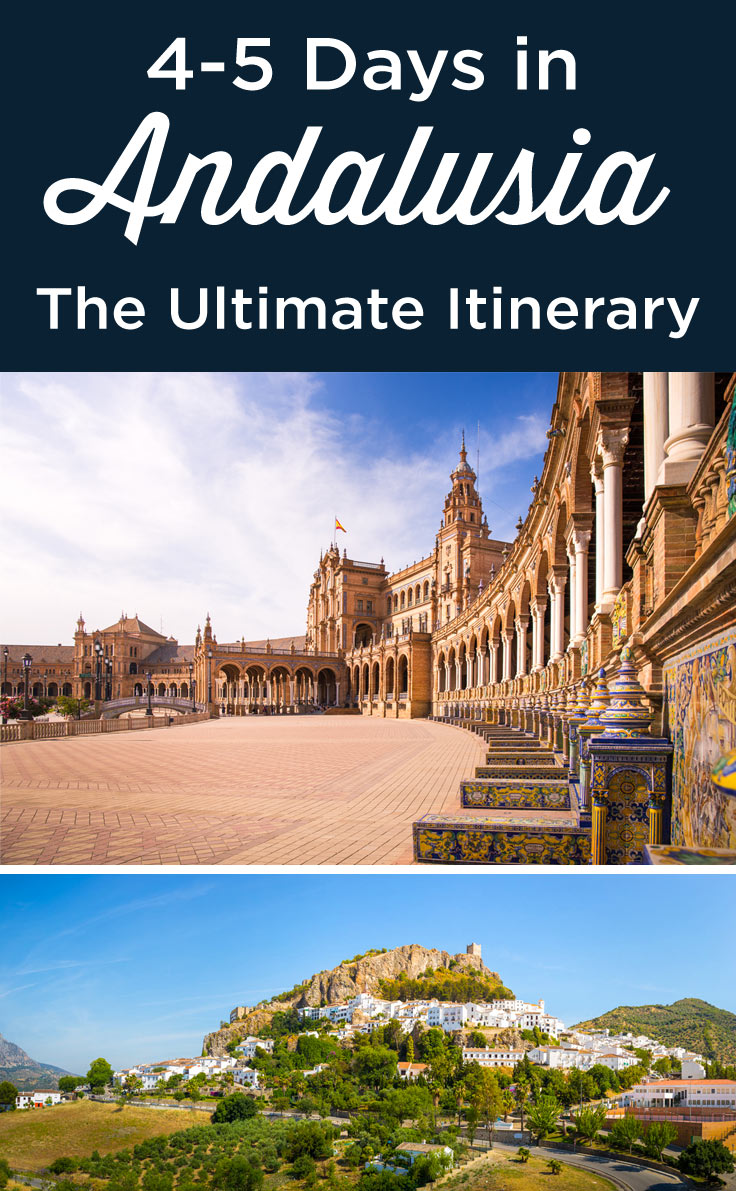
Creator of the Voyage Tips blog, travel and photography lover. I give you all my best tips to plan your next trip.
Related Stories
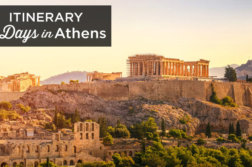
3 Days in Athens: The Perfect Itinerary (First Time Visit)
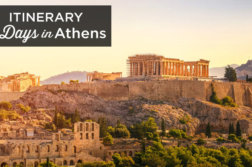
2 Days in Athens: The Perfect Itinerary (First Time Visit)
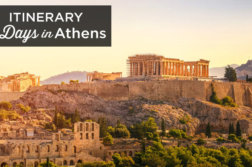
4 Days in Athens: The Perfect Itinerary (First Time Visit)
Discussion 15 comments.
Excellent Information I have 3 nights in Andalucia coming from Lagos Portugal. I have to fly out of Barcelona to get back home in Canada. Do you think using Seville as a base and doing one long day trip to Granada would be my best itinerary?
I would arrive in Seville at about 1pm and would leave on day 4 to Barcelona so I can quickly see Barcelona for 2 days. Seems to me its either Seville or Malaga as the base. If its Malaga, then Granada is doable but not Seville. Just wondering what you think are the best two places to focus on given my short time.
Thanks Frank
Hello Frank,
For your itinerary in Andalucia, yes you have 3 choices:
1. Stay 3 nights in Seville: you can visit Seville for 2 days and do a day trip to Cordoba (only 40 minutes away by train).
2. Stay in Malaga: you can visit Malaga, and then Granada as a day trip. You can also go to Ronda or hiking on the Caminito del Rey.
3. Doing Granada as a day trip from Seville is doable too, just not very convenient, as it’s a lot transports and it would be a bit rushed in my opinion. It’s however the only solution if you absolutely want to see the Alhambra of Granada and Seville.
If you don’t plan to come back to Andalucia, and you’re ready to do at least 5 hours of transport, you can do it. Seville and Granada are the 2 must-see cities of the province.
If however you want to come back, it’s better in my opinion to opt for solution 1 or 2.
To help you to decide which cities are the best for you, you can read my articles about Seville, Cordoba, Malaga, Granada y Ronda by clicking on the link below: Visit Andalucia: all the travel guides
And if you need more information about Barcelona, I can help you too. I have wrote an article but it’s unfortunately only in French for now.
Enjoy your trip!
This is one of the best guides Ive read about touring Andalucia. Its comprehensive, detailed and covers all the right spots.
Im visiting Andalucia in october arriving in Malaga. Id like to go to Ronda, Sevilla, Cadiz, Cordoba & Granada as well. I have 9 days/8 nights to do so which is perfect if I blend your two 4-5 days guide.
However Im having a hard time putting it all together. Can you guide me?
Also will there be time to visit any white villages while driving in between cities?
Thanks so much!!!
Hello Carmela,
Thank you for your kind comment. I’m glad my travel blog is helping you to plan your trip!
For your 9 days in Andalucia, I would suggest you the following itinerary:
– Day 1: Depending on when you will land, you can start to visit the city a bit- Night in Malaga. – Day 2: Road to Ronda (1h15) – Visit Ronda – Go to Zahara de la Sierra (it’s a beautiful white village – 40 min from Ronda) – Night around Zahara or you can directly go to Seville (1h20) – Day 3 and day 4: Visit Seville – Stay 2 nights in Seville. – Day 5: Go to Cordoba and visit the city – Stay one night. – Day 6 and 7: Go to Granada and visit the city – Stay 2 nights. – Day 8 and 9: Go to Malaga and visit the city
I haven’t included Cadiz in this itinerary, as I think it would be too much for 9 days. It’s, in my opinion, better to focus on the other cities!
But if you really want to see Cadiz, you can go there the day after Zahara de la Sierra. Then, after Cadiz, you can go to Seville.
However, this would mean you will have one day less in another place. It’s up to you.
To plan your visit to the city, I recommend you to read my articles about Malaga, Ronda, Cadiz, Sevilla, Cordoba and Granada. You can find them here (click on the link): Destination Andalucia.
If you have other questions about your trip to Andalucia, don’t hesitate!
Thanks so much!!! for such fast reply! The itinerary looks good. I’ll have to do it counter-clock though, since I need to make a short stop in Nerja first. As I will arrive in Malaga at 10am I will have the first day to stroll around the city so I could take a day off from Malaga and visit Cadiz. However, you are right. I am too inclined into cutting it out in favor of a longer stay and getting more from each city.
Another reason to forgo Cadiz is the chance to visit some of the smaller towns. Ive made a short list of my favorites and they happen to fall in the driving path from one city to the next. For example: Nerja, Frigiliana and Salobreña on my way from Malaga to Granada. Then Priego de Cordoba (for a taste of the best olive oil in the world) and Zuheros on my way to Cordoba. Almodovar del Rio and Ecija or Carmona on my way to Sevilla. Zahara, Olvera and Ronda. And finally Mijas right before getting back to Malaga. Is this doable or too ambitious? How long would you say it takes to visit these small towns? Should I cut them off too?
Sorry for the long post! Will wait for your feedback. Thanks again
Yes, it’s definitely better to avoid Cadiz if you want to add a few villages between the city.
You can easily go to Nerja, Frigiliana and Salobrena on your way to Granada.
Between Granada and Cordoba, if you want to visit Priego and Zuheros, you will not have so much time to visit Cordoba. These small towns are not on the main road, so the journey time quickly adds up.
Between Cordoba and Seville, the best is to do Almodovar + Carmona or Ecija + Carmona, but again, you will have less time to visit Seville, so it’s really as you prefer!
For Zahara, Olvera and Ronda, no problem, it’s doable.
If you want to go to Mijas after Ronda, you will have to take the longer road (2 hours driving instead of 1h30).
So, visiting all these small towns is doable but it will be more tiring as some of them aren’t on the main road. You will spend more time driving, and a lot of them are quite similar (even if all beautiful!)
Enjoy your trip 🙂
Perfect. Will take your advice. Thanks for the input Vincent! And congratulations again for the blog. Looking forward for you to add more destinations!
You’re welcome!
I am really glad my blog is helping you to plan your trip to Andalucia.
I will definitely add more destinations, I already have a lot more in French, translations are just lagging a bit behind. I will do my best 🙂
Enjoy your trip and maybe see you again on the blog!
Hi! I care for views, gastronomy and meeting locals. I will be arriving to Seville and spending 4 days but want to travel to other parts, maybe for 1 full day or 1 day and a half. Where would you recommend? And any guide tours you recommend?
Hello Kitty,
If you want to do a day trip around Seville during your 4 days in Andalucia, you will have the choice between Cordoba, Cadiz or Ronda.
From Seville, there are guided tours to these 3 cities (click on the link below to see the details and book it): – Cordoba Full day tour – Cadiz and Jerez de la Frontera day trip – Ronda and the white villages – Full day trip from Seville
Enjoy your trip to Andalucia!
Thanks Vincent. Great article, very informative.
Would you recommend going to Marbella at all if staying in Malaga? We’re planning on going during Summer. If so whats your recommendation there apart from just going to the beach?
Many thanks.
Thank you! I’m glad that my 4-5 days itinerary in Andalusia helps you organise your stay.
Marbella is only 1 hour’s drive from Malaga, so it’s possible to spend a day there. But apart from enjoying the beach there’s not much to do or see. It’s mainly a seaside resort where people come to party at night and go to the beach during the day. I couldn’t really tell you more about Marbella as I haven’t been there as it’s not really the kind of place and atmosphere I look for when travelling.
Enjoy your trip to Andalusia and Malaga!
The itinerary looks amazing! Do you think it would be doable to visit Seville, Cordoba, and Granada (with the possibility of visiting Ronda as well) in 6 days and 5 nights? Would it be possible for you to give a rough itinerary for these places? I would appreciate it so much!
For your 6-day itinerary in Andalusia, you can spend 2 days in Seville, 1 day in Cordoba and 2 days in Granada. On the sixth day, you can return from Granada to Seville. You can make a diversion to visit Ronda on this day, but only if you have a car (and this will still add 1 hour 20 minutes to your journey).
If you’d like more information on places to visit in Granada and Ronda, you can read my other articles here: – What the best things to do in Granada? – What to do in Ronda?
Enjoy your trip to Andalusia!
Thank you so much for this. I will start planning now.
I appreciate it so much!! Very helpful!!!
Leave A Reply Cancel Reply
Your Name (required)
Your Email (required)
Your Website (optional)
Save my name, email, and website in this browser for the next time I comment.
- Middle East
- North America
- Cheap car rentals: my best advice
- Back to Homepage

- Extended Tours
- Walking Tours
- Shore Excursions
- CUSTOM TOURS
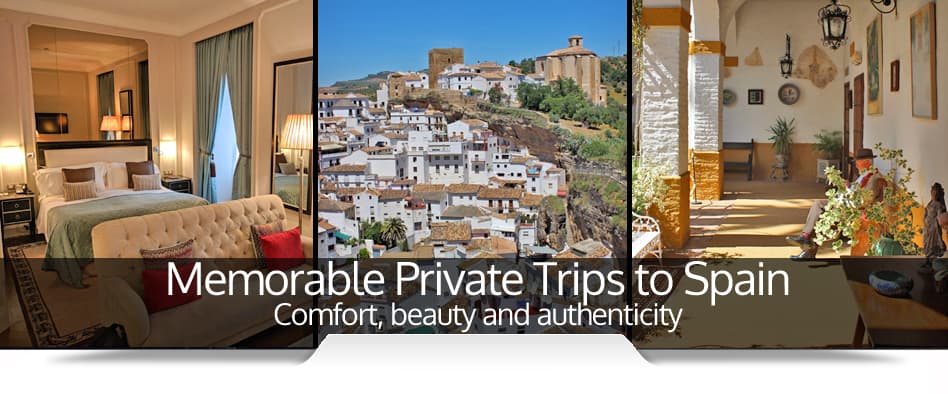
Let yourself use a Spain Trip Planner. Let us show you Andalusia
Genuine andalusia is a spain travel planner holding the key to a memorable vacation to andalusia and beyond. a trusted, awarded and caring travel advisor crafting some of the best spain vacation itineraries for very small private groups since 2013..
Allow yourself the peace of mind to have a destination expert plan your dream trip to Southern Spain. Allow us the joy and the honour to welcome you in our homeland like an old friend. You will have all your needs and wishes carefully catered for, while you enjoy a Spain trip of a lifetime
Let yourself use a Spain vacation planner. Let us you show Andalusia.
Start now planning your dream trip to southern spain, new: spain travel advisory 2024 and etias europe, culture and lifestyle tours.
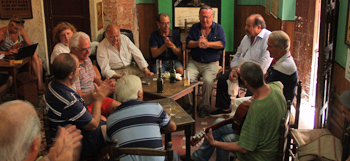
Immerse yourself into our living traditions. Discover our long and colourful history. See its footprint in our lifestyle and be amazed by the unique architecture of our towns.
Food and Wine Tours

Come and experience with us the joy of our vibrant markets and tapas bars, learn the art of Spanish cooking and discover our ancient and modern wine scenes.
Outdoors and Nature Tours
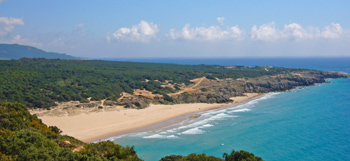
Venture into nature with us and see our whitewashed villages, cycle along former railways, hike through lost valleys and sail legendary waters.

EXTENDED TOURS
- Walking the GENAL VALLEY
- The ROMANTIC TRAVELERS in ANDALUSIA
- The WONDERS of CADIZ
- The SHERRY TRIANGLE
- Seville to CORDOBA
- Moorish RONDA
- The WHITE VILLAGES up on the hills
- CADIZ and JEREZ de la Frontera
- GRANADA and the Alhambra
- VEJER de la Frontera and Cape TRAFALGAR
- JEREZ vineyards and SHERRY bodegas
- Three towns, three treats: SHERRY, CHEESE and SWEETS!
- Spanish FOOD AND WINE WORKSHOP
- Cadiz bay SAILING TOUR
- Colonial CADIZ
- Hidden gems of SEVILLE
WALKING TOURS
- SEVILLE World Heritage Sites
- CORDOBA Jewish quarter and Mosque
- GRANADA Alhambra and Generalife
- CADIZ and the Americas
- JEREZ old town for foodies
- SEVILLE behind the scenes
SHORE EXCURSIONS
- Malaga SHORE EXCURSIONS
- Cadiz SHORE EXCURSIONS
CONTACT & LEGAL
Genuine Andalusia Memorable Private Tours Jerez de la Frontera and Seville South West Spain
Tel and whatsapp: +34 655232132 Email: [email protected] skype: genuine.andalusia
Travel Agency. License number C.I.AN-116540-2
- Cookie Policy
Privacy Policy
Legal Notice
- Privacy Overview
- Strictly Necessary Cookies
- 3rd Party Cookies
This website uses cookies so that we can provide you with the best user experience possible. Cookie information is stored in your browser and performs functions such as recognising you when you return to our website and helping our team to understand which sections of the website you find most interesting and useful. You can see our privacy policy .
These are our strictly necessary cookies for navigation
asp_transient_id Provider: genuineandalusia.com Type: HTTP Duration: Session Purpose: unique identification of the user session.
CookieConsent Provider: genuineandalusia.com Type: HTTP Duration: 1 year Purpose: it stores the user's cookie consent for the present domain.
rc::a Provider: google.com Type: HTML Duration: persistent Purpose: this cookie is used to distinguish between humans and bots. This is beneficial for the web in order to elaborate valid reports about the use of our site.
rc::b Provider: google.com Type: HTML Duration: session Purpose: this cookie is used to distinguish between humans and bots.
rc::c Provider: google.com Type: HTML Duration: session Purpose: this cookie is used to distinguish between humans and bots.
If you disable this cookie, we will not be able to save your preferences. This means that every time you visit this website you will need to enable or disable cookies again.
This website uses Google Analytics and Hotjar to collect anonymous information such as the number of visitors to the site, and the most popular pages.
Keeping these cookies enabled helps us to improve our website:
_ga Provider: genuineandalusia.com Type: HTTP Duration: 2 years Purpose: this cookie registers a unique identification used to generate statistical data about how a visitor uses the website.
_gat Provider: genuineandalusia.com Type: HTTP Duration: 1 day Purpose: this cookie is used by Google Analytics to control the rate of requests.
_gid Provider: genuineandalusia.com Type: HTTP Duration: 1 day Purpose: this cookie registers a unique identification used to generate statistical data about how a visitor uses the website.
_hjAbsoluteSessionInProgress Provider: genuineandalusia.com Type: HTTP Duration: 1 day Purpose: this cookie is used to count the number of times that a website is visited by different users. This is done by assigning a random ID to each user so that they are not counted as a different user every time they access the site.
_hjFirstSeen Provider: genuineandalusia.com Type: HTTP Duration: 1 day Purpose: this cookie is used to determine whether a visitor is new or not (has visited the website before).
_hjid Provider: genuineandalusia.com Type: HTTP Duration: 1 year Purpose: this cookie sets a session ID. This allows the site to obtain data about the behaviour of the visitor for statistics purposes.
_hjid Provider: genuineandalusia.com Type: HTML Duration: persistent Purpose: this cookie sets a session ID. This allows the site to obtain data about the behaviour of the visitor for statistics purposes.
_hjIncludedInPageviewSample Provider: genuineandalusia.com Type: HTML Duration: 1 day Purpose: This cookie is set to let Hotjar know whether that visitor is included in the data sampling defined by the site’s pageview limit.
Please enable Strictly Necessary Cookies first so that we can save your preferences!
More information about our Cookie Policy

CHARLIES WANDERINGS
THE TRAVEL BLOG FOR HIKING LOVERS AND EFFICIENT TRAVEL ITINERARIES

Spain · April 21, 2024
The Best 7 Day Andalusia Travel Itinerary
If you’re looking for the ultimate travel itinerary for your holiday in Andalusia in Spain, then you’ve come to the right place! This incredible region in the southern part of Spain is perfect for a self-drive holiday and I am 100% sure you’ll have the best time exploring these drop dead gorgeous places.
Andalusia is home to some of the most diverse landscapes in Europe and a region rich in culture and history. It is the largest autonomous community in Spain and is famed for its vibrant traditions, including flamenco music and dance, bullfighting, and spectacular festivals.
Andalusia has a profound historical legacy , having been influenced by various cultures over the millennia, including Phoenicians, Romans, Visigoths, Moors, and Christians. This mix has left a lasting imprint on the architecture and urban planning, with notable examples like the Alhambra in Granada , the Mezquita in Córdoba , and the Seville Cathedral and Alcázar.
This 7 day Andalusia itinerary is perfect for the efficient traveler who loves to visit as many places as possible during their holiday !

How to get to Andalusia
Getting to Andalusia, located in the southern part of Spain, is straightforward, thanks to its well-developed transport infrastructure. Here are the main ways to reach this vibrant region:
- International and Domestic Flights – Andalusia is served by several airports, with the main hubs being Seville Airport (SVQ), Málaga-Costa del Sol Airport (AGP), and Federico García Lorca Granada-Jaén Airport (GRX). Málaga is the busiest, offering numerous international and domestic flights, making it a convenient entry point for travelers coming from both within Spain and abroad.
💡 TIP – We chose the international airport in Malaga as point of entry since often these flight tickets are cheaper compared to flying to Sevilla.

How to get around Andalusia
- High-Speed Rail – Spain’s high-speed train network, AVE (Alta Velocidad Española), connects Madrid to major Andalusian cities like Seville, Málaga, and Córdoba with fast and efficient service.
- Regional Trains – For those traveling from other regions of Spain, regular trains provide good connectivity to various parts of Andalusia.
- Major Highways – Andalusia is well-connected by a network of major highways. The A-4 motorway runs from Madrid through Córdoba to Seville, while the A-7 and E-15 connect along the Mediterranean coast through Málaga and onward to Algeciras.
- Scenic Routes – Driving to Andalusia offers the flexibility to explore the region’s diverse landscapes and picturesque “white villages.”
🚘 I always use SunnyCars when booking a rental car cause their company policy makes me feel the most at ease.

The Best 7 Day Andalusia Itinerary

Day 1 – Arrival
Like I said before we chose to fly into the international airport of Malaga and made the decision to skip Sevilla for now and keep it for a future city trip.
We arrived in Malaga late in the evening, so after picking up our rental car we headed straight to our hotel Hotel La Bobadilla in Villanueave de Tapia.
When mapping out our itinerary I decided to stick to maximum two different places to stay. Since we were traveling with our 7 month old baby I didn’t want to unpack and pack every 2 days.
So for the first half of the trip we stayed at Hotel La Bobadilla in Villanueave de Tapia. In my opinion the perfect base to visit Cordoba , Granada and the surrounding pueblos blancos .

Day 2 – Cordoba
The city of Cordoba is a historic gem in the heart of Andalusia, where ancient streets whisper secrets of Roman and Moorish pasts. As you wander through the city, prepare to be dazzled by the star attraction: the Mezquita , a colossal mosque-turned-cathedral that boasts a forest of columns and arches in candy-cane hues.

Don’t miss the chance to lose yourself in the charming patios of Córdoba, flower-adorned sanctuaries that burst into a kaleidoscope of colors during the famous Patio Festival. Stroll next to the river and admire the Roman bridge from Cordoba.
📖 READ MORE – 9 Very Best Things To Do In Cordoba, Spain

And make sure not to forget visiting Alcázar de los Reyes Cristianos ! This majestic fortress-palace, once the residence of Christian Kings, is a testament to the city’s historical significance, with its imposing walls, regal towers, and exquisite Moorish-inspired gardens.
🅿️ PARKING – If you’re visiting Cordoba by car you can park at Parking la Mezquita de Córdoba or at Parking Centro Histórico.

💡 TIP – Only 30 minutes driving from Cordoba, you’ll find one of the most epic castle in entire Spain! Castillo Almodovar del Rio, also known as Highgarden in Game Of Thrones !

Day 3 – Iznajar & Antequera
Both Iznajar and Antequera are some of the most beautiful white villages in Andalusia and must-sees on your Andalusia travel itinerary. Both villages are close to Villanueva de Tapia and only 30 minutes driving from Hotel La Bobadilla .
I recommend starting with Iznajar since it’s on the smaller side. The highlights here are centered around the Patio De Las Comedias where you’ll find over 700 beautifully decorated flower pots hanging from the white washed walls.

Antequera is a picturesque town that serves as a living museum, where every street and building tells a story. The crown jewel of Antequera is its UNESCO World Heritage-listed Dolmens—megalithic burial sites that are among the largest and most complex in Europe.
Beyond the ancient stones, the town’s skyline is dominated by the imposing Alcazaba of Antequera, a Moorish fortress that offers sweeping views of the surrounding countryside. Nearby, the Renaissance-style Collegiate Church rises majestically, showcasing Antequera’s religious and architectural grandeur.
🅿️ PARKING – Park your car at Carpark Antequera Centro S. L.

Day 4 – Granada
The city of Granada is nestled at the foot of the Sierra Nevada mountains and a treasure trove of historical gems and vibrant Andalusian culture. Start your adventure by stepping back in time at the Alhambra , a stunning palace and fortress complex that epitomizes Moorish art and architecture.

Wander through the aromatic streets of the Albaicín , the old Moorish quarter, with its white-washed houses and hidden courtyards. Make sure not to miss the Mirador de San Nicolás for the best views over Alhambra and the Sierra Nevada Mountains!
📖 READ MORE – 9 Very Best Things To Do In Granada, Spain

Other important landmarks not to miss are the Granada Cathedral and Royal Chapel, Plaza Nueva, El Bañuelo and Palacio Dar al-Horra.
💡 TIP – If you’re visiting Alhambra as part of a day trip like we did I recommend visiting the palace in the early morning so you have the rest of the day to explore the centre of Granada . Plus you can also leave your car at the Alhambra parking lot and simply walk down to the city center.

When driving back to Hotel La Bobadilla you should make a stop at Montefrio to watch the sunset. This stunning white village in Andalusia is home to one of the most beautiful viewpoints in the region and can be easily accessed as well! Simply drive to Mirador del Paseo and you’re there.

Day 5 – Colomares Castle
Today we’ll drive from Villanueva de Tapia to Estepona, our second hotel location in our Andalusia travel itinerary. For this area I chose to stay at the wonderful Kempinski Le Bahia , an amazing 5⭐️ luxury resort that is ideally located.

But before checking in you’ll drive by the spectacular Colomares Castle near Malaga. This isn’t your typical medieval fortress; it’s a fantastical tribute to Christopher Columbus and the discovery of America , complete with fairytale turrets, intricate mosaics, and hidden nooks that spark the imagination.
Nestled in the sun-drenched hills of Benalmádena , Colomares Castle is like a page from a storybook, inviting you to explore its unique blend of architectural styles that celebrate Spain’s rich heritage.
📖 READ MORE – Colomares Castle, Spain – All you need to know when visiting

DAY 6 – Ronda , Setenil de las Bodegas, Olvera & Juzcar
Today involves a lot of driving but this way you can check off some of the most beautiful white villages in Andalusia in a single day.
Ronda is without a doubt one of the most iconic villages in entire Andalusia thanks to the Puente Nuevo bridge , elegantly perched above the dramatic El Tajo gorge. After a 50 minute drive from Estepona you’ll arrive in the historic city center.

If you’re wandering through Ronda, make sure not to miss the Jardines de Cuenca, the Arco de Felipe V, Iglesia de Santa María la Mayor and La Ciudad District.
📖 READ MORE – 10 Very Best Things To Do In Ronda, Spain .
🅿️ IN RONDA – Park your car at Parking La Merced . If you’re visiting Ronda on a day trip make sure to arrive on time otherwise all of the public parkings will be full. We arrived in Ronda on a regular weekday around 9.30am and had no problem finding a parking spot. But by the time we left around 1pm all of them were full.

Only 20 minutes driving from Ronda, you’ll find another peculiar pueblo blanco in Andalusia – Setenil de las Bodegas.
This town is known for its distinctive architecture where houses are built directly into the rock overhangs above the Rio Trejo. Setenil offers a striking contrast with its homes seamlessly integrated into the natural rock formations, creating a dramatic and picturesque landscape.
The most visually striking part of Setenil can be found along the streets Calle Cuevas del Sol and Calle Cuevas de la Sombra , where the buildings are either bathed in sunlight or shaded, respectively.

The next town is also only 15 minutes driving. You’ll drive through the stunning Andalusian countryside and soon you’ll already see the church and castle of Olvera looming in the distance.
Make sure to pay a visit to Castillo de Olvera and to the Museo La Frontera y los Castillos . For €3 you get access to both attractions. You can buy your ticket at the visitor centre which is located next to the Iglesia de Nuestra Señora de la Encarnación .

The last stop of the day is one of the most unique places in Andalusia and a really special place in this Andalusia travel itinerary.
Juzcar used to be another white washed village, but not anymore. The inhabitants of Juzcar actually painted all of their houses bright blue as part of a marketing stunt for “The Smurfs” movie in 2011.
Part of the deal was that their houses would be restored in their original state but they saw such an influx of tourism that they decided to simply leave them blue. And not just that, since then they’ve added a ton of colorful murals.
💡 TIP – Follow the Cartoon Trail to find all of the murals – The map is located at the beginning of town.

Day 7 – Departure
Today it’s time for check out! Depending on the time of your flight you can relax a little longer at your hotel before you make your way to the international airport of Malaga.
The car rental return process went very smooth and I’ld say you need to be at the airport 2 hours before your flight leaves.
I hope this Andalusia travel itinerary gives you the inspiration you need to explore this incredible region yourself, and not just lay on the beach in Marbella.

The best time to visit Andalusia
The best time to visit Andalusia largely depends on what you’re looking to experience, but generally, the spring (April to June) and fall (September to November) months are ideal. During these times, the weather is pleasant, with mild temperatures perfect for exploring cities, enjoying the beaches, and participating in outdoor activities without the intense heat of the summer.
Spring brings vibrant festivals like Feria de Abril in Seville and blooming landscapes, while fall offers the grape harvest and beautiful autumn colors, especially in the northern regions.

All rights reserved © Charlies Wanderings. Republishing this article and/or any of its contents (text, photography, etc.), in whole or in part, is strictly prohibited.

Charlotte Lint is the founder, main photographer and writer of Charlies Wanderings . She has traveled all over the world and is based in Belgium where she also owns her very own dental practice. She is an expert on writing insightful hiking guides and creating unique and efficient travel itineraries . Every month she helps over 134.000 people discover the most beautiful places in the world through her detailed travel guides.
You’ll Also Love

Leave a Reply
You must be logged in to post a comment.
DESTINATIONS
TRAVEL ITINERARIES
TRAVEL WITH KIDS
Charlies Wanderings is a travel blog for unique travel itineraries and hiking guides with colorful photos and insightful travel info.
COPYRIGHT ©2024 CHARLIES WANDERINGS
Copyright © 2024 CHARLIES WANDERINGS Theme by 17th Avenue
Copyright © 2024 · Charlotte on Genesis Framework · WordPress · Log in
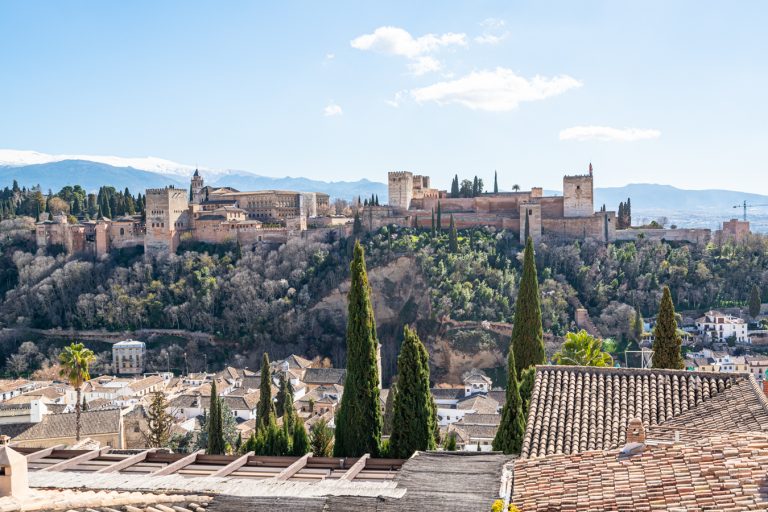
The Ultimate Andalucia Road Trip (Detailed Southern Spain Itinerary!)
Winding streets through whitewashed villages, the clink of tinto verano glasses scraping against tapas plates, sweeping views across gorges, endless sour orange trees, and 700-year-old palaces: these are just a few of the incredible things that you’ll find on an Andalucia road trip.
As Spain’s southernmost region, there are a downright overwhelming number of places to visit in Andalucia, ranging from whitewashed hilltop towns (pueblos blancos) to Mediterranean beaches to snowcapped mountains, and everything in between!
Planning a southern Spain itinerary can be tricky, if for no other reason than that it’s hard to narrow down exactly where to go.
After two long trips spent falling in love with the south of Spain, we’ve put together this road trip itinerary for Andalucia in the hopes that you come away loving it as much as we do (and avoid some mistakes that we learned the hard way).
If you’re ready to soak up the magic of Andalucia, this southern Spain road trip itinerary is for you!
Table of Contents
How We Structured This Southern Spain Itinerary
Renting a car for your andalucia road trip, can this andalucia itinerary work without a car, the ultimate southern spain road trip itinerary, other destinations to add to your andalucia itinerary, the best time to road trip andalucia, what to pack for a road trip in southern spain, andalucia road trip itinerary map.
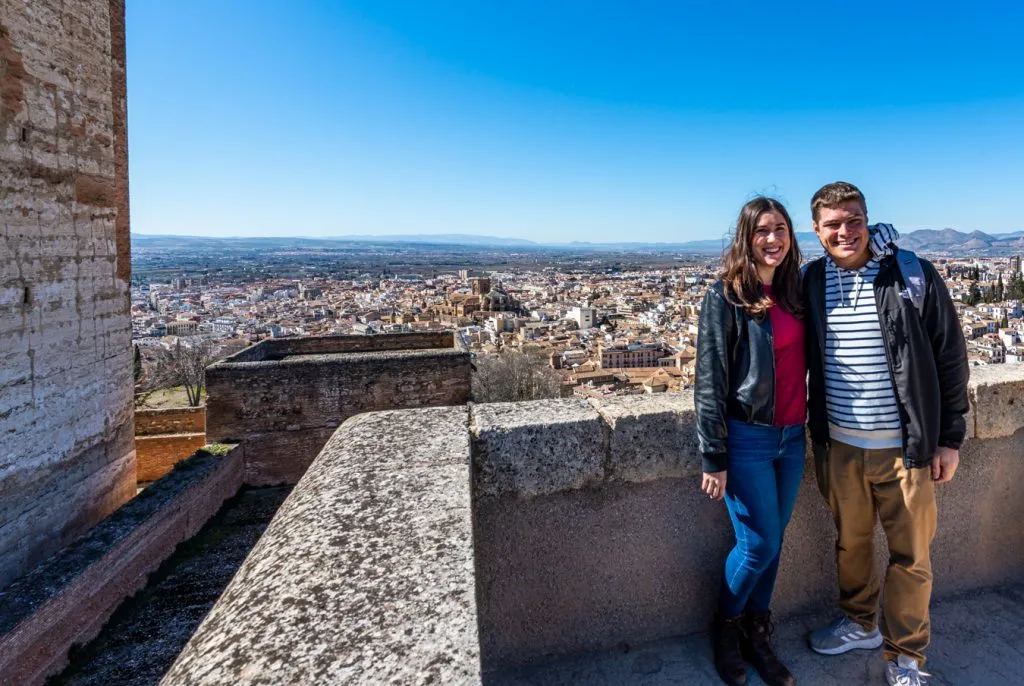
Some links in this post may be affiliate links. If you make a purchase through one of these links, we may earn a small commission at no extra cost to you. Please see our disclosure policy for more detail.
With a region as large and diverse as Andalucia, narrowing down the best places to visit on a 10 day southern Spain road trip is quite the challenge!
We structured this Andalucia road trip as a loop beginning and ending in Seville, home to one of the largest airports in the region.
Since it’s a loop, you can easily reverse this itinerary if you wish, or start in a different city (such as Malaga).
We designed this southern Spain itinerary around visiting whitewashed villages, historic cities, and stunning landscapes.
It’s a fairly fast-paced itinerary in the sense that it packs a lot in and involves visiting many beautiful towns, but to drive this route straight through without traffic would actually take less than 10 hours.
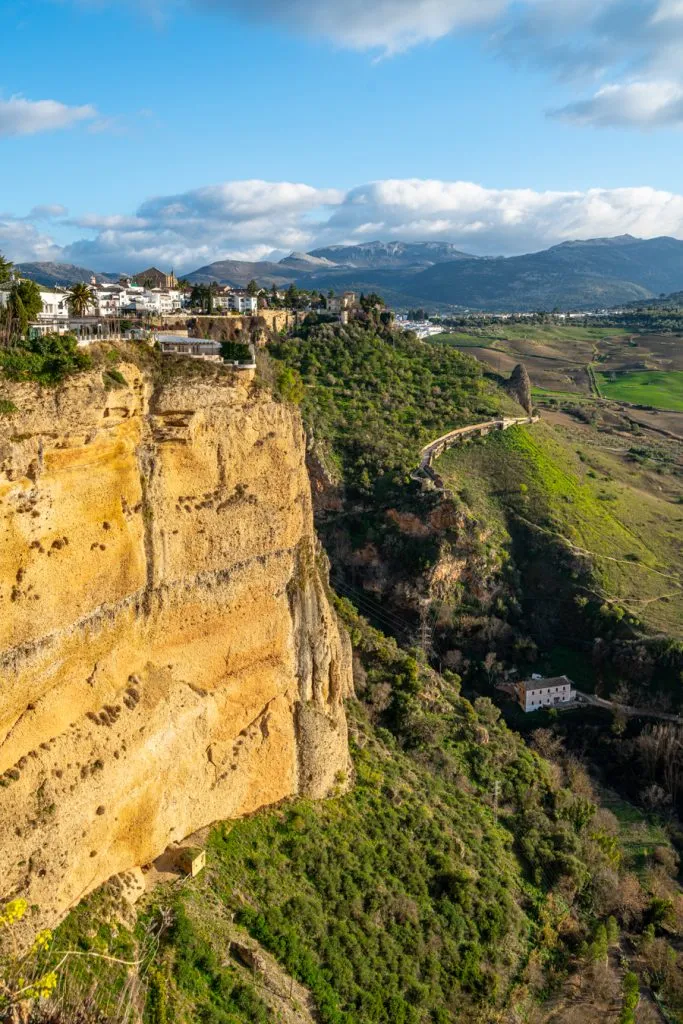
You’ll drive a bit more than that, counting day trips and such, but the bottom line is that it’s a very doable distance in 10 days!
We don’t dedicate much time to the famous Costa del Sol on this travel guide, as this is more of an enjoy-all-the-attractions itinerary rather than a relax-on-the-beach itinerary, but we do include a bit of time to soak up views by the Mediterranean as well.
In addition to the detailed 10 day southern Spain itinerary we’ve outlined here, we’ve also made notes of more incredible places to visit in Andalucia that you can add or swap in, depending on your travel style.
This guide to road tripping Andalucia is quite long, so feel free to use the table of contents above this section to navigate to the most important parts for you if you wish!
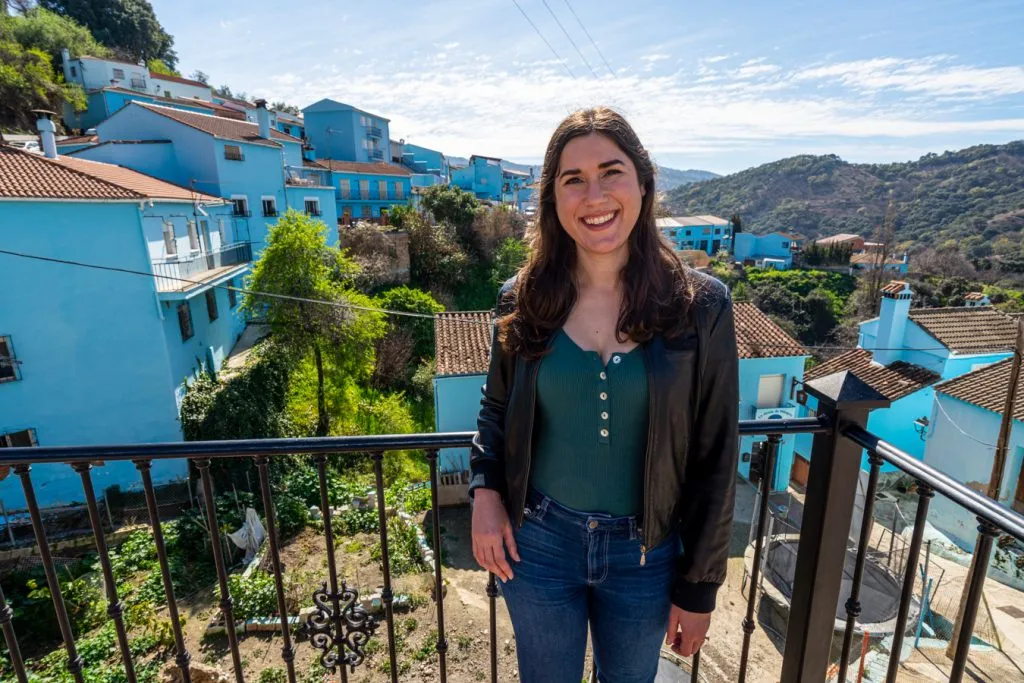
For most people, of course, taking an Andalucia road trip will require renting a car
We recommend renting a small car through Discover Cars , which will allow you to compare the prices and inclusions of multiple companies at the same time and choose the best car for you from there.
For the purposes of this southern Spain itinerary, we recommend picking up a car the morning you leave Seville.
There’s no reason to pick one up for your time in the city, as parking it will be a hassle and you won’t need it for exploring Seville.
Check rates and book your rental car today!
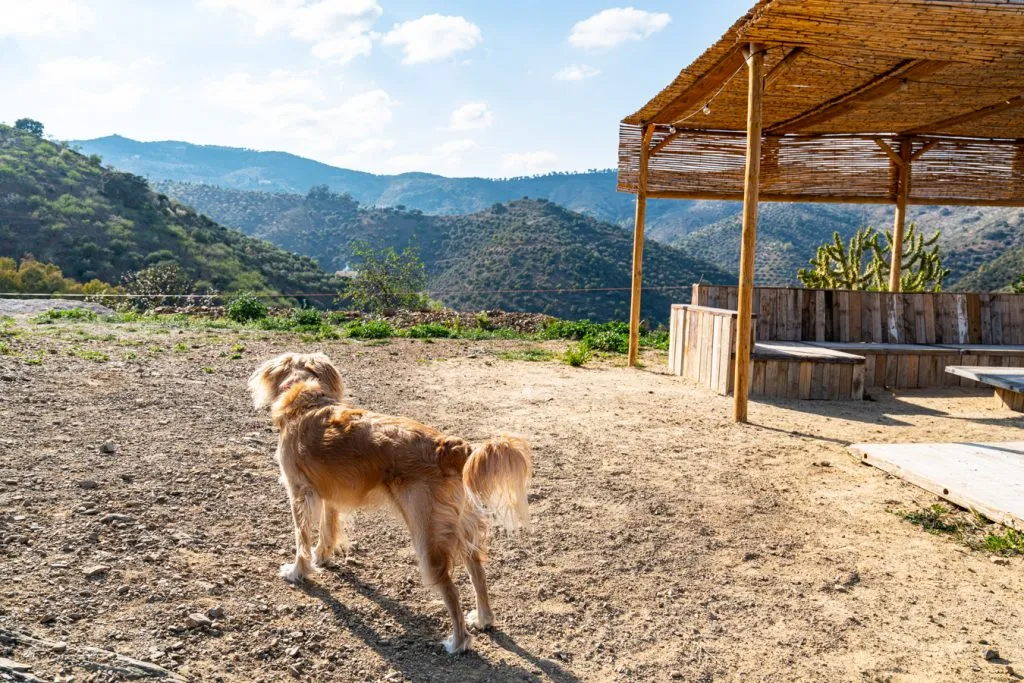
This southern Spain itinerary is specifically designed as a road trip, and we do strongly believe that driving is the best way to visit Andalucia!
From offbeat villages to charming hikes to out-of-the-way beaches, your trip to Andalucia will absolutely be enhanced by having your own set of wheels.
That being said, if you can’t or would rather not drive, you can still cover the vast majority of the sights included on this Andalucia road trip itinerary through a combination of public transportation and guided tours.
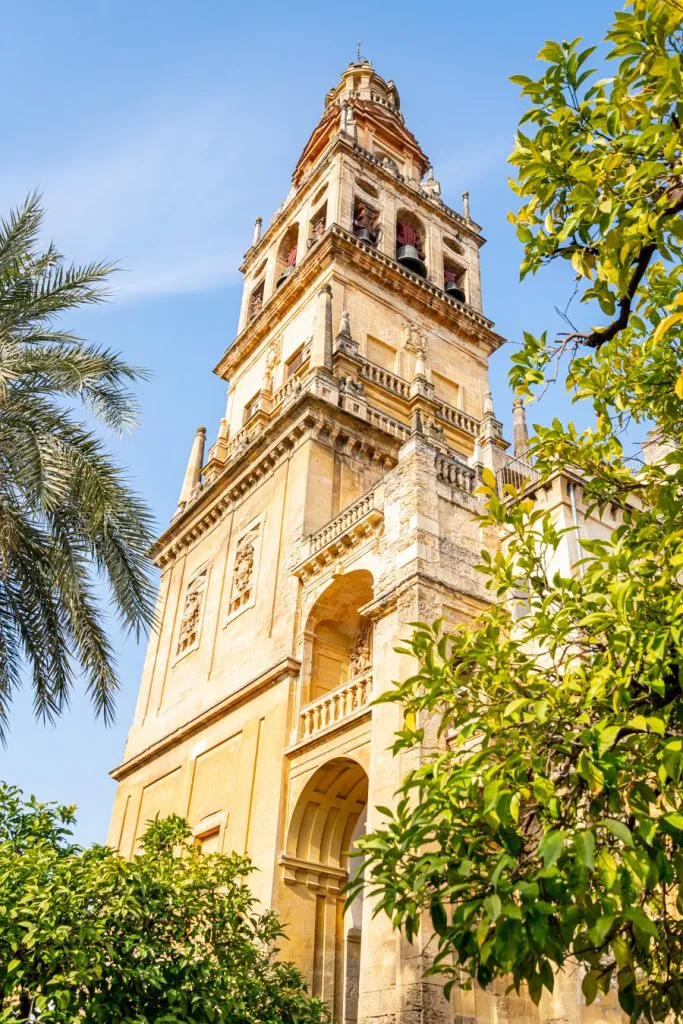
If you’re not planning to drive, we recommend basing yourself in larger cities like Seville, Granada, and Malaga, and taking day trips (independently, guided, or a combination of both) from there.
As much as we love Ronda, we wouldn’t recommend spending more than perhaps one night there without a car.
If you want to structure your itinerary for southern Spain without a car, we highly recommend using Omio to check exact ticket schedules and pricing for trains and buses in Andalucia!
Check schedules and shop train and bus tickets in Andalucia today!
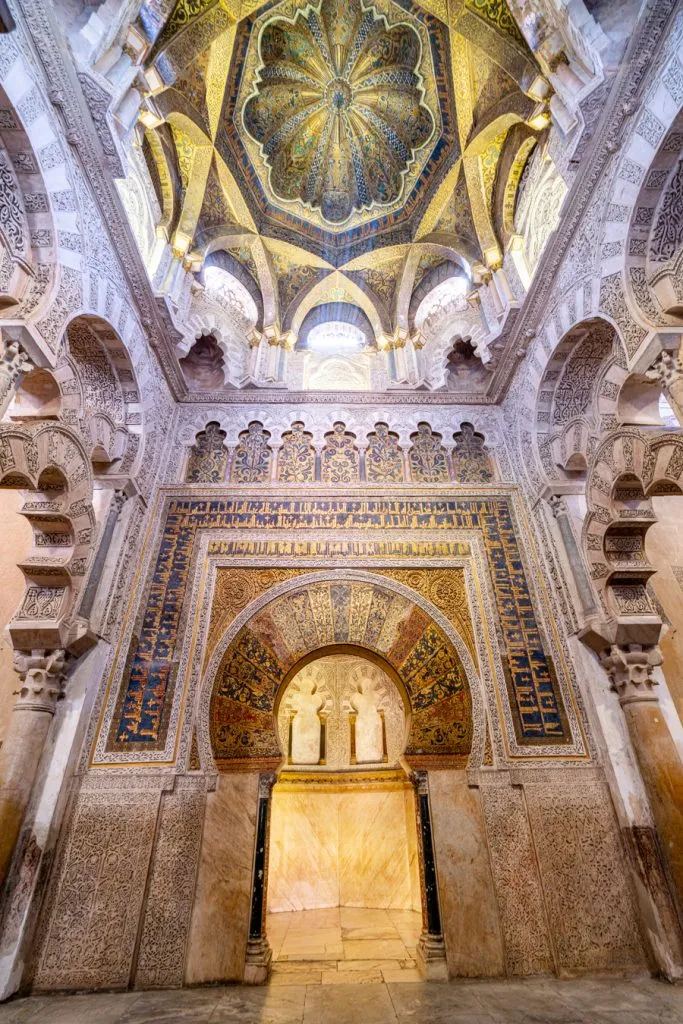
Day 1: Arrive in Seville and start exploring.
Starting your southern Spain travels in Seville means diving right into the heart of Andalucian culture!
Depending on what time your plane lands, kick off your Andalucia vacation with a visit to the Seville Cathedral–once the biggest church in the world–and a climb up its bell tower.
The Giralda (bell tower) not only includes a beautiful view but is part of Andalucian history.
Before the Reconquista (when Christian powers overtook the Moorish kingdom that once ruled this area), this bell tower was the minaret of a mosque on the same site.
When the sun starts to set, head out for tapas and tinto verano (similar to sangria, but less elaborate and beloved by locals).
We don’t recommend picking up your rental car until day 3 of this itinerary–you won’t need it when exploring the heart of Seville.
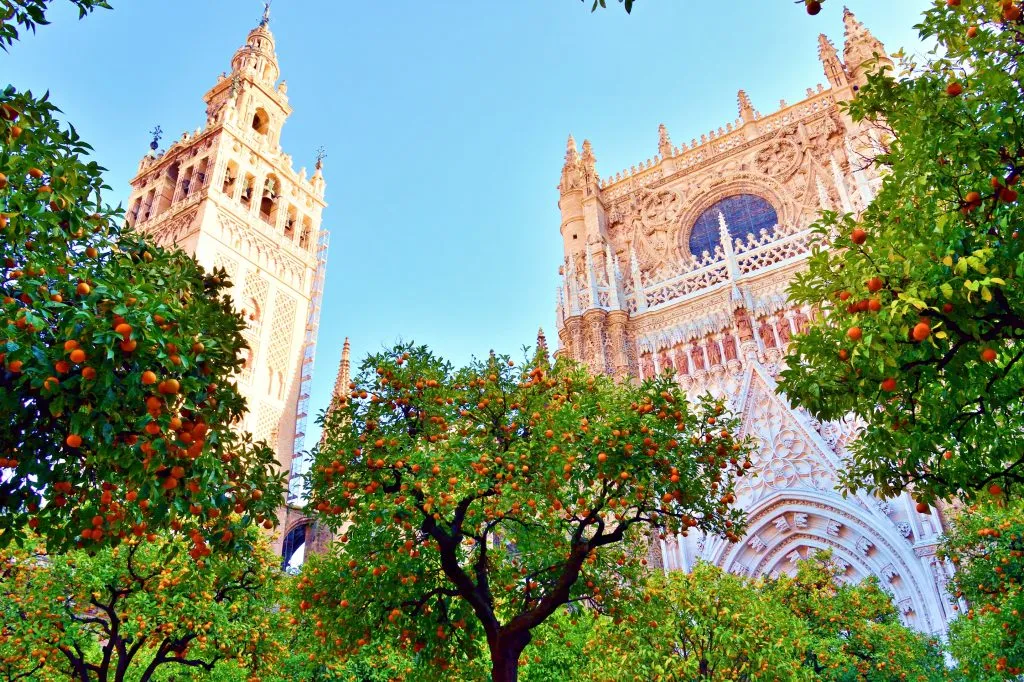
Where to Stay in Seville, Spain
When deciding where to stay in Seville, location is key as ideally, you’ll want to stay within walking distance of Seville’s best attractions.
We had a fantastic experience at Petit Palace Puerta de Triana on our most recent trip to Seville.
The hotel has a fantastic location (central but also quiet–a far from guaranteed combination in Spain), a delicious breakfast, and comfortable rooms.
Looking for something a bit different?
The incredibly popular Hotel Rey Alfonso X is an excellent choice, and their rooftop views are sublime!
If you’d like to stick to more of a budget, Hotel America Sevilla gets wonderful reviews and doesn’t sacrifice too much in terms of location.
Meanwhile, for the height of luxury, you can’t beat the absolutely stunning Hotel Alfonso XIII !
Check rates & book your stay in Seville today!
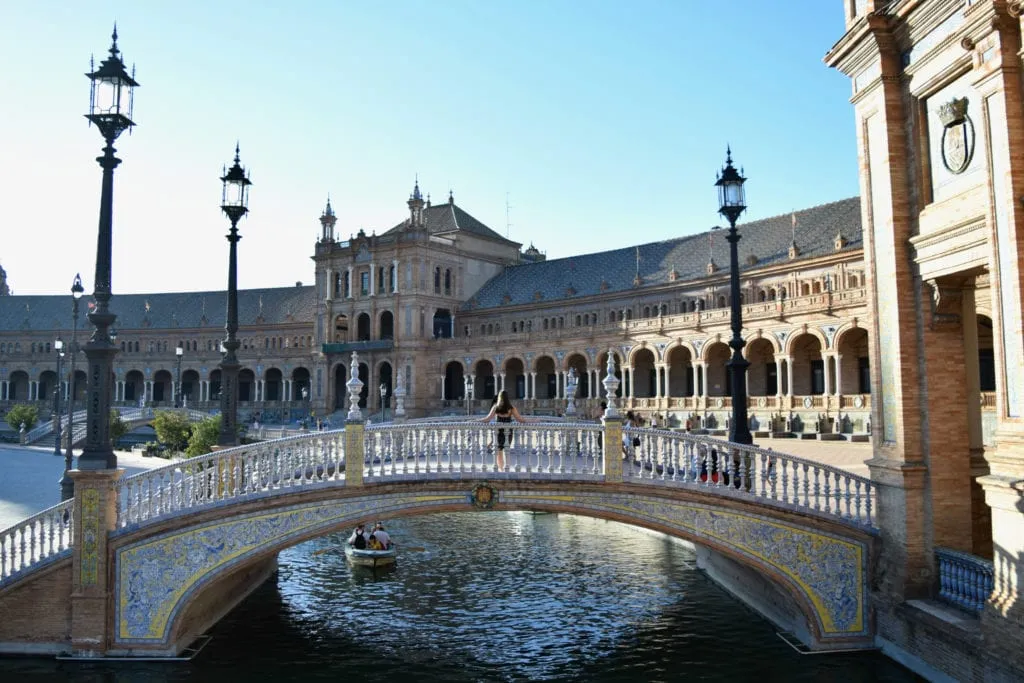
Day 2: Dive into Andalucian culture and history in Seville.
Today, it’s time to explore the rest of the major attractions in Seville!
Be sure to visit the famous Plaza de Espana, wander through the picturesque Barrio Santa Cruz (the former Jewish Quarter), and potentially see a Flamenco show .
Touring the gorgeous Alcazar is also a must: parts of this unique palace were built in the Moorish style, by Islamic craftsmen, for Christian rulers.
The result is a unique and beautiful combination of cultures that brings together several aspects of Andalucian history.
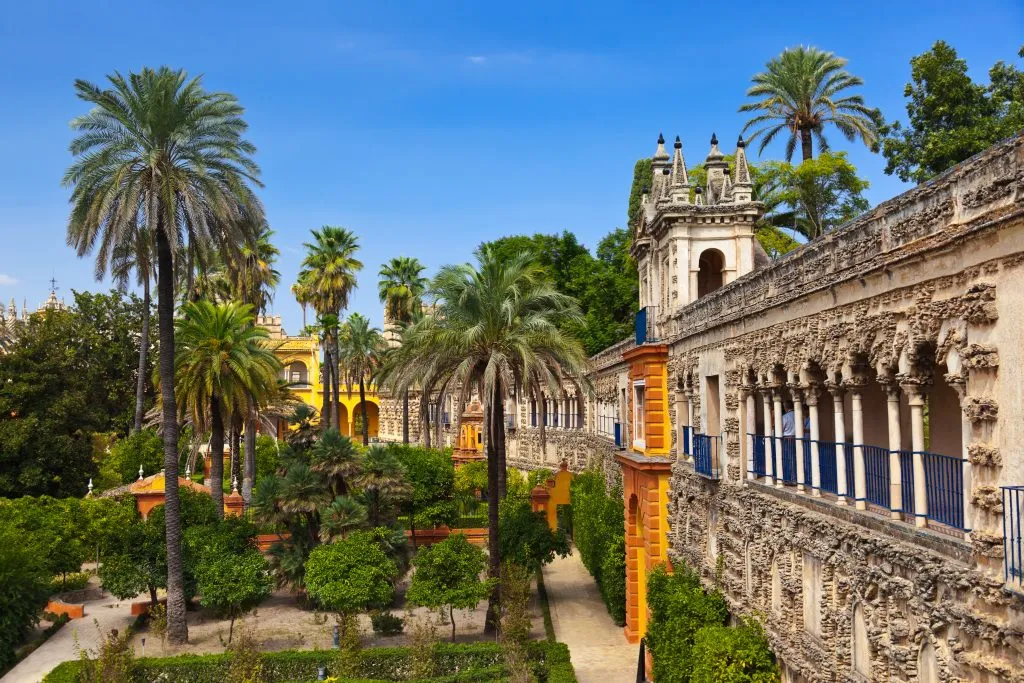
If you’re interested in experiencing more modern architecture in Seville, the famous Metropol Parasol is a fun spot with great views.
For foodies, we highly recommend taking a food tour in Seville on the first full day of your trip: not only is it incredibly fun, but it will help you know exactly what to order during the rest of your southern Spain itinerary!
And, if you’d like to explore the history of bullfighting in Spain, the Plaza de Toros is one of the most famous bullfighting rings in the world and can be toured (for obvious reasons, we do not recommend attending a fight).

Day 3: Explore Cordoba.
Today, pick up your rental car and hit the road to Cordoba!
Lying about 1 hour, 45 minutes northeast of Seville, Cordoba is famous for its incredible Mosque-Cathedral , which is exactly what it sounds like–a cathedral built literally inside a former Moorish mosque.
It’s one of the most unique houses of worship we’ve ever set foot in, and it alone would be worth visiting Cordoba for!
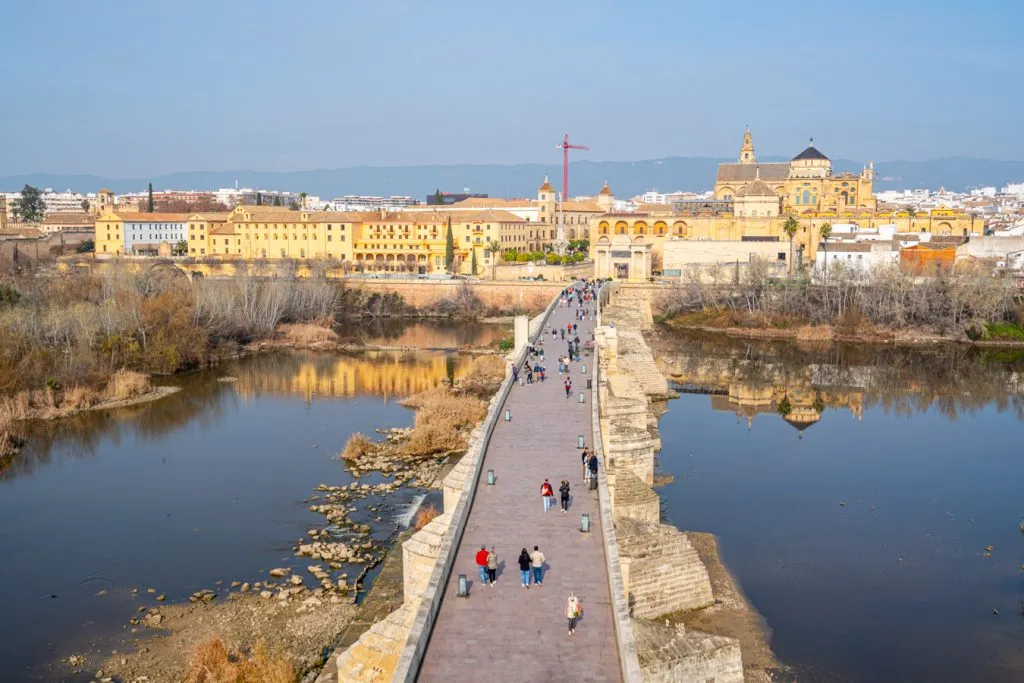
While Cordoba’s history dates back to the Romans (and you can stroll across the aptly named Roman Bridge while there), its Moorish period is responsible for much of the city’s stunning architecture and fame.
Cordoba peaked in the 10th century, when it was, for a brief moment, the biggest and one of the most powerful cities in the world.
In addition to the Mosque-Cathedral, be sure to explore Cordoba’s many flower-filled patios, check out the Alcazar of the Christian Monarchs, and visit the winding streets of the Jewish Quarter during your day in Cordoba.
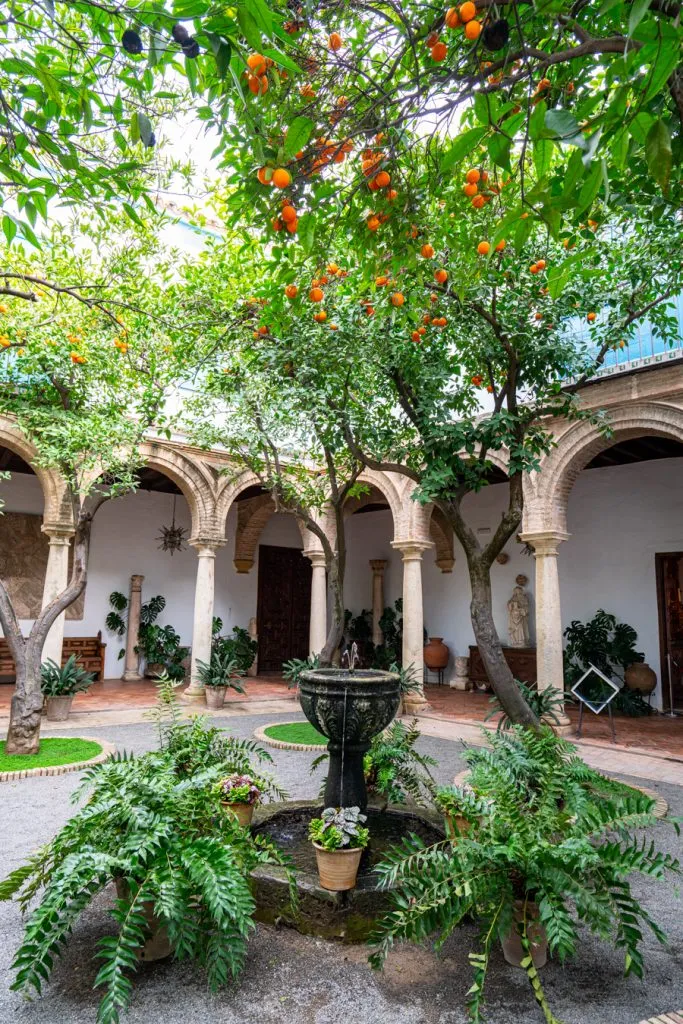
Where to Stay in Cordoba, Spain
We loved our stay at Hesperia Cordoba !
Set just over the river from Cordoba’s historic center and a very short walk from the Roman Bridge, Hesperia Cordoba features spacious rooms, excellent customer service, and a rooftop with one of the best views in the city.
For those traveling Andalucia on a budget, Cordoba Carpe Diem is a great option in the heart of the city.
And, if you’re looking to stay in a hotel so luxurious that it’s practically a museum, the popular Hospes Palacio del Bailio is the clear winner (it even features actual Roman ruins!).
Check rates & book your stay in Cordoba!
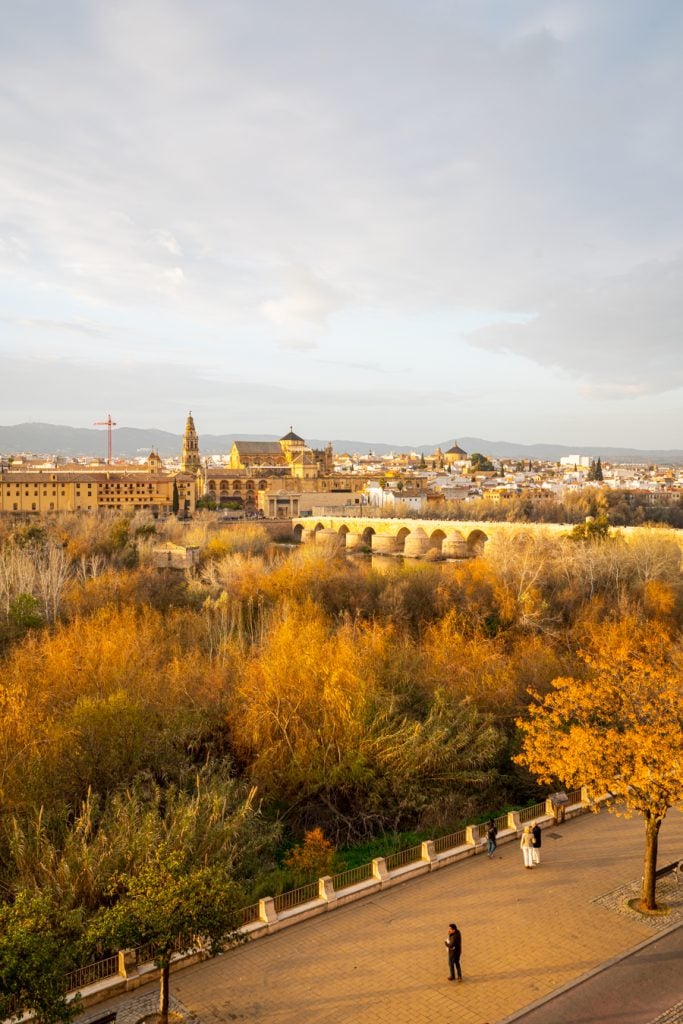
Day 4: Make your way to Granada.
Winding roads, stunning hilltop towns, and olive trees as far as the eye can see: these are the views that you’ll enjoy when driving from Cordoba to Granada on your Andalucia road trip!
If you’d like to add an extra stop or two to your morning, the Medina Azahara (a UNESCO World Heritage recognized archaeological site) and the Castle of Almodovar del Rio (a magnificent castle dating to 760 that was a Game of Thrones filming location) are both excellent options.
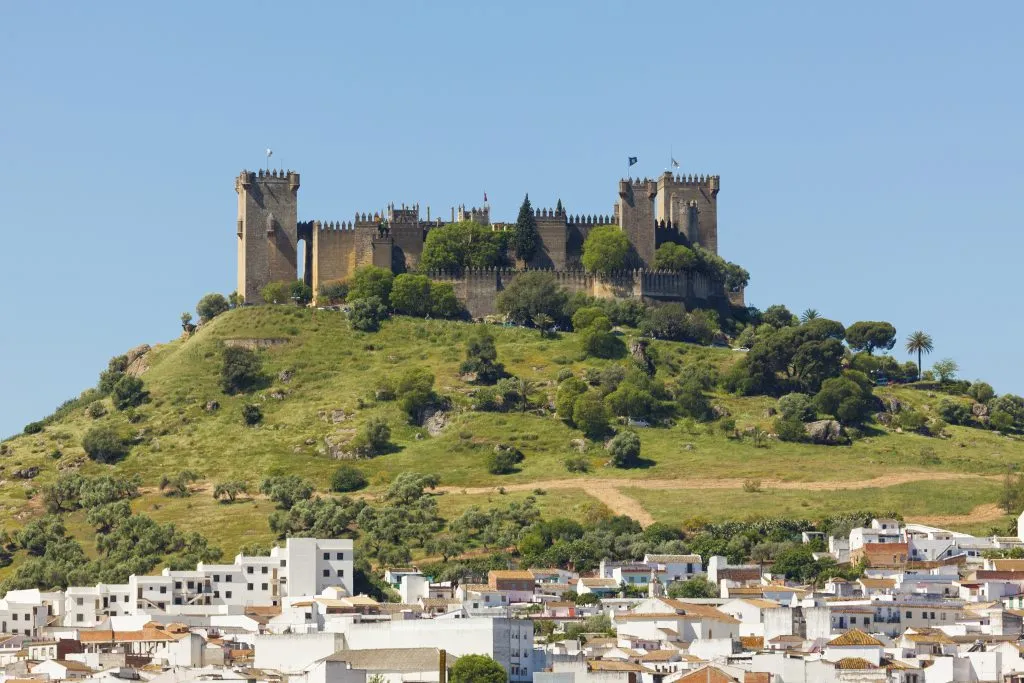
Both places are a bit out of the way, but as the drive between Cordoba and Granada is only about 2.5 hours long, you’ll have plenty of time if you’d like to stop.
Once you get to Granada, settle in and start sightseeing!
Depending on what time you get in, we recommend exploring the picturesque Albayzin (Arab Quarter), climbing up to the Mirador San Nicholas (it’s worth every step!), and enjoying plenty of tapas.
If you have time, consider heading up to Sacromonte to visit the interesting cave museum and to attend an an intimate flamenco show –the neighborhood is famous for them!
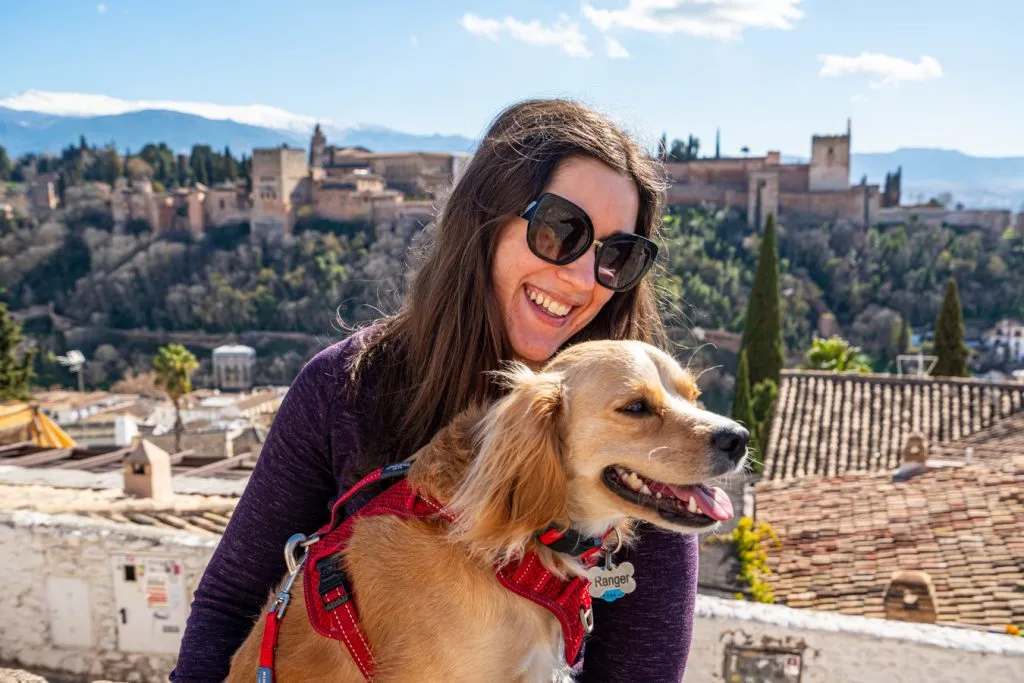
Where to Stay in Granada, Spain
We rented an apartment from Mosaiko Homes in Granada, and could not have had a better experience: the owner was responsive, the apartment fantastic, and the location unbeatable!
Mosaiko Homes is located on a quiet street a short walk from many of Granada’s top sights, offering the combination of a convenient location and a lack of noise at night–two things that can be difficult to find together in Andalucia!
Another excellent option with near-perfect reviews is the incredibly unique Casa de Reyes (that decor!).
For a bit of luxury, the popular Shine Albayzin is not only housed in a 16th-century palace, it overlooks the Alhambra !
Generally speaking, lodging in Granada is much more affordable than in, say, Seville or the resort towns of the Costa del Sol.
If you’re going to splurge on a luxury property during your 10 day southern Spain itinerary, Granada is a fantastic place to do so!
Check rates & book your stay in Granada!
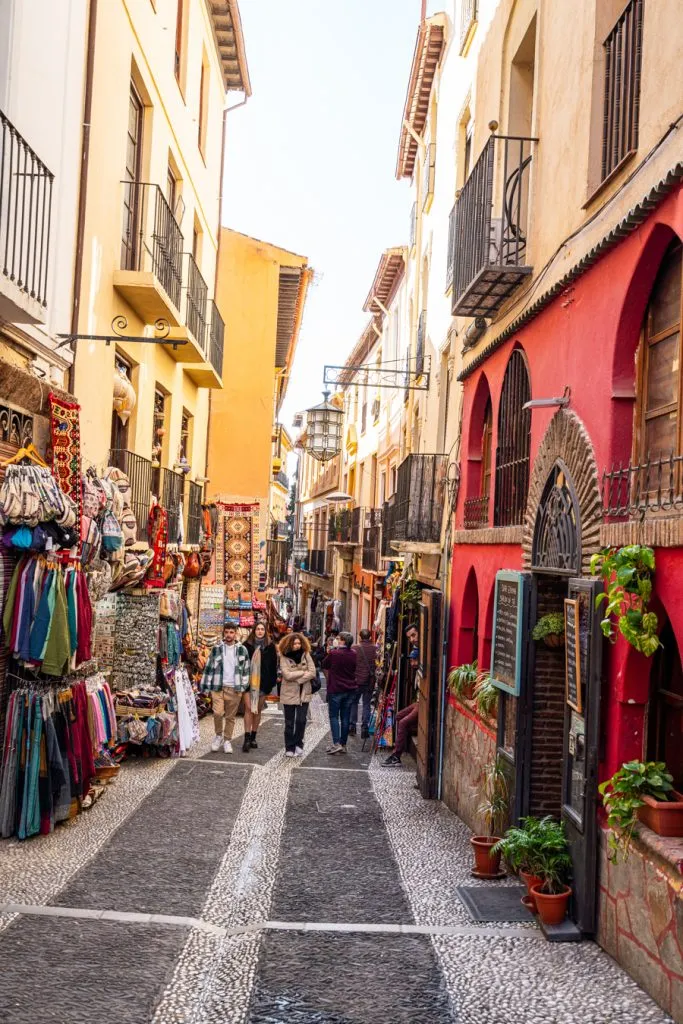
Day 5: Discover the Alhambra and other Granada gems.
On the fifth day of your road trip in Andalucia, it’s time to visit the region’s top attraction: the Alhambra!
While the Alhambra is most famous for its stunning Nasrid Palaces built by the Moors, there is an overwhelming amount of things to see at this iconic fortress.
From Generalife and its gardens (a summer retreat for the Nasrid dynasty) to the Alcazaba (the oldest portion of the fortress, which dates to the 1200s) and beyond, there are many sides to the Alhambra to visit.
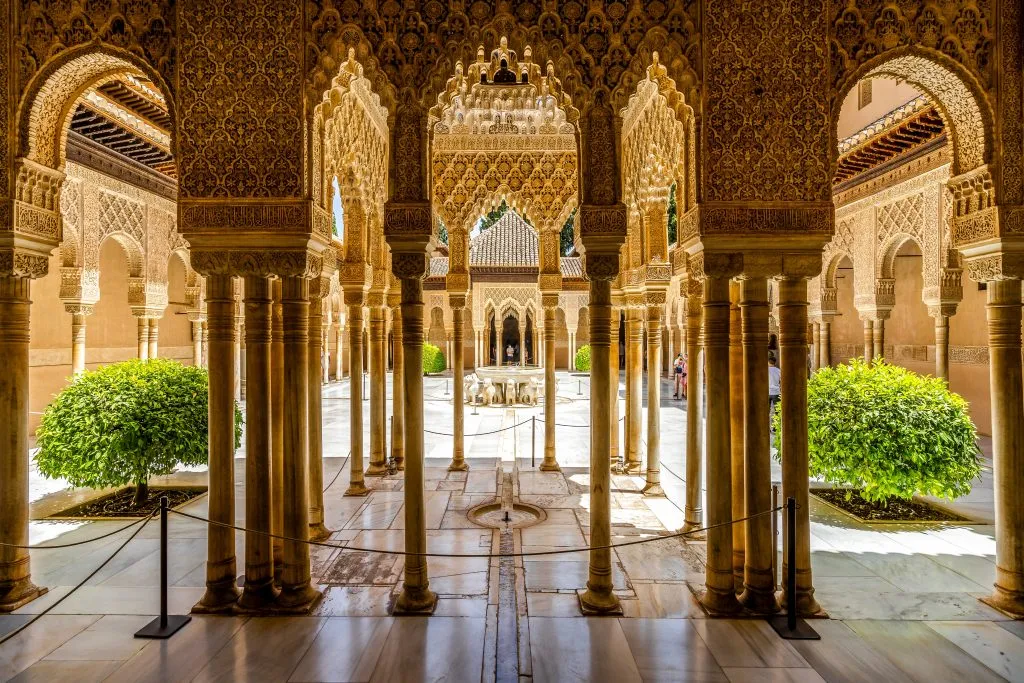
General tickets to the Alhambra are competitive and often sell out far in advance (you can check available dates here ), but luckily, organized tours and skip-the-line tickets (which are only slightly more expensive than general tickets) are very easy to come by.
Deciding whether to take a tour of the Alhambra or simply use an audio guide is a personal choice, and both have pros and cons.
We took this popular tour , and while we got frustrated with how much it dragged in certain places, we loved having the context of a live guide–especially in the Nasrid Palaces.
We also loved not having to manage the tightly controlled timed entry system for the Nasrid Palaces ourselves.
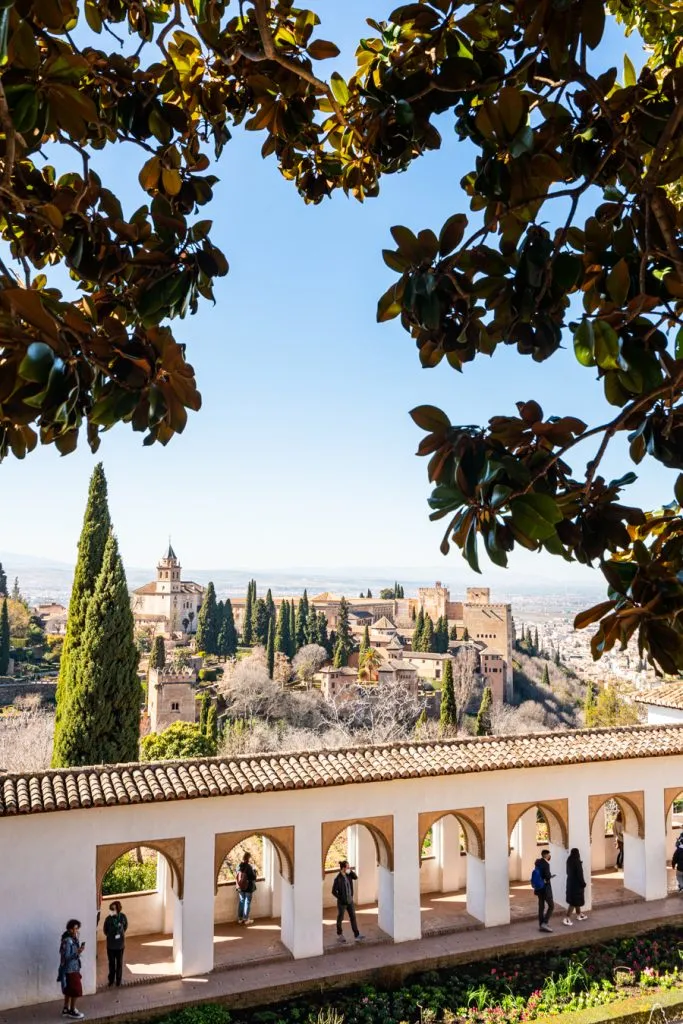
Keep in mind that not all Alhambra tickets include entry to the Nasrid Palaces.
Make sure that your ticket does, though, because they are truly the star of the show!
You will likely be exhausted after visiting the Alhambra, which makes this afternoon the perfect time to visit one of Andalucia’s gorgeous hammams.
Hammam Al Andalus is well-known, gorgeous, and accessible to English speakers. We loved our time there!
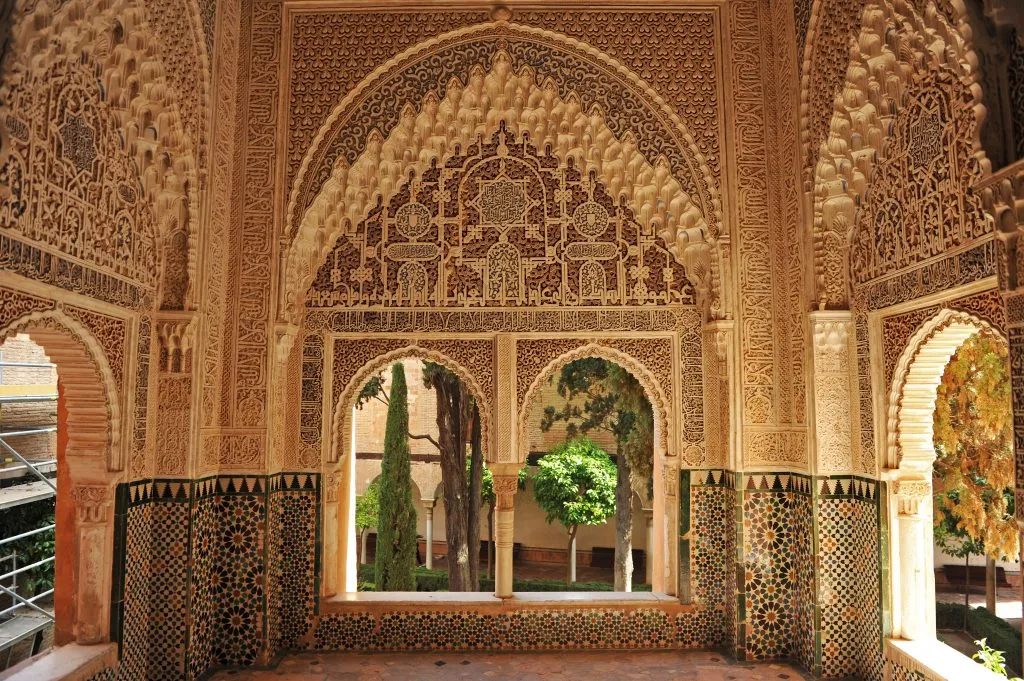
Day 6: Take the scenic route to Malaga (or nearby).
Today, start your morning by enjoying any sightseeing you haven’t had a chance to enjoy in Granada, such as visiting the stunning Granada Cathedral and Royal Crypt.
Depending on what time you get started in the morning and how much time you want to spend on the beach, you can also consider heading 20 minutes outside of Granada to enjoy the popular hanging bridges at Los Cahorros Gorge in Monachil.
From there, it’s time to make your way to the Costa del Sol: no southern Spain itinerary would be complete without soaking up some sun!
We recommend heading toward Malaga via the A-44 to A-7 route–it’s slightly longer than going the A-92 route, but you can’t beat the views driving along the Mediterranean for half the drive!
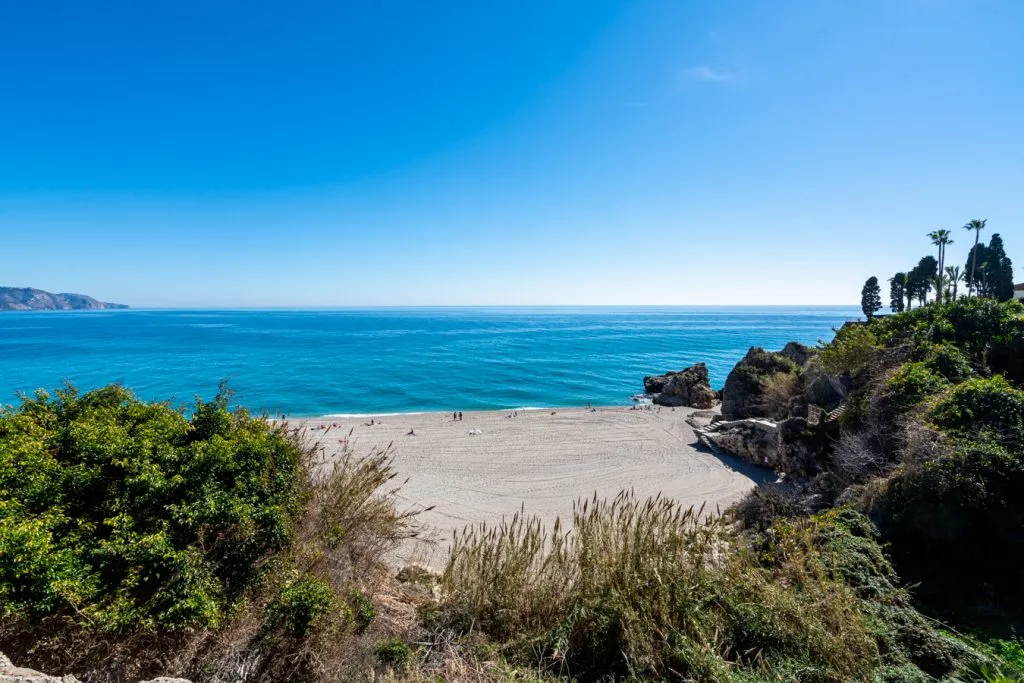
Day 7: Soak up the sun on the Costa del Sol.
There is an endless number of options when it comes to deciding what town to stay in on the Costa del Sol!
Malaga, the biggest city in the region, is perfect for those who want to potentially take an afternoon road trip to a nearby beach but want to dedicate most of their time to culture.
The best things to do in Malaga include visiting the celebrated Picasso Museum, Alcazaba , Roman Theatre, Cathedral, and beyond, which make for a compelling, but not beachy, trip.
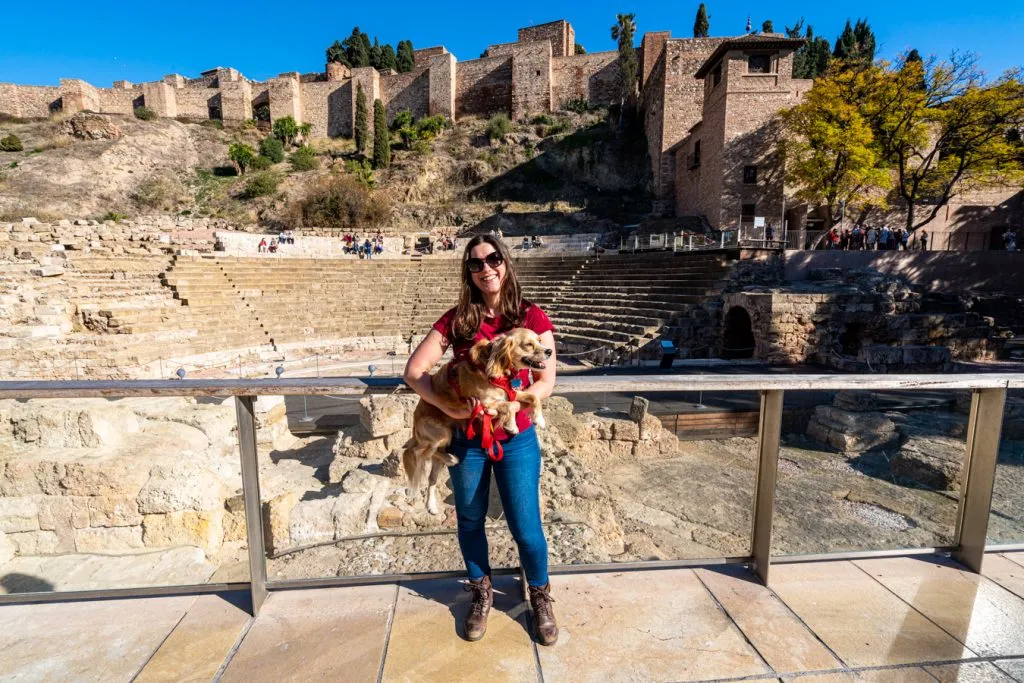
If you’re looking for idyllic beaches, Nerja is the place to go (that’s where the above photo was snapped!).
A beautiful resort town with a promenade?
Estepona might be right for you.
No matter where you end up staying, make sure that you spend at least part of the day admiring views of the Mediterranean with a gelato or glass of tinto verano (or both) in hand.
Since you’re visiting via a Costa del Sol road trip, you can also easily stay in one town and squeeze in a quick afternoon visit to another!
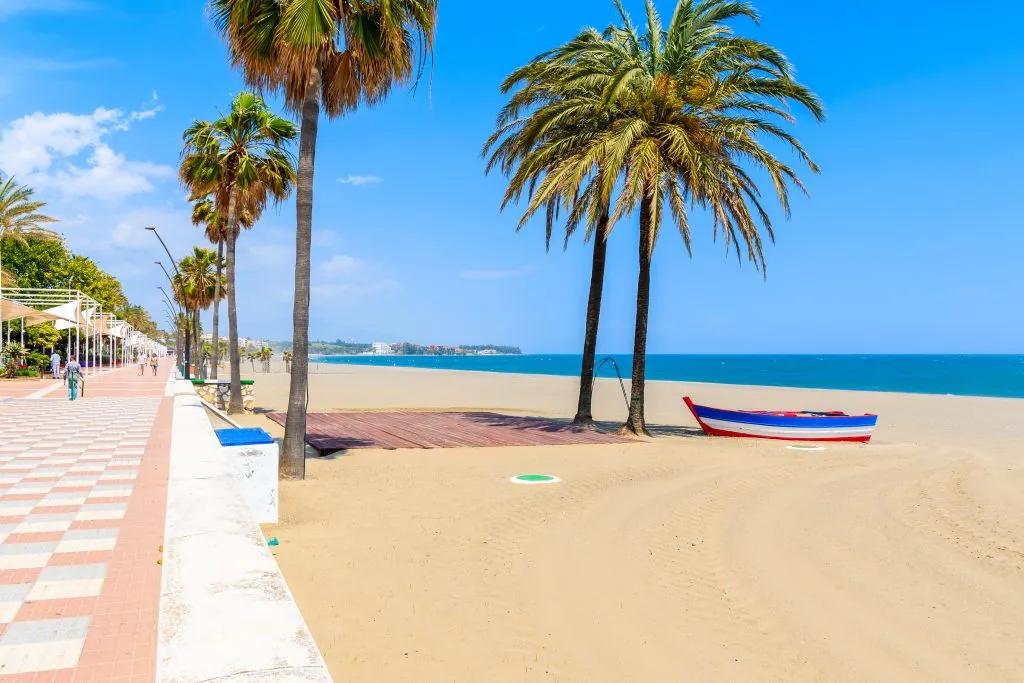
Day 8: Continue your Andalucia road trip and head to Ronda.
Last but certainly not least, say goodbye to the Costa del Sol and head north again to Ronda , one of our absolute favorite places in Spain.
Situated on a ridge, Ronda features sweeping views, a gorge, an 18th-century bridge that is earnestly referred to as the “New Bridge”, ties to the Lost Generation, and idyllic whitewashed streets–and that’s without even leaving the town center.
Much smaller than Seville or Granada, Ronda is nonetheless well worth savoring.
Once you arrive, start by exploring a few of the best things to do in Ronda, such as visiting the Cuenca Gardens, marveling at Puerto Nuevo (and Puerto Viejo and the Arab Bridge, while you’re at it), and visiting the historic Arab Baths (now a museum, though there is also a functioning hammam in Ronda!).
For sunset, there is absolutely no better place to be than admiring the views of Puerto Nuevo and the surrounding landscape from the Alameda del Tejo!
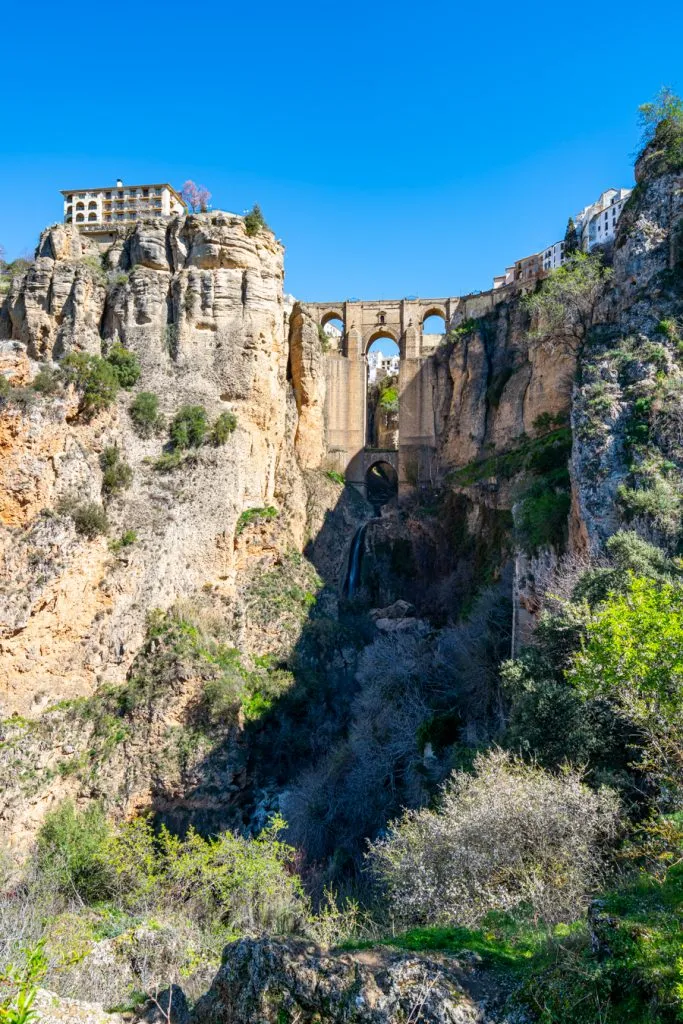
Where to Stay in Ronda, Spain
We can’t rave about our stay at Catalonia Reina Victoria in Ronda enough–it may just be one of our favorite hotels we’ve ever stayed in!
Unbeatable views over the countryside (we upgraded to a terrace room, which was absolutely worth it), excellent customer service, comfortable rooms, easy parking on site, and walking distance to all the best things to do in Ronda–it’s hard to beat that!
The popular Hotel Montelirio , with views of the Puerto Nuevo, is also a great option.
However, as Ronda is the last stop on your Andalucia road trip and finding parking in the city center is fairly simple, you may want to go the complete opposite route and stay in a country hotel just outside of town!
The beautiful and well-reviewed Hotel Cortijo Las Piletas is located a 15-minute drive from Ronda, offers a pool, gorgeous views, and a bit of peace and quiet to end your trip with.
Check rates & book your stay in Ronda today!
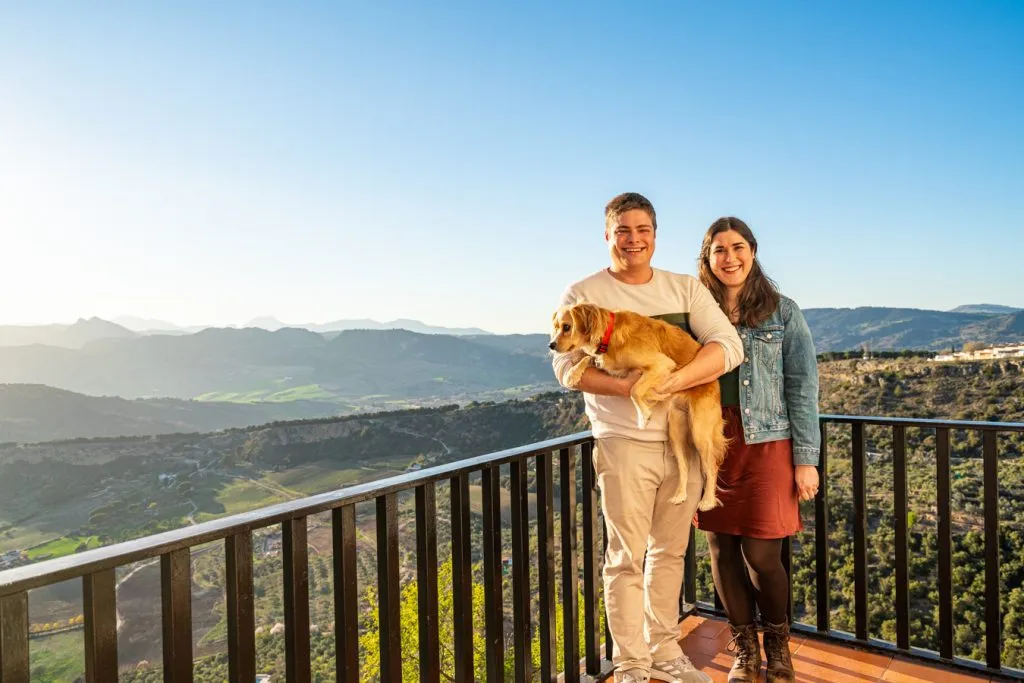
Day 9: Explore unique places to visit near Ronda.
In addition to being a fantastic town to visit in its own right, Ronda is also surrounded by excellent day trip options!
Our first choice would undoubtedly be a visit to Setenil de las Bodegas: if you only have time to visit one place outside of Ronda, make it here.
This historic town features many homes and businesses built directly into the surrounding gorge, and the result is one of the most unique towns we have ever laid eyes on!
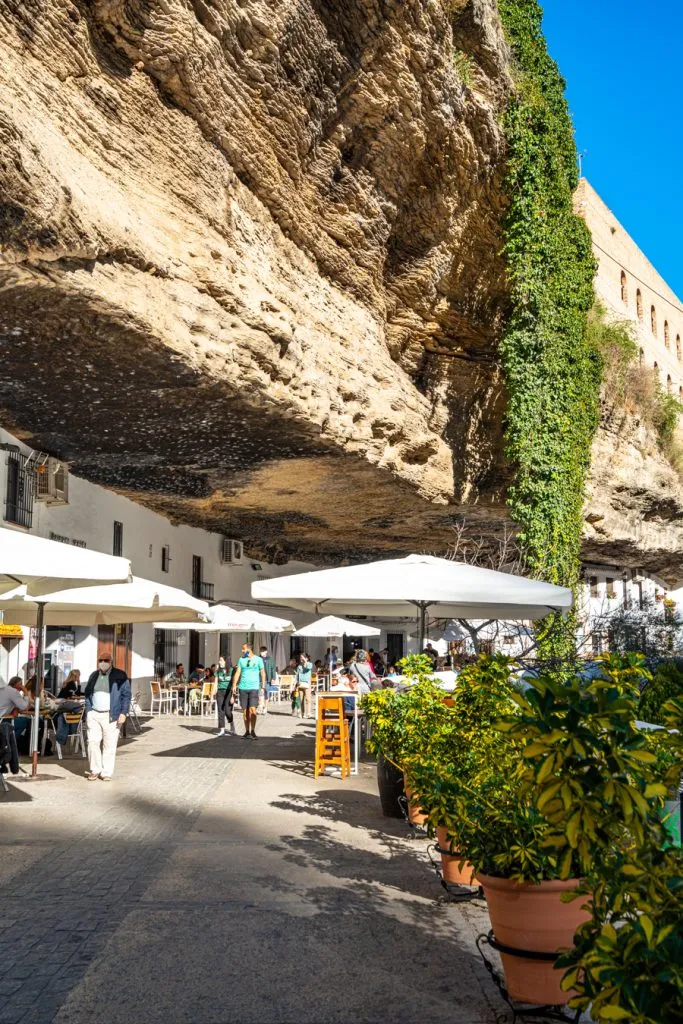
Other fun places to visit include Juzcar (also known as Spain’s “Smurf Village”–it is painted entirely blue!), and the Cueva del Gato swimming hole.
If you want a unique perspective on Ronda’s famous Puerto Nuevo, you can also drive to the bottom of the ridge and view it from an entirely different angle (keep in mind that there are some tiny dirt roads involved here, but it is doable).
Looking to ditch the car entirely?
You can find plenty of horseback riding tours in the area!
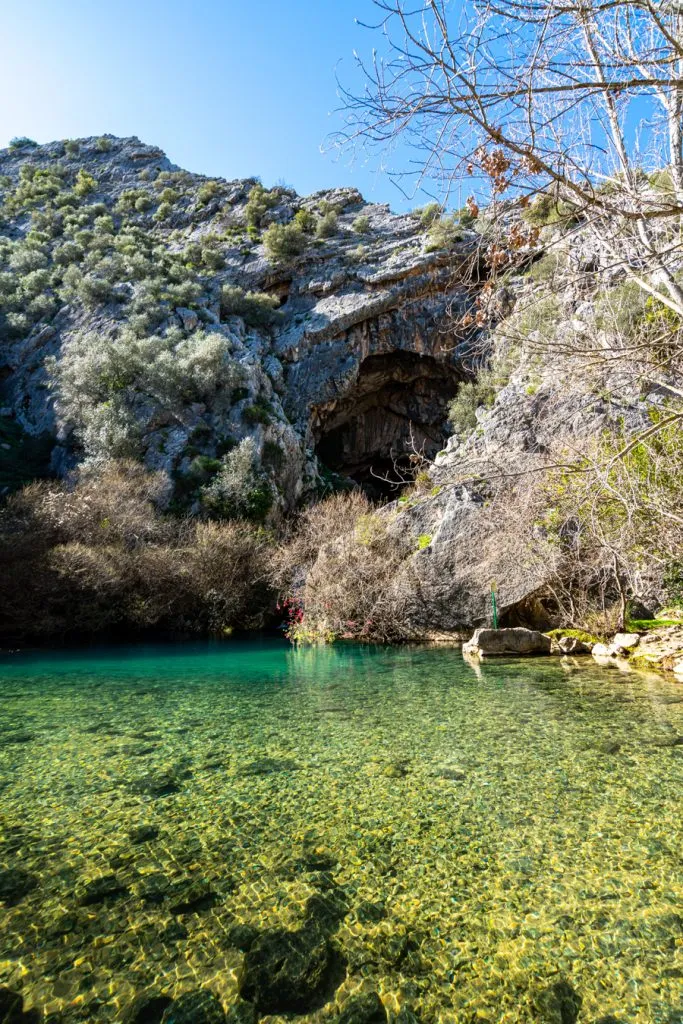
Day 10: Head back to Seville and wrap up your 10 day southern Spain itinerary.
It’s time to wrap up your Andalucia road trip!
Today, make your way back to Seville to drop off your rental car and head home.
If you have time for a little extra sightseeing, consider spending the morning visiting any attractions you didn’t get a chance to see in Ronda or Seville.
Or, for an incredibly relaxing end to your 10 days in southern Spain, book yourself a visit to a hammam in either city!
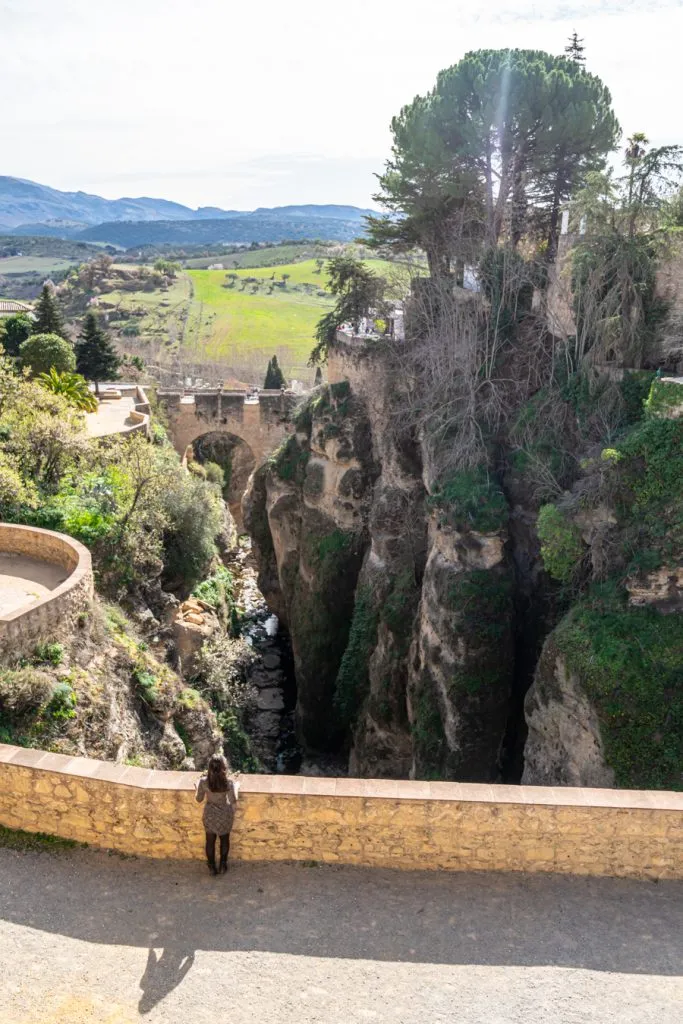
A mere 10 days in Andalucia could never hope to cover every incredible destination that southern Spain has to offer!
If you’re lucky enough to have a longer timeframe to work with, here are a few more places to consider adding to your itinerary for southern Spain, from beach towns to mountainous parks.
Over 3,000 years old and almost entirely surrounded by water, Cadiz is visually stunning and historically fascinating.
It’s fairly small, given that it is physically constrained by its location, but packed with interesting sights, including over 100 watchtowers!
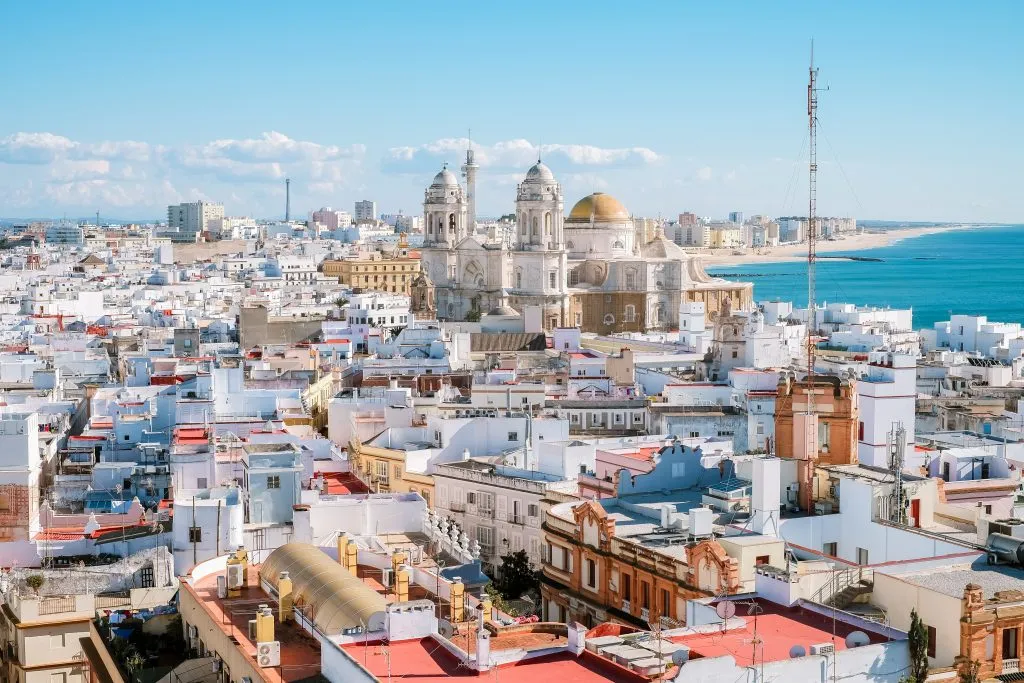
Technically speaking, your Andalucia road trip doesn’t have to only take place in Spain!
Head to Gibraltar to enjoy views from the famous Rock of Gibraltar, check out the resident wild monkeys, and enjoy the excuse to walk (literally) across the border of Spain to the UK.
Don’t forget to pack your passport!
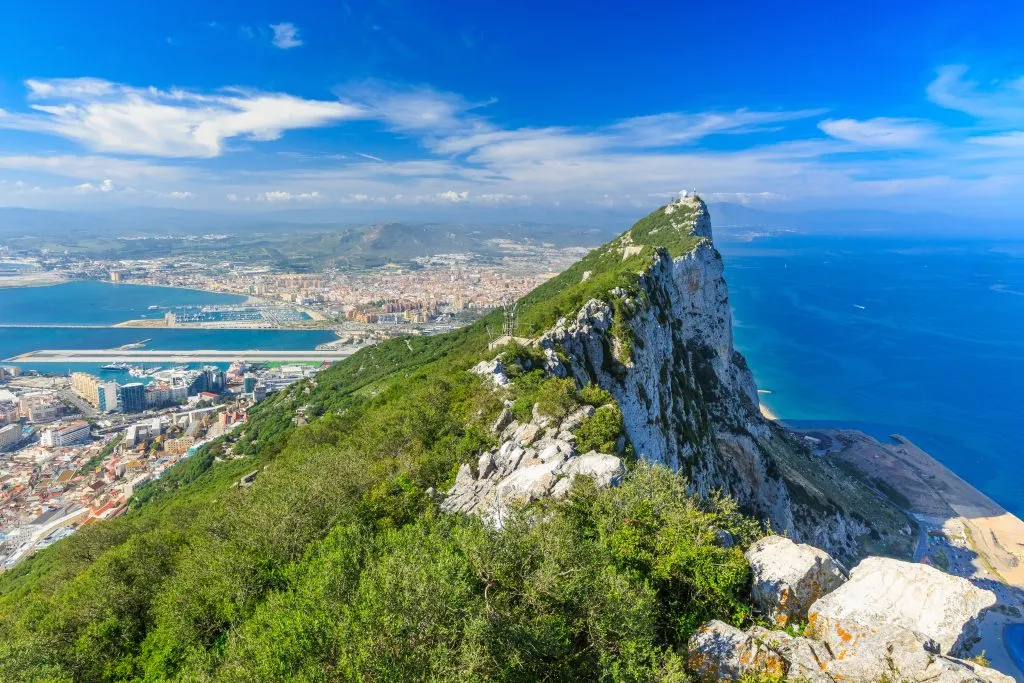
Jerez de la Frontera
A great alternative to cities like Seville, Jerez de la Frontera offers many of the usual Andalucia highlights–Moorish castle, riding school, festivals–but is (slightly) more off the beaten path.
It’s also famous for its sherry production, making it a fun stop for spirit lovers!
Sierra Nevada National Park
Offering skiing in the winter, hiking in the summer, and gorgeous mountain views year-round, Sierra Nevada National Park makes an excellent addition to an itinerary for southern Spain for those looking for a place to relax in nature.
Located just east of Granada, Sierra Nevada National Park is easy to add to this itinerary–or, if you’re not much of a beach person, you can even swap the Costa del Sol for some time here!
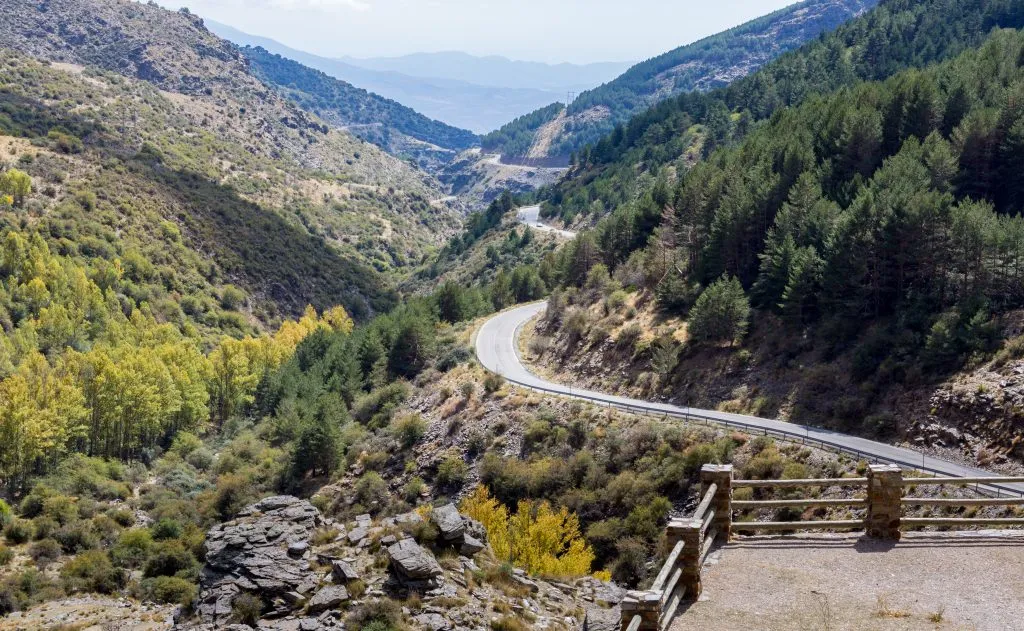
Puerto Banus
Looking for luxurious yachts, high-end nightclubs, and–essentially–the Spanish version of St. Tropez or Monaco?
Head to Puerto Banus, just next door to Marbella, and you’ll find exactly what you’re looking for.
Start by checking out the Golden Mile!
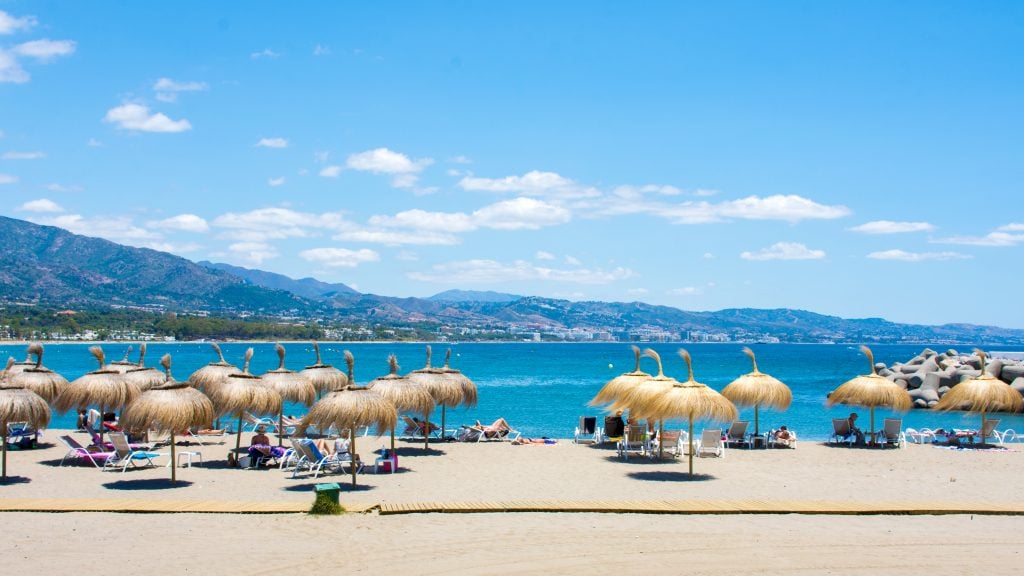
Arcos de la Frontera
Surrounded by the Guadalete River on 3 sides and–like Ronda–situated on the edge of a ridge, Arcos de la Frontera is visually stunning and one of the best whitewashed towns (pueblos blancos) to visit in Andalucia.
Don’t miss the views from the Castillo de los Arcos while you’re there!
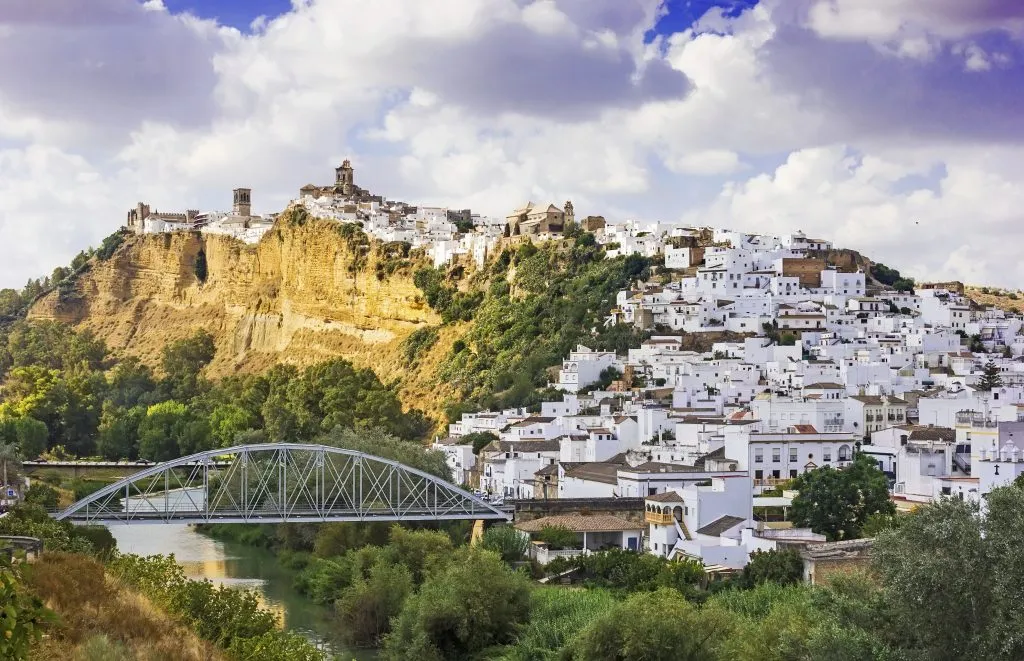
Located at the far southern tip of the Iberian Peninsula, Tarifa is far enough out of the way that it doesn’t see quite as many visitors as the famous Costa del Sol (among those who aren’t kitesurfing enthusiasts, anyway)–but it’s absolutely worth a visit.
Featuring wide, sandy beaches famous for kitesurfing and a charming whitewashed town center, Tarifa is a laid-back delight.
It also lies a short ferry ride away from Morocco , and you can take a day trip to Tangiers as part of your time there!
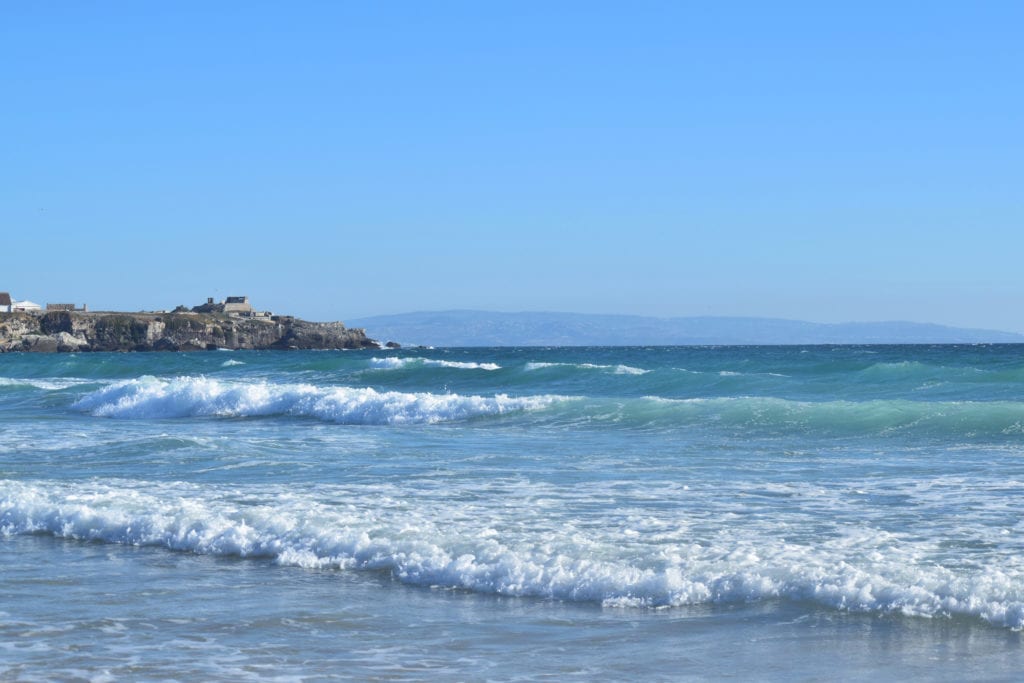
El Caminito del Rey
With stunning gorge views and adrenaline-inducing heights, El Caminito del Rey is one of the most iconic hikes in Andalucia!
A decade ago, it was often touted as being the most dangerous hike in Spain–or even the world–but it has now been restored to be much more accessible.
… For those of us with a fear of heights, though, it can still pose a mental challenge!
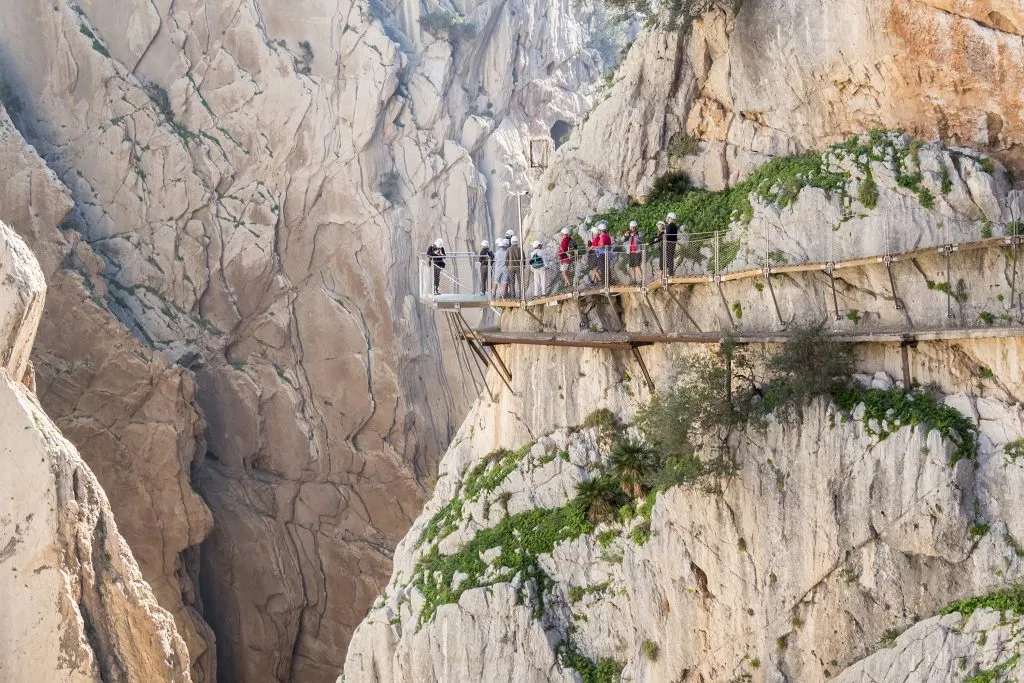
Andalucia can be a year-round destination–if you can brave the summer heat, that is.
Southern Spain, particularly cities like Cordoba and Seville, are known for being some of the hottest places in Europe.
Summer temperatures can easily reach 98°F (36°C) in the inland cities, which is why during July and August, you’ll find the crowds down at the Costa del Sol, where the temperatures are milder and there’s the Mediterranean to cool off in.
Ideally, this itinerary for southern Spain is designed for the spring or fall, when temperatures are warm but reasonable, the sun is usually shining, and the flowers are in bloom everywhere you look.
If you’re willing to bundle up a bit, winter can also be a wonderful time to take this Andalucia road trip.
The prices and crowds will both be smaller, and if you’re so inclined, you can even go skiing in Sierra Nevada near Granada–the southernmost ski area in Europe!
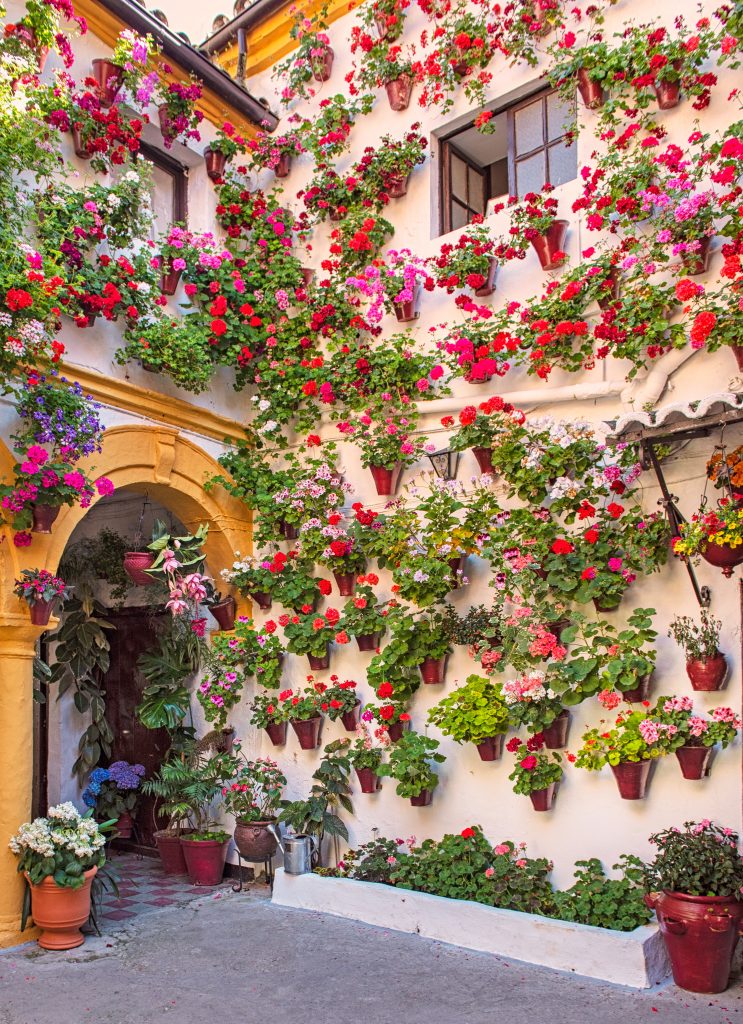
Here are a few essentials you should definitely add to your packing list as you prepare for your road trip in Andalucia, Spain!
Travel Insurance — We don’t ever suggest traveling without travel insurance–anything can happen, and a fast-paced road trip is definitely a case of better safe than sorry.
We use and recommend Safety Wing for trips to Spain.
Travel Adaptors for Spain — If you’re coming from outside of Europe, you’ll definitely need adaptors for your electronics.
Hands-Free Phone Mount — This is especially important if you don’t have a reliable co-pilot: the last thing you want to do is be fumbling with the GPS on your phone during your road trip in Andalucia.
Pack a cell phone holder to attach to the car and you’ll be able to drive much more safely!
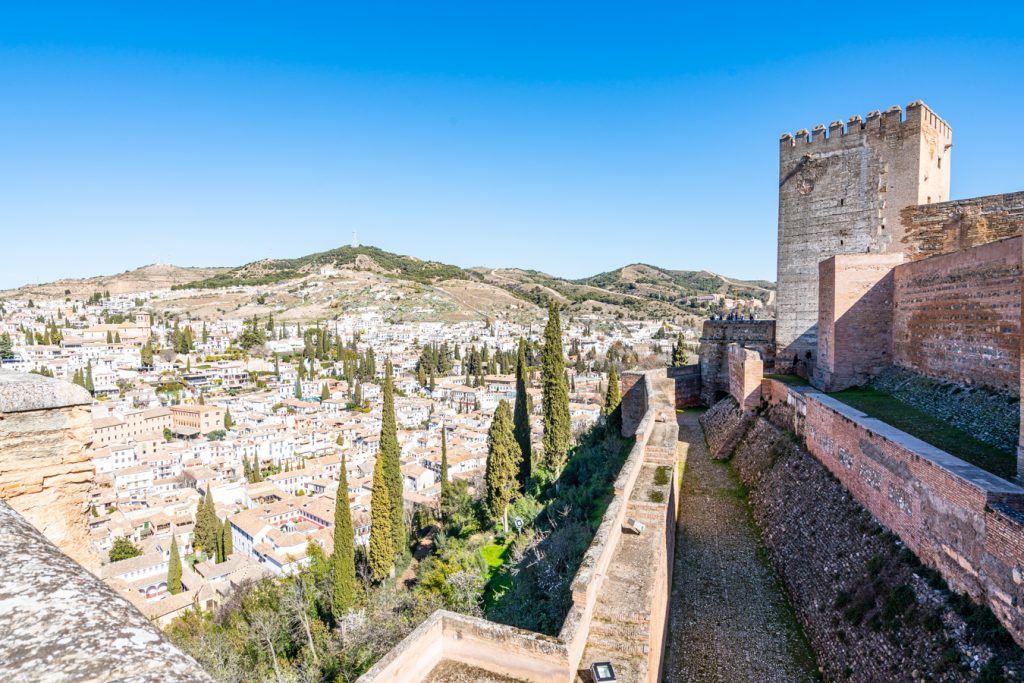
Additional Car Insurance — Whether you purchase a policy that covers car rental (only some of theirs do, so double-check!), purchase a policy through the rental car company, or something else, be sure you have coverage: it’s worth the peace of mind.
Portable USB Charger — Don’t stress about your phone dying while you’re spending long days driving from village to village: add a portable charger to your southern Spain packing list.
Swiss Army Knife — Want to open wine bottles in your hotel room, slice cheese from the market, or cut up that fresh bread from the bakery?
You’ll be so glad you brought a Swiss Army Knife along on your Andalucia vacation!
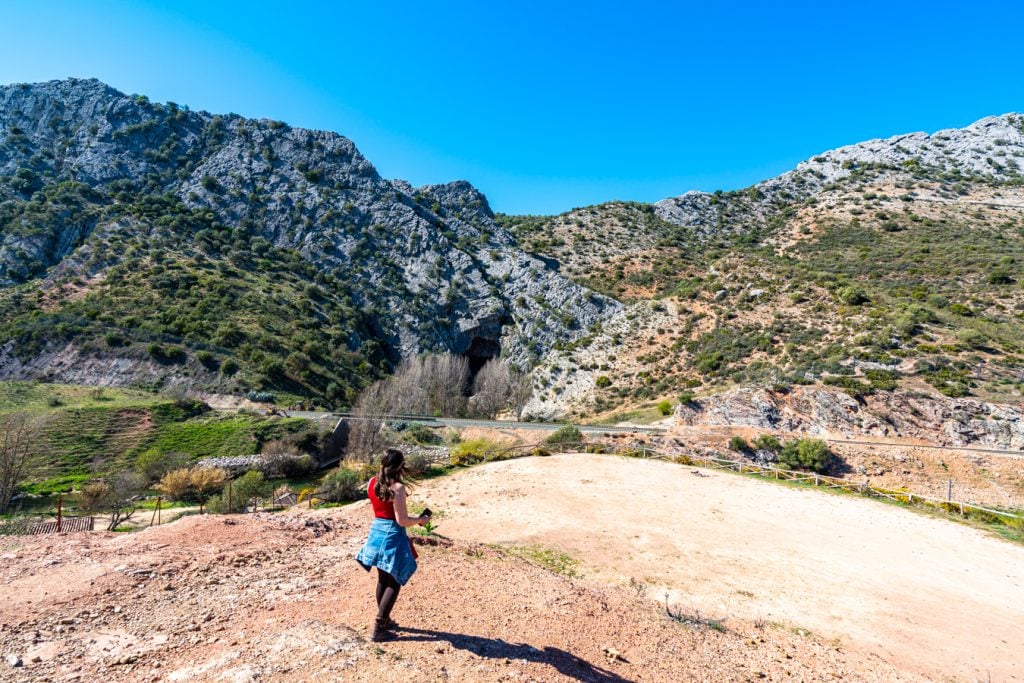
Camera — We absolutely adore our Sony a7R III , but whatever camera you’re comfortable with works.
Just make sure you have something with you to preserve your memories!
Reusable Water Bottle(s) — Cut down on plastic waste, save money, and make sure you don’t have to stop for water constantly: a reusable water bottle has lots of benefits on a road trip. We personally love and use these .
Hand Sanitizer — We carry this everywhere, and have never been sorry to have it floating around in our day bag.
Take This Map With You! Click each highlight to pull up the name of the destination. To save this map to “Your Places” on Google Maps, click the star to the right of the title. You’ll then be able to find it under the Maps tab of your Google Maps account! To open the map in a new window, click the button on the top right of the map.
[convertkit form=3127238]
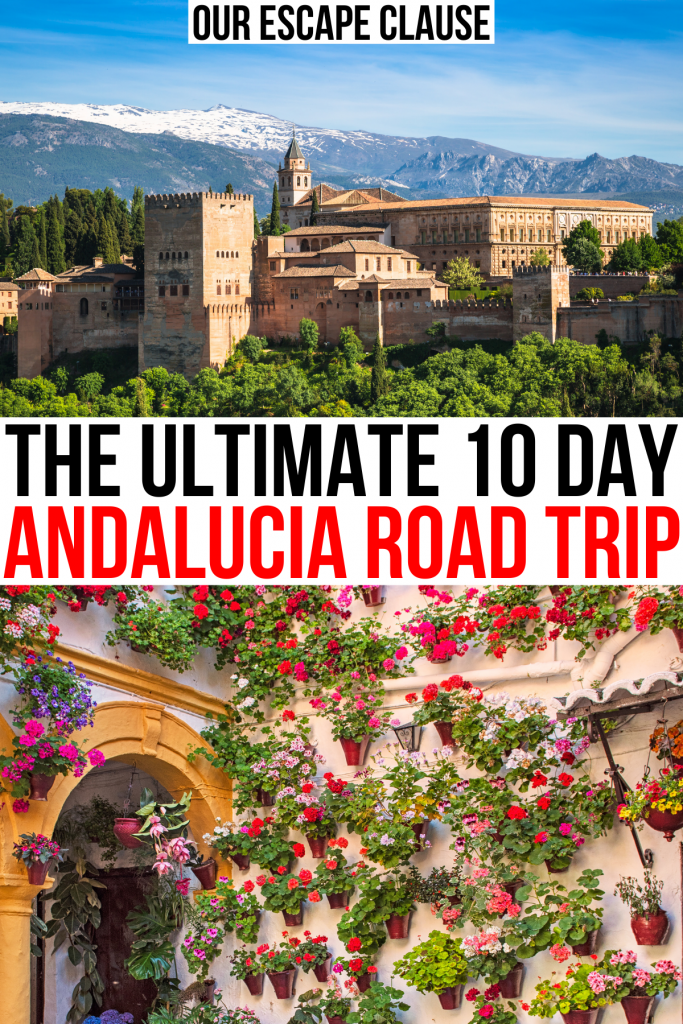
About Kate Storm

In May 2016, I left my suburban life in the USA and became a full-time traveler. Since then, I have visited 50+ countries on 5 continents and lived in Portugal, developing a special love of traveling in Europe (especially Italy) along the way. Today, along with my husband Jeremy and dog Ranger, I’m working toward my eventual goal of splitting my life between Europe and the USA.
6 thoughts on “The Ultimate Andalucia Road Trip (Detailed Southern Spain Itinerary!)”
beautiful, do you sell a map of this
We don’t sell a map or printable version of this itinerary (yet), but you can click on the button at the top right of the map embedded at the bottom of this article and download it to take with you!
This is exactly the trip we plan to take this fall. Thank you for this great guide! Are the places you reccommend to stay pet friendly? It appeared your were travelling with your dog and we are also travrling with ours. Gracias!
Yes, all of the places we mention staying at personally in Andalucia are pet-friendly and Ranger stayed with us at all of them!
I can’t speak to the alternative suggestions provided, as I don’t source pet-friendly hotels specifically for those (very few of our readers travel with their dogs).
Have a wonderful trip!
Hi Kate, It seems finally I have found the perfect road trip for southern Spain. I plan to go early December or maybe in Jan-Feb. I would like to add 3-4 days to the trip. Could you recommend how to do that? Regards, Amitabh
The sky is the limit!
Beyond the destinations I outlined in the “other destinations” section of the post, you could potentially consider adding on a few days in Morocco with a longer timeline.
You can also easily add more days to any of the destinations included in the itinerary. There’s lots of great hiking around Granada, for example, and of course there’s always the option of enjoying even more beach time along the Costa del Sol.
Leave a Comment Cancel reply

13 Top-Rated Tourist Attractions in Andalusia
Written by Lisa Alexander , Michael Law , and Lana Law Updated May 3, 2023 We may earn a commission from affiliate links ( )
Authors Michael and Lana Law spent 10 weeks touring the sights of Andalusia in 2022.
Andalusia is the Spain of the imagination, a dreamy sun-kissed land where passion, poetry, and drama collide. Fearless matadors, fabulous festivals, and foot-stomping flamenco symbolize this emblematic region. Whispering the legacy of a bygone era, crumbling Moorish castles and old Jewish quarters have a subtle seduction. Ancient mosques and synagogues were replaced with Christian churches after the Reconquest, but the romance of the past remains.
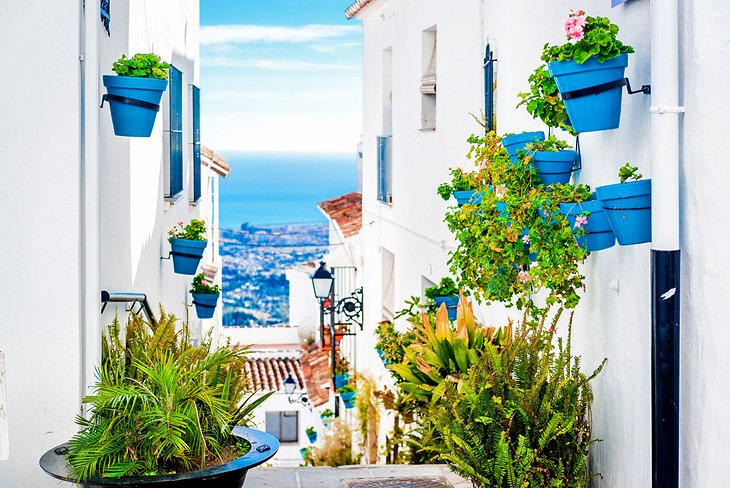
You can feel the legacy of the past while wandering the twisting medieval cobblestone streets, admiring the swirling Arabesque patterns in Islamic architecture, and listening for melancholy notes of Gypsy soul in the strumming of Spanish guitar. A stroll through almost any of Andalusia's historic towns leads to delightful discoveries of fountain-adorned squares and whitewashed houses with flower-filled patios.
Andalusia is also a place of contrasts: snowcapped mountains, lush green river valleys, and wild gorges. The dramatic scenery provides stunning backdrops for amazing sights. From the glorious cathedral of Seville to the magnificent Alhambra palace in Granada and the Great Mosque of Córdoba, Andalusia has some of the most thrilling monuments in the world .
Learn about the sightseeing highlights in this enchanting region of southern Spain with our list of the top attractions in Andalusia.
1. Seville: A Quintessential Andalusian City
2. the alhambra palace in granada, 3. córdoba and the great mosque, 4. the puente nuevo in ronda, 5. the ancient port town of malaga, 6. the pueblos blancos of andalusia (white villages), 7. marbella: a glamorous beach resort with a quaint old town, 8. andalusian traditions in jerez de la frontera, 9. renaissance architecture in úbeda, 10. historic monuments and old-world charm in baeza, map of tourist attractions in andalusia.
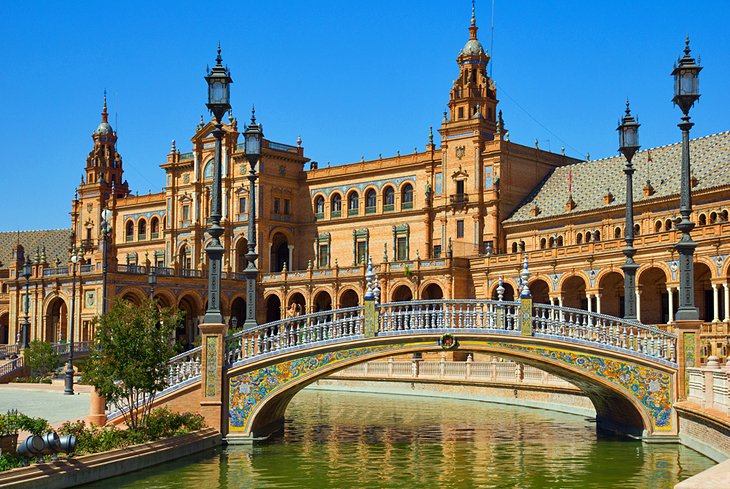
Romantic, dazzling, and sensual, Seville has a quintessential Andalusian character. This alluring city is one of the best places to visit in the region to experience traditional culture, including lively religious festivals and the famous flamenco dance.
Seville is also a city where you can get a feel for the joys of everyday life in Andalusia, simply by wandering the quaint cobblestone streets, relaxing in sunny plazas and taking an evening " paseo " (stroll) along with the locals. At night, the historic center is illuminated by old-fashioned street lamps, which gives it a special ambience.
The most important monument is the Seville Cathedral , which was converted from the Great Mosque and is the grandest Gothic church in Christendom . Another Moorish architectural relic is the Alcazar , with its dazzling Mudéjar decor and lavish gardens.
The medieval Barrio Santa Cruz , once the Jewish district, is a charming quarter with winding alleys and picturesque courtyards.
On a pleasant afternoon or balmy evening, the Plaza de España in the Parque de María Luisa is a wonderful spot to go for a walk or enjoy a leisurely boat ride through the park's canal.
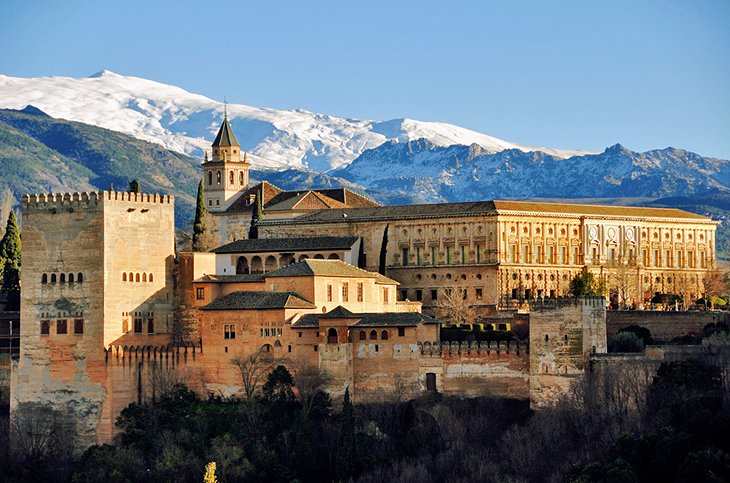
The Alhambra is a masterpiece of Islamic design and one of the most visited attractions in Spain . The complex includes several splendid palaces, gorgeous landscaping, fragrant rose gardens, and lavish decorative fountains. Because of its exquisite architecture and cultural value, the Alhambra is designated as a UNESCO World Heritage Site .
The Moors arrived from the deserts of North Africa (present-day Morocco and Algeria) in the 13th century, they were awestruck by the lush landscape of Granada. At the foot of the Sierra Nevada Mountains , abundant water from the Río Darro ensured rich vegetation and agriculture. The Moors built the remarkable hilltop citadel here, and overflowing fountains were placed all over the grounds as a symbol of wealth.
Granada continued to flourish as a Moorish city until the 15th century. When the Catholic Monarchs arrived to reconquer the city in 1491, Granada was the only remaining stronghold of Moorish rule in Andalusia.
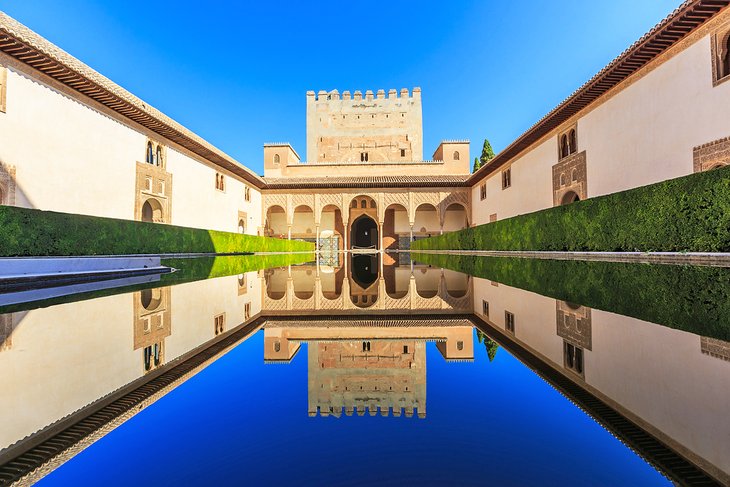
The last Moorish king, Muhammad XII (known as Boabdil), capitulated by giving King Ferdinand and Queen Isabella the keys to "paradise" (Boabdil's description of the Alhambra) after the Christian Reconquista (Reconquest) was complete in 1492. As the legend goes, Boabdil wept when taking in his final glimpse of the Alhambra during his journey of departure from Spain.
Along with the Alhambra, the Albayzín (Albaicín) district shares the UNESCO World Heritage classification. This medieval Islamic town has retained its Moorish character , seen in the maze of narrow, winding pedestrian streets and clusters of quaint whitewashed houses.
Further evidence of the city's Arabic heritage is found at the Alcaicería (on Calle Alcaicería), an outdoor market that is a relic of the old Moorish bazaar, and the luxurious Hammam Al Á ndalus , traditional Arab Baths that pamper modern tourists with spa treatments.
Other must-see sights in Granada include the Renaissance Cathedral and the adjoining Capillo Real where the Catholic Monarchs are buried. High on the list of top experiences is watching authentic flamenco performed by locals in a Gypsy cave on the Sacromonte .
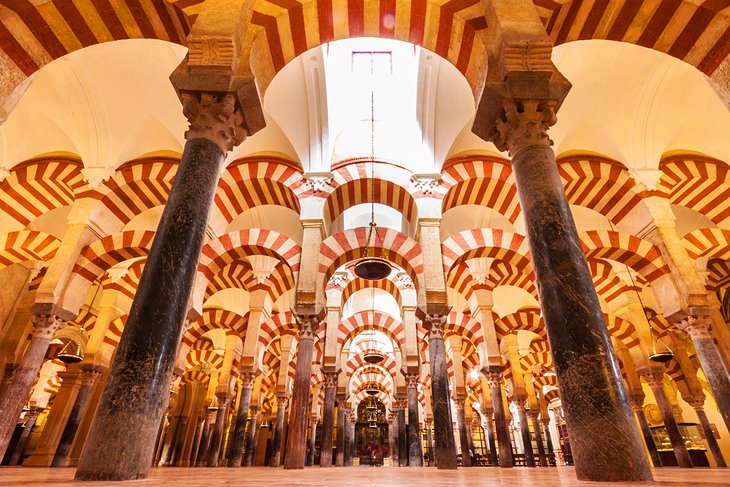
Córdoba is most famous for the Great Mosque, but this city offers much more for visitors, from charming narrow streets to an ambience you won't find in other Andalusian cities.
While Paris and Rome were in the Dark Ages, Córdoba was the most important city in Europe, a center of civilization where great scholars Maimonides (a Jewish philosopher) and Averroes (a Muslim philosopher) shared their ideas, and a place where the people of three religions, Christianity, Islam, and Judaism, lived in harmony.
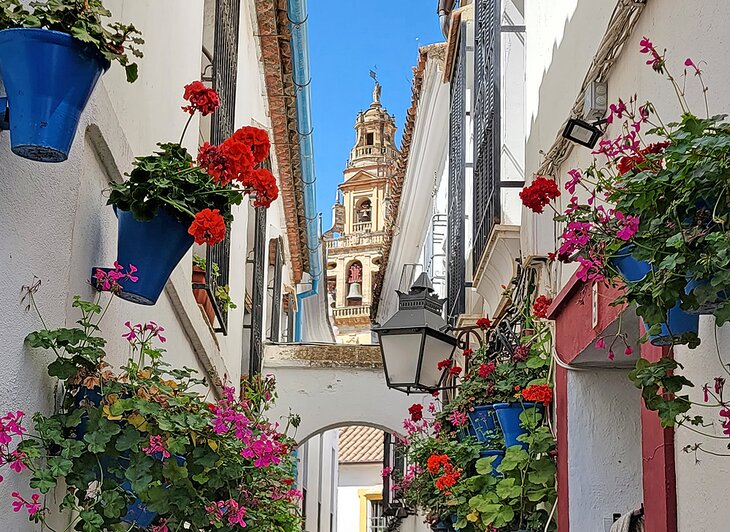
Top among the must-see sights of Córdoba is the UNESCO-listed Great Mosque surrounded by several historic residential quarters. The breathtaking sanctuary exemplifies Muslim architecture with its repeated rows of arches and columns, Byzantine-style mosaics, and gilded mihrab (prayer niche). This 8th-century monument is one of the most magnificent Islamic buildings ever constructed.
The Judería (the old Jewish quarter) is an especially atmospheric neighborhood of narrow pedestrian streets, quiet squares, and charming whitewashed houses. The homes in this district are famous for their decorative patios, adorned with colorful potted flowers.
During May, the town of Córdoba celebrates the Fiesta de los Patios , a highly anticipated festival with a competition for the most beautiful patio.
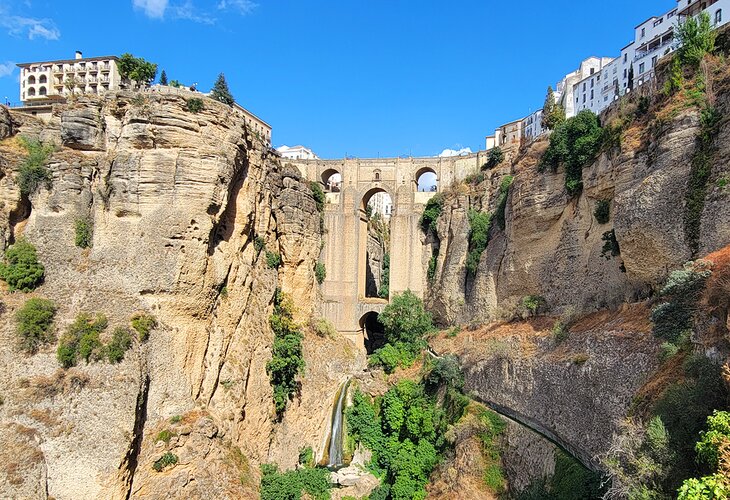
In a spine-tingling setting, Ronda offers dramatic views and wild scenery . Built above a steep ravine (El Tajo) crossed by the Puente Nuevo (New Bridge), this spectacular Pueblo Blanco features whitewashed houses clinging to the edge of a cliff top.
Proud of its traditional Andalusian culture, Ronda has the second-oldest bullring in Spain. The Plaza de Toros is still used once a year for the Goyesque bullfight (during the Feria de Pedro Romero , a festival that takes place the first week of September). The festival also includes a parade of women wearing flamboyant costumes of the late 18th century, the era of Francisco de la Goya.
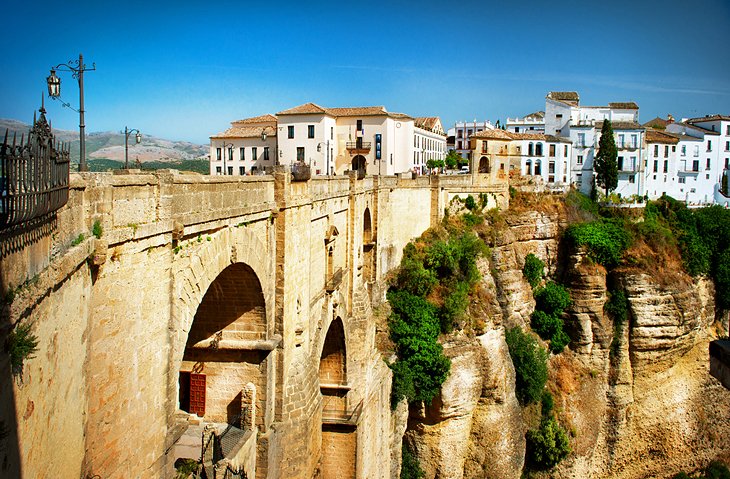
Ronda has a special beauty and romantic charm. Enjoy exploring the atmospheric cobblestone streets of La Cuidad , Ronda's old Moorish town, which has many historic mansions and palaces.
On sunny days, Ronda's parks are the ideal place to stroll tree-lined paths and relax in the shade. The Alameda del Tajo and Alameda de José Antonio parks both offer striking panoramic views of the landscape.
Providing another angle of Ronda's heritage, the Museo del Bandolero (Bandit Museum) illustrates the history of those daring, infamous anti-heros of the region.
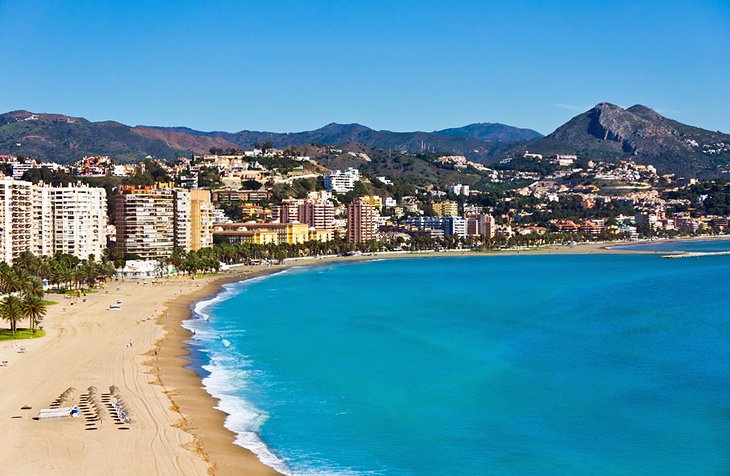
Malaga is an ancient Mediterranean port town and has the weathered fortresses to prove it. Standing on a hilltop overlooking the bay, the old Alcazaba and the Castillo de Gibralfaro castles watch over the harbor action and offer splendid coastal views.
Among the endless stretch of Costa del Sol beach resorts, Malaga is an anomaly because it is a real working city. Although this pleasant seaside town does have a fabulous sandy beach, the Playa de la Malagueta , sightseeing rather than sunbathing is the main draw for visiting Malaga.
With plenty of cultural sites and historic monuments to explore, travelers can easily keep busy here for a few days. The long list of tourist attractions in Malaga includes ancient ruins, the 16th-century Catedral Nuestra Señora de la Encarnación , beautiful gardens, and a fantastic Picasso Museum , as well as dozens of other excellent museums.
The medieval Old Town of Malaga is especially delightful. While exploring this maze of narrow pedestrian streets, visitors will find inviting little boutiques and hidden plazas filled with outdoor cafés and al fresco dining terraces.
Another favorite spot is the harbor, which is a great place for a leisurely stroll or to dine at one of the waterside restaurants.
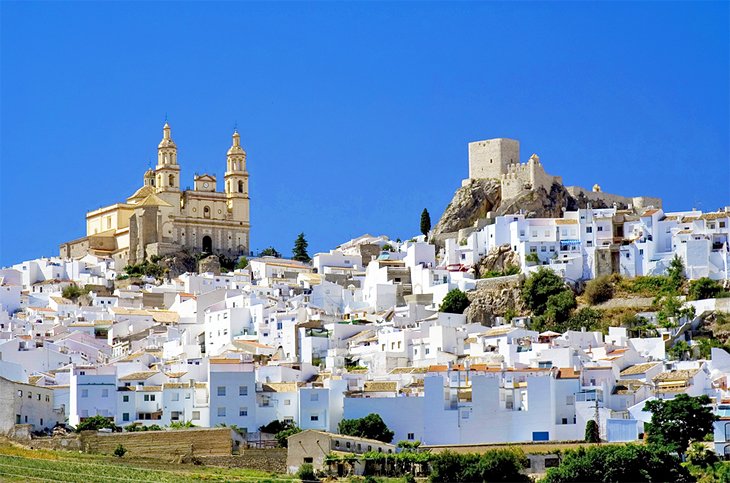
The Pueblos Blancos are enchanting, off-the-beaten-track tourist destinations in Las Alpujarras , the rolling hills of the Sierra Nevada, and in the Sierra de Grazalema and the Sierra Nevada mountain ranges.
Driving or long-distance hiking is the only way to arrive at these remote hilltop villages, but it's worth making the detour or even a multiple-day itinerary through Andalusia's most undiscovered and unspoiled area.
Full of old Moorish ambience, the Pueblos Blancos are characterized by their simple whitewashed houses. The architectural style is influenced by the Berber aesthetic of the Moors who hailed from North Africa.
Adding to the charm are the vibrant potted flowers, narrow cobblestone lanes, and lovely churches. Most of the villages are clustered on hillsides with marvelous views of the snowcapped mountains and verdant valleys.
The gateway to the Pueblos Blancos is Arcos de la Frontera , with its glowing white buildings arranged in a semicircle on a cliff top. Ronda is the most dramatic of Andalusia's whitewashed villages, famous for bullfighting, as well as awe-inspiring scenery.
One of the prettiest of the villages is Grazalema , a high-mountain town nestled in a valley and surrounded by a spectacular natural park.
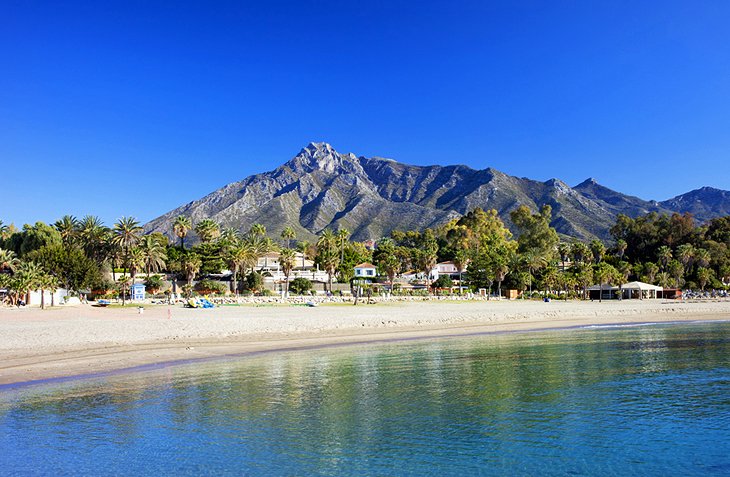
Along the Costa del Sol , the glamorous resort town of Marbella is prized for its stunning seaside scenery, palm-lined promenades, and sandy beaches along a 27-kilometer shoreline. As an upscale vacation town, Marbella has plenty of golf courses and private clubs that cater to a discerning clientele.
For a fashionable dining scene, head to the Puerto Banús , a gorgeous marina where many fancy yachts are docked. The port area also has many trendy restaurants and designer boutiques.
For beachside meals, the Playa de Alicante offers great choices. The closest beach to Marbella's city center is the Playa La Fontanilla , just a short walk from the Old Town.
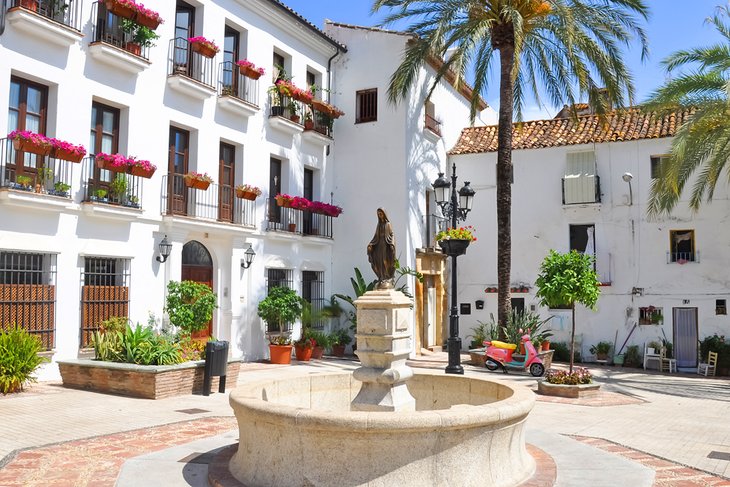
More than just a beach destination, Marbella has interesting cultural attractions. The perfectly manicured Old Town ( Casco Antiguo ) is an enchanting Moorish village with flower-bedecked, whitewashed houses and charming cobblestone lanes.
Hidden throughout the pedestrian streets and alleyways are exquisite little churches and quiet courtyards with sidewalk cafés. At the heart of the Old Town, the Plaza de los Naranjos is a lovely square shaded by orange trees and filled with restaurant terraces.
Other things to do in Marbella's Old Town include shopping at stylish boutiques, visiting museums, and admiring historic churches. The renowned Spanish Contemporary Engravings Museum displays works by Goya, Picasso, and Miró, among others.
The Municipal Collection of Archaeology is found at the pleasant Plaza del Altamirano . On this charming square, the tables from two restaurants spill out onto the cobblestone outdoor patio space. It's an inviting spot to dine al fresco during summertime.
The most noteworthy churches are the Iglesia de Nuestra Señora de la Encarnación , built on the site of a former mosque, and the Iglesia del Santo Cristo , built in the 16th century.
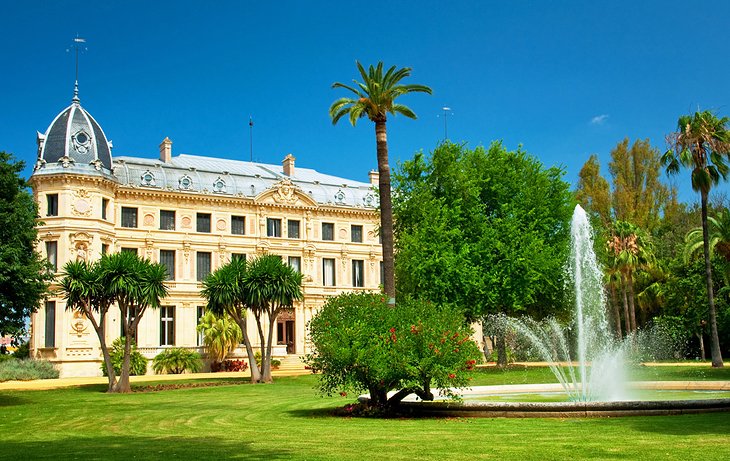
Jerez de la Frontera (35 kilometers from Cádiz) is a refined aristocratic town famous for its Andalusian pedigree horses and traditional equestrian shows.
In an elegant building on the Avenida de Duque de Abrantes, the Fundación Real Escuela Andaluza del Arte Ecuestre (Royal Andalusian School of Equestrian Art Foundation) stages the popular show titled Cómo Bailan los Caballos Andaluces (How the Andalusian Horses Dance), an equestrian ballet in the Andalusian style of the 18th century.
The Feria del Caballo (Jerez Horse Fair), held annually in May at the Parque González Hontoria, showcases the town's prestigious pedigreed horses. Visitors will appreciate the food stands, dance competitions, and children's activities at this lively event.
Jerez de la Frontera is also known for the traditional Andalusian art of flamenco dancing and cante jondo (deep song), a dramatic and evocative style of Gypsy singing. The Centro Andaluz de Documentación del Flamenco educates visitors about the various forms of flamenco singing, guitar, and dance, through videos, documents, and descriptions of historical figures.
The annual Festival de Jerez stages traditional, as well as avant-garde, flamenco performances of an exceptional caliber at the Teatro Villamarta and other venues.
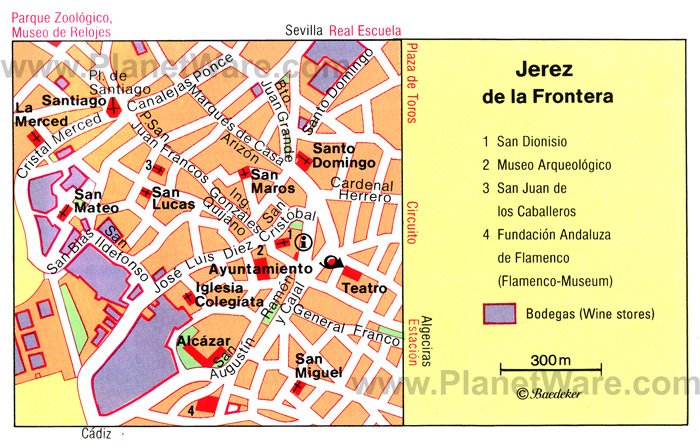
Amid picturesque olive plantations, this UNESCO-listed historic town of Úbeda is renowned for its Renaissance architecture. The central feature of the Casco Antiguo (Old Town) is the pedestrian-only Plaza de Vázquez de Molina , graced by the 16th-century Sacra Capilla del Salvador del Mundo.
With its richly sculpted Plateresque facade and Italian Renaissance-style domed interior, the Sacra Capilla del Salvador del Mundo stands out as one of the most emblematic landmarks in Úbeda. The chapel contains noteworthy artworks including the Transfiguration of Christ altarpiece by Alonso Berruguete. You may visit the chapel, which is open daily year-round; entrance requires an admission fee.
Excellent accommodations are found on the Plaza de Vázquez de Molina square at the four-star Parador de Úbeda , which occupies a 16th-century Renaissance palace featuring a typical Andalusian courtyard and traditional decor. The Parador de Úbeda has a fine-dining restaurant that serves regional cuisine.
Near Úbeda is Baeza (about 10 kilometers away), another UNESCO-listed city with marvelous Renaissance buildings, and Cazorla (about 45 kilometers from Úbeda), dominated by an ancient castle.
Cazorla is the main town of the Sierra de Cazorla mountain range and is a good base for hikes or climbs into the Parque Natural Sierra de Cazorla, Segura y Las Villas nature reserve, a ravishing landscape of rivers, waterfalls, forests, and canyons.
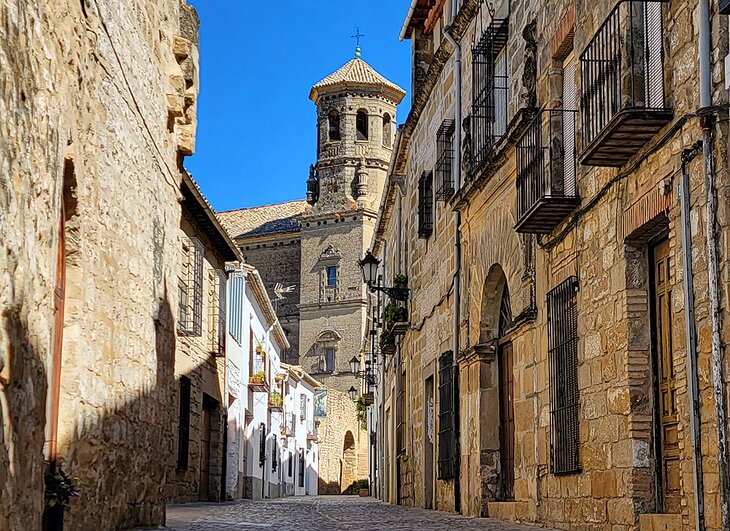
Designated as a UNESCO World Heritage Site along with Úbeda (10 kilometers away), Baeza boasts an ancient Roman, Moorish, and Christian heritage. Rolling hills, olive groves, and fields of corn surround the town, which has retained an old-world ambience in its cobblestone streets and elegant squares.
In the 16th century, Baeza became an important trading center and university town. The town's wealthy past is seen in the handsome old houses and noble mansions, as well as its Renaissance cathedral, the Catedral de Baeza on the Plaza de Santa María, built in the 16th century on the site of a demolished mosque.
The spacious Paseo de la Constitución in the center of Baeza is lined with impressive 17th-century mansions. The Plaza de los Leones at the west end of the Paseo de la Constitución was named after the fountain in the center of the square that incorporates four figures of lions from the Roman site of Cástulo.
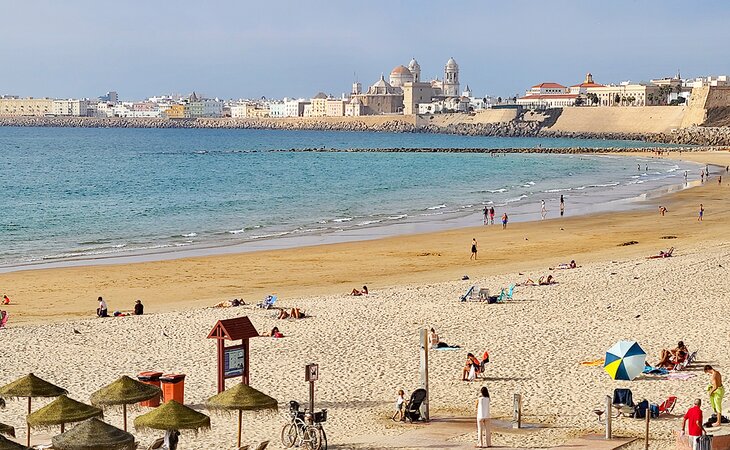
History abounds in Cadiz, long considered the most ancient city in Western Europe. With its mix of beaches and history, most people fall under the spell of Cadiz's charms in very short order.
Miles and miles of sand stretch southwards from the city; some of the best beaches in Spain , are found here. Set up your towel and umbrella at Playa de la Victoria and soak up the scene, or for a bit of luxury rent a sun lounger at a beach restaurant and have your drinks and food hand-delivered to you.
The Old Town is a delight to wander around and get lost in its warren of narrow streets and alleys. Historical buildings house small restaurants serving up fine Andalusian cuisine while others house eclectic and interesting shops. Not to be missed is Cadiz Cathedral and the lively plaza out in front along with Plaza de San Juan de Dios near the cruise port.
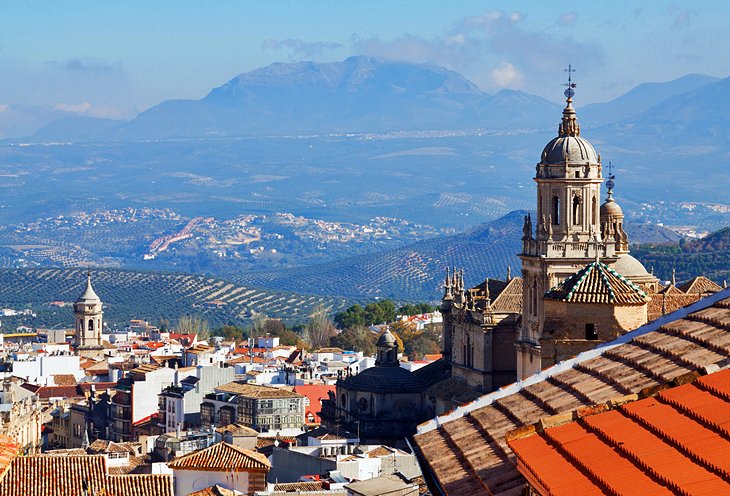
Jaén enjoys an idyllic natural setting at the foot of the Sierra de Jabalcuz and Sierra de la Pandera mountains, where the rolling hills are covered with expansive olive groves.
Steeped in history, Jaén originated as a walled Carthaginian town, and during Roman times was an area of silver mining. In the Moorish era, Jaén was the capital of the Islamic Kingdom of Jayyan, which was reconquered by Christian armies in 1492.
Must-see attractions are the UNESCO-listed Santa Iglesia Catedral de la Asunción de la Virgen , a remarkable Renaissance cathedral, and the renovated Arab Baths building that now houses the Manuel Moral International Museum of Naïf Art .
The most prominent site of Jaén is the majestic 13th-century Castillo de Santa Catalina , perched on a rocky hilltop. This old Moorish stronghold was captured in 1246 by King Ferdinand III.
Beautifully restored, the Castillo de Santa Catalina has been converted into a four-star luxury hotel, the Parador de Jaén with a swimming pool and luxuriant garden. Guest rooms feature traditional Andalusian decor and panoramic views of the landscape. The hotel's gastronomic restaurant serves regional cuisine including specialties such as Pipirrana (mixed vegetable salad) and Ensalada de Perdiz ( partridge with salad).
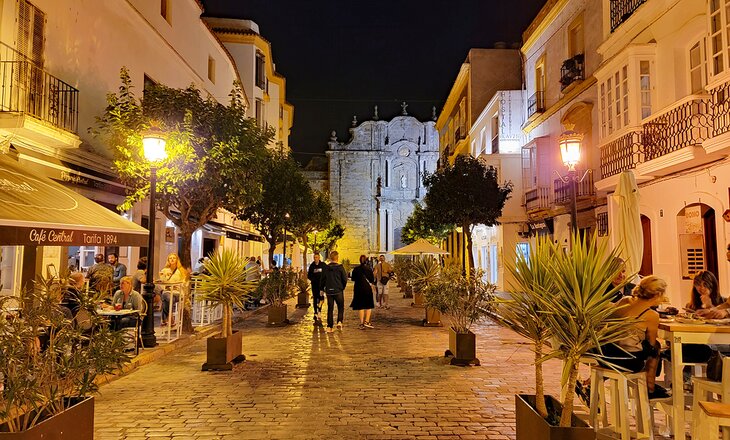
Located at the far southern tip of Andalusia, Tarifa is a fun and funky town that attracts a diverse and interesting crowd.
It has long been a destination for wind sport enthusiasts for its consistent and strong breezes, and the youthful vibe makes the place lively and enjoyable. Beaches both in town and down the way are some of the most beautiful in Spain. The spectacular Playa Valdevaqueros has golden sands, crystalline waters, and to top it all off, a huge sand dune at one end. Come here to be amazed by the sea of kiteboarders racing across the waters on a windy day.
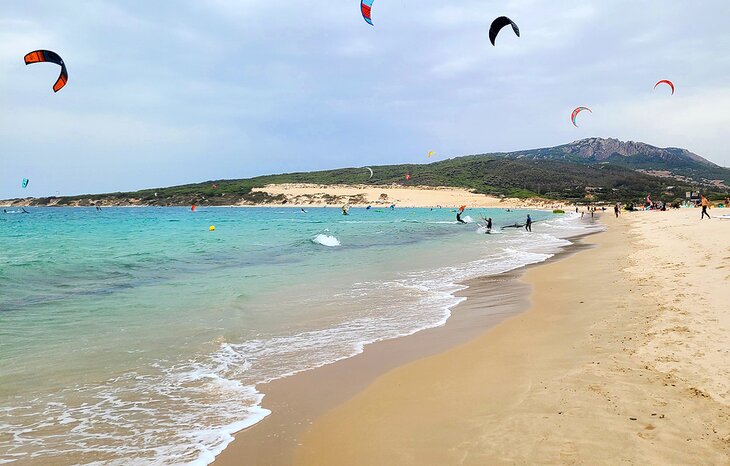
Tarifa has a small and compact Old Town jammed full of great restaurants with patios full of tourists and locals enjoying the warm evenings. Check out Silos 19 for their exceptionally prepared duck dishes.
Camping is a popular and affordable pastime here and a string of delightful campgrounds are set just back from the beach.
More Related Articles on PlanetWare.com
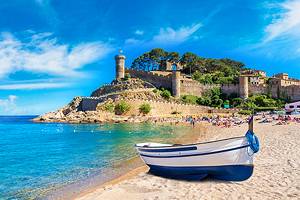
The Best of Spain: Andalusia may be the most emblematic region of Spain, but there are so many other must-see destinations throughout the country. For vacation-planning ideas, take a look at our article on the best places to visit in Spain . Beach lovers planning a summer holiday should read our list of the best beaches in Spain to decide on the ideal seaside locale.

More on Spain


Andalusia: The 6 most beautiful places to visit in the region
A region steeped in history, Andalusia is packed with remarkable sites and places that have become must-sees over the centuries. Here's a look at the 6 most beautiful places to see while you are visiting Andalusia.
With its rich and fascinating history, Andalusia is a Spanish gem that is best explored through its most iconic sites.
Planning a trip to Andalusia? Here are some articles to help you with your planning :
- Andalusia's most beautiful village, up in the mountains
- The most beautiful beaches in Andalusia to enjoy the Spanish sun
- Spain: Here is the perfect address for your next holiday in Andalusia
Discover our selection of the best places to see in Andalusia:
The plaza de españa, seville.
With its original semi-circular shape, the plaza is reminiscent of a bullring. This large Spanish square in the city of Seville in Andalusia is the main location for many public administrations. Its Renaissance and Moorish architecture showcases the construction work carried out from the tops of its towers to the azulejos , the famous Andalusian earthenware tiles.
If you take a stroll around the square and take a careful look at each architectural feature, you will discover the 52 frescoes located at the bottom of the large building. These gorgeous artworks are representations of the 52 Spanish provinces. In addition to these, the Grand Canal (which symbolises the ocean between Spain and the Americas) and its bridges are also key features of this square!
The Nerja cave, Málaga
In a decor straight out of a movie set, the Nerja cave in the province of Málaga is a marvel carved by history. Its vast galleries and cave paintings have perfectly preserved prehistoric times. Nowadays, you may only visit the lower galleries, divided into several rooms. These includes such halls as the Cataclysm room, where you can see the after-effects of the seismic movement that occurred 800,000 years ago, or the Hall of the Sink, the walls of which are adorned with anthropomorphic cave paintings.
Apart from these rooms, the best vantage point is up on the watchtower, in the Colmillo del Elefante room. The view of the stalactites and stalagmites is breathtaking!
Carretera de Maro s/n
29787, Nerja, Málaga
cuevadenerja.es
The Nasrid Palaces in the Alhambra, Granada
The Nasrid Palaces of the Alhambra form a fabulous and impressive feat of architecture. This unique complex bears witness to the Islamic art and culture that existed in Spain during the Al-Andalus era.
Once the personal residence of King Mohammed V, the entire complex has undergone numerous modifications over the centuries, including the building of additional rooms. This collection of architectural gems is exceptionally rich, making it a must-see when visiting Granada .
Doñana National Park
The Doñana National Park, located between the provinces of Huelva, Seville and Cadiz, is ideal for travellers wishing to discover Andalusia's natural landscapes. This remarkable area is home to a wide variety of marshes, lagoons, pine forests, riverbanks, shifting dunes, cliffs... and 30 km of pristine beaches. This huge natural theatre is also home to five bird species under threat, and it serves as the wintering ground for 500,000 waterbirds.
As an exceptional natural park and biosphere reserve, Doñana National Park was listed as a UNESCO World Heritage Site .
Caminito del Rey, Málaga
Are you a keen walker? If so, the Caminito del Rey in Málaga is sure to please. This 8 km route was once considered the most dangerous in the world. You will need 3-4 hours to complete it, enjoying unforgettable views of the Los Gaitanes nature reserve as you go. Rest assured, everything has been designed to make this hair-raising route, over 100m in the air, a safe road to travel.
Along the way, you'll be able to spot mountain birds (including Egyptian vultures, griffon vultures and even golden eagles) as well as wild boars and ibexes. To access the Caminito (Spanish for “little path”), tickets must be booked in advance on the official website.
Caminito del Rey
29550 Ardales, Málaga
caminitodelrey.info
The Mosque-Cathedral of Cordoba
This singular place of worship owes its unique name to the Al-Andalus era. Initially, it was a simple mosque built between the 8 th and 10 th centuries by the emirs and caliphs of the Arab Umayyad dynasty. And although it became a church in 1236, it is still considered to be one of the most impressive examples of Islamic architecture in Spain.
The Mezquita-Catedral de Córdoba is a must-see building, in which art, history and religions have been brought together over the centuries. While you are visiting Andalusia, take the time to visit this grand temple, and admire the architectural and symbolic details within. Experience a journey back in time as impressive as it is fabulous...

Malaga Travel & City Guide 17+
City guide apps, designed for ipad, screenshots, description.
The official travel guide for Málaga and the Costa del Sol. Discover over 150 places to visit in Málaga, the Costa del Sol and Andalusia in one easy to use app. Find out the best places to visit when you visit Málaga and the Costa del Sol. Our travel guide explores all the best places to visit in Málaga, the Costa del Sol and to explore around Andalusia. Each place has a detailed description telling you everything you need to know before visiting. Important information such as opening hours, phone numbers, addresses, and website links are all shown, so you can explore each place further before visiting. MÁLAGA CITY GUIDE The Málaga travel guide app features a full section about Málaga city. You will be able to quickly find information about all the top sights and attractions to visit. You can learn about visiting the attraction, its history and practical information for visiting. The Málaga city guide section covers everything from the most influential historic sights, charming squares, the city’s best squares, shopping, nightlife and a full restaurant guide. Discover and learn about some of Málaga's best attractions, including the Alcazaba, the Roman Theatre, and the famous cathedral. Read about the many museums and galleries in Málaga, including the fantastic Picasso museum. You can save each place as a favourite to create your own travel itinerary. MÁLAGA RESTAURANT GUIDE The Málaga section of the app features a complete restaurant guide featuring the very best restaurants in Málaga. Search by each section and find the best Spanish & international restaurants, Asian, Italian and world cuisine. The Málaga restaurant guide also features a section of the best coffee shops and bars. So, if you want a specialty coffee in the morning or want to party until dawn, our Málaga city guide will point you to the very best-rated places. DISCOVER THE COSTA DEL SOL As well as finding out what to see and do in Málaga, we have included a full section about the Costa del Sol. Explore each resort, find out about the attractions and nightlife, discover nearby villages and attractions for the whole family to enjoy. We have everything covered in our Costa del Sol travel guide section. EXPLORE ANDALUSIA The third section in our Andalusia travel guide. Learn about all the best places to visit in Andalusia, such as Seville, Granada, and Córdoba. Find out about whitewashed villages, outdoor activities and the best historic attractions to visit. NEWS SECTION We have incorporated a news and blog section in our Málaga travel guide app. This section will keep you up to date with important news, temporary exhibitions, festivals, and events in and around Málaga and the Costa del Sol. There is also a magazine section with articles about life in Andalusia, featuring different topics about visiting and living in Málaga and the Costa del Sol. Our travel guide for Málaga and the Costa del Sol is equivalent to a travel book, with around 250 pages of information. Find what you need to know in just a couple of clicks, save places of interest to favorites and create your own unique travel itinerary. The Málaga travel guide app covers all the main topics, such as historic attractions, museums and galleries, family attractions, places to visit, shopping, nightlife, transportation and a complete restaurant guide. Everything you need to know about visiting Málaga and the Costa del Sol in one easy to use free app.
App Privacy
The developer, City Guide Apps , indicated that the app’s privacy practices may include handling of data as described below. For more information, see the developer’s privacy policy .
Data Not Linked to You
The following data may be collected but it is not linked to your identity:
- Contact Info
Privacy practices may vary based on, for example, the features you use or your age. Learn More
Information
- App Support
- Privacy Policy
You Might Also Like
Malaga Travel Guide .
Seville: tours + audioguide
Wanderar: On-demand Tours
Spain City Walking Tour
Granada Travel Guide Offline

IMAGES
VIDEO
COMMENTS
Andalusia Travel & Tours Sdn. Bhd. Mempunyai pengalaman selama 22 tahun dalam menyediakan perjalanan dan perkhidmatan Umrah, Haji dan percutian. ... Jom tempah perjalanan umrah bersama Andalusia RM300 seorang sekarang! Jom tunaikan umrah sambil melancong bersama kami di andalusia . Tarikh Penerbangan . Selasa 18 Jun 2024 . Hingga . Selasa 25 ...
Discover the magic of Andalusia in spring, a time of transformation and unparalleled beauty. Live the explosion of colors of its landscapes, feel the sun on your skin and enjoy a perfect climate to explore every corner of this land. More than a season, spring in Andalusia is an experience. It is the ideal time to enjoy it.
Adventure Travel; Art & Culture; Beaches, Coasts & Islands; Food & Drink; Hotels. The most charming and luxurious boutique hotels in Andalucía. Jul 26, 2022 • 10 min read. Luxury in Seville, a room with a view of the Alhambra in Granada, rustic charm in the countryside and more: these hotels are among Andalucía's best.
Cordoba (1 night) Granada (2 nights) A 7 day Andalucia itinerary allows you to get a real flavour of the region. You will find yourself on the road at least every second day or so of the trip, but as I've mentioned above, journey times between destinations in Andalucia aren't too long, so this won't be too arduous.
The Andalusia region is the southernmost region of Spain. Its west side borders Portugal and the east side with Murcia, and the northern part borders the regions of Extremadura and Castilla-La Mancha. Andalusia's coastline is bathed by both the Mediterranean Sea and the Atlantic Ocean. This Spanish region is divided into 17 provinces.
Travel Insurance for your Andalusia Road Trip. It's always a good idea to purchase single-trip travel insurance, even if you're only traveling for 2 weeks in Andalusia. This covers the potential for any accidents or loss, for example, theft of baggage, canceled flights, or a road accident.
Explore the past and present of Andalusia with the Route of the Caliphate. Castles on hills and walled towns invite you to travel back to Al-Andalus. From Granada to Cordoba, there is a route that Muslims traveled in the Middle Ages… Read more
Get information on Andalusia Travel Guide - Expert Picks for your Vacation hotels, restaurants, entertainment, shopping, sightseeing, and activities. Read the Fodor's reviews, or post your own ...
Day 8: Granada: The Alhambra and Barrio Sacramonte. On day 8 of your 10 day southern Spain itienrary, you land in the beautiful city of Granada. 1. Alhambra. Start your day in Granada at one of the most famous landmarks in Spain, the mighty Alhambra. The Alhambra is the world's last and greatest Moorish fortress.
Andalusia is unlike anywhere else in Spain, and it's one of my favorite regions. The second-largest autonomous province in Spain boasts sandy beaches, snowy mountain peaks, Europe's only true desert, as well as enormous, vibrant cities, and quaint whitewashed towns perched atop cliffs. ... Lauren Juliff is a published author and travel ...
Overview of your 14 days in Andalusia. Day 1: From Seville to Cordova. Day 2: from Cordova to Granada through Jaén. Day 3: Granada. Day 4: From Granada to Malaga through Nerja and Frigiliana. Day 5: Malaga + best hikes & beaches. Day 6: From Malaga to Marbella through Colomares Monument and Mijas.
Discover the best of Andalucía's breathtaking palaces, churches, museums, vineyards, and more, as you travel through spectacular scenery dotted with pueblos blancos and bordered by rugged mountains and coast en route to Granada, Seville, Ronda and Jerez de la Frontera. view trip ⤍. 4 days / from649 USD.
To give you an idea of the approximate cost of a week in Andalucia, here is what I spent: Accommodation for 2 for one week: 350€. Transportation for 2 (flight from Geneva + train Seville - Cordoba + car rental): 385€. Visits for 2: 85€. Food for 2: 240€. Total for 1 week in Andalusia for 2 people: 1060€.
1) 4-5 Days trip to Andalucia from Seville. For this first 4-5 days itinerary in Andalucia, let's land at Seville airport to discover the region.. From there, you'll visit Seville, Cordoba and Cadiz.. A quick note: If you want to land in Seville and visit Granada during a 4 or 5 days trip, it's also doable. However, in such a short time, you will only have time to visit these 2 cities.
Genuine Andalusia is a Spain Travel Planner holding the key to a memorable vacation to Andalusia and beyond. A trusted, awarded and caring travel advisor crafting some of the best Spain vacation itineraries for very small private groups since 2013.
Seville (Sevilla) - Seville is an absolute must-visit on any trip to southern Spain, and is one of the best cities in Andalusia.Be sure to give yourself several days to soak in a city that is full of highlights. While many Andalusia guides recommend taking include taking a cruise along the River Guadalquivir, many of the cruises get mediocre reviews, at best.
Traveling to the rhythm of strutting horses and flirtatious flamenco, this tour captures the passion and pride of Spain's Andalucía. Starting with the Moorish roots of Córdoba, you'll be immersed in the culture and history of this remarkable region. We'll ponder millennia-old mysteries at Menga, marvel at Sevilla's flamboyant cathedral, and time-travel through Granada's Alhambra palace. We ...
The last stop of the day is one of the most unique places in Andalusia and a really special place in this Andalusia travel itinerary. Juzcar used to be another white washed village, but not anymore. The inhabitants of Juzcar actually painted all of their houses bright blue as part of a marketing stunt for "The Smurfs" movie in 2011.
This southern Spain itinerary is specifically designed as a road trip, and we do strongly believe that driving is the best way to visit Andalucia! From offbeat villages to charming hikes to out-of-the-way beaches, your trip to Andalucia will absolutely be enhanced by having your own set of wheels.
Andalusia, bathed by the blue of the Mediterranean and the immensity of the Atlantic, is an ancient land brimming with culture, art and passion. In Andalusia you will find corners full of light and joy, castles of past times, unique flavors and magical landscapes to get lost and find yourself again. Our goal is that you feel the characteristic ...
6. The Pueblos Blancos of Andalusia (White Villages) Olvera village in the Pueblos Blancos. The Pueblos Blancos are enchanting, off-the-beaten-track tourist destinations in Las Alpujarras, the rolling hills of the Sierra Nevada, and in the Sierra de Grazalema and the Sierra Nevada mountain ranges.. Driving or long-distance hiking is the only way to arrive at these remote hilltop villages, but ...
Andalusia Travel & Tours Sdn Bhd, Kuala Lumpur, Malaysia. 255,731 likes · 34,533 talking about this · 9,020 were here. Andalusia telah berkembang untuk menjadi syarikat peneraju utama dalam Pakej...
The Doñana National Park, located between the provinces of Huelva, Seville and Cadiz, is ideal for travellers wishing to discover Andalusia's natural landscapes. This remarkable area is home to a ...
The third section in our Andalusia travel guide. Learn about all the best places to visit in Andalusia, such as Seville, Granada, and Córdoba. Find out about whitewashed villages, outdoor activities and the best historic attractions to visit. NEWS SECTION We have incorporated a news and blog section in our Málaga travel guide app.
The listing broker's offer of compensation is made only to participants of the MLS where the listing is filed. Zillow has 9 photos of this $305,000 3 beds, 3 baths, 1,700 Square Feet single family home located at 25955 Bush Isle Rd, Andalusia, AL 36421 built in 2023. MLS #24314.
Get the monthly weather forecast for La Línea de la Concepción, Andalusia, Spain, including daily high/low, historical averages, to help you plan ahead.
Its themed zones are based on the journeys of 14th century Moroccan traveler Ibn Battuta, and includes areas dedicated to Persia (pictured), Egypt, Tunisia, India, China and Andalusia.